2014 BMW i3: What's It Like to Live With?
Read the latest updates in our long-term road test of the 2014 BMW i3 as our editors live with this car for a year.

What do you want to know about?
- Introduction
- (Short) Road Trip
- Interior Materials
- Self-Parking Feature
- The Buying Experience
- Charging to the Super Bowl
- One Lap of Orange County Range Test
- Commuting to a Three-Day Race Weekend
- Self-Parking Revisited (With Video)
- Performance Tested
- First Impression
- Big Surprise, It's Great for Commuting
- Open Floor and Center Console
- Awesome Steering Wheel
- Movable Cupholder
- Testing the Range Extender
- Clamshell Doors/Entry and Egress
- Spam Bot
- Surprisingly, the Shifter Is Intuitive To Use
- Here's a Rear-Facing Car Seat That Really Fits Well
- Dash Is a Wet Blanket
- Fun in the Twisties
- Stepping Up; Way Up!
- Excellent Center Console Display/Rearview Camera
- Ride Quality in the City
- Regenerative Brakes
- Park It Anywhere
- No AM Radio
- Doesn't Remember
- Rubber-Wrapped Wagon Wheels
- Climate Control Lacks Power
- Misaligned Door Panel
- An Extra-Large Rear-Facing Convertible Car Seat Fits, But Rear-Hinged Doors Not Ideal
- Man Wrestles Floor Mat, Loses
- Do Golf Clubs Fit?
- Flat Tire and No Spare
- 5,000 Miles
- Carbon Fiber Chassis Sets Up Promising Future for BMW
- Dog-Friendliness Rating
- Torque Makes It the Perfect City Sleeper
- A Macro Look at Interior Materials
- Less Than Two Gallons of Gas In Two Months
- A Text to Riswick from the i3
- Lovely Owner's Manual Case
- Five Great Things about EVs
- Not Dirty for the Drought
- Does It Need a Start Button?
- Let's Improve the Grill
- It Might Not Look Like Much, But Its Got It Where It Counts
- Can You Fit a Stroller?
- Sacrifices Seat Comfort for Weight Savings
- Must Stop Using Google
- Sustainable Can Be Beautiful
- Fits My Current Lifestyle
- Haunted Glovebox
- Experiencing the Engine Range Extender
- Battery Discharges While Stopped?
- Actual Room for Four People
- It's Popular Around These Parts
- Heavy Traffic Improves Range
- Minimal Maintenance
- Spinning on a Dime
- When Some Jerk Yanks Your Cord
- What You'll Pay for a New 120-Volt Charger
- Sending Out an SOS
- Another Good Running Buddy
- Recharging at the Beach
- Self-Parking Denial
- The More I Drive It, the More I Like It
- There Should Be a Door Grab Here, Part II
- Pros and Cons of the Suicide Door
- Not Just for Commuting
- Passenger Airbag Recall
- Audible A/C Compressor
- Color-Coded Charging
- Adaptive, Over-Reactive Cruise Control
- Chock Full O' Nuts
- Low Tire Pressure Warning
- Complicated Car, Simple Controls
- Passenger Door Is Loose
- First Service Needs a Full Day
- Kudos to Glare-Resistant Display Screens
- One Week, One Charge
- Beauty Is on the Inside
- First Service Completed
- Do the Wheels Fit?
- Still a Favorite at 10,000 Miles
- Depreciation Gut Punch
- Sold At a Steep Discount
- Improved Range for 2017
- Wrap-Up
Introduction
What Did We Get?
Since the mid-1970s, BMW has prided itself on being the creator of "the ultimate driving machine," and more often than not, it has lived up to that claim. With the creation of the new 2014 i3 and i8, BMW is attempting to stamp its familiar slogan onto a class of cars that aren't typically known as dynamic driving machines: hybrids and electric vehicles.
While the i8 sports car is unquestionably the attention-grabber with its concept car styling, it starts at a hefty $136,650. The fully electric i3 city car, with a base MSRP of $42,300, is a vehicle for those who want to live on the cutting edge of automotive efficiency and technology at a more accessible price.
Powered by an electric motor that sends 170 horsepower and 184 pound-feet of torque to the rear wheels, the i3 is one of the most powerful electric vehicles on the market (a recently tested i3 ran from zero to 60 mph in just 6.6 seconds). A 647cc two-cylinder range-extending gasoline engine is an optional addition to the electric motor and increases the maximum range of the i3 from an EPA-estimated 81 miles to 150.
But the i3 is more than just an advanced powertrain. The cabin is unlike that of any other BMW, with recycled and renewable raw materials covering the dashboard and doors. Tall windows give the interior an airy feel, and backseat passengers are afforded easy ingress and egress thanks to rear-hinged rear doors.
The i3 is a car that we loved when we tested one on a short-term basis, so we broke out our pocketbook and went shopping for one of our own.
What Options Does It Have?
While the i3 starts at $42,300, we wanted one with the range extender, which ups the cost to $46,150. We ordered ours dressed in Capparis White and then added options.
Instead of trim levels, the i3 offers three "worlds." We wanted the open-pore eucalyptus wood trim and satellite radio, so we stepped up from the Mega World i3 to the midlevel Giga World at $47,850. However, the only interior color available on Giga is gray, and we knew dirt would start to show as the year went on. So we decided to take one more step up to Tera World, which adds dark brown full-leather seats with matching leather trim on the dash. That brought the price of our i3 to $48,850.
We also added both available option packages. The Parking Assistant package bundles sonar parking sensors, a rearview camera and fully automated parking for $1,000. The Technology + Driving Assistant package ($2,500) combines adaptive cruise control, BMW apps and a navigation system with traffic info. From there, we opted for the 20-inch sport wheels with staggered tires ($1,300), heated front seats ($350) and 12-speaker Harman Kardon audio system ($800).
As equipped, our 2014 BMW i3 carries an MSRP of $54,800. After some negotiation, we purchased our newest EV, and our first carbon-bodied long termer, for $49,999.
Why We Bought It
This is a huge bet by BMW. Electric cars are not its specialty, but the company thinks there's a place for them in its lineup. The i3 is one of the few cars on the market to have been designed from the ground up as an electric vehicle. Most other EVs, such as the Chevrolet Spark EV and Ford Focus Electric, are existing vehicles with a battery pack shoehorned in wherever it will fit. Does it make a difference? We'll see.
It's also the only car at its price point with body panels made from ultra-lightweight carbon fiber. That's good for efficiency, but repairs could be expensive if we ever have a mishap.
Then there's the issue of the i3's range extender setup. Unlike the Chevrolet Volt with its 9.3-gallon gas tank, the i3 can only carry 1.9 gallons of fuel. That means when we run out of electric power, we only have another 70 miles or so of range left. Long road trips are out of the question, but does it matter for a car like this?
We aim to put 20,000 miles on all our long-term cars over the course of a year, so our i3 has a tough goal to meet. The only other EV to accomplish that feat was our 2013 Tesla Model S. Will the range extender help the i3 achieve that goal, or will the final odometer look more like that of our 2011 Chevrolet Volt, which only managed 15,063 miles?
We have one year to find out the answer to these questions and more. Follow along on the Long-Term Road Test page for updates.
Current odometer: 780 miles
Edmunds purchased this vehicle for the purpose of evaluation.
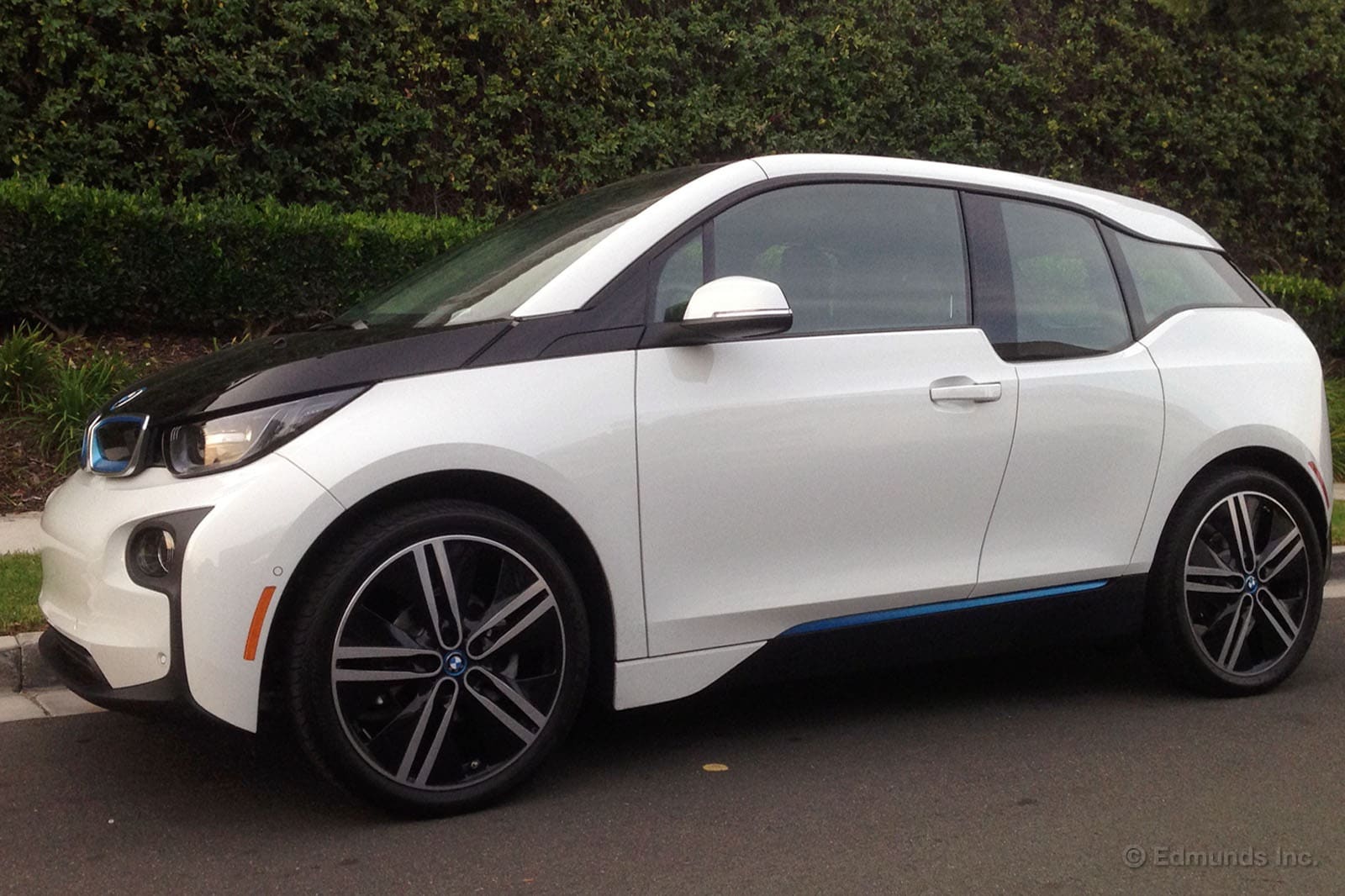
You want to own an electric car but every once in a while you take a short road trip. Does this mean you have to own two cars, one with a gas engine? Of course you could rent a car for the road trip or pop for a Tesla. Or, you could just get the new 2014 BMW i3.
To test this theory, I took a short road trip in our new long-term i3 hatchback. The key word in the previous sentence is "short" as the farthest I needed to drive in one shot was 236 miles north to the small town of Morro Bay, Calif. After that, I would drive only about 75 miles between electric charging stations on my way back to the Los Angeles area.
Here's how I managed the trip.
First of all, the i3 has an EPA-rated all-electric range of 81 miles (our testing team got 95 miles on our own test route). With the gasoline range extender, a $3,850 option, the total range is about 150 miles. So I left home with a full charge and every intention of stretching the all-electric range to Ventura, Calif., where I knew I could get an extra boost from a charge station while I ate breakfast. I put the car in "Eco-Pro" (one of three drive choices) to maximize the range and, as promised, the range extender kicked after 82.1 miles.
I found free charging and left the i3 plugged in for an hour. Coming back, I was pleased to see that I had 27 more miles of all-electric range. When the range extender came back on, I was just beginning the long climb on California Highway 154 through the San Marcos Pass to an elevation of about 2,000 feet. At first the i3 climbed easily. But after about seven miles of steady climbing, my speed began to drop. By the time I reached the pass I was going only 30 mph with my foot to the floor. Apparently, I was in danger of overrunning the ability of the gasoline range extender to charge the battery.
I filled up the 1.9-gallon range extender tank once to make it the rest of the way to Morro Bay. Using Plugshare.com, I found a charging station and "filled up" on electricity in four hours. The next day I drove to Solvang, a distance of 79 miles. I was driving a bit faster so the range extender came on after 78 miles. I left the i3 on a public charger and, when I was done with a round of golf, the car was completely charged. From Solvang, I made it on electricity to my motel in Ojai, Calif. Only a few blocks away was a free charging station. After dinner, the car was completely charged and ready for the return drive to Santa Monica the next day.
I'll be doing two follow-up posts on other i3-related subjects, but for now, I just want to summarize this discussion of range. I drove a total of 530 miles, of which about 400 miles were in all-electric mode. This showed me that, first of all, I was able to complete this short road trip successfully. Second, even in three small California towns, I found open charging stations ready and waiting for me. So taking the i3 on a short road trip is possible. But planning, patience and a little extra time are required. And not everyone is willing to do that.
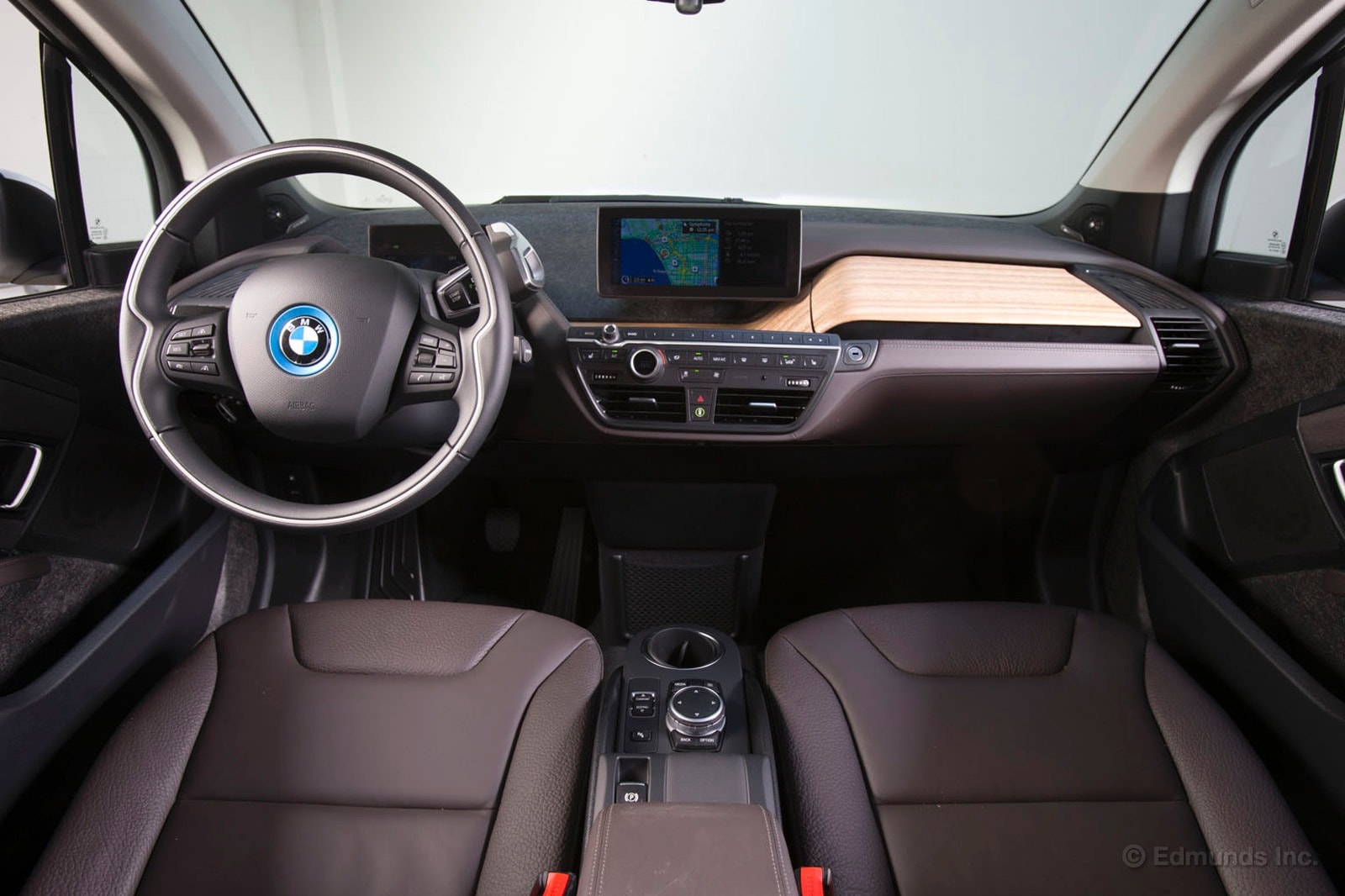
If you like cars that are different you will probably like the new 2014 BMW i3. I fall into that category too, since I think designers need to strike out in new directions rather than refining the all-too-familiar cues that we hardly even notice anymore. With this in mind, I was eager to experience the unusual interior with its — buzz word alert — "sustainable" materials.
Here are a few impressions from my three-day road trip in this unusual vehicle.
I'm not a huge fan of the exterior design and the way the 20-inch wheels dominate its appearance (19-inch wheels are also available). However, while parking the i3, I had several people rush up to me, excitedly wanting to share their opinions of its look. And everyone seemed quite captivated by the overall appearance. My feeling is that if I had bought the i3 and liked it, maybe I would eventually embrace its exterior design.
I do like the interior a lot. And more importantly, I found the layout and seating to be comfortable and practical. Furthermore, this is the first car I've test-driven in a long time where I noticed how good the rear visibility is (and the rear backup camera was the best I've ever seen). The layout of the two screens — one in front of the driver, one in the middle of the dash — are graphically pleasing without an overload of information. The weight of the knobs and buttons all have that premium German feel.
BMW says the interior door panels use "KENAF fibres" which is "a member of the cotton family (that) is particularly sustainable." Sure enough, small white fibers are visible in this material that is used throughout the interior. It has a matte finish which keeps down the glare but it takes getting used to because it has an unfinished look. Knowing it is made from recycled stuff helped me to accept it.
Here's what BMW says about the sculpted wood dashboard, "Only eucalyptus wood is used, which is primarily grown in Europe and comes from 100 % certified, responsible forestry management." The light-colored wood gives an organic feel (more buzz words) while the upright driving position and high windshield give an excellent view of the road.
BMW claims some of the fabric used in the i3 absorb road noise. Even though our test vehicle came with leather, I was struck by how quiet it is to drive this EV. But once the range extender comes on, and hopefully this doesn't happen very often, the quiet is erased by a steady drone, as if you are being chased by a lawn mower.
My family tells me the back seat is roomy with good legroom. With the front-opening rear doors it was easy to climb into the backseat. And, when I folded down the rear seats there was enough space to load in two sets of golf clubs, two pull carts and luggage for two for three days on the road.
There is a lot of utility in this small, fun-to-drive car. And, with the use of eye-catching design both inside and out, BMW might entice a wider audience to experience this alternative energy vehicle.
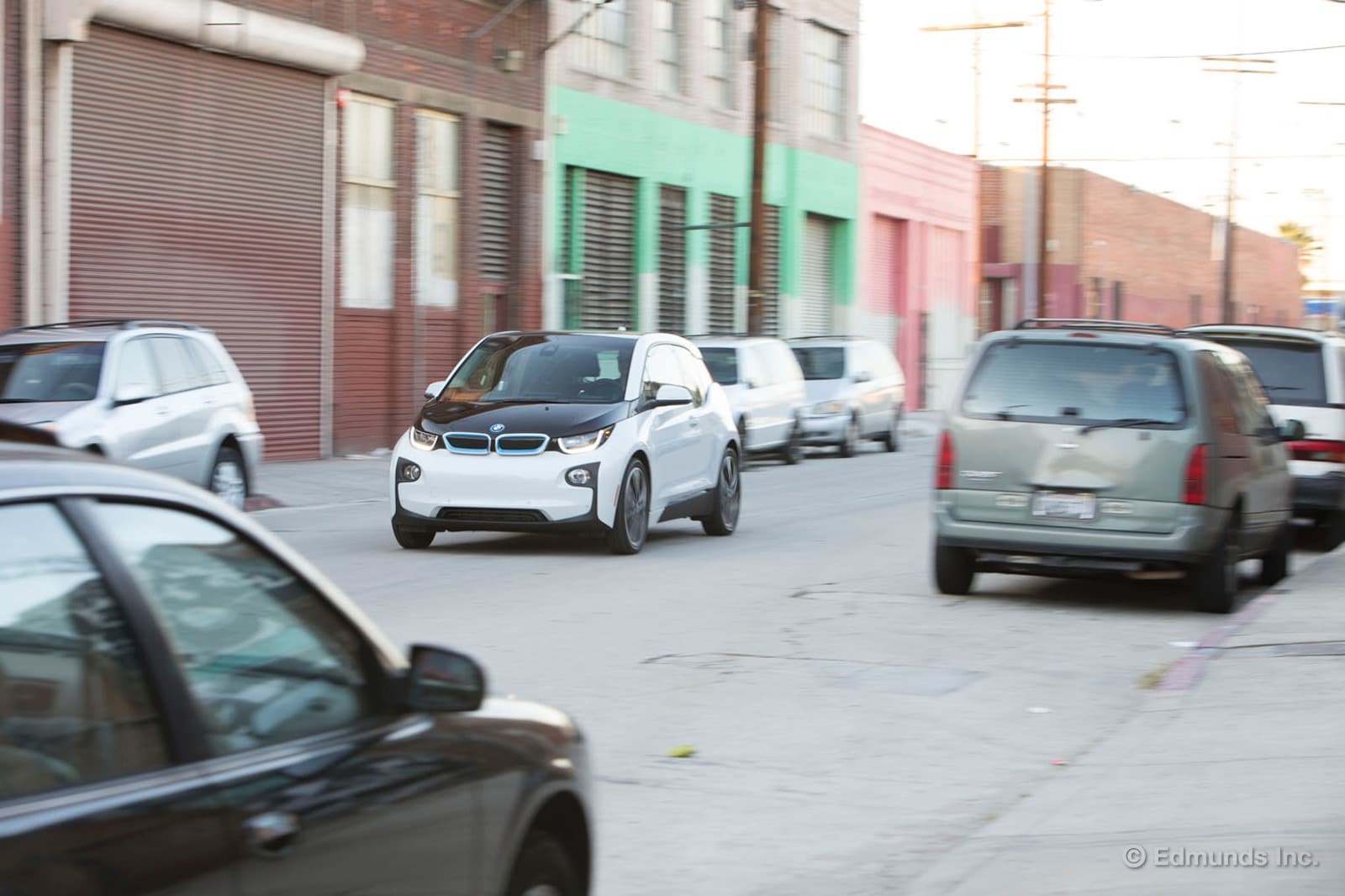
People hate parallel parking. So you would think that self-parking systems would be very popular. But since their introduction nearly seven years ago, they have remained below the radar. In fact, if you mention to a non-car person, that the car can park itself, they look stunned and say, "What? You mean the car literally parks itself?" Yes, literally. In fact, it even looks for a space big enough to fit into.
So, when our new long-term 2014 BMW i3 came with the $1,000 parking assist program I decided to try it out.
First of all, it's not very intuitive. I had to use another feature, an onboard user's manual with tutorial videos, to find out how to activate it. Then, it took several tries before I hit the buttons in the right sequence to use it. But once in action, it was spectacular. It turned into the empty spot perfectly and used the park distance feature to center the car perfectly.
While on a crowded street in Ojai, on my three-day road trip, I needed to parallel park, so I thought this was the perfect opportunity to put it into action for real. However, I must have pushed the controls in the wrong sequence because the system kept disabling. Finally, with traffic piling up behind me, I did it the old fashioned way, following the rules my driver's ed teacher gave me in high school.
If the i3 was my daily driver, and I was in a congested urban area, this would be one of the first features I would learn to use. But it seems like it takes practice and experimentation to really feel comfortable with this system.
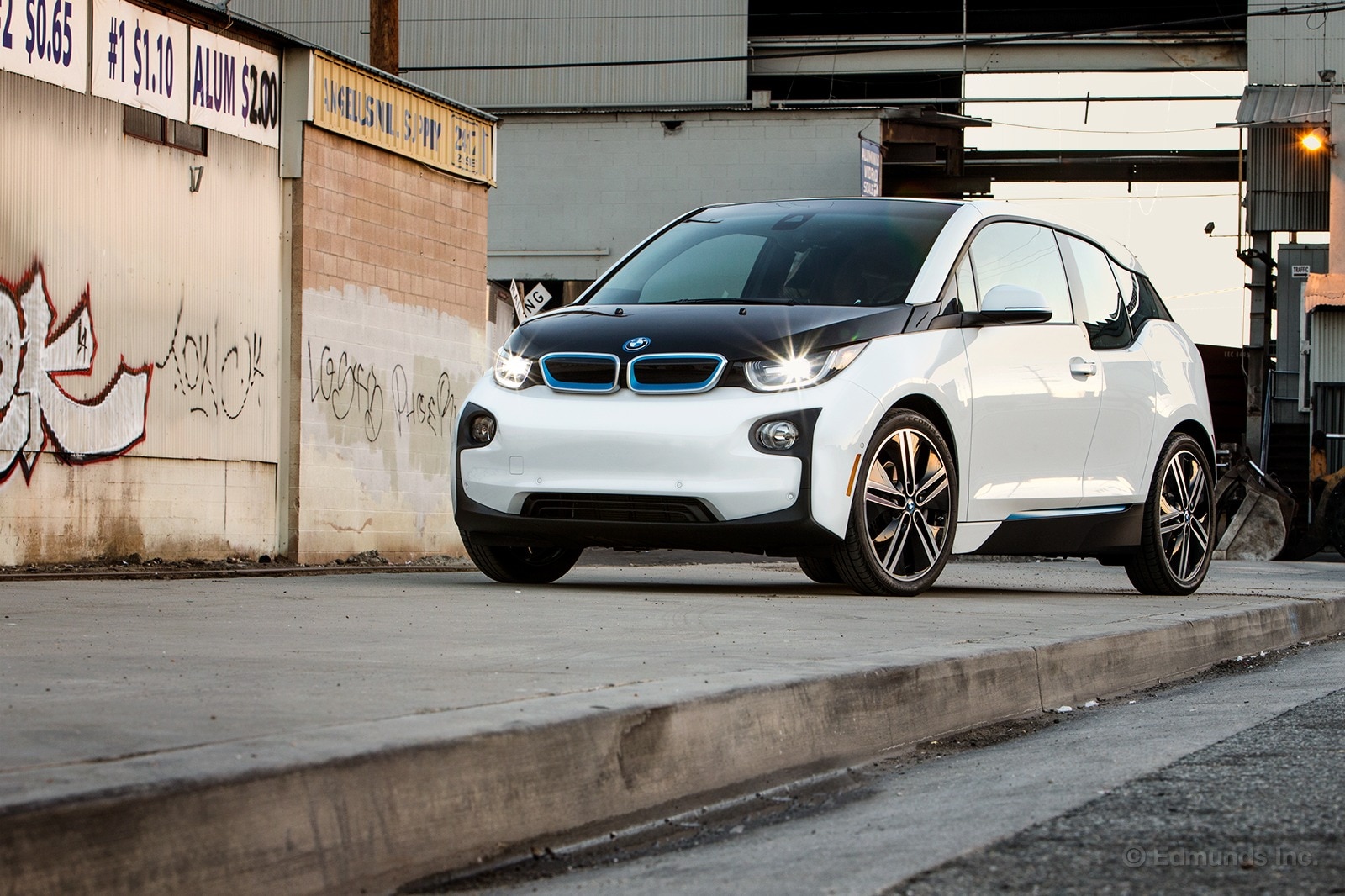
EK900, a frequent commenter on the long-term blog, said he wanted to know more about what it was like to buy the 2014 BMW i3. I had a busy December and I didn't get a chance to write a buying blog, so without further ado, here's the exciting backstory.
There was no shortage of i3s in the dealer inventory. I saw as many as 25 cars in a couple of locations. Now, some those didn't have the range extender (or "Rex" as it referred to on dealer sites) but still, I had a good selection of cars to choose from. Prices ranged from a lightly optioned "Mega World" car in the high $40,000s to the mid $50,000s for a loaded "Tera World" model.
We set out first to buy the mid-trim Giga World (yes, these trim level names are terrible). It seemed like the way to go, since it included everything in the Tera World, except for the leather interior. Problem was, Giga World had a light gray interior, which was a deal breaker for us. Lighter interiors haven't aged well with us, what with so many people getting in and out of a car over the course of a year's testing. So we decided on a loaded Tera World. It would be nice if it had come with the sport 20-inch wheels, but it wasn't crucial to get them.
I called a few local dealerships to get purchase-price quotes. One dealership sent me a lease quote, even though I had specifically asked for a purchase price — must've caught the guy off guard. Most people do lease these cars and I'd advise anyone else to do the same (EVs are notorious for bad resale value). But for various reasons, we buy our cars, so I had to proceed in my usual fashion.
MSRP on the i3 we wanted was $54,800. Most quotes from dealers were at the invoice price, which was $50,970 in the case of our i3. A few dealers didn't want to go any lower than that. We had a $50,000 budget and told the folks at New Century BMW that if they could get their price under $50K, we'd have a deal. They sent a revised price quote of $49,999 — fair enough. They delivered the car to us a couple of days later.
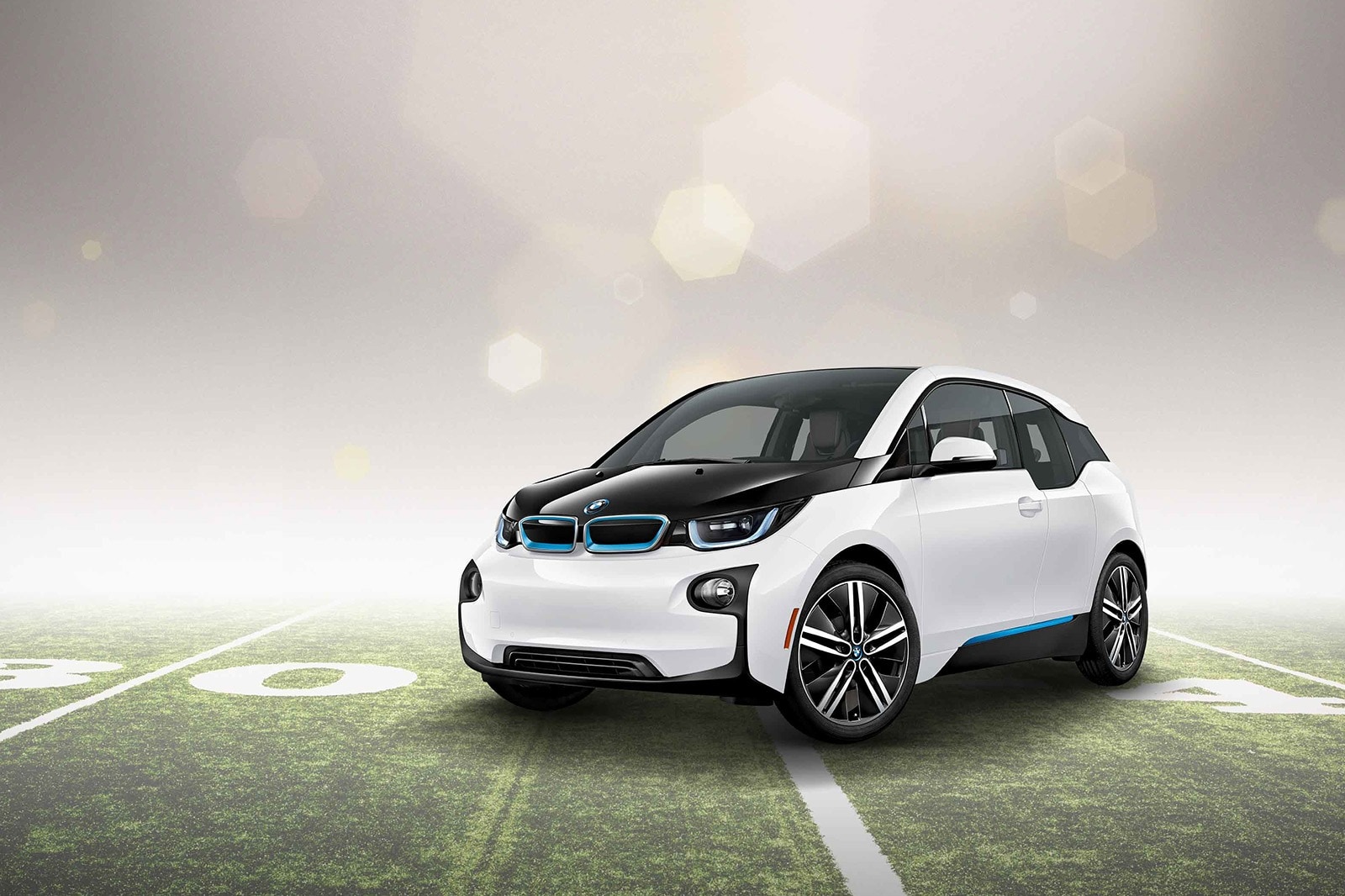
BMW announced plans to run a 60-second ad spot during Super Bowl XLIX featuring the all-new 2014 BMW i3.
The game airs February 1 at 6:30 PM ET/3:30 PM PT. The electric car will be seen during the first quarter.
It's been four years since BMW placed an ad during the Super Bowl. Not many car companies have announced plans to participate this year. We'll see which companies bite as the game gets closer.
I haven't seen BMW's ad popping up on YouTube yet. They are trying to keep it hush-hush.
But anyway, who's it gonna be, Patriots or Seahawks?
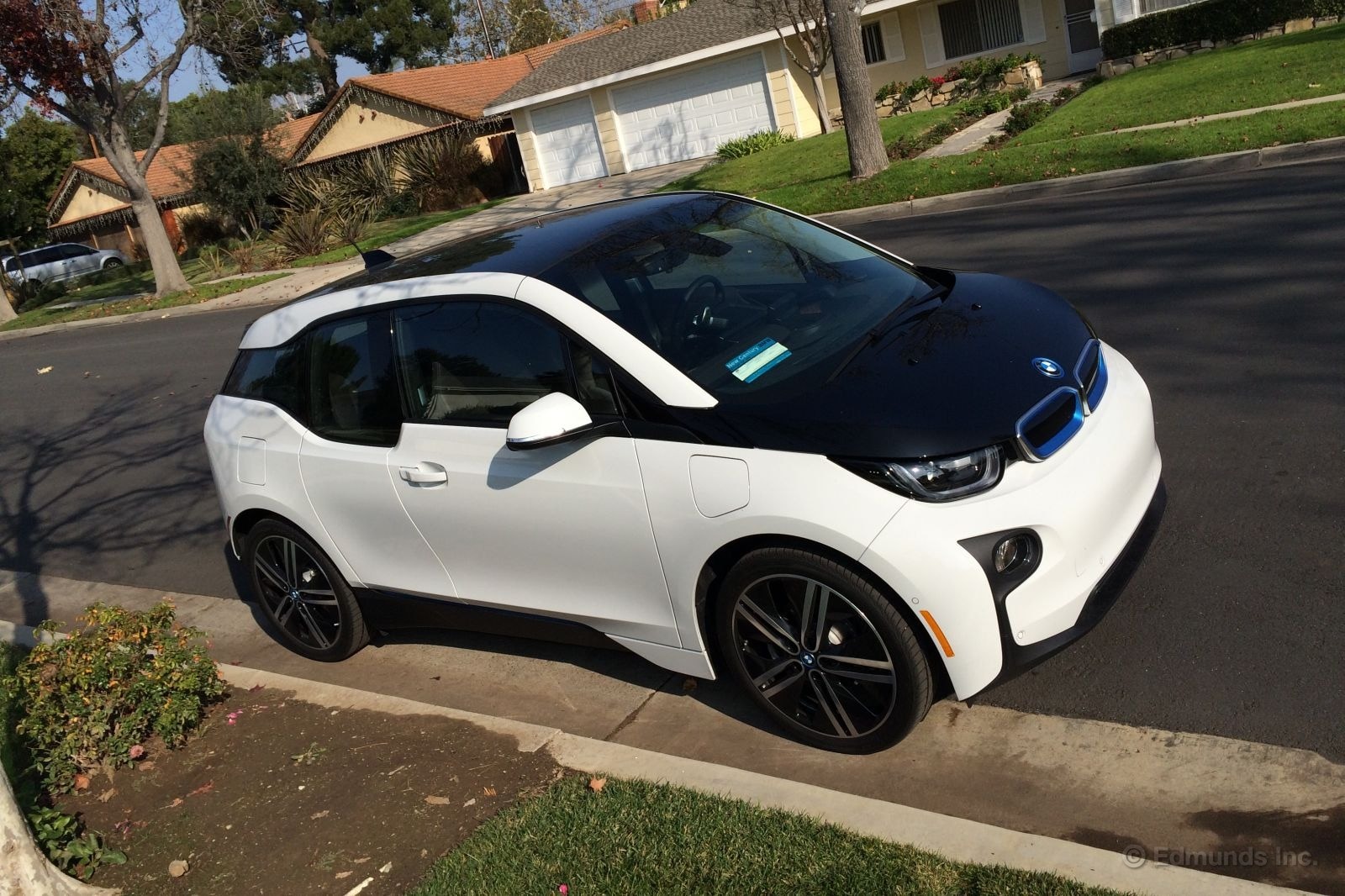
Last week I drove our 2014 BMW i3 hatchback around my One Lap of Orange County test loop, a 105.5-mile course that tours around the rough perimeter of "the OC" without ever setting foot on a freeway.
This loop was first conceived as a replacement for the city test course we drove as part of our Las Vegas-based Super Sipper Smackdown tests. We wanted a similar course we could use more often without having to deal with the logistics of a road trip.
As such, what's best characterized as a "suburban city loop" was never conceived with electric vehicles in mind. At first we tended to use it for hybrids, a class of vehicles that maximizes city mpg by means of regenerative braking. And because they're pretty much a poor man's hybrid, the course also makes a handy way to test the effectiveness of automated Stop-Start systems.
But we quickly realized our "One Lap" loop works very well for EVs, so long as a truck and trailer are waiting to collect the test car and haul it back to our metered charging station. The arbitrary length of our lap is by no means a pass/fail standard, but pins on a map marking the point where the trailer was called in (or the remaining range for those that reached the finish) make a handy way to illustrate differences.
Now that our 2014 BMW i3 (with range extender) has made the trip, we have data for just about every electric vehicle you can name. The regular BMW i3 — the one without the optional range extender — took its turn last fall.
Here's how they did.
2014 BMW i3 (no range extender)
EPA rated range: 81 miles
Edmunds OC loop range: 95.8 miles
Difference: 18% surplus
2014 BMW i3 range extender (aka REX)
EPA rated range: 72 miles
Edmunds OC loop range: 87.6 miles
Difference: 22% surplus
It's not unusual for us to beat the EPA-rated range that appears on an EV's window sticker on this loop. Their procedure is quite conservative when it comes to electric vehicles, and for good reason. Optimistic claims have no place when buyers could run out and become stranded after purchasing a car that takes some hours to refill.
But why is our i3 REX rated lower than a regular i3? After all, it has the same 22-kW battery. For one, the optional range extender increases the car's weight by some 270 pounds. On top of that, the i3 REX is programmed to bring the engine and generator on-line before the juice runs out. The reserve that results ensures there's enough on hand if a high demand situation crops up.
Fine, but this range difference used to bother me. Was our purchase of the range extender version a mistake? Why pay more to give up 9 extra miles of EV-ness?
After this test, I don't think we did. The REX doesn't have less electric range, not in any real-world sense. In fact it drives like it has more because there's zero range anxiety down near the bottom. It's easier to go deeper into the battery of an i3 REX.
In the regular i3 test loop the 85-mile mark came after the first of several increasingly persistent "plug in soon" warnings. Range anxiety would have been in full swing if I hadn't had a trailer shadowing me. It would be very unsettling to run a regular i3 down to 10-percent full on a regular basis.
Meanwhile, 87.6 miles was just a number that I recorded in the logbook when the engine came to life in our i3 REX. The draining of the battery was a non-event with no anxiety, no warning lights and zero consequences.
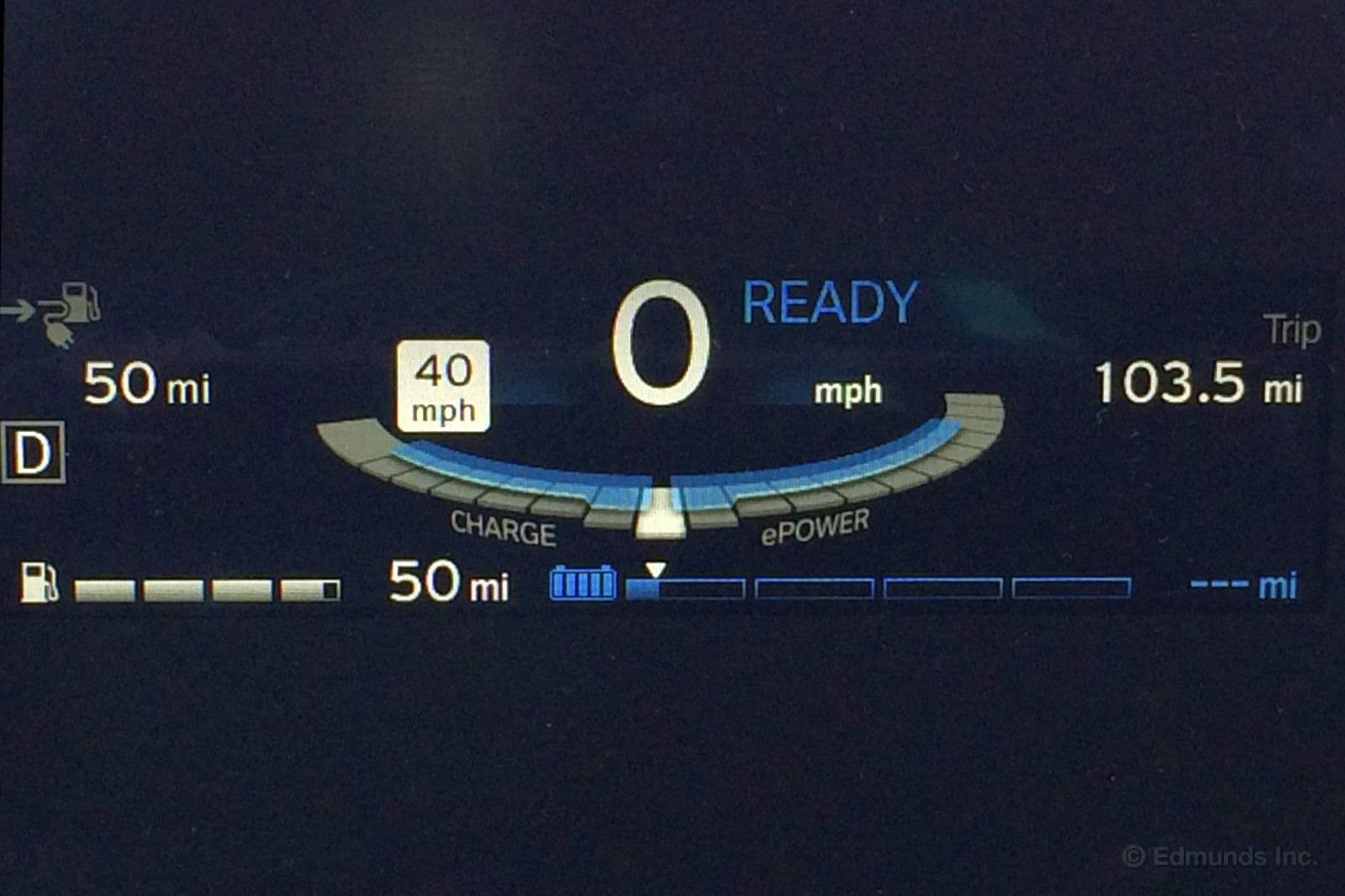
Our i3 REX simply switched modes and cruised on to the finish line like any other car. The faint gray fuel gauge bars brightened up as the blue electric ones faded to indicate that gasoline was now running the show.
In the end I rolled into the gas station that marks the end of the lap and added less than half a gallon of gas.
BMW i3 REX EPA range extender mpg: 39
Edmunds OC loop range extender mpg: 36.9
Our observed fuel economy in range extender mode fell a bit short of the EPA gasoline rating despite driving with the same care that beat the i3's rated EV range by some 20 percent.
We saw the same sort of thing with our 2011 Chevrolet Volt. Apparently the care and caution that's applied to the EPA's electric vehicle range rating goes out the window when it comes to gasoline fuel economy ratings, which is no surprise. Still, 36.9 mpg in the city is a pretty decent number for a back-up generator system that brings with it a lot of peace of mind.
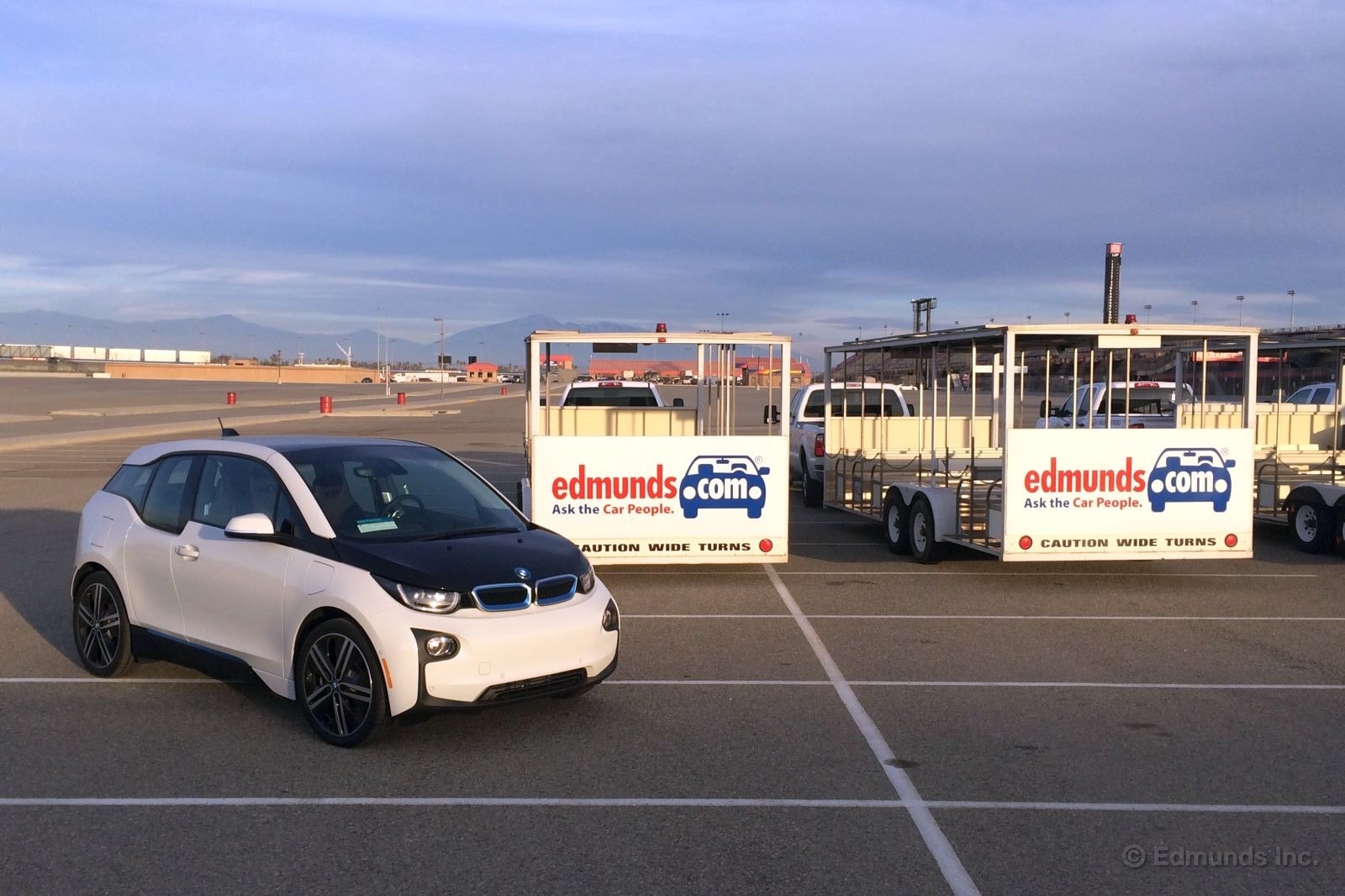
Last weekend I volunteered to work as a starter at a three-day SCCA club racing weekend at Auto Club Speedway in Fontana. The track is 46 miles from my front door, which made me glad our 2014 BMW i3 hatchback had the optional range extender.
I would not have bothered with the BMW if it had been the regular i3 or most any other all-electric car this side of a Tesla Model S. The 92-mile all-freeway round trip would have been out of reach for most, especially since my prospects for charging at the track were uncertain. Even if I could find a socket it would be no better than a 120V level 1 setup, the kind that adds around three miles of driving distance per hour of plug-in time.
But the range extender meant I didn't have to factor in any of that or do any impromptu EV math. There was no question I'd drive our i3 to the races. There was no doubt I'd make it home regardless of the availability of places to plug in. Our 2014 BMW i3 REX simply does not have that sort of leash.
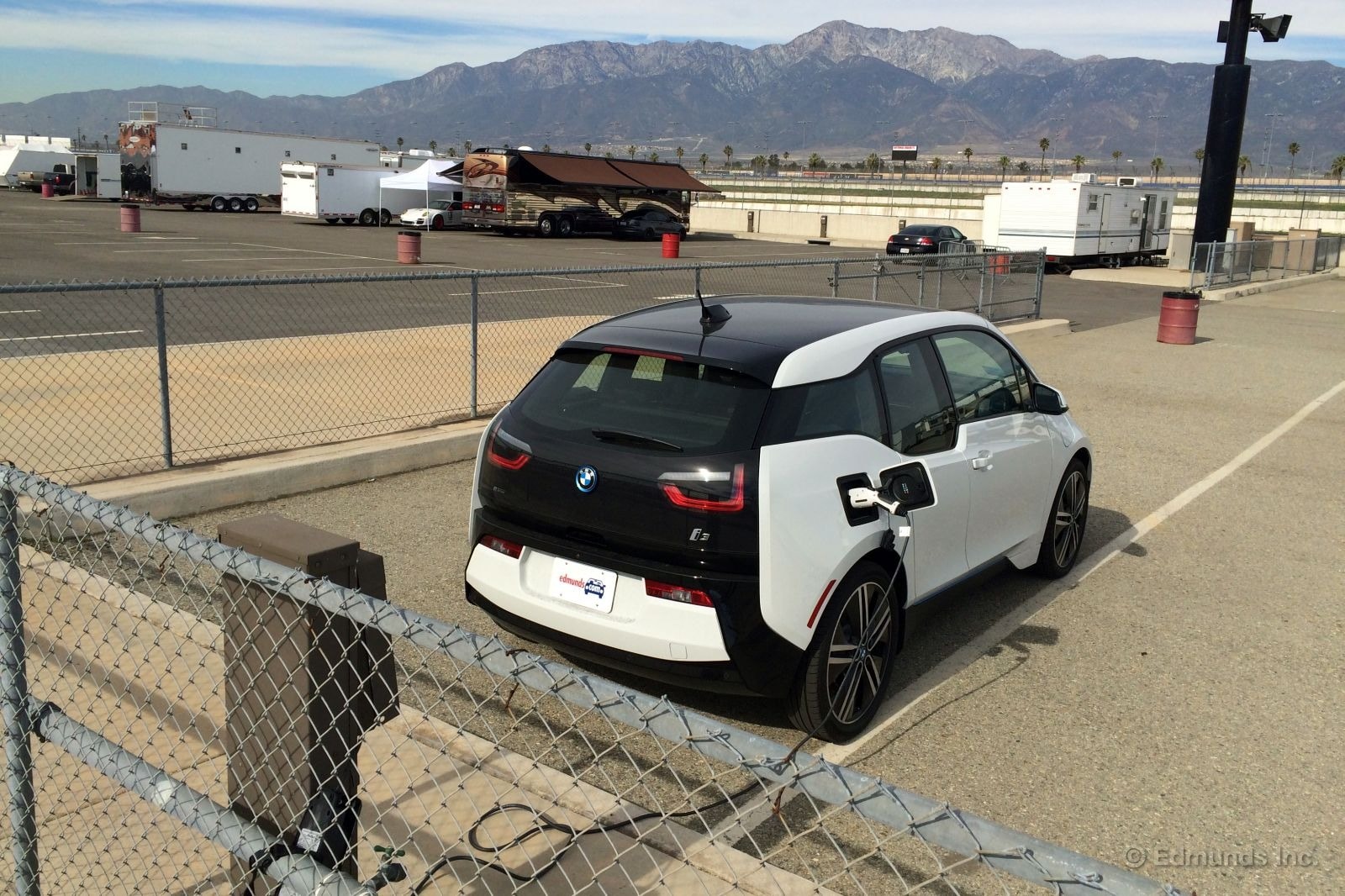
After departing home with a full battery, Day One saw me arrive at the track with 18 miles remaining. I didn't find any handy 120V outlets when I first arrived, though. There were plenty of motorhome hookups in the paddock, but racers were still coming in and I didn't want to risk blocking up someone's pre-assigned pit.
So I simply didn't bother. Recharging would have been nice, but it wasn't a necessity. My fate was not tied to the plug.
At lunch I learned that the paddock was as full as it was likely to get. Some spots near the end were likely to remain unused. So I picked a lonely looking one and plugged in for the afternoon, eventually leaving the track after the conclusion of the first day's activities with 37 miles showing on the electric range meter.
That didn't seem to be enough to make it home on battery power alone, but I nevertheless pulled in to my driveway with 9 miles left over. How could this be? Traffic bordered on terrible, which kept my speed down to 35 mph or so. And the route home is more downhill than up. The range meter was hanging on to its miles longer than usual because of the topography and my pace.
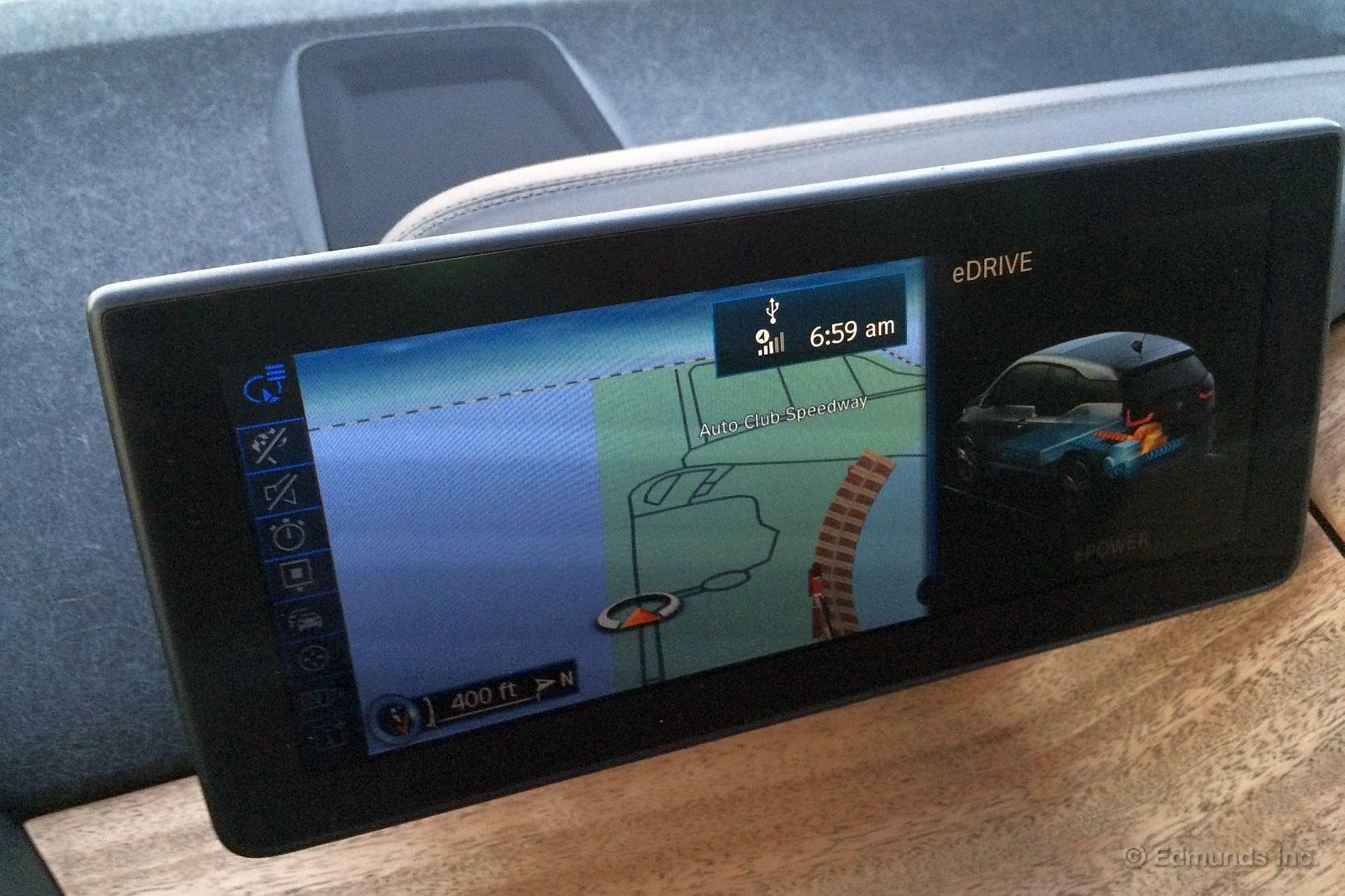
I left the house on the second morning with the battery at 69% full because, well, I don't own a 240V Level 2 charge station. But this wasn't quite enough to get me back to the racetrack. This time consumption was high because of an utter lack of freeway traffic, the fact that I was running late and the slight uphill trend of my route.
This time the range meter shed miles quicker than expected — because of the topography and my pace. The generator kicked in about 6 miles before I arrived, an event that was celebrated on the navigation screen's eDrive sidebar with the addition of a fiery orange glow to the cutaway illustration of a BMW i3.
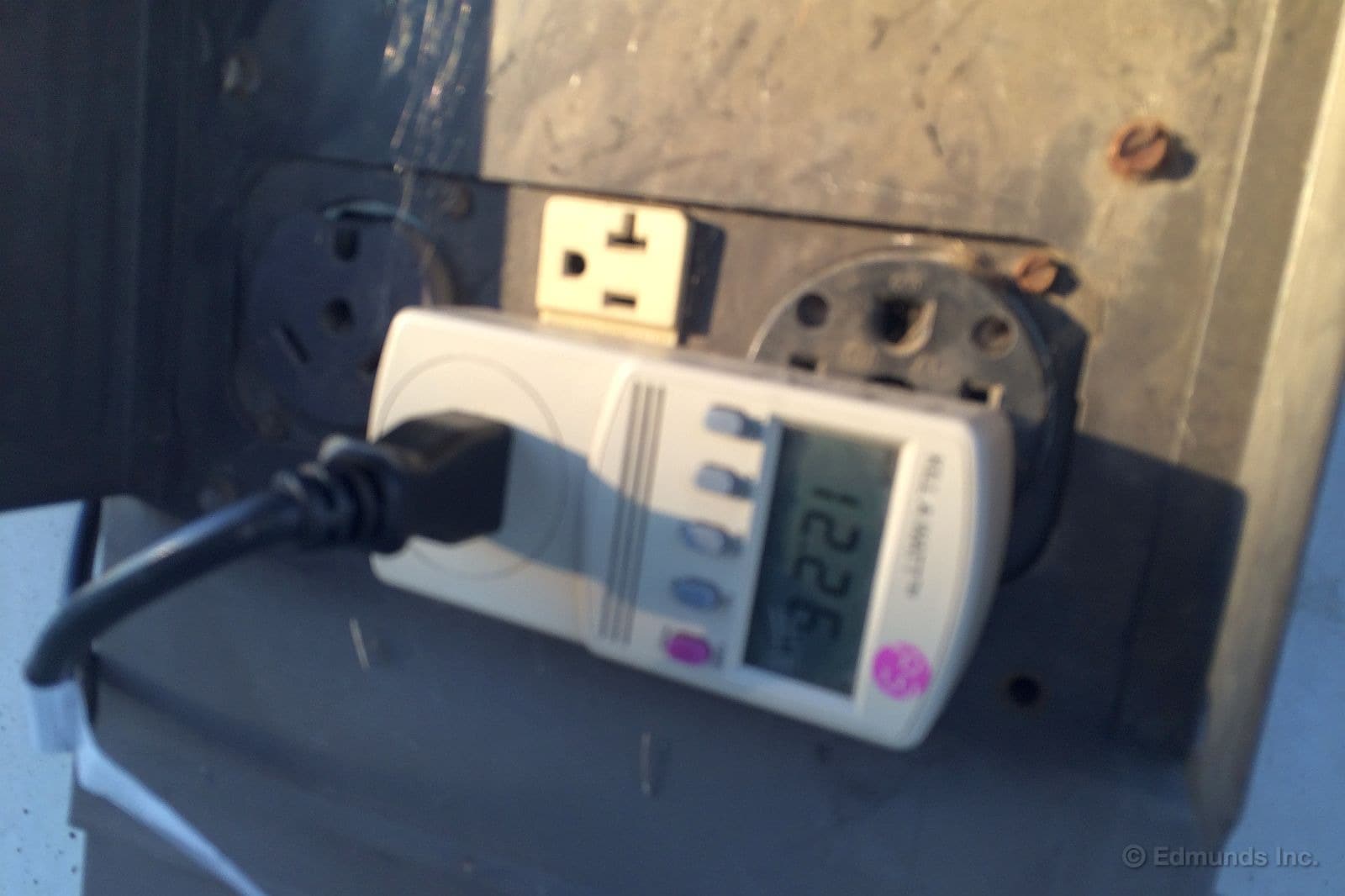
I plugged the i3 in for a full day's charge after first shooing away a black widow that had occupied my power port. But this charging session had started with zero miles in the battery, so at day's end the range meter displayed the same 37 miles I'd earned during yesterday's half-day charge session.
Traffic flowed a bit more freely on the return trip this time, but the slight downhill trend still worked in my favor. I arrived home in EV mode with just 5 miles to spare this time.
Another 12-hour at-home overnight charge brought the battery back up to 68% full, nearly the same as the previous morning. Once again I arrived at the track with a drained battery and the range-extender humming, but this time it lit up 7 miles before I wheeled into the paddock.
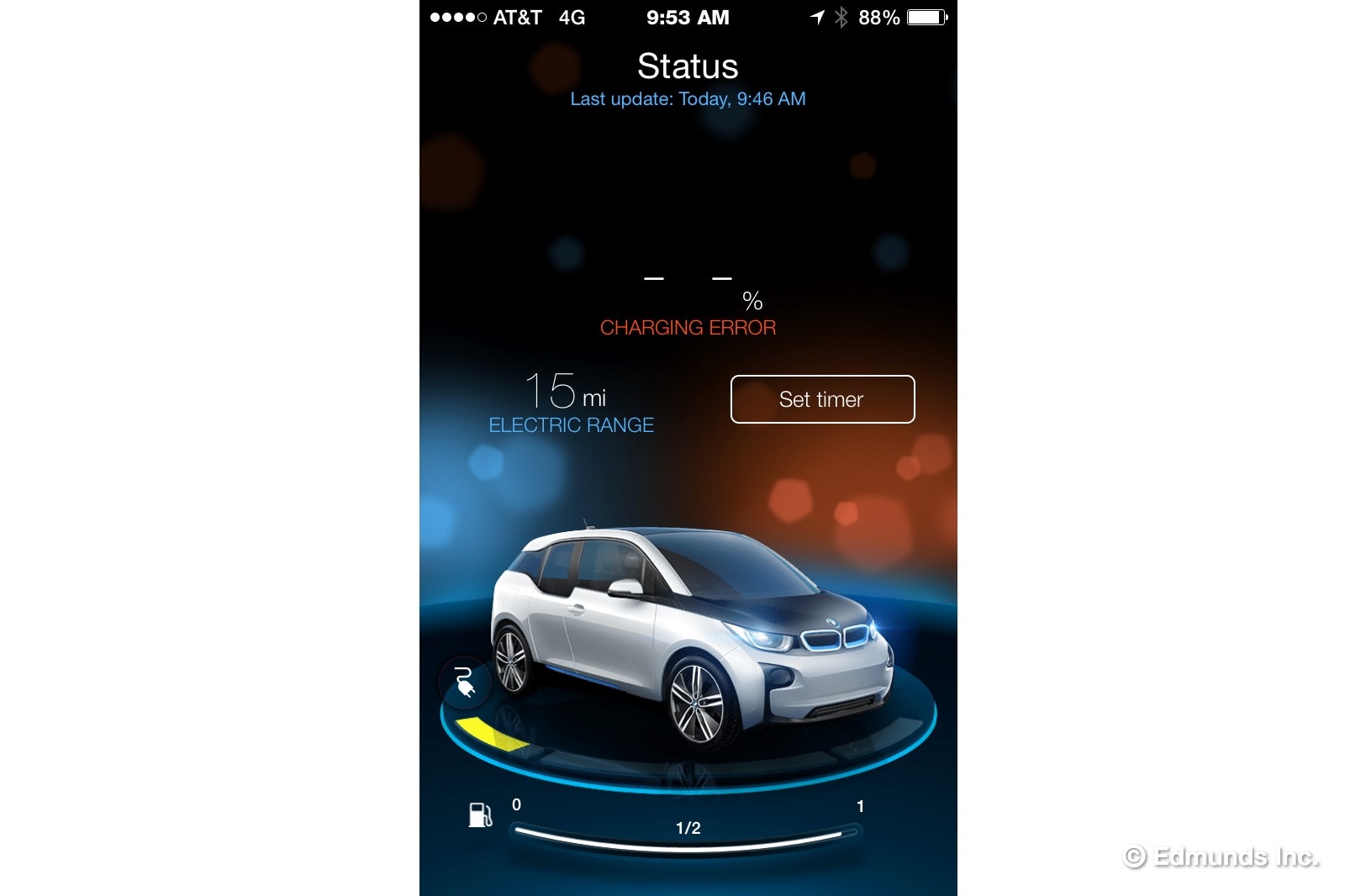
I plugged in once again at my favorite trackside power port, but about three hours later I encountered the EV driver's worst nightmare. The BMW iRemote app on my smartphone flashed an alert while I was busy working the flagstand hanging over the Speedway's start-finish line. Charging had ceased with only 15 miles in the battery due to an unspecified "Charging Error."
This would have been a disaster in a regular i3, but I just shrugged and went about my business thinking, "I guess I'll be on gasoline most of the way home." That was pretty much the case. The last 38 miles of my drive home after the final checkered flag were made with the range extender doing its thing.
What had gone wrong? I'm still not entirely sure, but it was upstream of the motorhome power drop I had plugged into. I surveyed the scene during my lunch break and found that all of the paddock power outlets were dead. Well, maybe not all, but all three of the randomly selected ones I sampled. Whatever the reason, it didn't concern me much.
All I knew for certain was the car displayed no warning lights and everything worked as expected when I got home and plugged the i3 in for the night.
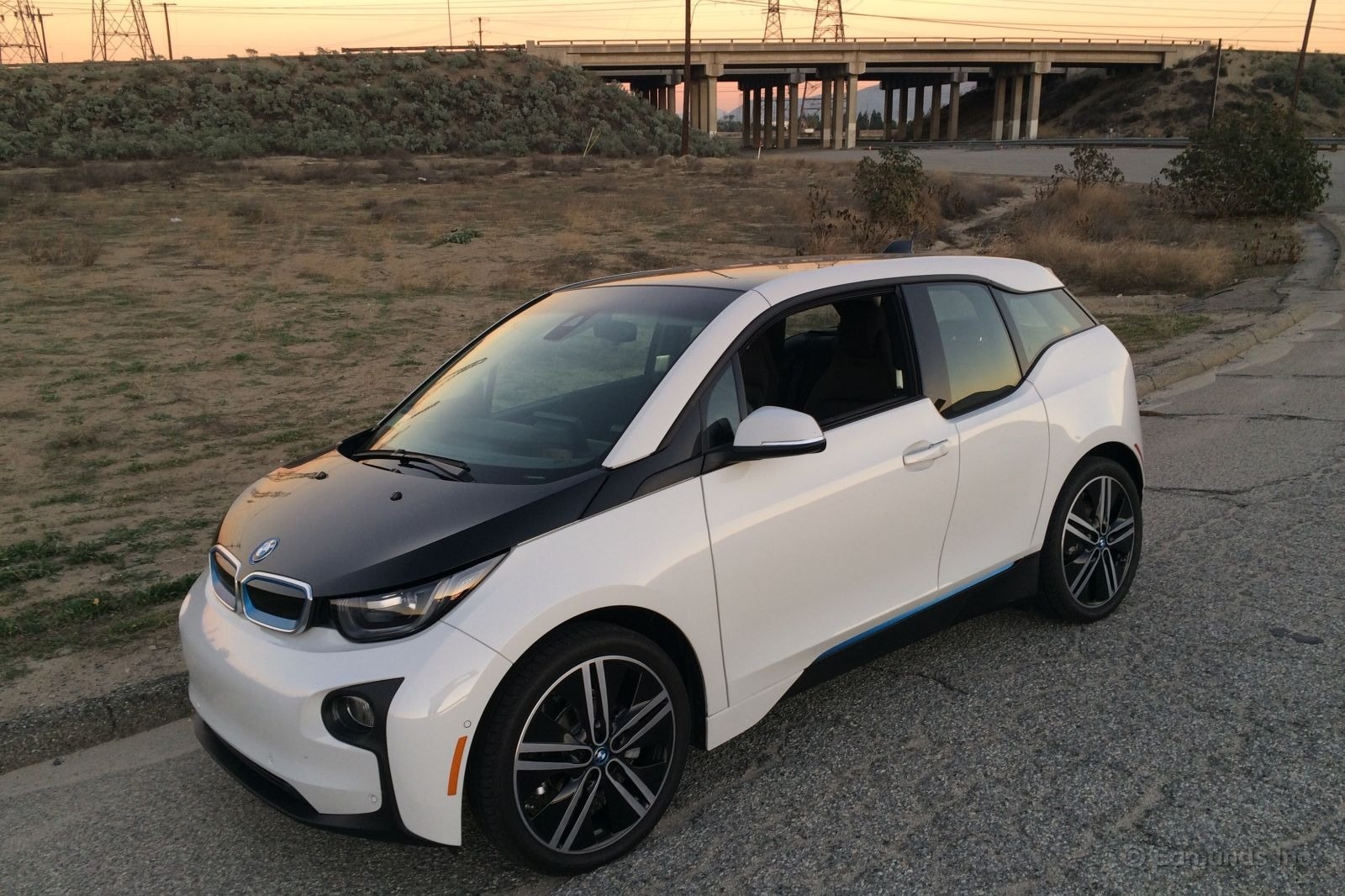
Over the course of the weekend the range extender more than proved its worth. Exactly 50.2 of the 283 miles I drove over three days came courtesy of this onboard generator system, which consumed 1.332 gallons of fuel at 37.7 mpg during the periods it was pressed into service.
A regular i3 couldn't have handled this mission past the limit of its daily range unless two conditions were met: 1) I had a 240V Level 2 charger at home to ensure my battery started each morning absolutely 100% full and; 2) I was 100% certain there'd be reliable top-off charging facilities at my destination.
Meanwhile, our i3 REX was able to comfortably tackle this driving scenario with neither of these.
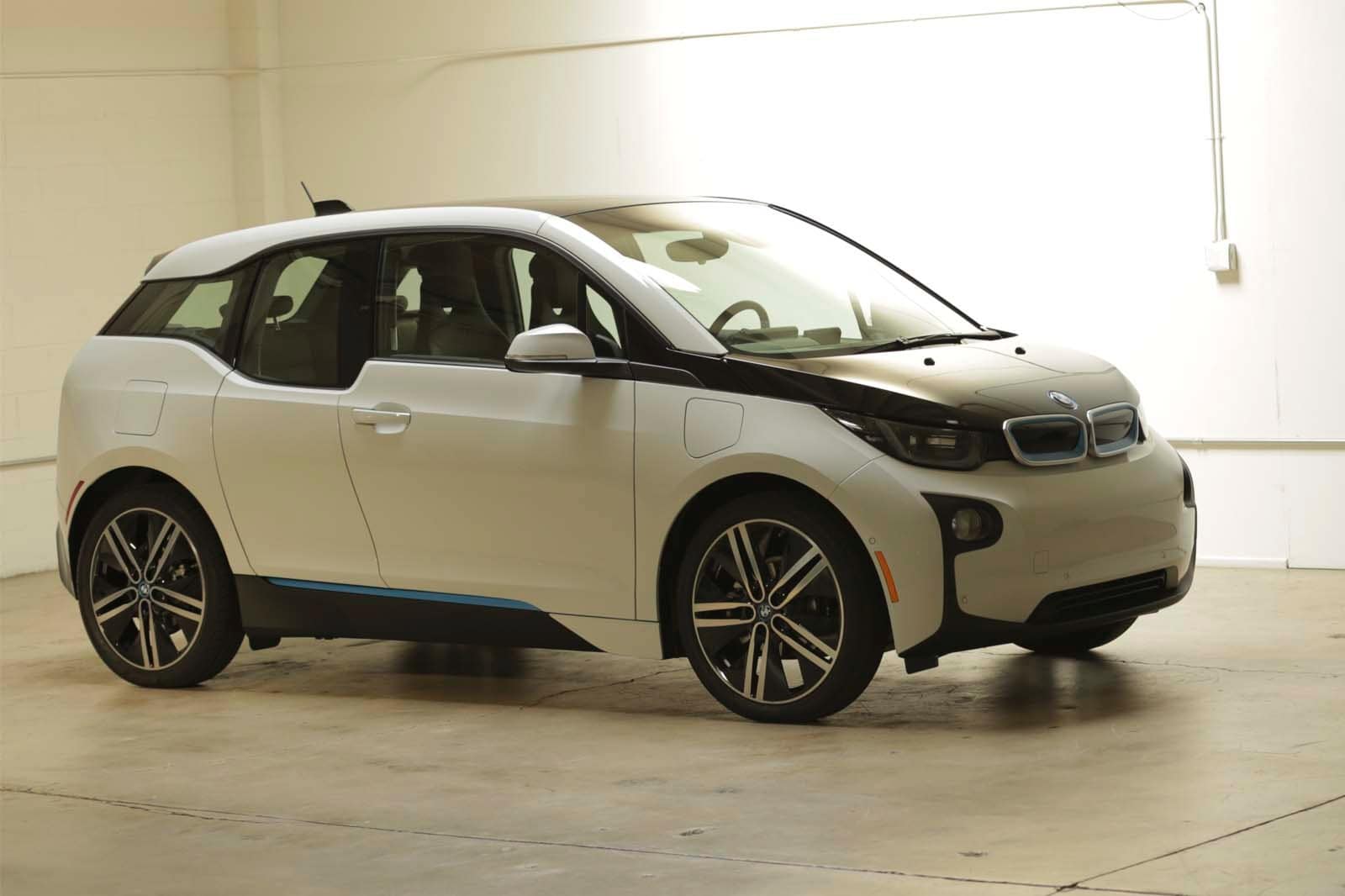
When I last wrote about the self-parking feature in our long term 2014 BMW i3 I only included a photo. A reader named saxdogg said it was "criminal" not to post a video. And some other readers posted their own videos of the i3 parking itself. So, in an effort to atone for my deficiencies we offer this video that shows the i3 parking in three different situations: on a busy street, in a tight space, and parking on the left side of the street.
While making the video I had a lot of chances to get to know this $1,000 parking assistant feature. Here are a few thoughts on the limitations and benefits of this amazing system.
First of all, I stand by my statement that the system is not intuitive. You couldn't just jump in the car and expect to push a button and let the car park itself. You really have to know how to use it, what to expect and understand its limitations.
First, a recap on how BMW's system self-parking system works.
When you want to parallel park, you press and release the park assistant button. Driving forward at speeds of less than 22 mph, the radar sensors will search for a space big enough for the car plus four feet. When it finds an appropriate sized space it will display a "P" on the monitor. You then stop, put on the turn signal (if it isn't already on) and press and hold the park assistant button. The car will park itself (automatically switching between reverse and drive) and control both the accelerator and brake pedals. When it's done, it shifts into park.
The first thing to know is that the car doesn't find a space and display a P until you are well past the parking space. If you are in heavy traffic, you now find yourself with a stack of cars behind you blocking your ability to back into the open space.
The solution to this is pretty simple. Instead of relying on the system to find the space, you have to find the space yourself, stop just past it, and then wait for the system to catch up with you, displaying a "P" to show that the space is big enough.
Another problem is that in heavy traffic you find yourself backing up toward cars that are driving toward you. While you feel that the car is in complete control, you still have to monitor traffic. While this might seem obvious to people reading this, I guarantee you that in real-world conditions you find yourself wondering what the car will and won't do. To stop and let traffic pass, you have to take your finger off the parking assistant button, let congestion clear and then begin the process again.
Another big revelation for me is that the manual admits that while self-parking, the car may hit the curb. In fact, this occurred several times, including once when it hit the curb at a very oblique angle and traveled more than a foot, scuffing the side of the tire (but not scratching the wheels). In another situation, the car got halfway into a space and then disconnected, as if throwing up its hands in surrender.
Finally, I have to say that giving up complete control of the car, even for a short time, requires a real leap of faith. Earlier, while using the system with my wife in the car, she flinched and gasped as the nose of the i3 swung into the space, missing the car in front only by inches. For her, and for many others, the stress of being out-of-control might far outweigh the convenience of its service.
After multiple experiments with the parking assistant, I feel more comfortable with the system and will, if the need arises, use it. However, I still feel that using the feature requires understanding and practice before it can be used with confidence.
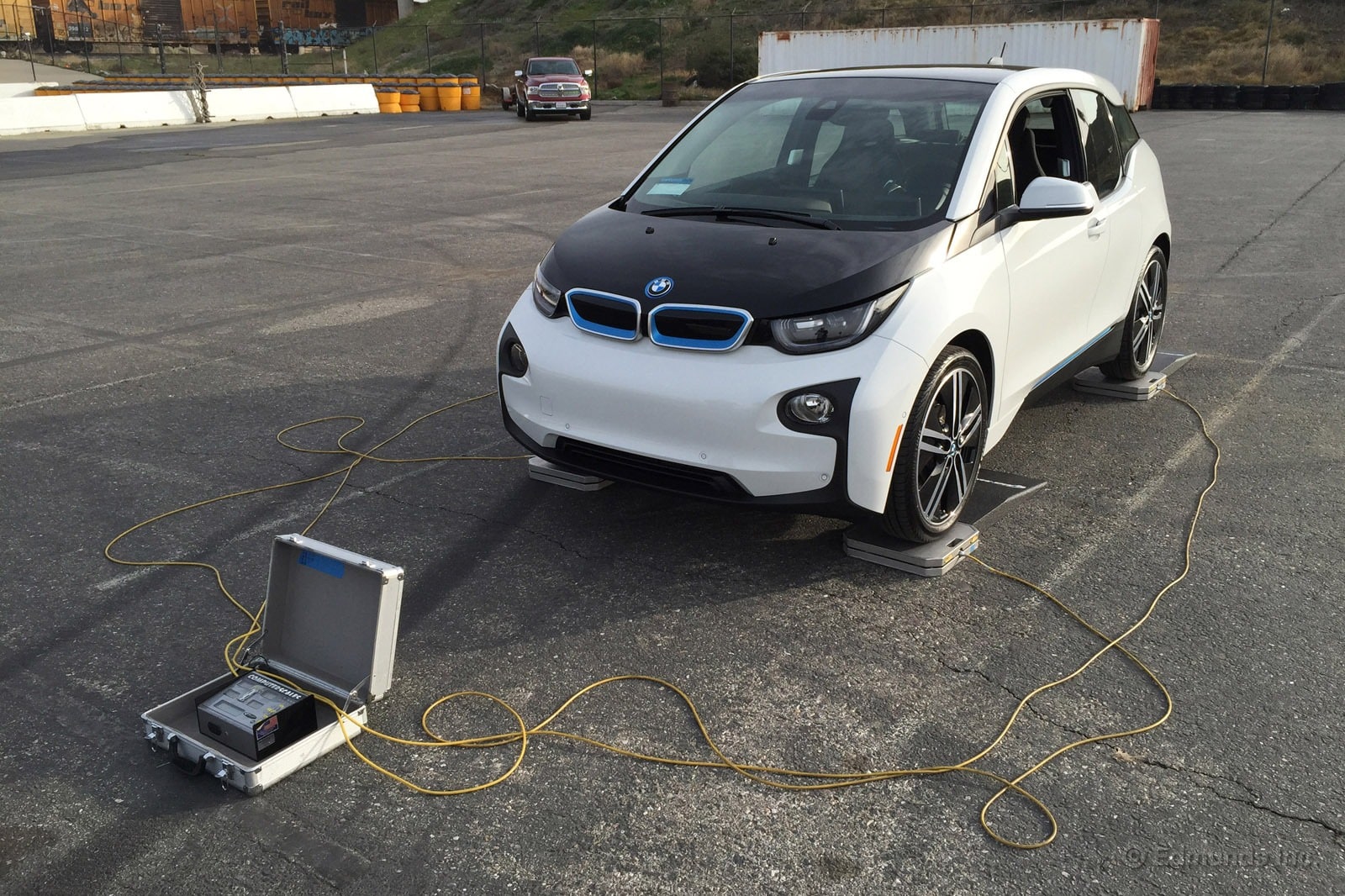
So far, our 2014 BMW i3 has been a hit with everyone in the office. It didn't take long for the quirky electric i3 to be ready to undergo our standard series of tests at the track. Our first test was fully charged in default electric mode. Upon depleting the battery, we ran a second test solely on the gasoline-powered range extender. Here's what we found.
Vehicle: 2014 BMW i3 with Range Extender
Odometer: 1,606
Date: 1/20/2015
Driver: Chris Walton
Price: $54,800
Specifications:
Drive Type: Rear-wheel drive
Transmission Type: one-speed direct drive
Engine Type: Permanent magnet synchronous electric motor
Horsepower (hp @ rpm): 170 @ 4,800
Torque (lb-ft @ rpm): 184 @ 0-4,800
Brake Type (front): One-piece ventilated disc with single-piston sliding calipers
Brake Type (rear): One-piece solid disc with single-piston sliding calipers
Suspension Type (front): Independent MacPherson struts, coil springs, twin-tube dampers, stabilizer bar
Suspension Type (rear): Independent multilink, coil springs, twin-tube dampers
Tire Size (front): 155/60R20 80Q
Tire Size (rear): 175/55R20 85Q
Tire Brand: Bridgestone
Tire Model: Ecopia EP500
Tire Type: Low rolling resistance, summer
As-Tested Curb Weight (lb): 3,124
Test Results:
Acceleration: (All runs with Traction Control on. Secondary runs are with the battery depleted and range extender recharging the battery)
0-30 (sec): 3.1 (w/ battery depleted 3.8)
0-45 (sec): 4.7 (w/ battery depleted 7.7)
0-60 (sec): 7.1 (w/ battery depleted 13.7)
0-60 with 1-ft Rollout (sec): 6.8 (w/ battery depleted 13.3)
0-75 (sec): 11.2 (w/ battery depleted no time)
1/4-Mile (sec @ mph): 15.6 @ 85.6 (w/ battery depleted 19.2 @ 64.7)
Braking:
30-0 (ft): 28
60-0 (ft): 111
Handling:
Slalom (mph): 63.2 w/ESC on
Skid Pad Lateral Acceleration (g): 0.78 w/ESC on
Comments:
Acceleration comments: Just like the i3 without the range extender, the car simply eases into gentle, linear acceleration that has no peaks/valleys or shifts. It's probably a good guess that this i3 is slightly slower across the board due to the added weight of the range-extending engine.
Braking comments: Again, just like a previous i3, this one stops remarkably short for how little tire contact patch is on the road. Excellent stability and little dive with good heat capacity in the brake system that allows it to maintain good effectiveness despite repeated stops.
Handling comments: I know I'm starting to sound like a broken record here, but as with a previous i3 slalom test, the steering ratio is so quick, and so difficult to acclimate to during testing, that I wonder if consumers are noticing. It requires very little driver input to affect a pretty drastic change in direction and attitude. What the i3 has going for it, however, is its short wheelbase, wide track and sophisticated electronic-stability program (ESP) that allow it to weave through the cones with enthusiasm and confidence (zoomy steering notwithstanding). The i3 with range extender was better able to manage its extra weight here (essentially making identical results) than it was during acceleration and braking where the test results show a negligible difference. On the skidpad, the ESP would first reduce the vehicle speed with very subtle throttle adjustments before it would actually grab a brake. Steering was less frenetic/unpredictable here as the steady state doesn't draw attention to the quick responses seen in the slalom.
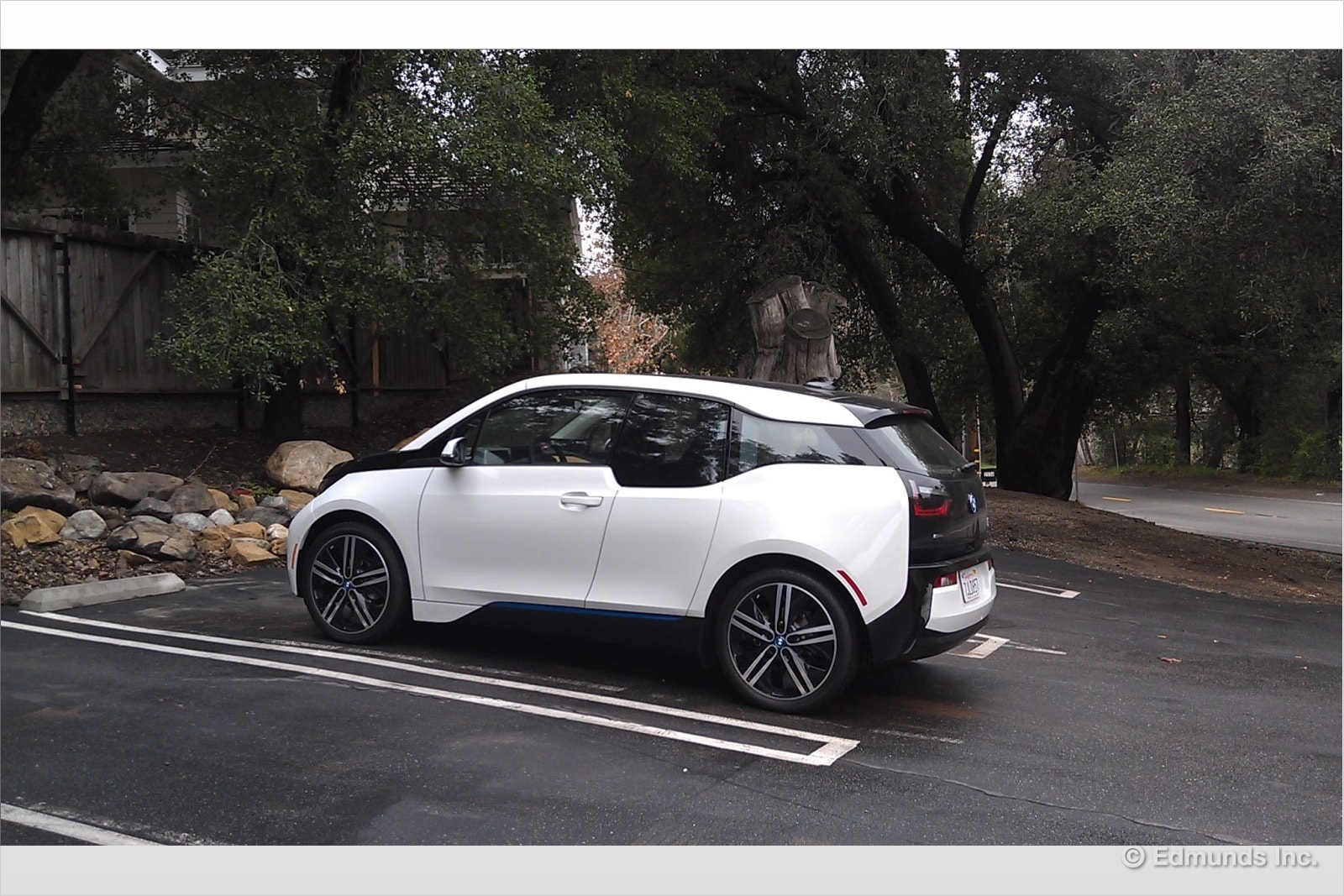
After getting some seat time in our 2014 BMW i3, I was struck by how it reminded me of our old Nissan Juke long-termer. Before you question my state of mind, let me elaborate. As with the Juke, the i3 is, at least to my eyes, ugly. Really, with such a disjointed look, especially in profile, it looks as if the three blind mice were given the project. But as with that frog-like Nissan, the i3 quickly won me over with its engaging personality.
Like the Juke, the i3 is fun to drive. It's energetic, and has an easy-going nature. The silent, smooth rush of power when you toe into it never gets old and the rather strong regenerative braking means I rarely had to touch the brake pedal, even when coming to a stop if I timed it right. It encourages smooth, efficient driving.
The i3's small footprint, good outward visibility (increasingly rare with newer cars) and quick steering make maneuvering in crowded parking lots and city traffic a snap.
Lastly, (and something not shared with the Juke), the i3's green nature also appealed to my "save the planet" side. Heck, I even switched it into "Eco-Pro" mode while tooling around on Sunday and went about 73 miles on the battery pack before the gas-powered range extender kicked in.
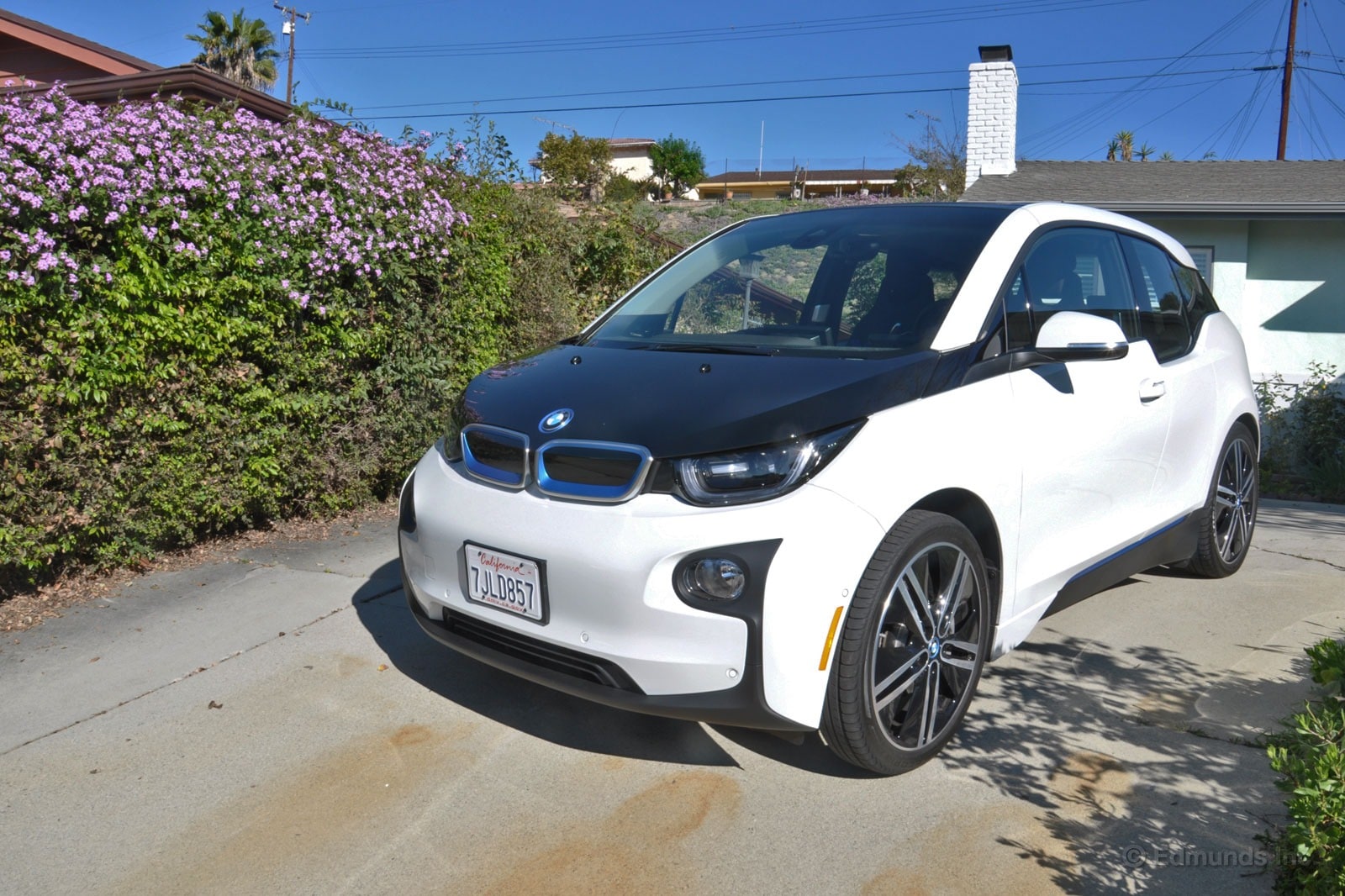
It's almost a backhanded compliment to say that electric cars make great city cars, because well, they aren't good road trip vehicles unless you have access to Tesla's Supercharger network, right? But our long-term 2014 BMW i3 is really an excellent commuter car and there's nothing backhanded about that praise.
I don't actually live "in the city" but in a congested suburb that was once considered well outside the city but is now among L.A.'s inner bedroom communities. It takes me an average of 70 minutes to cover 20 miles between home and the office.
Not only did I enjoy using our BMW i3 for my slog, it was interesting as a comparison to our old long-term Mini E. All EVs are still science projects to some extent, but the i3 is a far more practical vehicle than its forbear.
Driving the i3 reminds me much of the electric Mini. As we observed in our BMW i3 road test, powerful regenerative braking kicks in as soon as you breathe off the accelerator pedal. It's surprising at first, but you soon realize it's an ideal characteristic in heavy traffic with more stopping than going because you can drive with one pedal instead of continually jamming on the brake pedal. And of course this regen effect is good for maintaining the batteries' charge so that the range extender engine is more of a backup plan rather than something you'd use all the time.
I also like the i3's quick steering. Clearly, it's larger than a Mini E, but there's nothing lazy about its responses when you're maneuvering through traffic. It doesn't feel like other BMWs per se, but it's fun in its own way.
What I didn't expect to like so much about our i3, though, is the packaging. The driving position is akin to being at the helm of a small minivan, and I love that. You can't see to the tip of its nose, but there's superb visibility in all directions and an amazing sense of space in the cockpit. It's a different feeling than in any other BMW, but it's not different to the point of being weird. The seats are still supportive. The iDrive still works the same way. There's just more negative space than I was expecting, and I mean that in a very positive way.
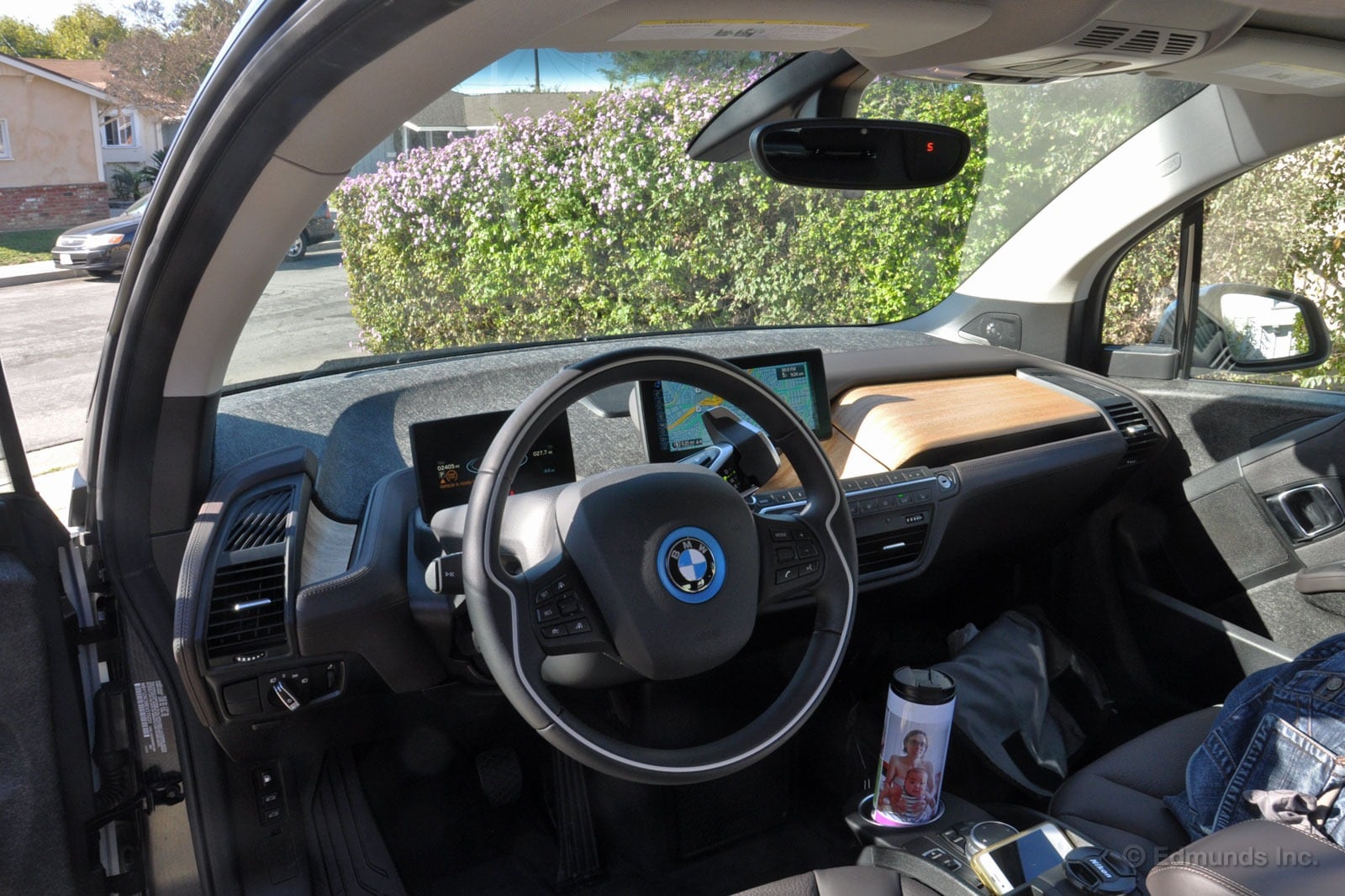
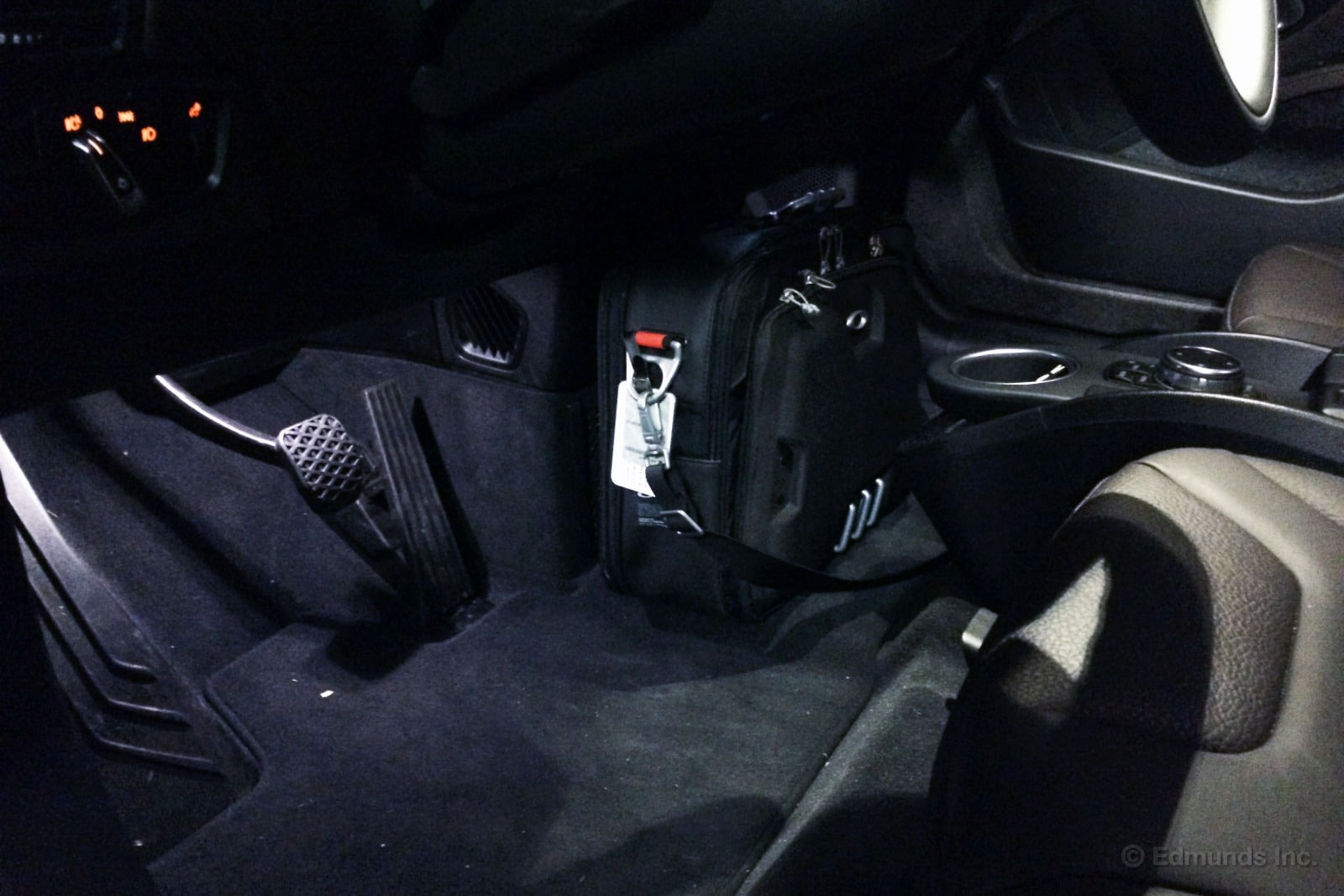
One of the reasons my mother loved her first- and third-generation Honda CR-V was the open floor space in between the front seats as well as the low and/or non-existent center console. There were two reasons. First, she appreciated the sense of openness. Second, she'd usually keep her purse in that open area, or it would at least make it easier for her to access her purse when it sat on the floor. It was with this in mind that I knew my mother would love the 2014 BMW i3.
Sure enough, when we visited the Los Angeles Auto Show in November, she fell in love with the i3. She loved the sense of openness created by the aforementioned open center floor as well as the greenhouse-like forward visibility. The elevated seating position helped too.
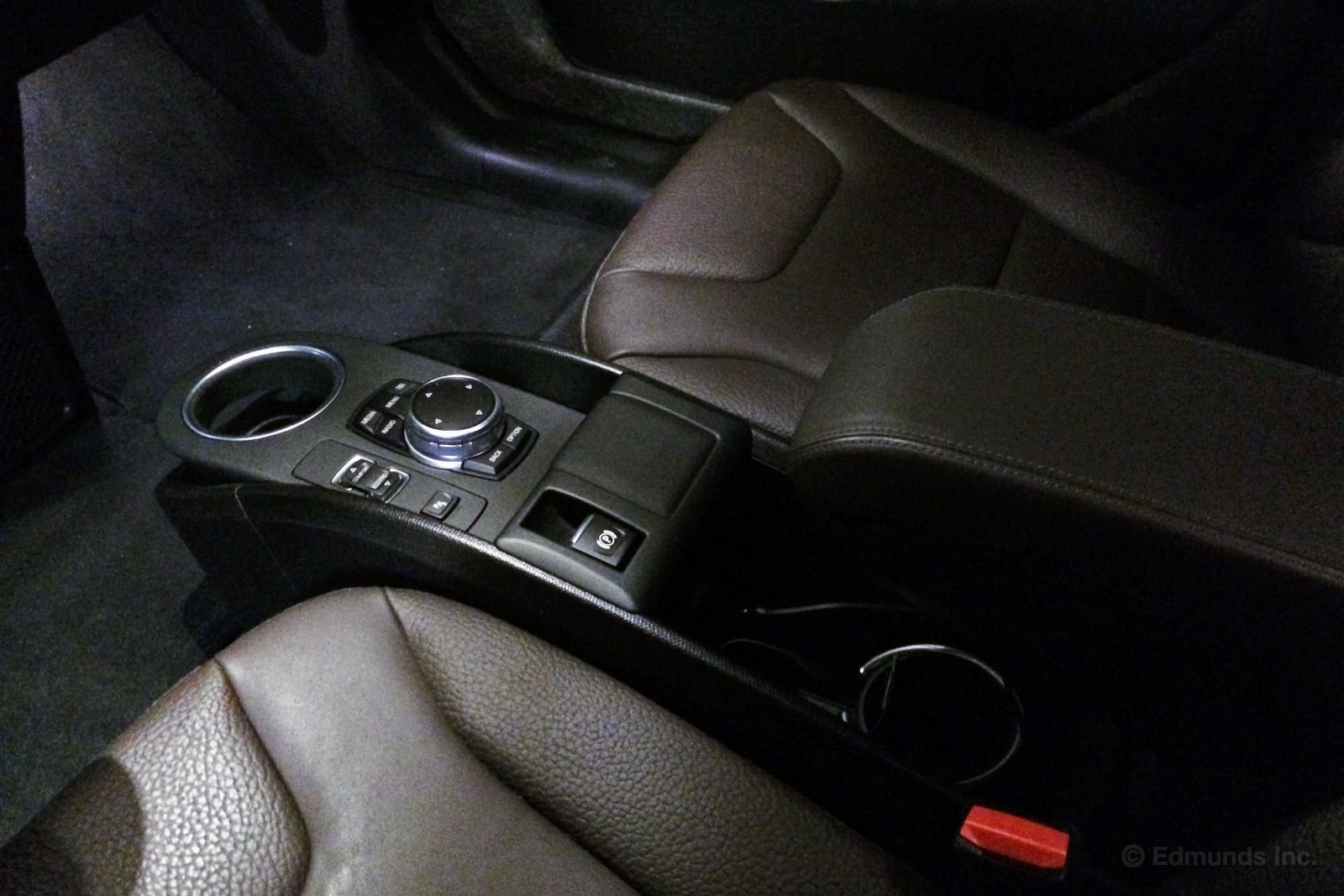
Today's CR-V now has a traditional center console, and off the top of my head, you have to get a pickup or a minivan to have an open floor in between the seats. I suppose there's the Tesla Model S, but that's just confusing. (Do EV drivers dislike center consoles?)
Now, could that open space be better utilized with a large, enclosed bin or a second, permanent cupholder? Perhaps. That would certainly be a similar argument to the one I made in regards to the Tesla. However, as far as mother is concerned, the BMW i3 is perfect as it is.

Like so much of the 2014 BMW i3, the steering wheel is unusual. But also like so much of the i3, the steering wheel is awesome.
The wheel is small in diameter. It telescopes far out on a steering column so long that it previously saw use as a space shuttle gantry. It has two spokes perfectly contoured to your hands and perfectly placed at 3 and 9. Having only two spokes also opens up the lower wheel portion, which is nice for those who shuffle steer. Its secondary buttons and controls are pretty much the same as those found in other BMWs. And finally, it looks pretty cool.
Whereas the original, BMW-made Mini Cooper's two-spoke steering wheel was all form over function, the i3's is absolutely spot-on. Now, it wouldn't work in performance-oriented BMWs, but for the i3, it's perfection.
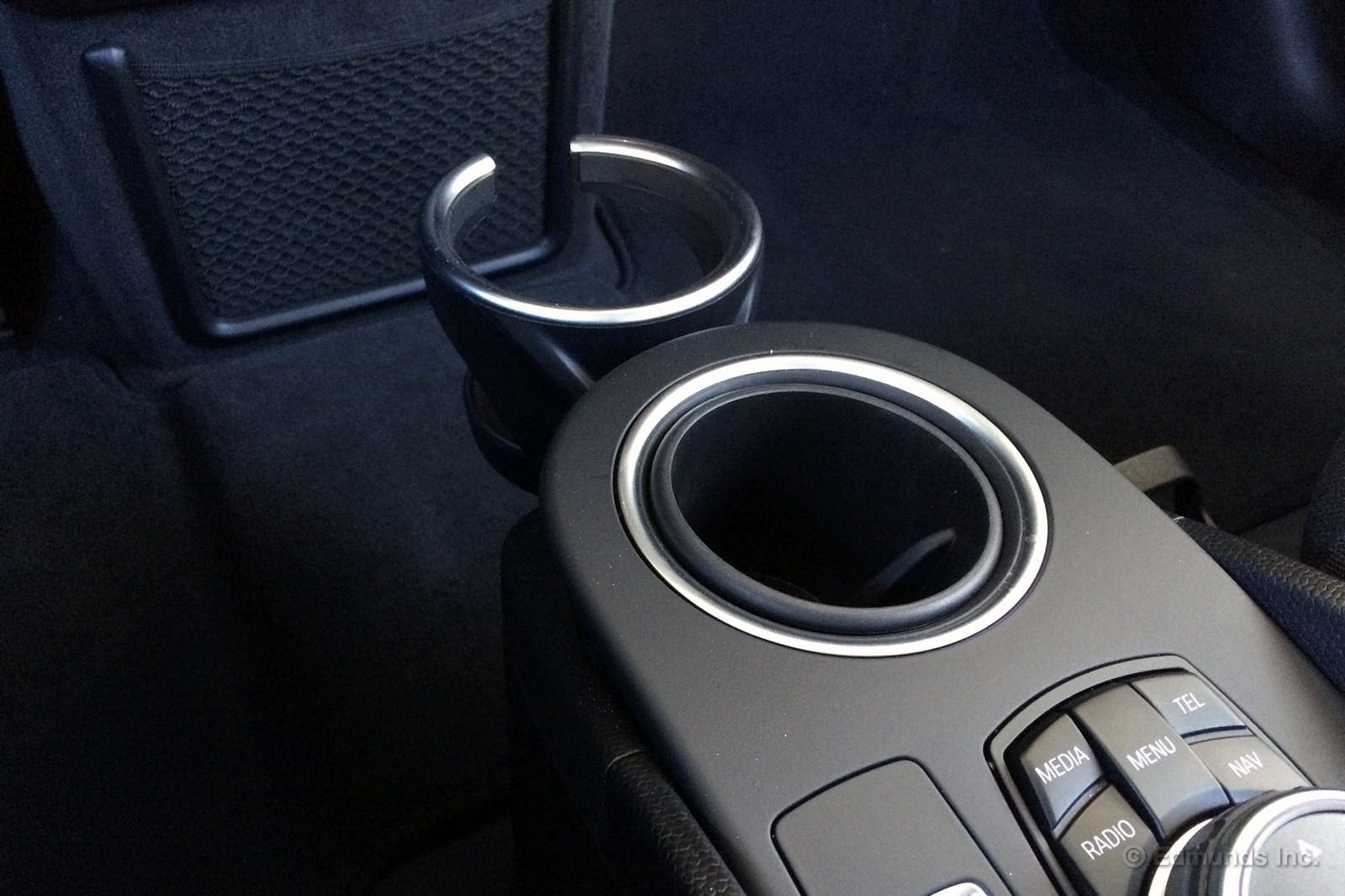
At first glance, the 2014 BMW i3 has only one cupholder up front. Au contraire.
In fact, there are two. The second is movable to four different (well, sort of) locations on the center console. It can be placed under the center armrest, or plugged into three slots in the forward-most portion of the center console. You could also purchase a second cupholder unit (around $60) and plug them both into the left and right forward positions to give you three in total.
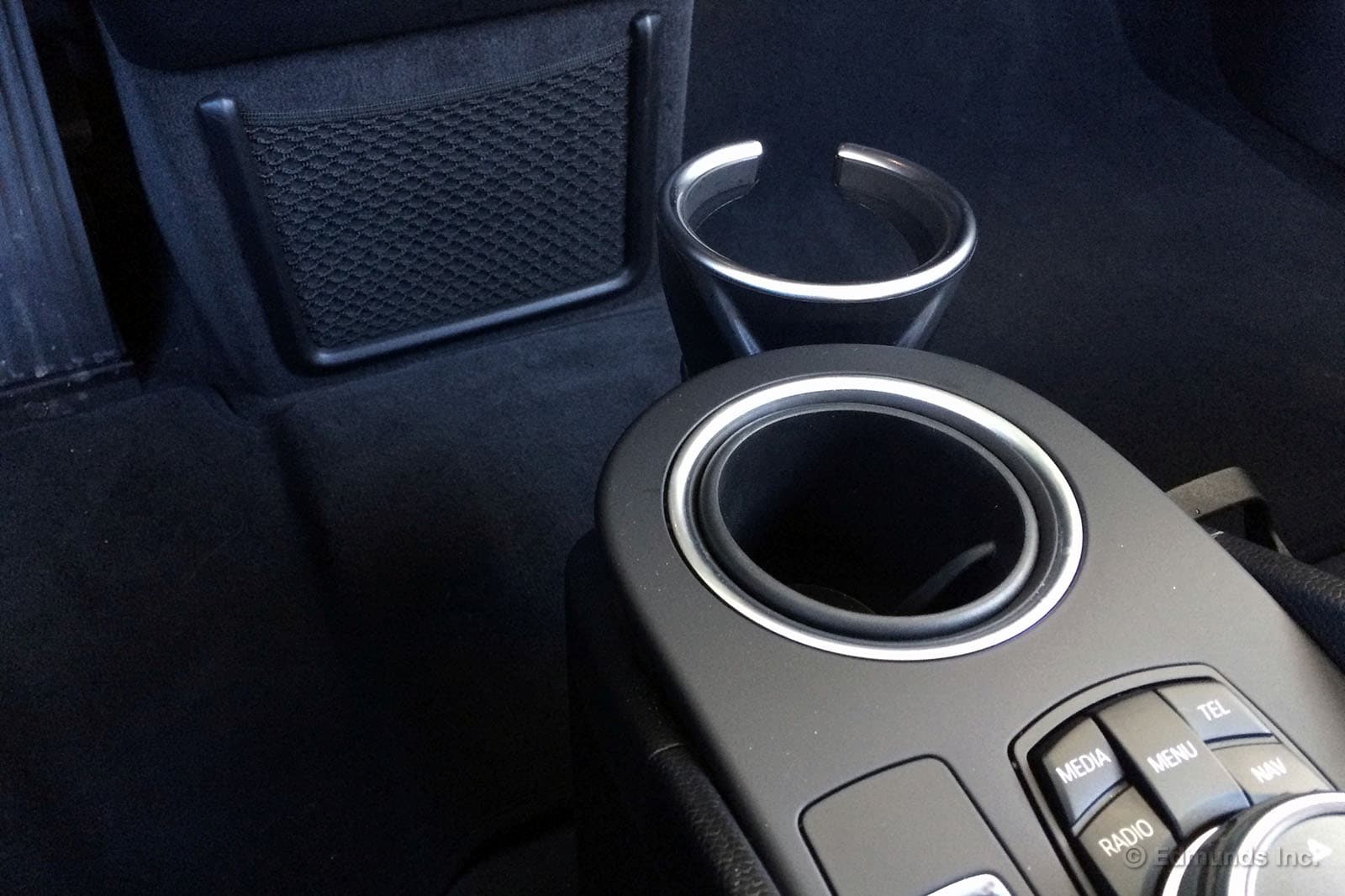

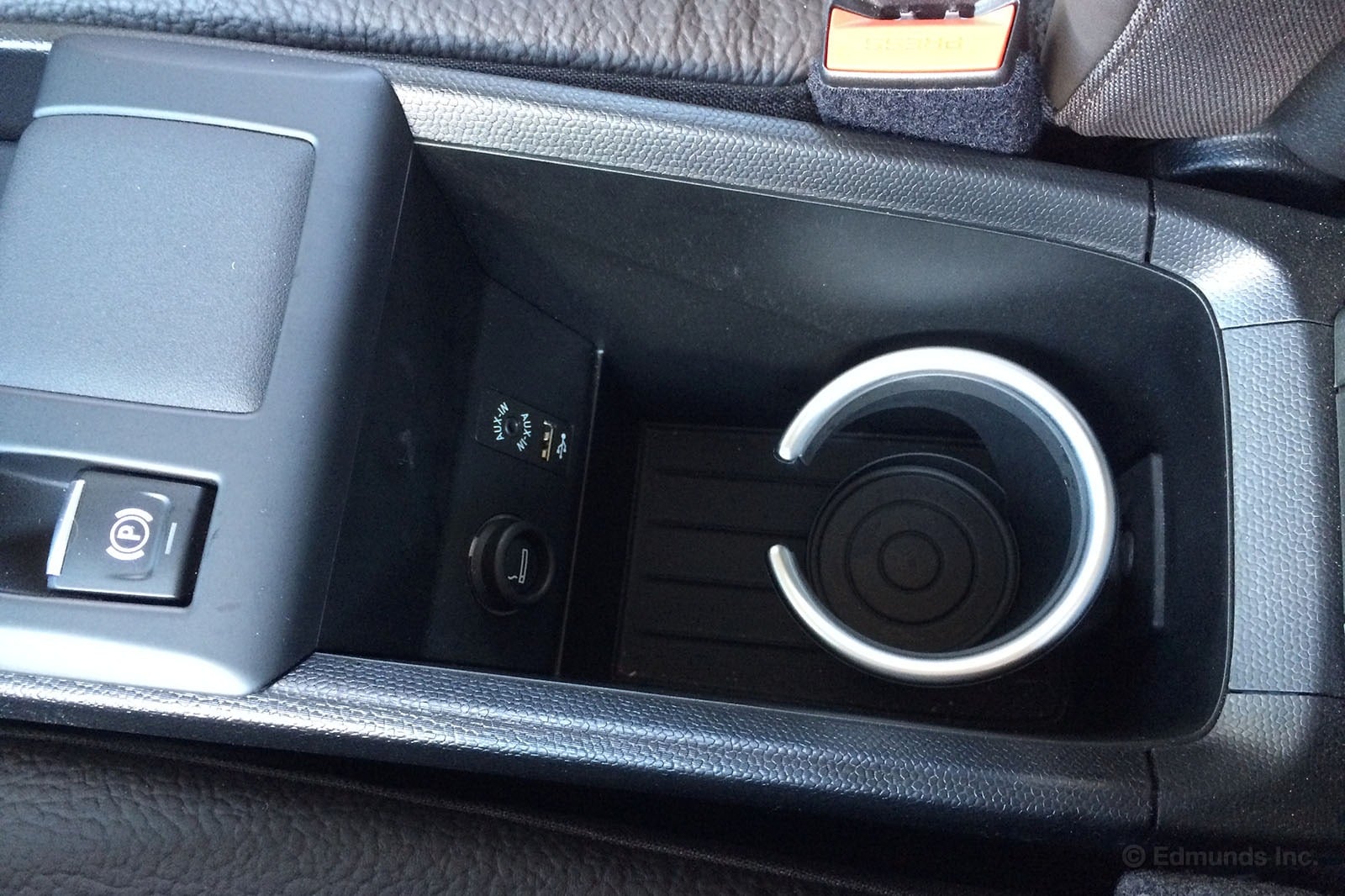
This, along with the little rubber cell phone holder you can place within both cupholders (movable and fixed), is a handy, versatile feature in what is in total a handy and versatile cabin.
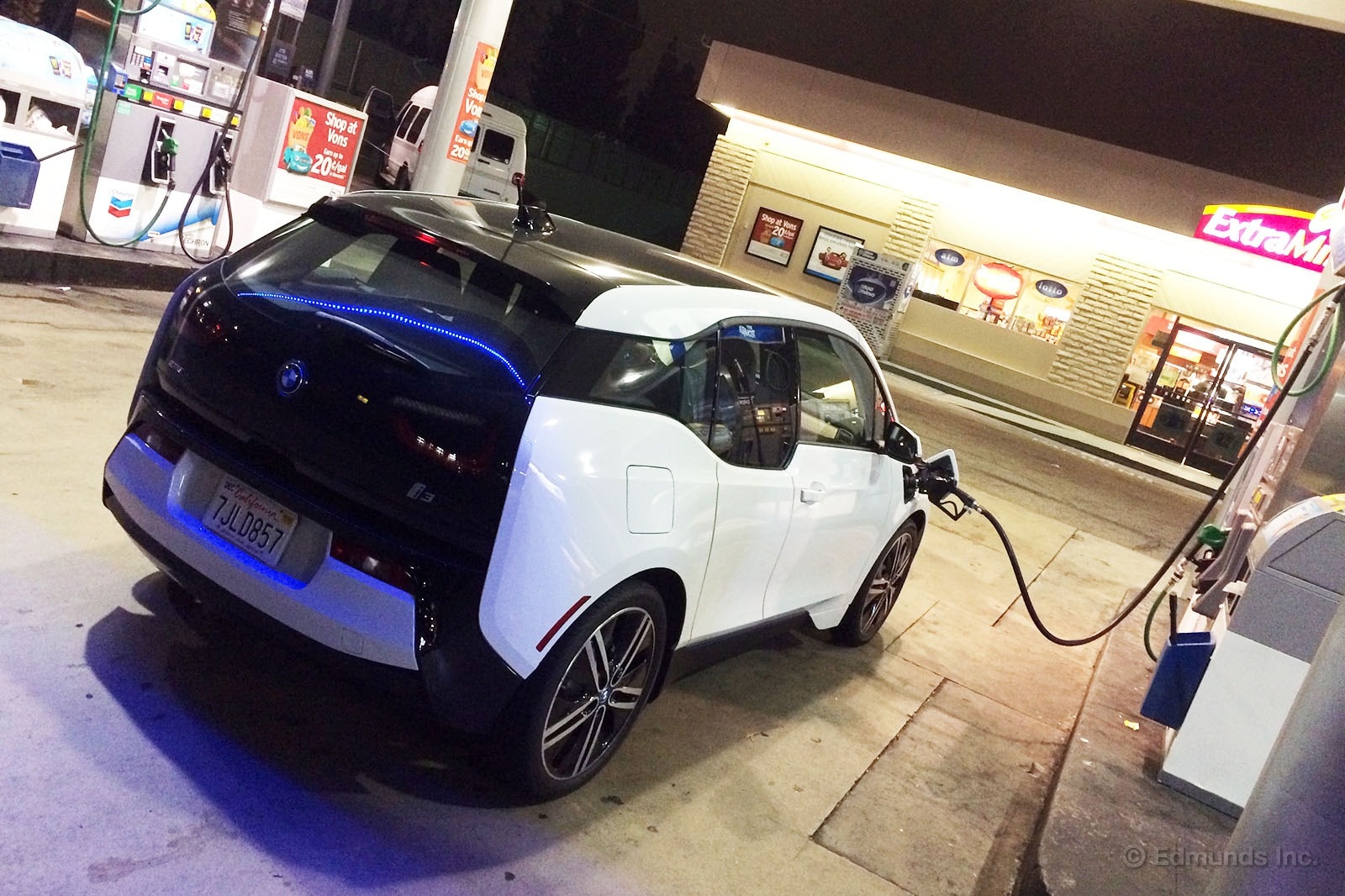
I knew I'd be driving 40 or so miles to Simi Valley, Calif., and back to visit the in-laws. I also knew I'd be making a return trip to downtown Los Angeles. There was any number of regular old gasoline-powered cars available with hundreds of miles of range, and yet, I chose to take our long-term 2014 BMW i3. It was time to test its range-extender engine.
Stuffed under the i3's trunk floor is a 647cc two-cylinder gasoline engine that serves as an emergency back-up should you need to go beyond the i3's electric range. It's a safety net, not the makings of a true plug-in hybrid, as its rinky-dink 2.4-gallon tank means you'd be hard pressed to drive very far.
We reached Simi Valley with 8 miles to spare on the battery, but the round trip to dinner with four aboard killed that remaining range. This was the first time I had experienced the range extender, which sounds a bit like someone is running a sewing machine in the trunk. It's frankly hard to notice when moving, but once the car is stopped, it is louder than the typical engine and produces more vibration (generating electricity and therefore not being at idle is a big part of that). However, it should be noted that, like a hybrid, it can shut down when the car stops if there's enough juice in the batteries to keep everything functioning.
In this suburban driving around Simi Valley and during the next day's journey into downtown Los Angeles, running on the range extender was perfectly pleasant. That initial burst of perfectly smooth and eerily quiet all-electric propulsion is still available, and despite adding engine noise to the equation, I wouldn't classify it as objectionable.
Having said that, I did experience the range extender's limitations. Despite using the i3's Eco Pro mode and accelerating economically leading up to the grade out of Simi Valley, the little engine had trouble keeping up with the increased electricity demands. No matter what I did with the accelerator, my speed gradually dropped from 74 mph down to 56 mph by the time I reached the summit. It would've kept going down had the grade been any higher or steeper. It was reminiscent of driving the Chevy Volt to Death Valley when I was reduced to a 28-mph crawl despite my foot being planted to the floor and the engine crying bloody murder. The i3 didn't get that bad, but we were certainly hearing its discontent.

That climb also didn't do much for the gasoline engine's range. As we later approached the Sepulveda Pass on southbound Interstate 405, the DTE meter read 26 miles. The navigation system said we were 21 miles to home. With another grade looming and my wife worrying, I stopped for a splash of fuel. Although, in the i3, a 1.1-gallon splash of fuel is good for half a tank.
Now, as it turns out, we actually would've made it home with 11 miles of range left since the Sepulveda Pass is clearly steeper and longer on its south side where the i3 mostly coasted and recharged its battery. Yet, this episode clearly demonstrates that opting for the range extender does not eliminate range anxiety. Rather, it simply transfers it from the battery to the tiny gas tank.
In case you're wondering, I got 32.6 mpg with the range extender. The initial highway bit with the grade out of Simi Valley was 26.6 mpg (the first fill) and the remainder, mostly around town and in traffic, was 38.3 mpg (the second fill). Keep in mind that this amounts to a very small sample size with an extremely small amount of gasoline burned.
In the end, my time with the range extender proved that you should avoid large highway grades and that an extra gallon or two in the gas tank would be helpful. However, it is still worth that extra amount of payment as I couldn't have accomplished the journey at all without it.
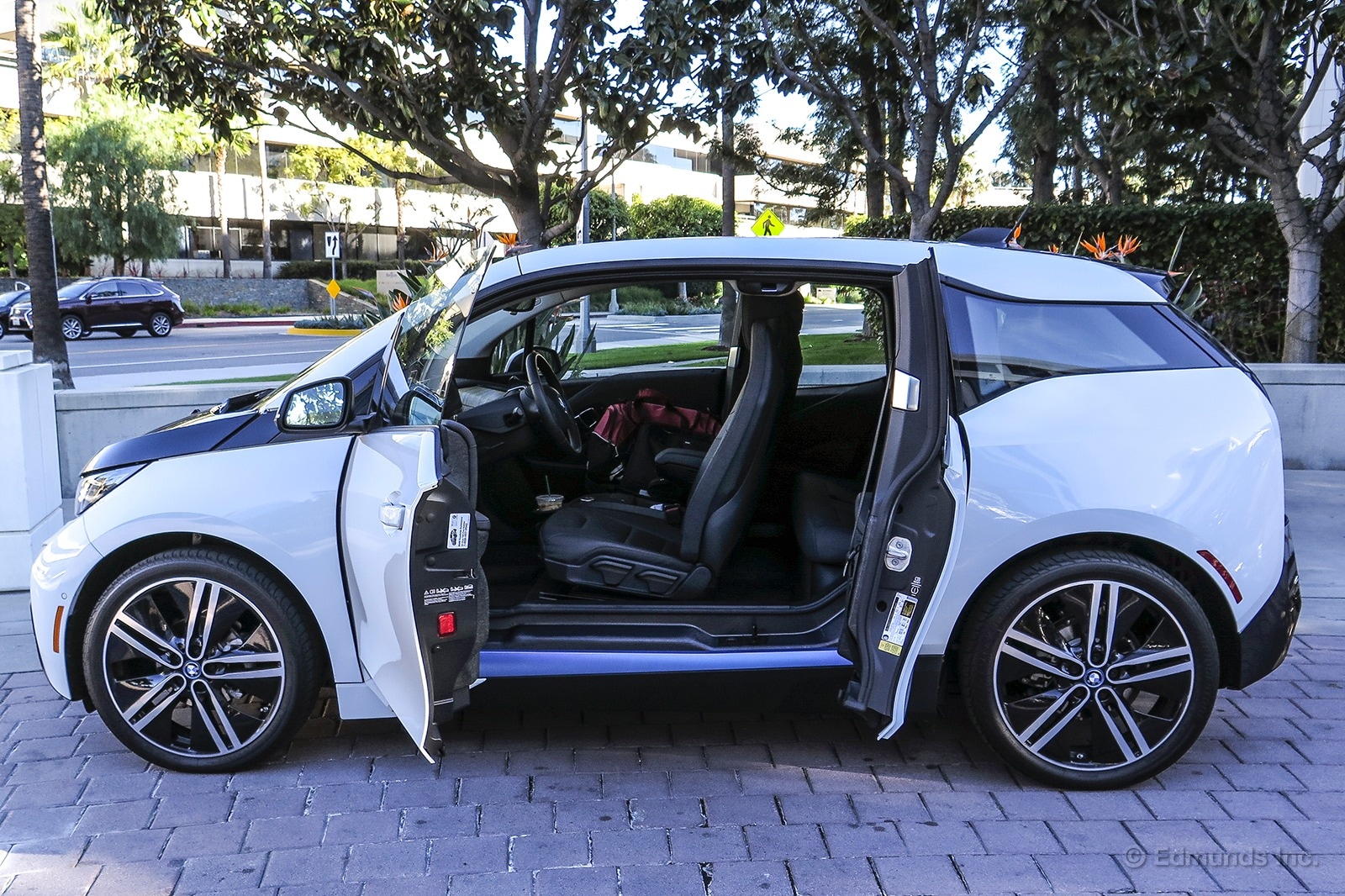
Not everyone likes the styling on our 2014 BMW i3. Admittedly, it has a complicated profile and a snub-nosed face that only a mother could love, but I like that it's different. It stands out from the crowd. Sure there are disjointed folds, interrupted character lines and mismatched colors everywhere, but I'm still a fan.
Aside from the endless aesthetic debate we could have about this car though, one of the design elements adds a bit to functionality: the clamshell doors
Once the front door is open, the back door opens from a rear hinge. I haven't had a chance to bust out the protractor yet, but I'd say the doors open somewhere between 90 and 100 degrees. Combined with the light, thin and easy-tilt front seat, this setup allows for quick and easy entry to the back seat, whether you're throwing your gym bag back there or having friends climb in. It's definitely preferable to a two-door car with massively-long doors where you have to slide the front seat all the way forward to get in.
There's also a decent amount of legroom in the back for such a small car. I'm 5-foot-9 and had no trouble sitting in the back seat with the front seat adjusted for someone of my size.
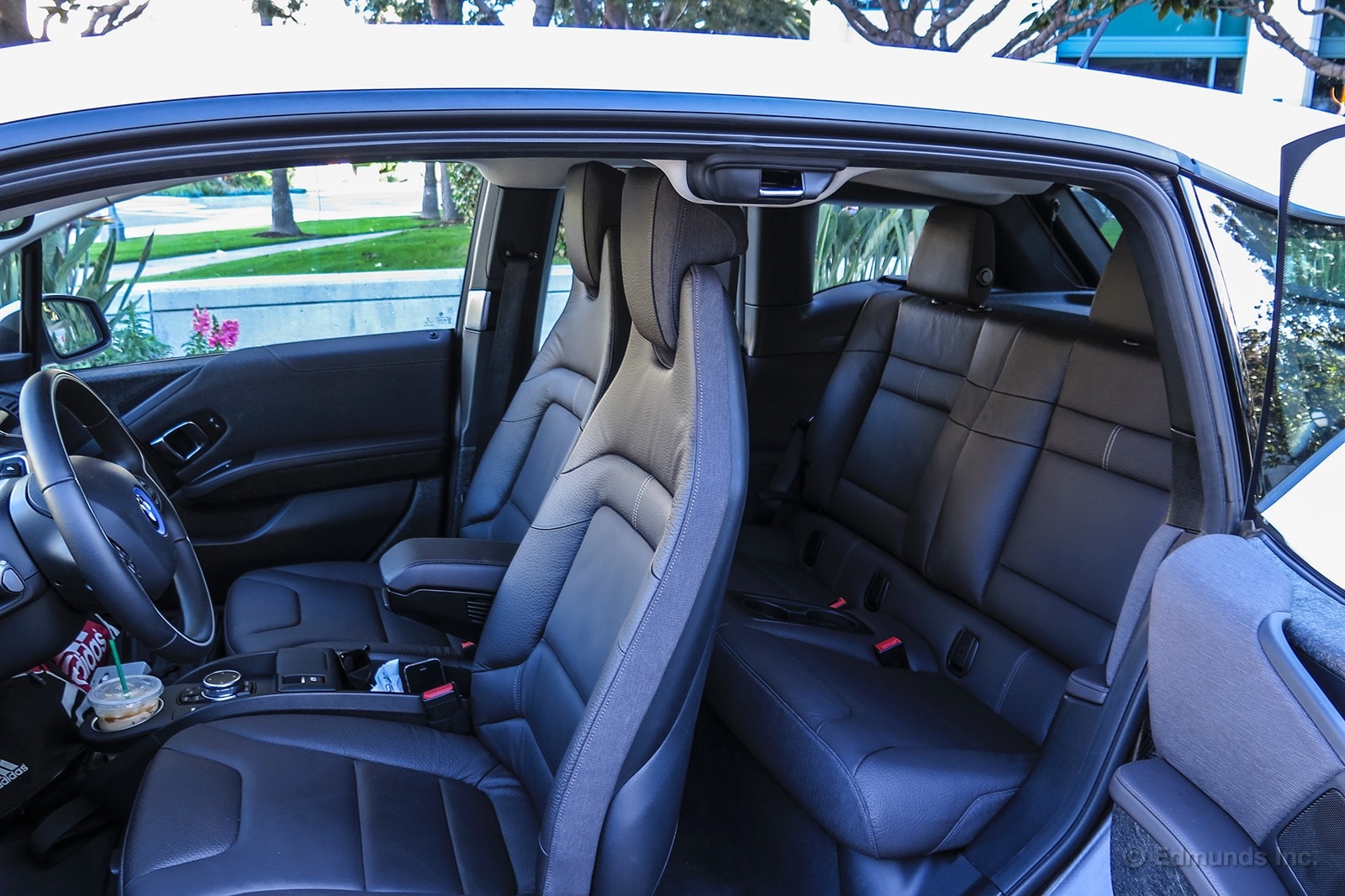
Unfortunately, step-in height on the i3 is relatively high (18.6 inches in front/19.6 in back) and the door opening height is pretty low comparatively (56.5/56.3 inches) so you have to hunch over to get in, whether you're going in the front seat or back seat. What's more, the upper latch for the clamshell will smack you right in the forehead if you've got the front seat folded forward and you aren't paying attention as you climb in to the back seat. Trust me on that one.
You can't open the rear doors without opening the front doors first, which is a potential annoyance for passengers, but I don't think it's a huge issue. Otherwise, the clamshell doors are seriously helpful, easy to use and, once you're inside, the cabin feels roomy enough for four.

I received the following email from our long-term 2014 BMW i3 recently:
Dear BMW ConnectedDrive Customer,
The state of charge of your V275231 is low!
We recommend recharging the battery.
Kind regards,
BMW ConnectedDrive
It seemed like a helpful note at first. But then I received at least 25 of these emails in the two months that we've had the car.
That email is sent every time the battery is low on the i3. They're directed to me because I set up the account with BMW. I could see this being somewhat handy as a reminder to plug in the battery-only version of the i3. But since our i3 has the range extender, this warning doesn't seem as useful.
I'd venture to say that electric vehicle owners are more keenly aware that they're low on charge than are people who drive conventional cars. After all, they know there is a gas station on virtually every city corner. Electric car drivers can't gamble like that.
In any case, these emails were becoming a nuisance and I wanted to opt out of them. I didn't see an unsubscribe button so I clicked on the only link I saw. It took me to a dead page with this message:
BMW - New Installation. This project didn't deploy content yet.
Not very helpful. Next I went into the "i remote" app on my smartphone. This is the designated app to check on charge status, efficiency and remote access. I figured the opt-out setting would be buried somewhere in the app. It wasn't.
Finally, I Googled "bmw connecteddrive customer portal" and I found a login page that asked me to choose my country. I clicked on "Americas," which narrowed down my choices to Mexico and Brazil. There was no option to pick the United States. The only other options were Australia, Europe and Africa. BMW must really want you to get these emails.
The only option I didn't try was the BMW owner's site, because my Connected Drive username and password didn't work. I'd likely have to set up another account, way too much trouble than its worth.
I'll just send these emails to the spam folder.
What do you think? Annoyance or convenience?
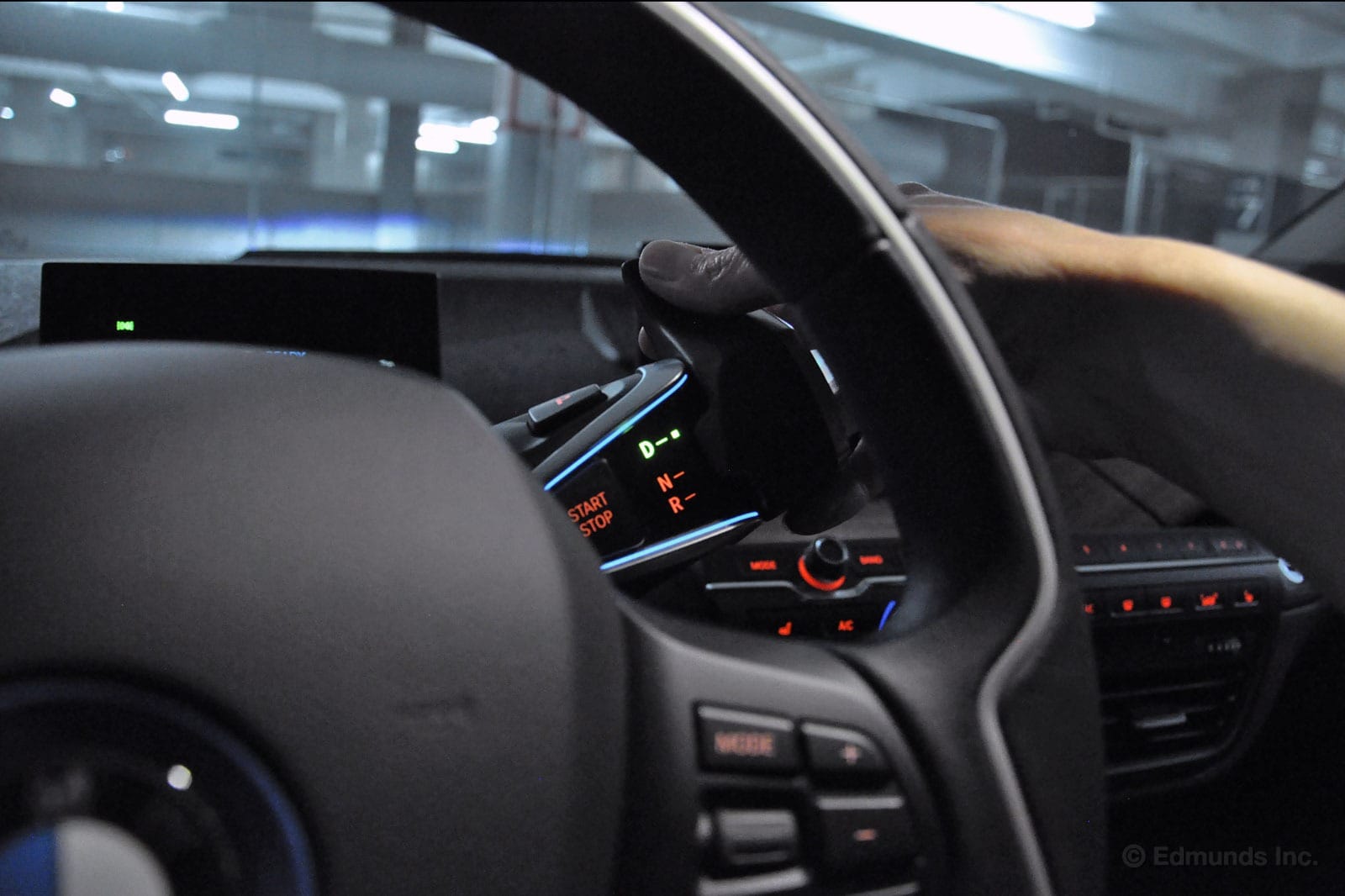
Sometimes I'm slow to learn new things. When I saw the column-mounted shifter in our long-term 2014 BMW i3, I was pretty sure I would get befuddled and make the wrong selection at some point.
After all, you twist the thing up to get Drive and twist it down to select Reverse. This seems backward to me, unless you think of "up" as akin to going forward and "down" as akin to backing up. I suppose that's what BMW's designers decided.
Regardless, I haven't yet selected the wrong gear in the i3. And I've found the shifter quite intuitive and ergonomic to use when switching between R and D while parallel parking. I really don't think about it at all in normal driving, and that's a good thing.
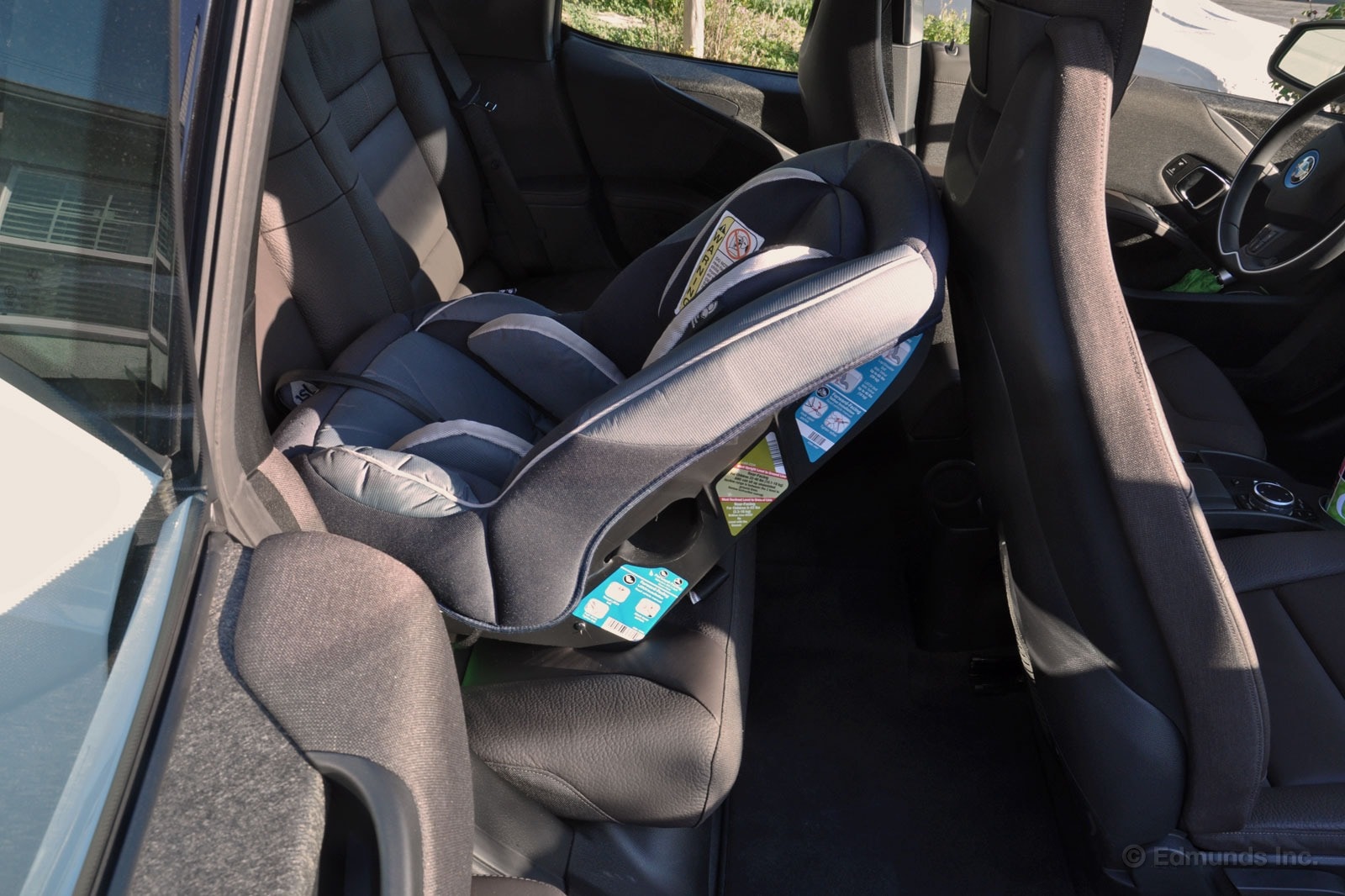
As we've written in our full road test and in our "A" rating on the 2014 BMW i3, this electric hatchback has more interior space than you imagine when you first walk up to it. The headroom is striking when you're in the driver seat. Yet, there's a surprising amount of legroom as well, and that's what really matters when you're installing rear-facing convertible car seats.
Because convertible car seats vary so much in shape and dimensions, you have to keep auditioning them until you find one that's a good match for your vehicle's backseat and your child. In this instance, I found that my second-string convertible car seat, a Safety 1st Guide 65, fit exceptionally well in the back of our long-term BMW i3. Not only is it a good match for our extended-range EV's interior dimensions, it conforms well to the shape of the BMW's seat-bottom cushion.

Although you can see that I used a pool noodle to get the desired angle for a rear-facing installation, it was much, much easier to achieve this angle than in any other car I've installed this Safety 1st car seat in to date. The LATCH anchors are easily accessible after you flip open the hinged plastic covers, and even with my car seat's rudimentary J-hook connectors, getting it hooked up was no problem.
What I really liked about the fit, though, was the ease of getting the car seat tightened down. Usually, there's a lot more trial and error involved when I'm installing a seat in a car for the very first time. But due to the shape and cushiony-ness of the i3's backseat, I got the Safety 1st seat snugged down to my satisfaction in a couple of minutes.
If I owned a BMW i3, this would probably be my convertible car seat of choice. I've mentioned before that I don't love the cushioning in this car seat (which retails for less than $100 and isn't exactly plush) and would hesitate to use it for long road trips. But that's OK in the i3, which isn't really intended for long-duration travel.
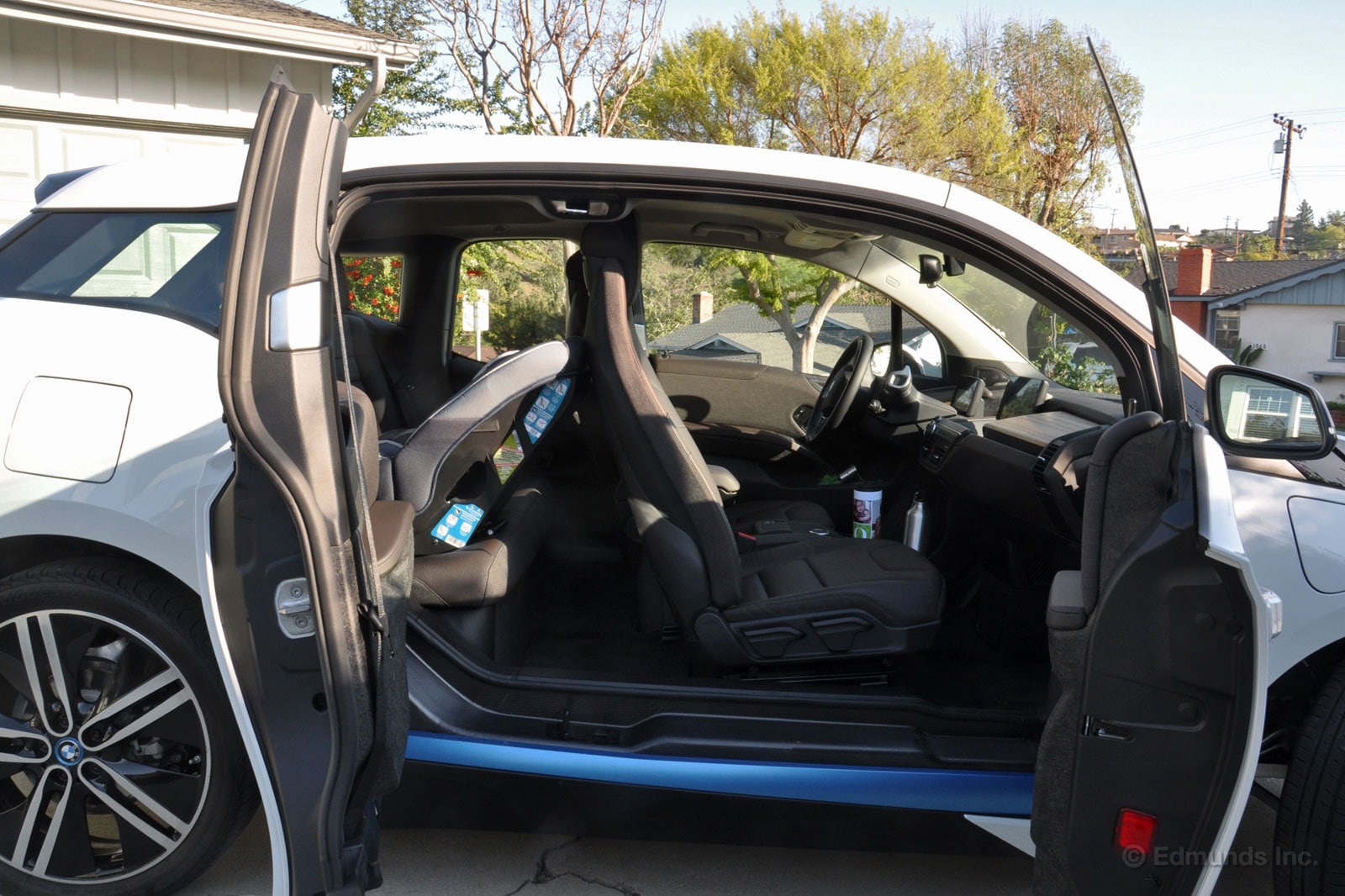
Life is just about as agreeable in the front passenger seat with this car seat installed. I might move the seat a notch or two farther back if there wasn't a rear-facing car seat behind it, but really, the legroom is adequate and the seat-back recline angle is livable. And my knees are quite a few inches from touching the dash (please ignore the stripey green socks if you can).
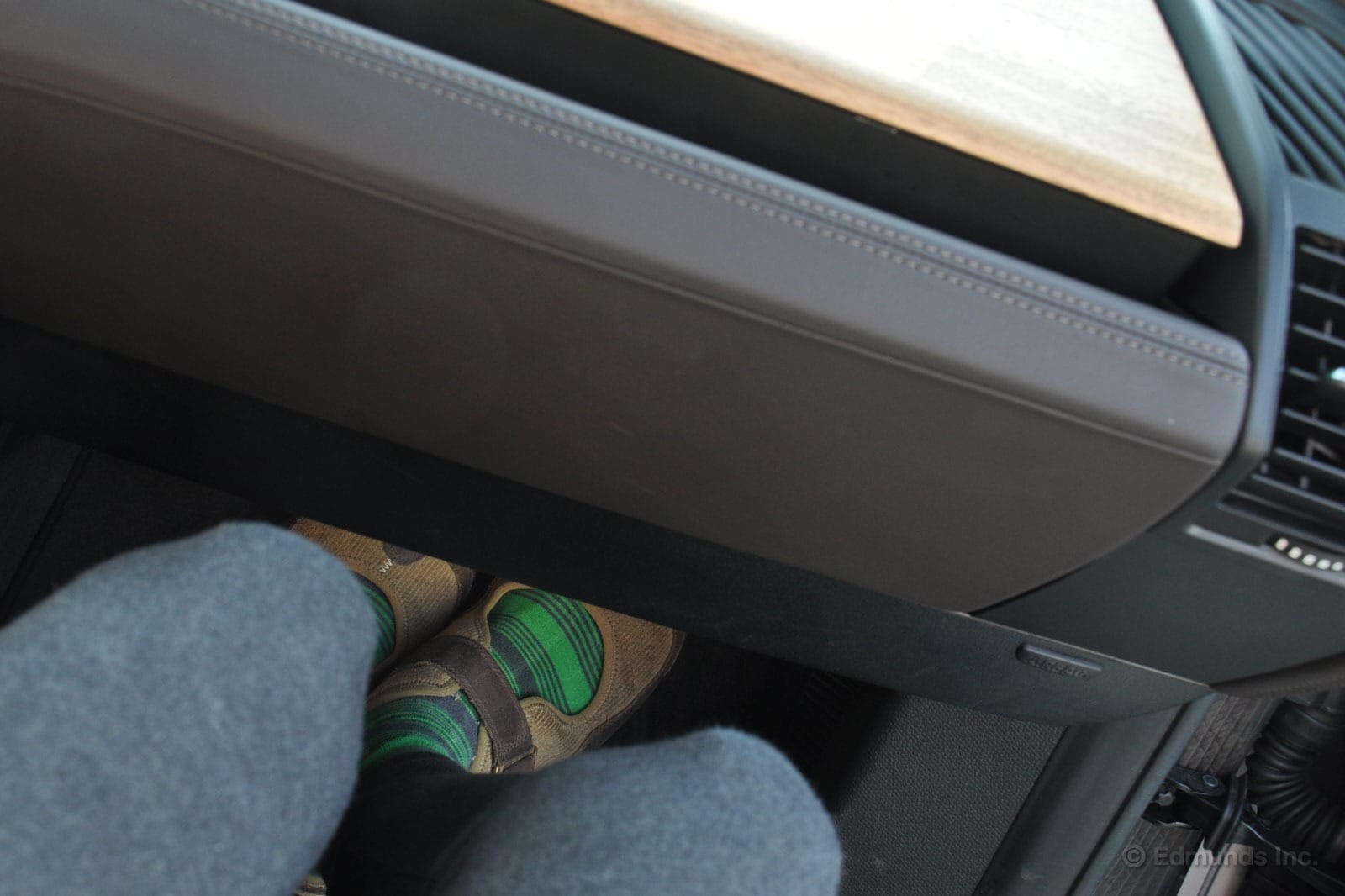
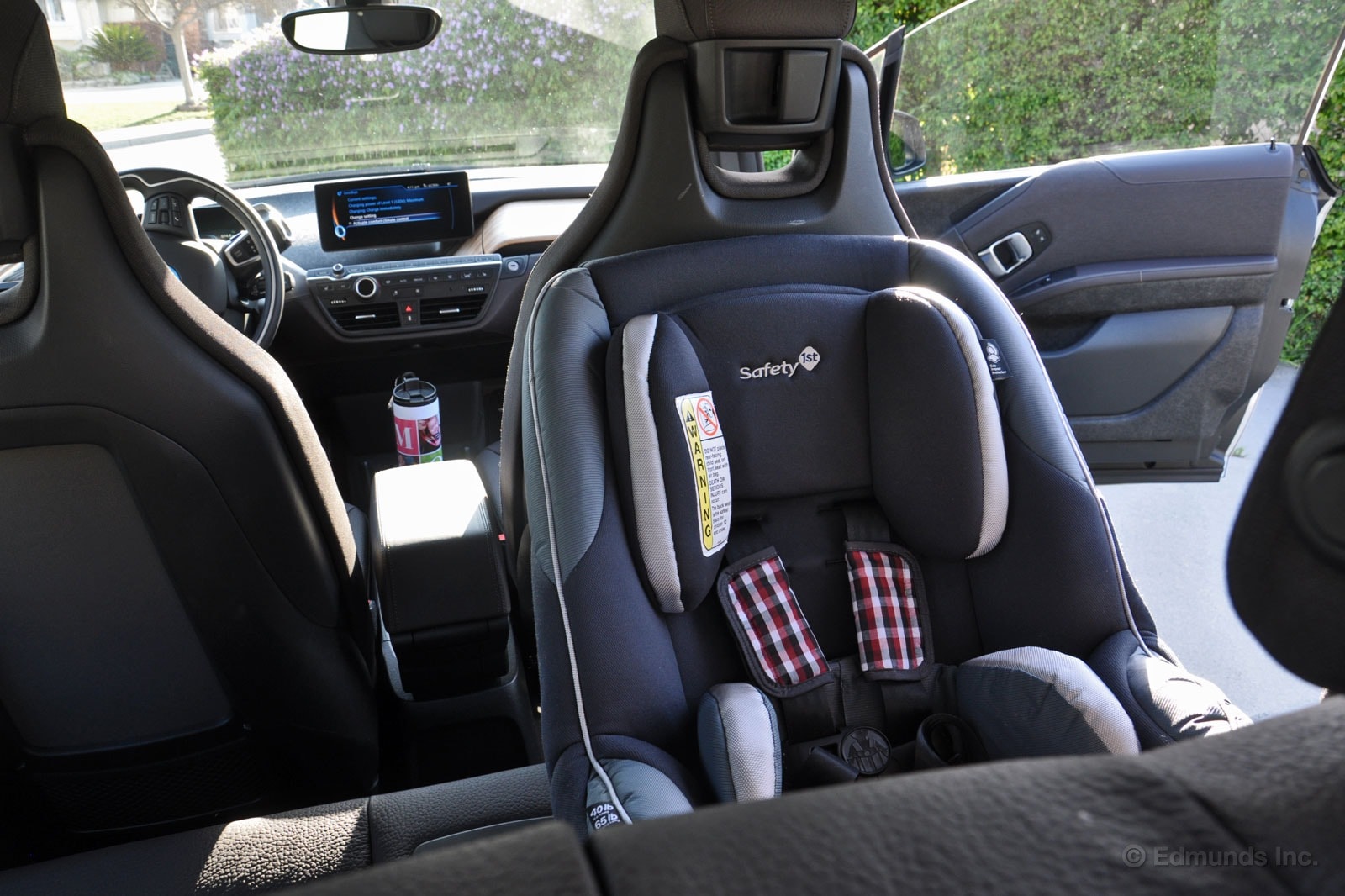
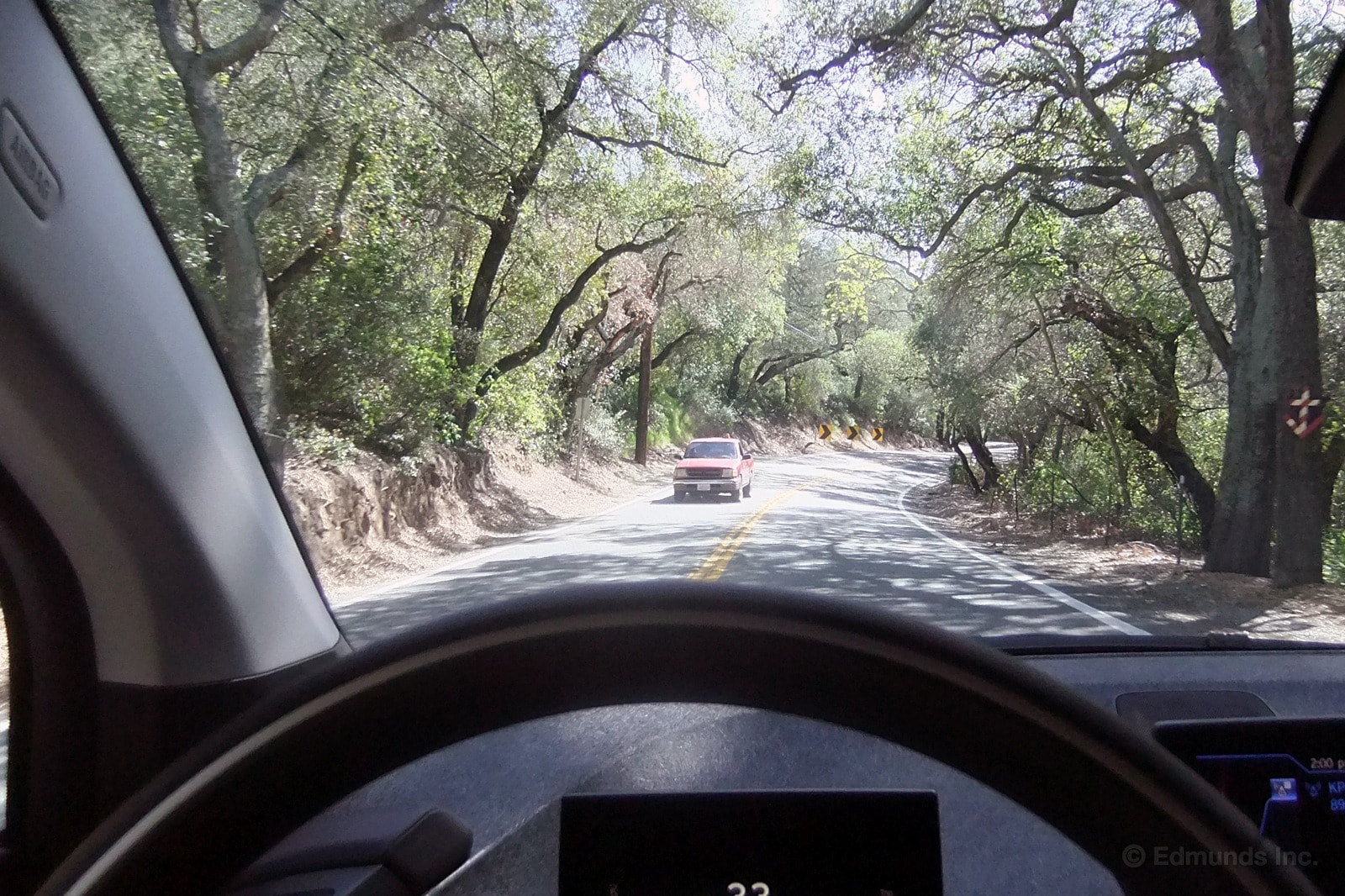
Beauty's in the eye of the beholder and while some find the design of BMW's all-electric city car to be on the ugly end of the scale, I find it appealingly quirky, as befits a futuristic car.
But the hard plastic interior surfaces of our 2014 BMW i3 leave a bit to be desired.
BMW uses a cotton-fiber reinforced plastic composite for the dash and door panels, and opted to leave it in its natural state as part of the overall design theme of green and sustainable. That's fine.

And from a distance, the matt-finished gray and white-streaked surfaces look okay, although kind of plain.
Up close, though, as when you are sitting in the driver seat and staring out across the large expanse of dash, the finish looks a lot like a wet wool blanket, or perhaps matted-down horsehair — on the horse.
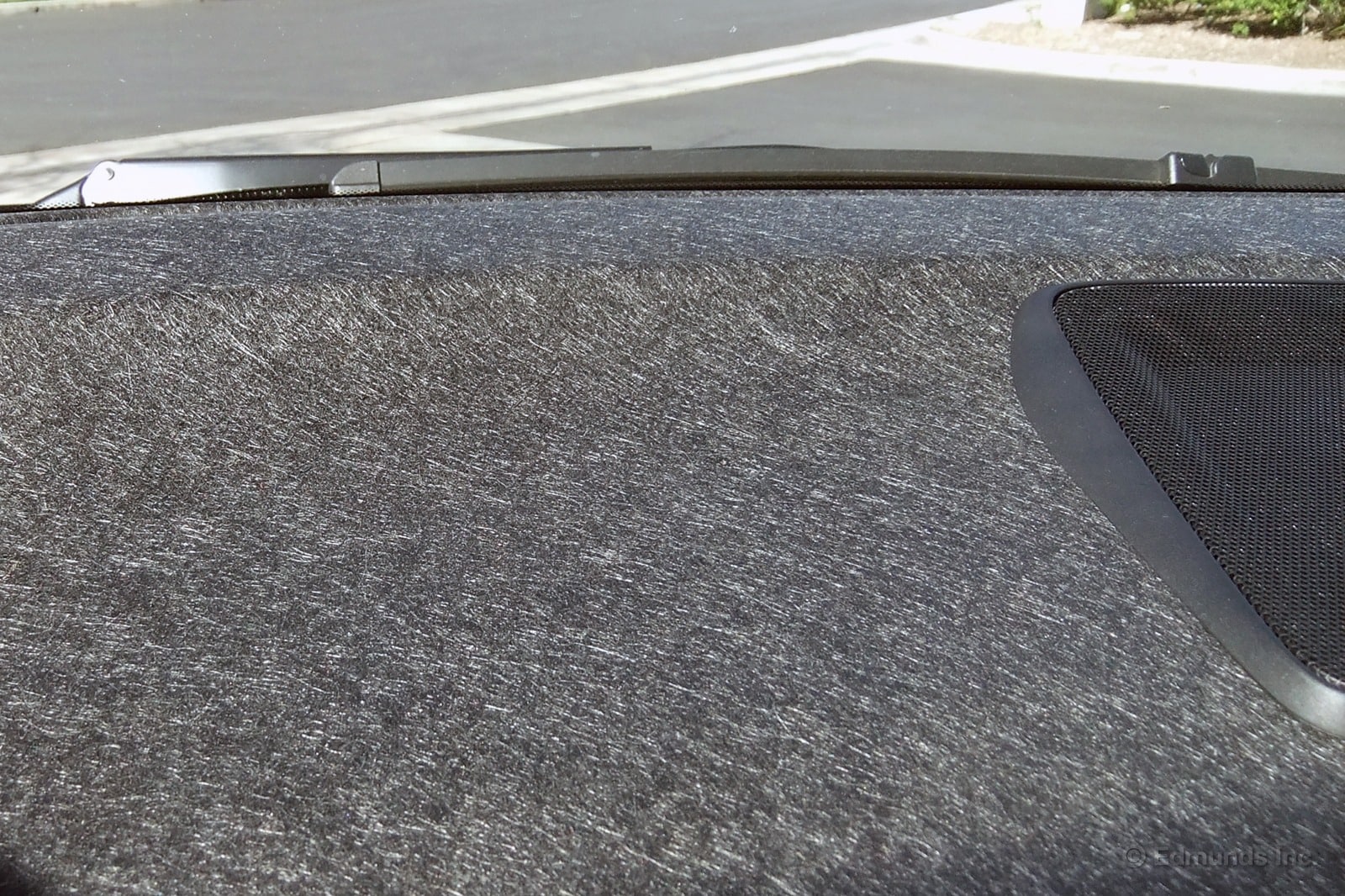
Same goes for the door panels. You want to pick lint off them even though there's no lint to pick.

That's au naturale, I guess, but not quite as refined a look as one might expect in such an otherwise technically advanced car.

Yes, I know our long-term 2014 BMW i3 was designed to be a short-haul commuter/city car, but it does have a BMW badge.
So I took it to my favorite stretch of country road in the Santa Ana Mountains (yes, we still have country roads in the otherwise densely developed O.C.) to see how much of Bimmer's sporty DNA was transferred to its battery-electric runabout.
Quite a bit, it seems.
While no M3, the BMW i3 with its low center of gravity — thanks to the hefty battery pack mounted below the seats — torque-y electric oomph and surprisingly grippy tires, did itself proud on the tortuous stretch of Live Oak Canyon Road that's also a favorite of the area's myriad motorcyclists.
The i3 slalomed through the curves with nary a hint of body roll. The comfortable front buckets kept both driver and passenger firmly in place. And those tall, skinny, low-rolling resistance Bridgestones (155/60/R20s up front and 175/55/R20s at the rear) never lost their grip, although I didn't push them to their limits.

Fortunately, the road is close enough to home that getting there and running up and down its roughly 5-mile length a few times didn't exhaust the i3's battery, which promised 67 miles of range (in comfort mode) when we unplugged and left the garage that morning.
Despite being pushed a bit on our jaunt in the canyon and up and down the hilly terrain on the way there, the i3 actually delivered 63.1 miles on its grid-charged battery before handing power-making chores over to the on-board generator, which does, indeed, sound a lot like a sewing machine ticking away under the cargo area floor.
Turns out that for a plastic-and-aluminum, electric-powered city car, the i3 manages to turn in a pretty good impression of a "regular" BMW if asked to do so.
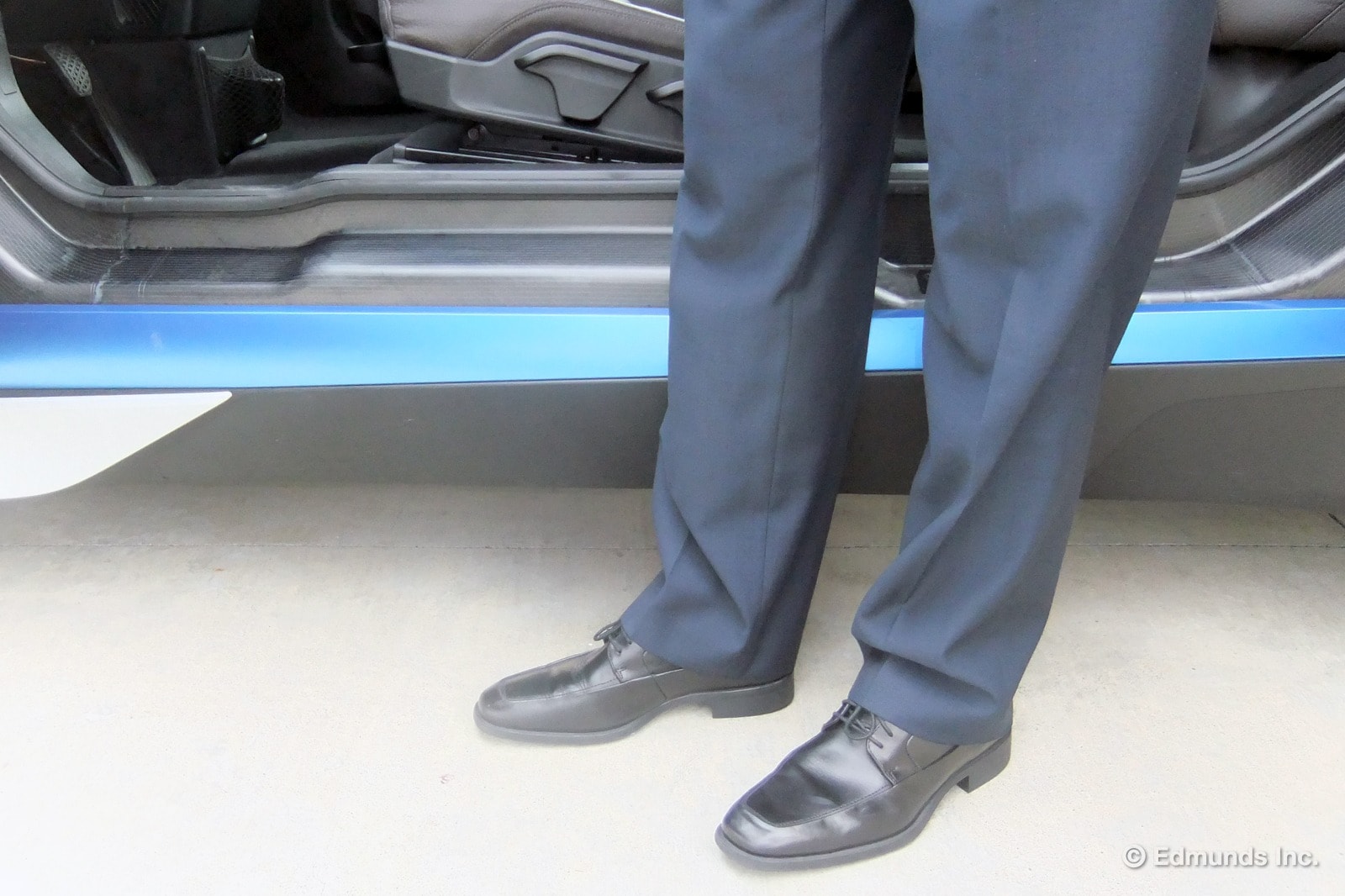
Admittedly, it's a first-world problem, but the unique carbon-fiber construction of the 2014 BMW i3 gives it a tall step-in height that tripped me up more than once while I was using our long-term model recently.
The height of the door sills doesn't require one to do a standing high jump to gain entry, but at 18.6 inches from the ground in front, 19.6 inches for the rear entry, they do require a stretch.
As the photo shows, the top of the sill is almost knee-high on a person who's 6'-3' tall. You've really got to bend your knee and lift your foot when opening that front door and preparing to slide in. Or else prepare to stumble and fumble and maybe fall into the seat instead of gracefully settling onto it!
There are pickups and SUVs with taller sills, but you expect to have to step up when entering a truck. Part of the problem with the BMW i3 is that it's a compact car so you don't really expect to have to clear a hurdle to gain access.
There's also a little optical illusion going on.
Instead of presenting a smooth, single-level sill, the bottom of the door frame is stair-stepped. There's that very visible blue rocker panel, but then there's a half-inch recess and a carbon-fiber step-up that's a couple of inches tall. And while that's what the eye and brain focus on, there's a third carbon-fiber stiffening rail, set back almost three inches, that you also must clear.
This wouldn't keep me from buying an i3 if I were in the market. I imagine I'd get used to it after a week of so of daily use. But I also can imagine it could present an issue for people with shorter legs, or stiffer knee joints, than mine.
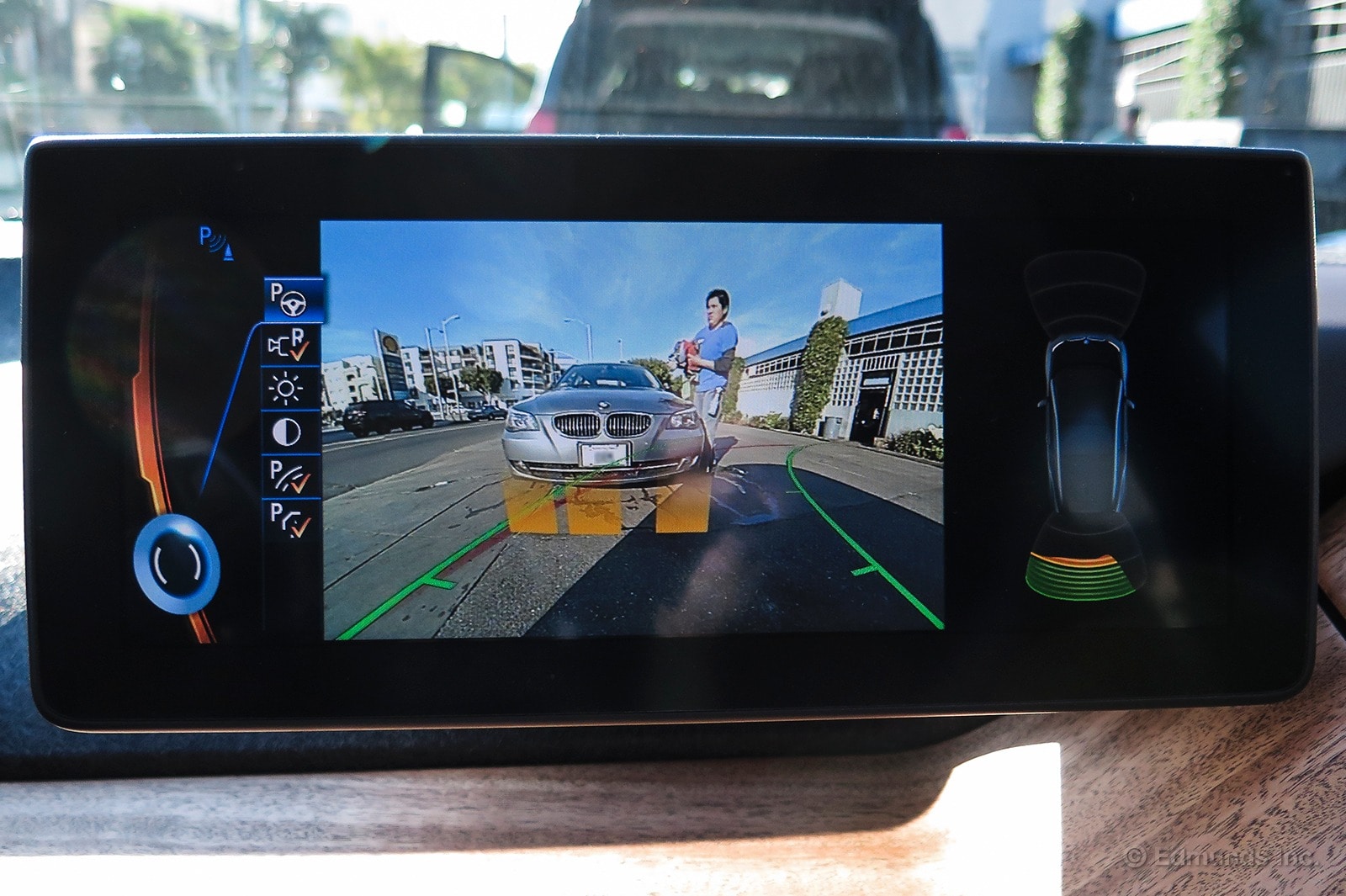
The center display screen in our long-term 2014 BMW i3 is one of the best I've ever seen. The resolution is crisp, the screen is barely affected by sunlight and the rearview camera provides an impressive amount of detail.
This first photo shows the rearview camera display (in broad daylight of course) along-side the parking sensors so it's not the harshest test of the i3's abilities, but it works well in several other scenarios too.
The second photo shows the audio graphics/album art, also just as pretty.
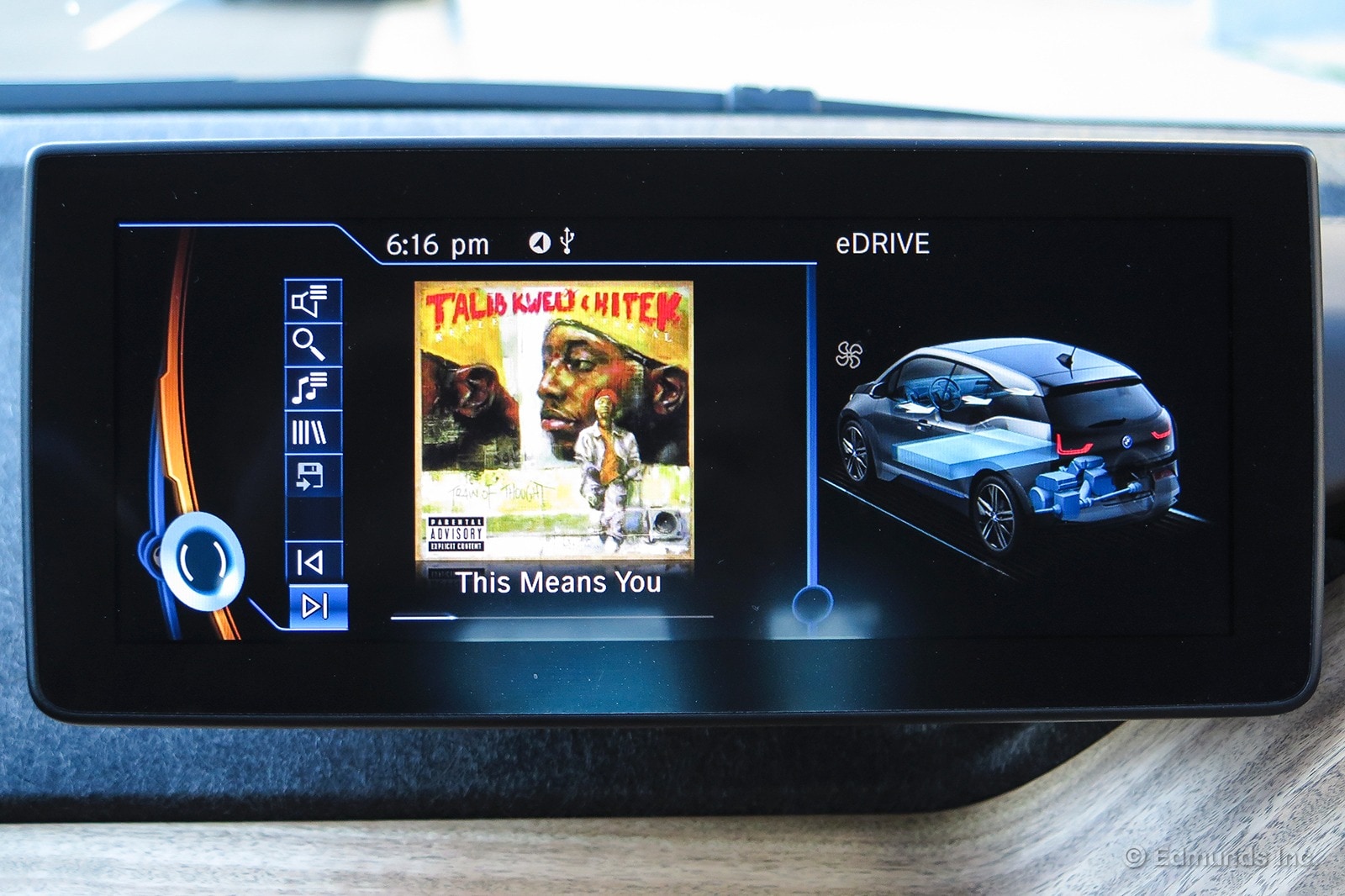
Third is my home parking garage at night, where the light is relatively low but the BMW's camera still has perfect vision.
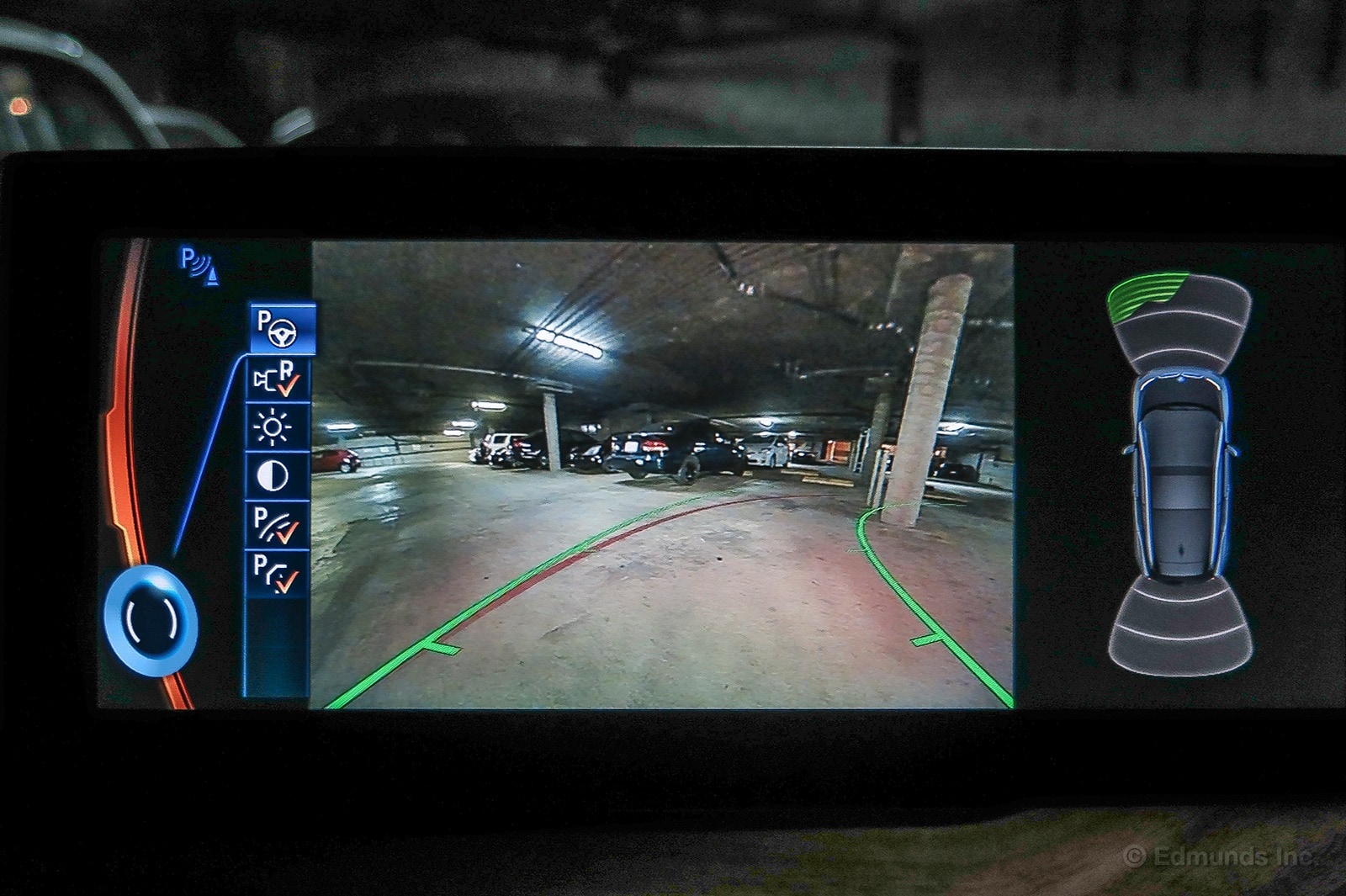
Lastly, is a picture of the parking sensors (without the rearview camera) which are easy to see/understand and extraordinarily accurate. I'm able to get within inches of parking poles, rather than feet, before the sensors start screaming at me.
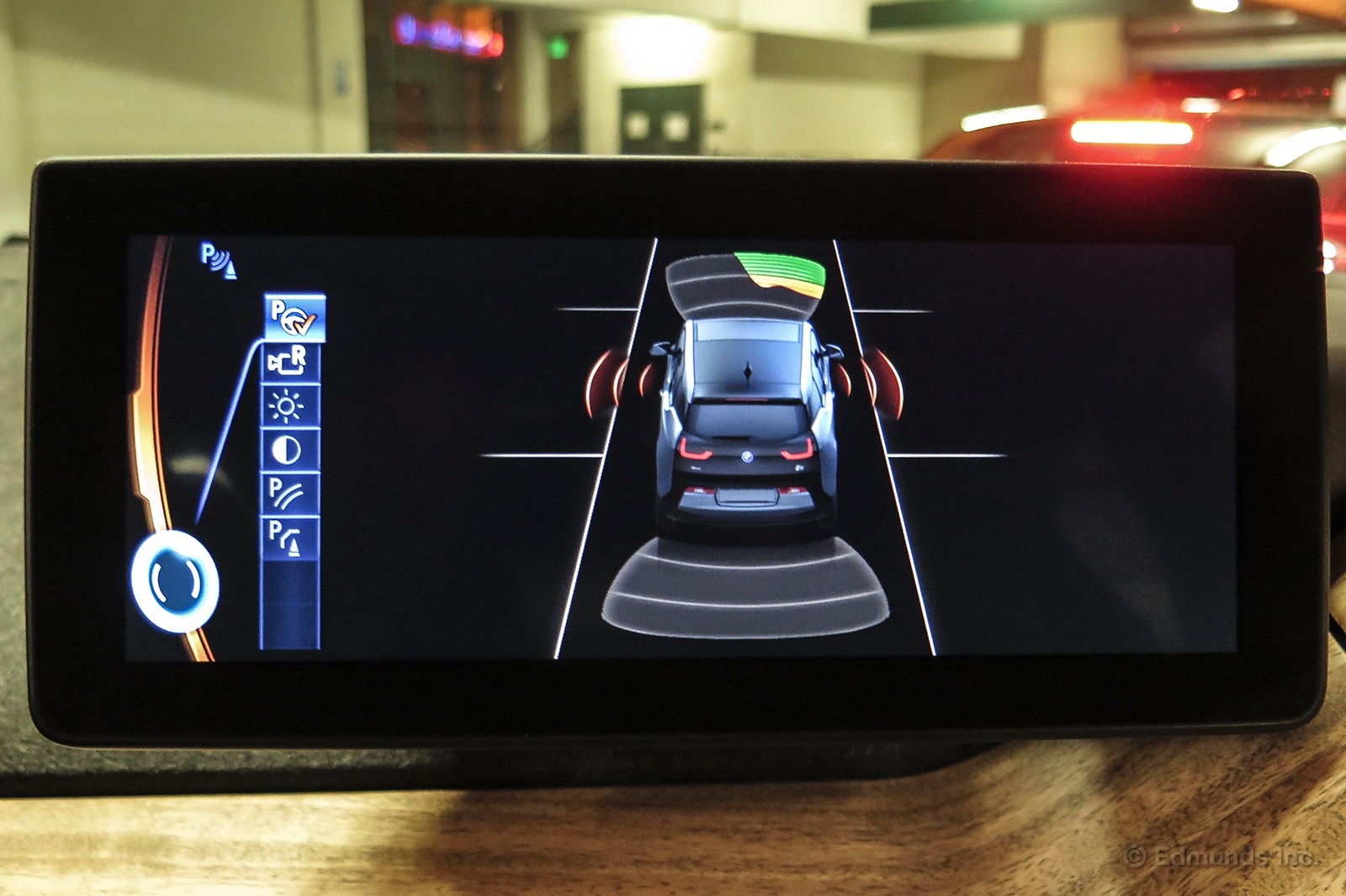
I got in and out of the BMW i3 at least 20 times while driving it around town this last weekend, and every time I started it up I was impressed by the screen quality. I wish my television at home looked this good.
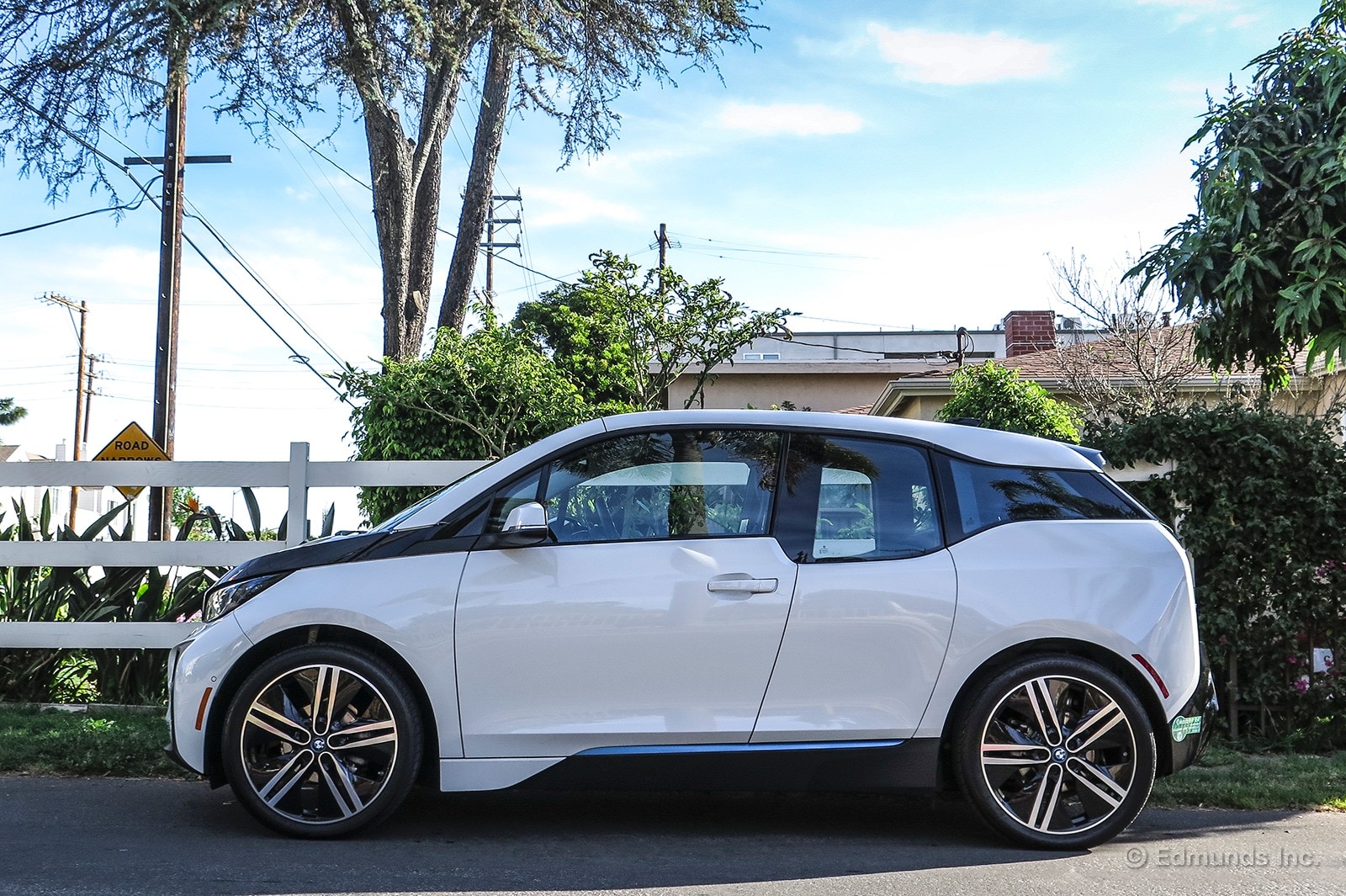
I recently had a weekend in our long-term 2014 BMW i3 and most of that time was spent commuting on city streets. Unlike editor John O'Dell who got to have some Fun in the Twisties, I was doing short urban commutes. And on the kind of broken, practically cobbled city streets that line most of Los Angeles, the i3 had a pretty bumpy ride.
Along the highway, the i3 was quiet and composed. At 70 miles per hour I kept the stereo off and it was easy to talk to my passengers. No need to shout. It soaked up the minor road imperfections relatively well and kept us comfortable on a short freeway journey. No complaints from anyone.
On our trip back home we took city streets instead. And in the city, over speed bumps, potholes, construction grates and intersection-gutters, the i3 bounced quite a bit. The entire cabin seemed to move as one piece, communicating road surface changes with dramatic hops. Some of this comes down to the road quality and the i3's suspension calibration (it's stiff but not unyielding), but there are other factors too. We've got the optional 20-inch wheels on our i3 and when you combine those large-diameter wheels with a relatively short wheelbase, you end up with a lot of impacts being transmitted right into the cabin. I'd opt for the standard 19s as a baseline solution but I'm not sure that would solve the problem entirely.
Over the weekend, I found myself slowing down quite a bit for road imperfections and speed bumps, basically duplicating the kind of behavior usually reserved for lowered, high-performance sports cars. Approach slowly, slow-speed over the bump, accelerate away lightly to save energy and hope there isn't another bump ahead.
None of this is to suggest that the ride quality in the BMW i3 is so bad that you can't live with it along broken city streets, it just isn't ideal. I'd prefer something like the VW e-Golf on a daily basis.
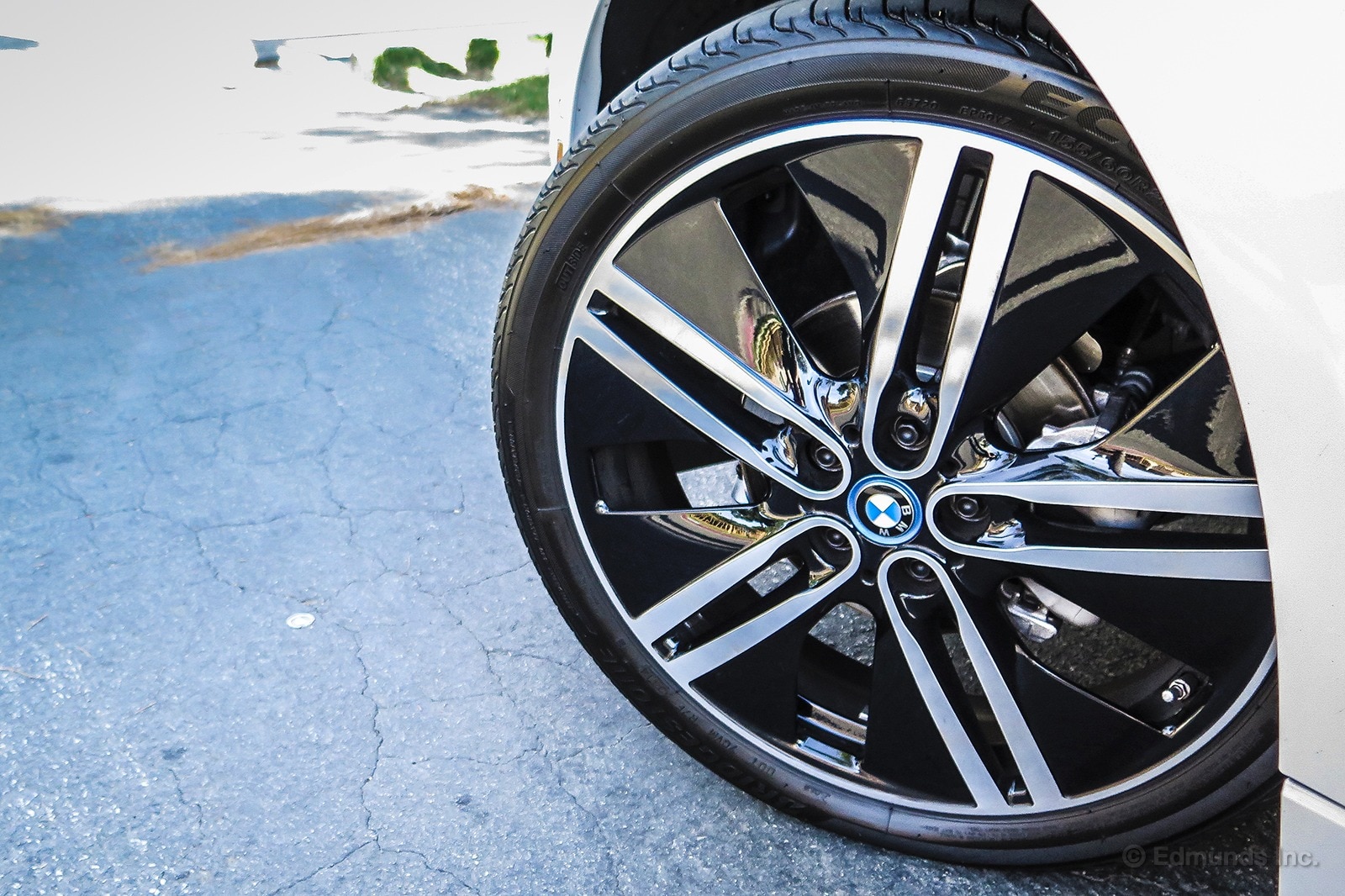
The feeling of regenerative braking is one of the most overt indicators that you're driving a hybrid or electric vehicle. When you lift your foot off the accelerator pedal while driving, the car will immediately slow down, converting the forward momentum of the car back into energy for the batteries.
Our long-term 2014 BMW i3 uses a regenerative braking system that slows the car down pretty dramatically, but after just a few miles, it's easy to get used to how strong it is and modulate your pressure accordingly. If you plan far enough in advance, you can avoid using the conventional brake pedal at all.
Some hybrids and EV's (our departed long-term Tesla Model S comes to mind) will perform a similar trick when coming to a complete stop in traffic, but they won't stop completely. Without application of the conventional brake, they'll creep forward slowly.
The i3, on the other hand, will come to a complete stop without using the brake pedal at all. It also doesn't have any creep or forward movement without an input on the right pedal. Of course, you'll want to press the conventional brake if you're stopped at a light to avoid rolling forward if you're hit from behind, but there are plenty of stop-and-go scenarios in city traffic where conventional brakes aren't necessary at all.
Our long-term Model S would allow you to adjust the sensitivity in the regen-brakes, which made the car feel a bit more like a gasoline-powered car, but I'm a bigger fan of the BMW's system. It's more severe and it can't be adjusted, so you just have to get used to it. It reminds me to plan ahead in traffic, making my driving habits a bit more efficient and it certainly saves wear on the conventional brake pads/rotors.

While the city ride quality in our long-term 2014 BMW i3 isn't ideal, it does have the ability to fit into nearly any parking spot you can find.
Bumper to bumper, it's the exact same length as a 2015 Mini Cooper (157.4 inches) and it's 10.7 inches shorter than a VW e-Golf. The Fiat 500e is considerably smaller (142.2 inches long), but if you want a back seat that can accommodate adults, I'd avoid the Fiat. At 69.9 inches, the i3 is only two inches wider than the Mini and five inches wider than the Fiat and an inch narrower than the VW. Basically, it's the right size for "compact" parking spots.
Also helping the BMW's cause are its skinny tires: 155 millimeters in the front, 175s in the rear. They contribute to the i3's tight turning circle: 32.3 feet compared to the VW e-Golf's 35.8 and the Mini Cooper's 35.4. The tiny 500e only bests the i3 by one foot with a turning circle of 31.3 ft.
What's more, the i3 is easy to see out of in every direction. There's excellent visibility from the high-mounted driver seat combined with a stunningly good rearview camera. As a result, you can park this little BMW just about anywhere you'd like.
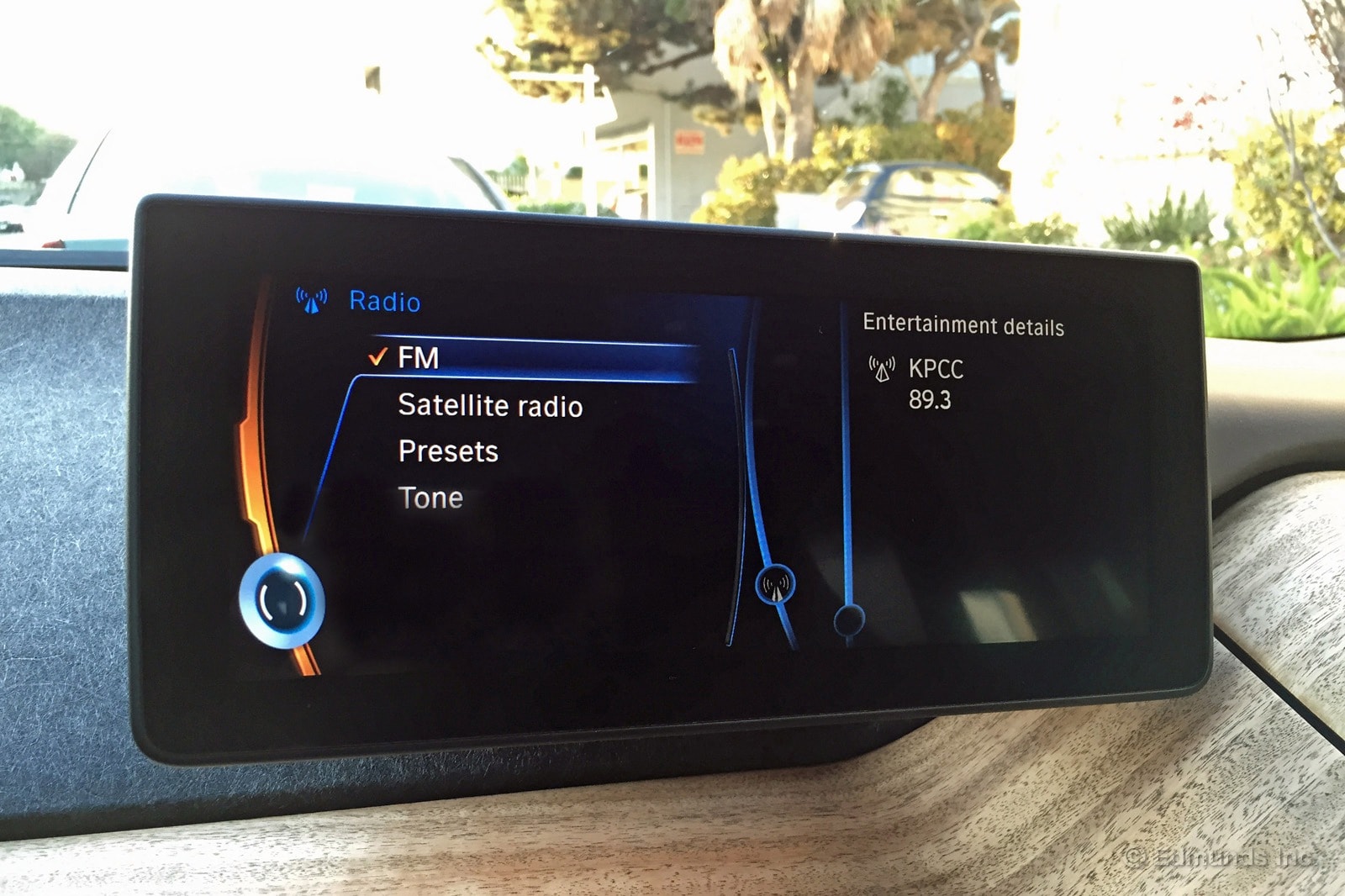
I usually listen to sports talk on the drive home, so imagine my surprise when I pressed the radio button on our 2014 BMW i3 and couldn't find the AM band. The photo above shows your choices. I tried scrolling the control knob in both directions, but the AM option never appeared. I took to the interwebs and found that this wasn't a glitch, but rather a design decision.
"Only the i3 and i8 will not include AM because the interference from the electric motor would make the quality of AM broadcasts far less than a premium listening experience, a BMW spokesperson said in an article on Radio World.
AM radio reception didn't seem to be an issue for the Tesla Model S, Nissan Leaf or just about any other electric vehicle I can think of. I don't really listen to AM for the sound quality, so I'm willing to cut the car some slack if I get occasional static.
In the article, the BMW spokesman goes on to say that HD Radio, satellite radio and BMW Connected Drive will "satisfy much of the AM desires of our customers." One option might be to stream AM with the TuneIn Radio app via Bluetooth, but the app doesn't support every station and, more importantly, will quickly consume your phone's data allotment.
I like the i3 and while not having AM radio would be an inconvenience, it wouldn't be a deal breaker for me. Would it be for you?
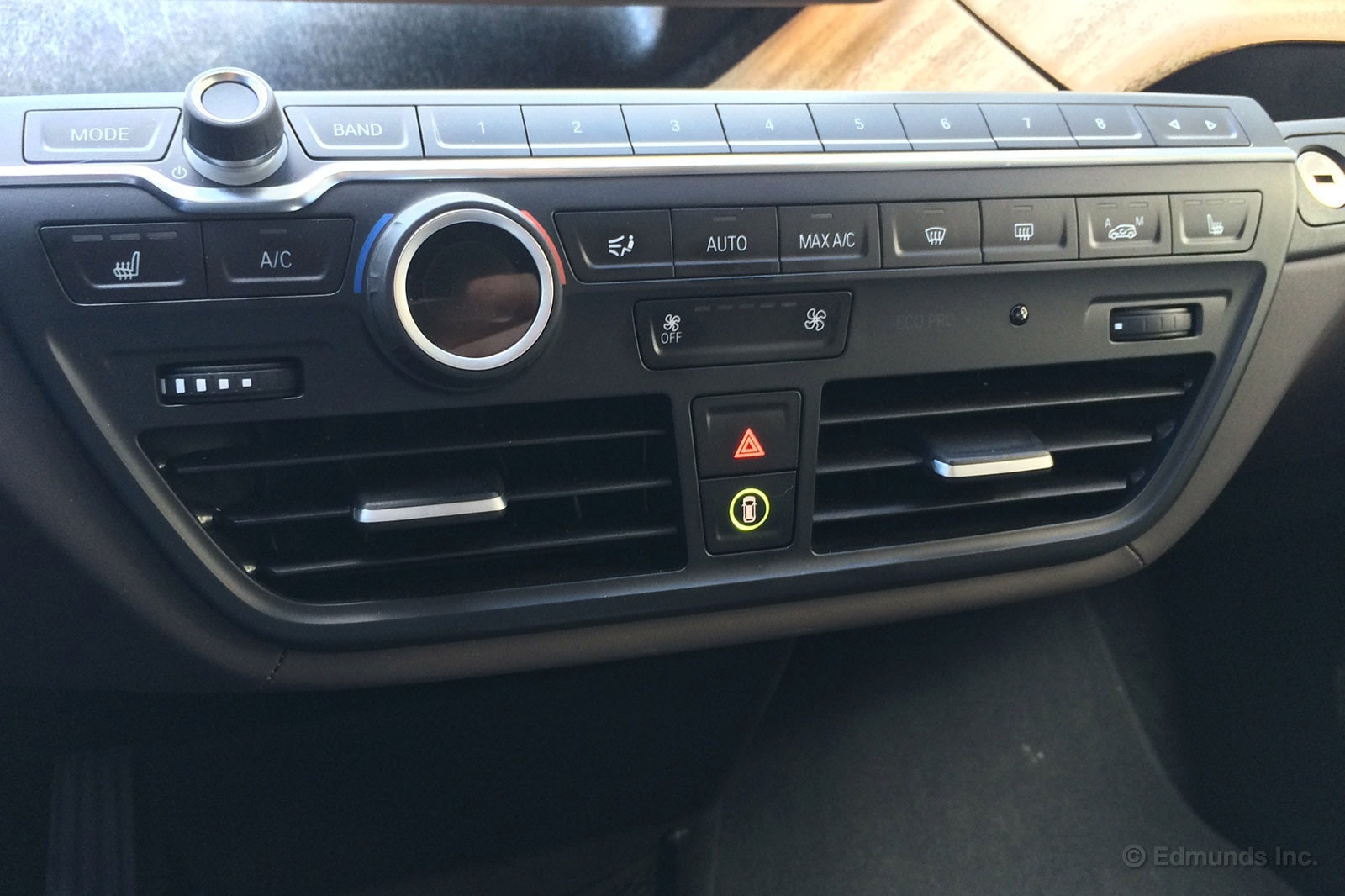
I like a lot of things about our 2014 BMW i3, but the car's short-term memory is not one of them.
The photo you see above is the way the car was set up when I got out of the car. Note the HVAC is off. Note that there's no visual indication, but the car is in EcoPro mode. This is just the way I like to drive the i3. Windows down for some breeze and car in EcoPro because, on my stop-and-go-commute, the duller throttle response is just a little easier.
The picture below is how things look when I get back into the car after turning it off. HVAC on, car in normal driving mode. It's not like I left the car at the airport for a week or even overnight. This was simply running into Starbucks for a coffee.
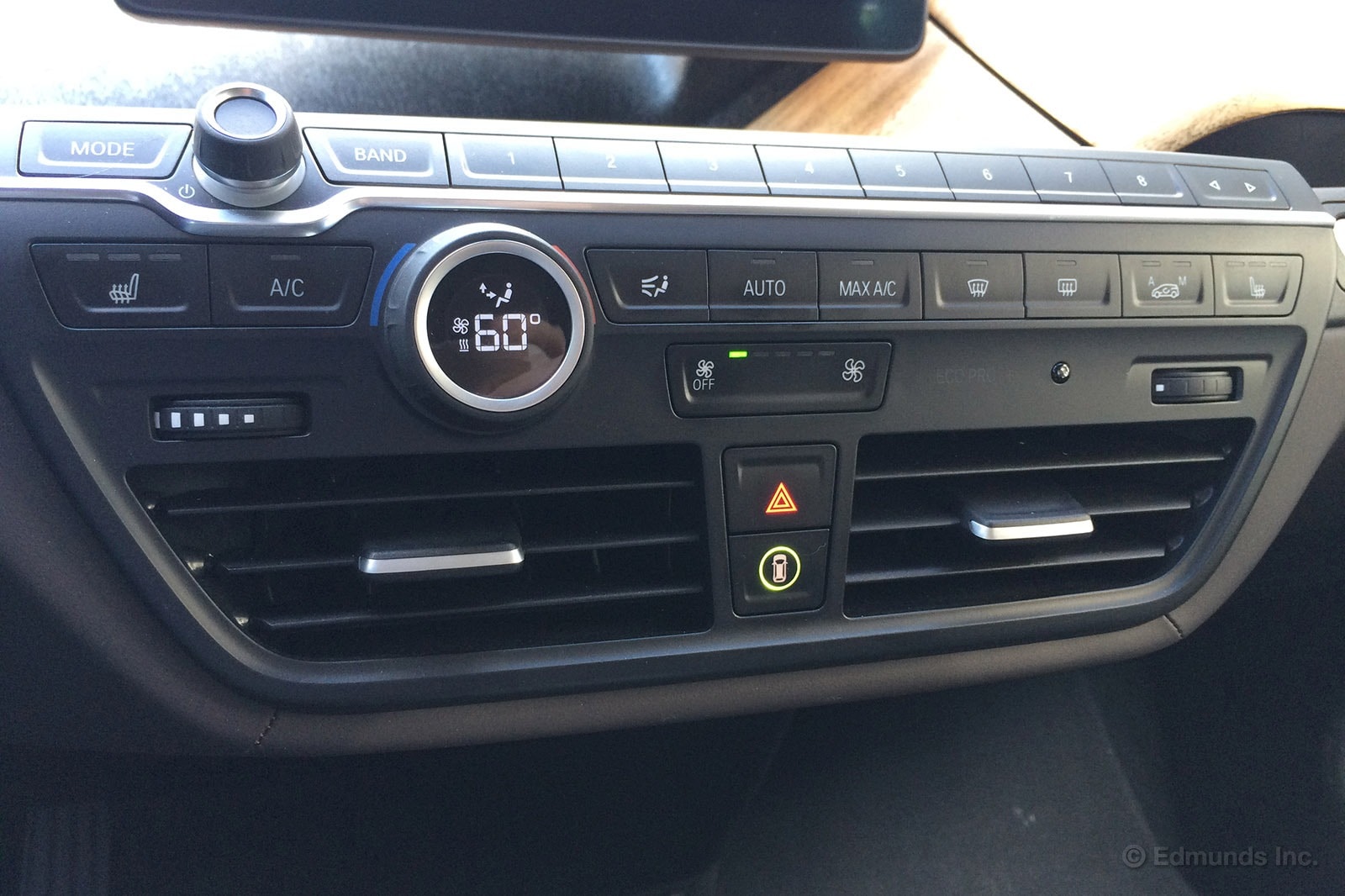
I'm used to turning traction control back off and flicking a car back into sport mode when I return to it, stuff that a manufacturer would want or be forced to default to normal, just in case. But these two things? A mild eco mode and HVAC off? I can't find any purpose for this other than to mildly annoy.
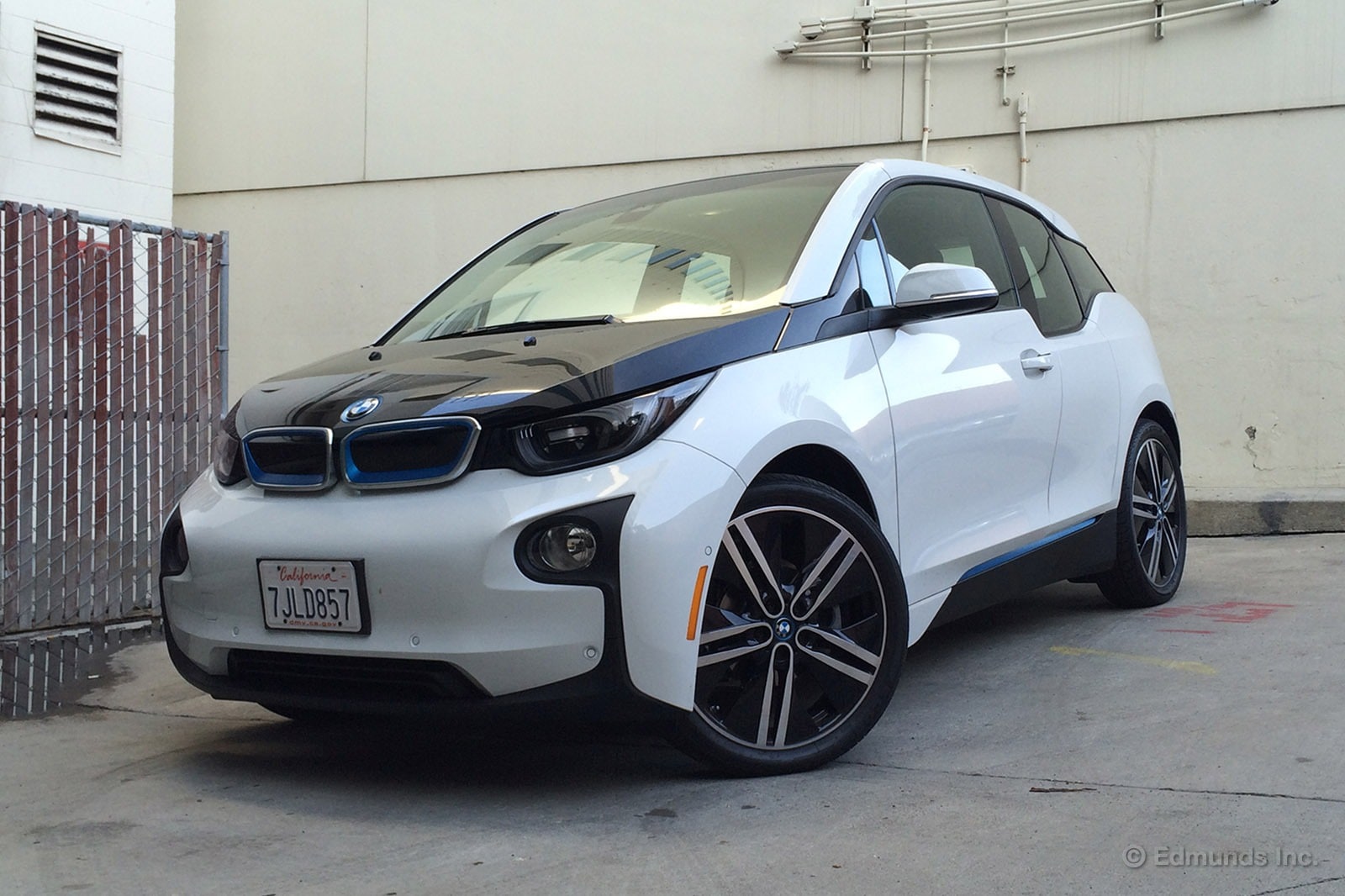
Our 2014 BMW i3, has some crazy tires: 155/60 up front, 175/55 at the rear. That's a throwback to OG Beetle-skinny, but now wrapped around 20-inch wheels. Think of them like a modern wagon wheel or a big, fat BMX tire.
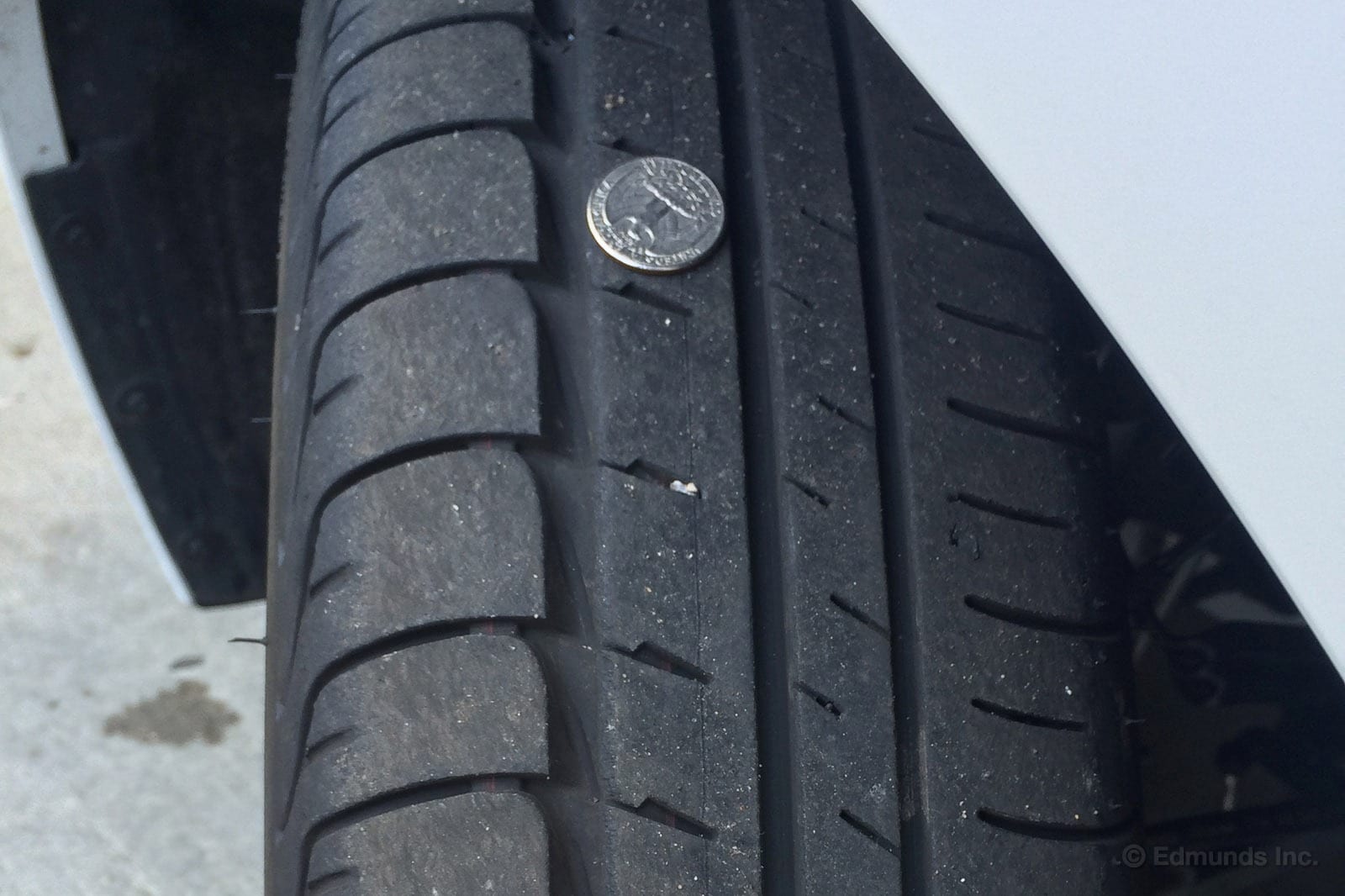
You'd think with only about 6 inches of front rubber rubbing the road, the i3 would be a skittish thing, and you'd be partially right! It's easy to overdrive the front tires just by flicking the wheel a hair too quickly. The stability system is keenly aware of this behavior and responds with heavy braking, both regenerative and physical.
So learning the limits of these glorified stroller tires is crucial to having fun in the i3, but surprisingly that's really their only downside. They don't catch grooves or hunt around. They don't crash over potholes. They don't make a lot of noise. They're just kind of there, cutting a narrow path and keeping the car off the ground.
Bonus: they're only about $150 each. In a time when virtually every car is over-tired with annoyingly grippy, stupid-wide, way-too-expensive tires that perform great on a skidpad (our i3 pulled a whopping 0.73g) but aren't any fun, these things are a revelation.
Now if only BMW would let me shut all the nannies off and have some fun...

It's already summer in Southern California's San Gabriel Valley and I needed genuine cabin cooling when I drove our 2014 BMW i3 this week.
Ordinarily, I'm not very particular about air-conditioning systems in cars. I rarely set the automatic ones any cooler than 72 degrees Fahrenheit, and I usually have the manual systems on the lowest fan setting. I rarely use any Max A/C mode. I'm a naturalized Californian and I don't like to be cold.
But the system in our BMW i3 is a little feeble, even by my standards. It's different from the automatic climate control systems in other BMWs in that it's a single-zone system and the temperature adjusts in increments of two rather than one. I'm OK with those differences, but the lack of oomph from the fan is a problem.
With outside temperatures just south of 90 degrees, I never had the i3's climate control set any warmer than 68, and often had it on 66 degrees. That's almost unheard of in my little sphere of existence. I suspect many of my warmer-blooded colleagues will have the electric BMW's climate control pegged at 60 all summer long.
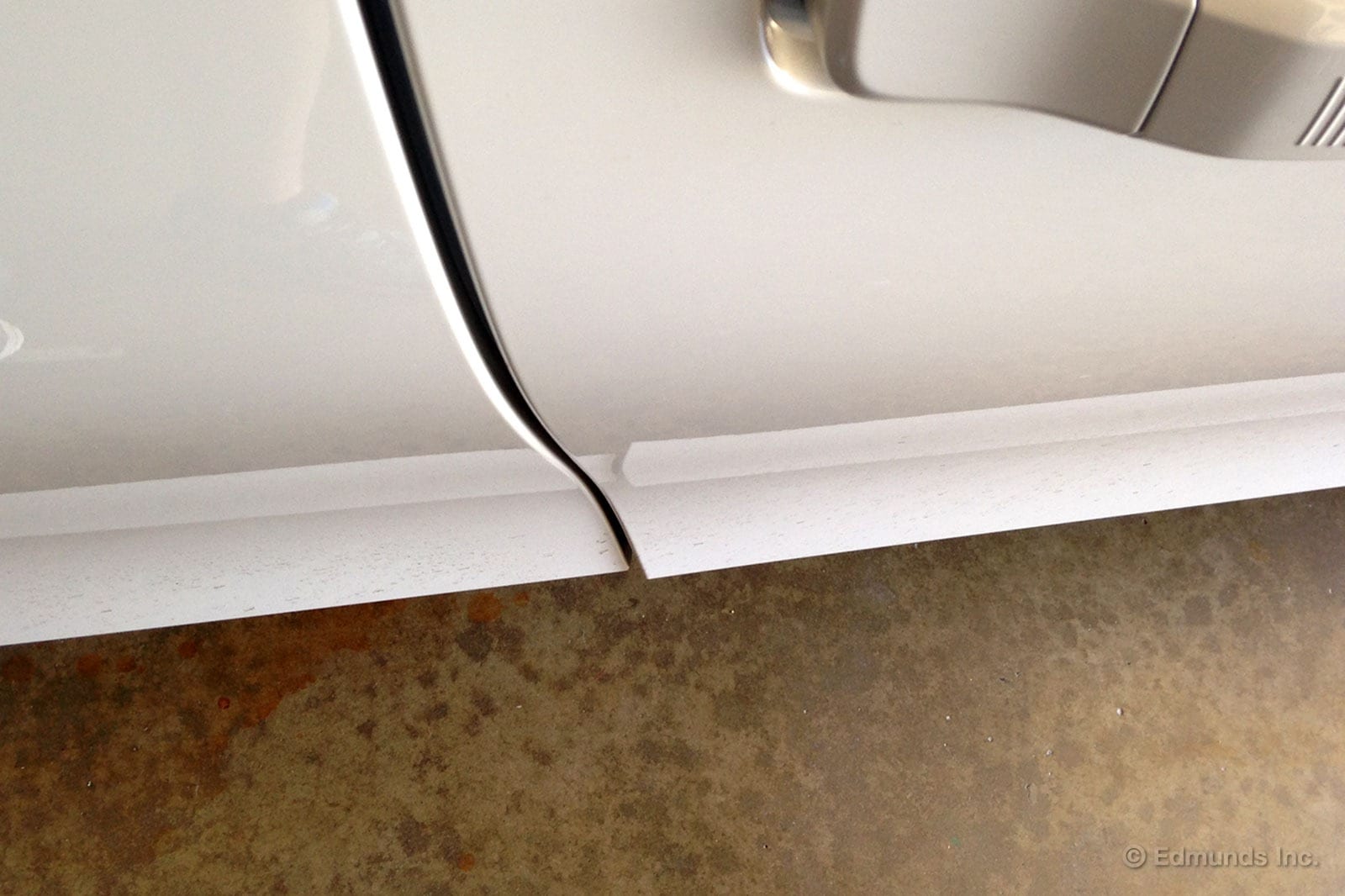
I walked out to our 2014 BMW i3 yesterday and found this. The base of the passenger door was sticking out. At first I thought the door wasn't closed all of the way but there was more to it...
The door alignment was fine. It was the panel. A few strategic whacks with the palm of my hand were enough to pop it back into place. I don't know what caused this but for now we are okay. If the problem crops up again, we may have a bad fastener back there.
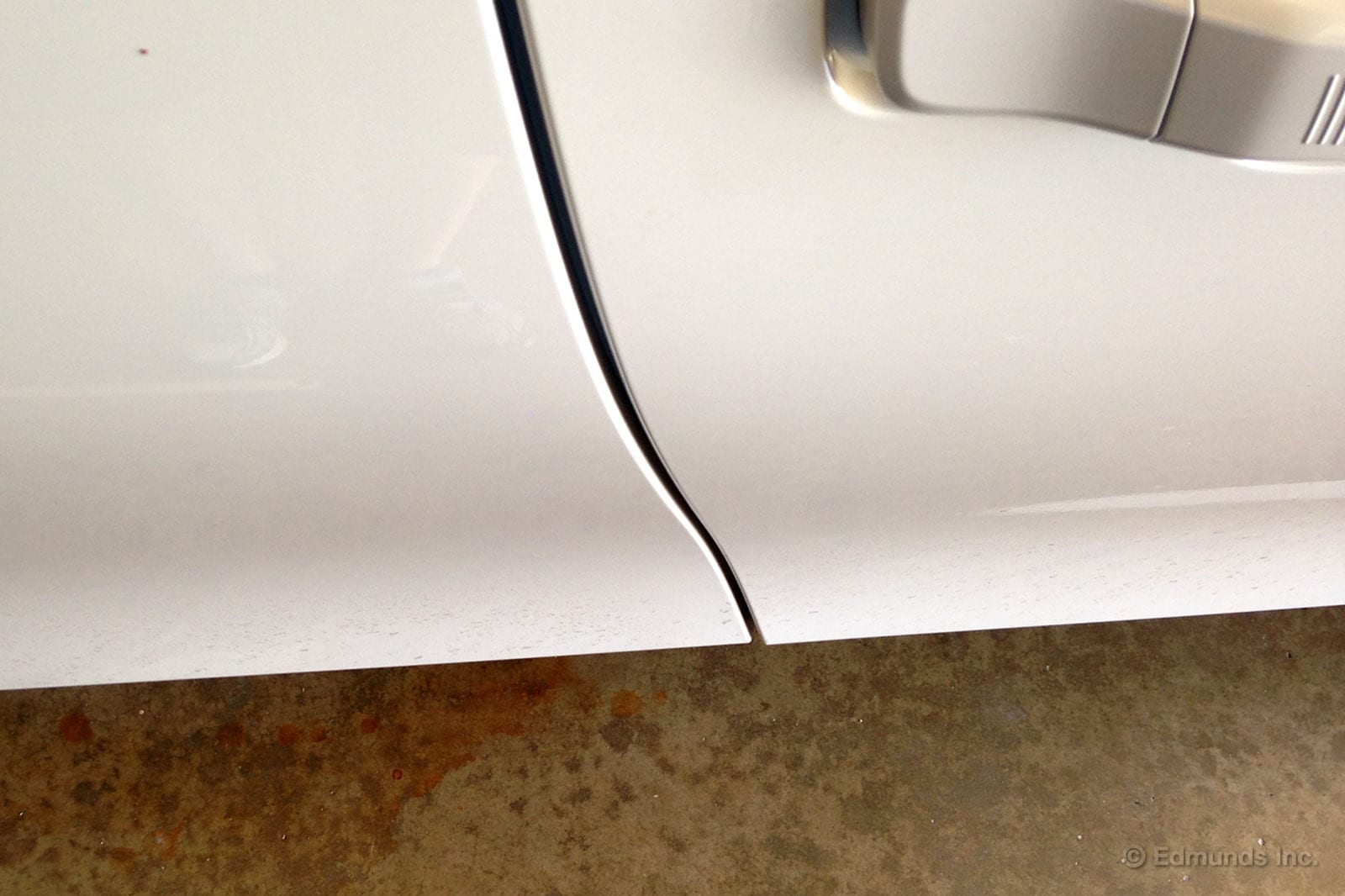
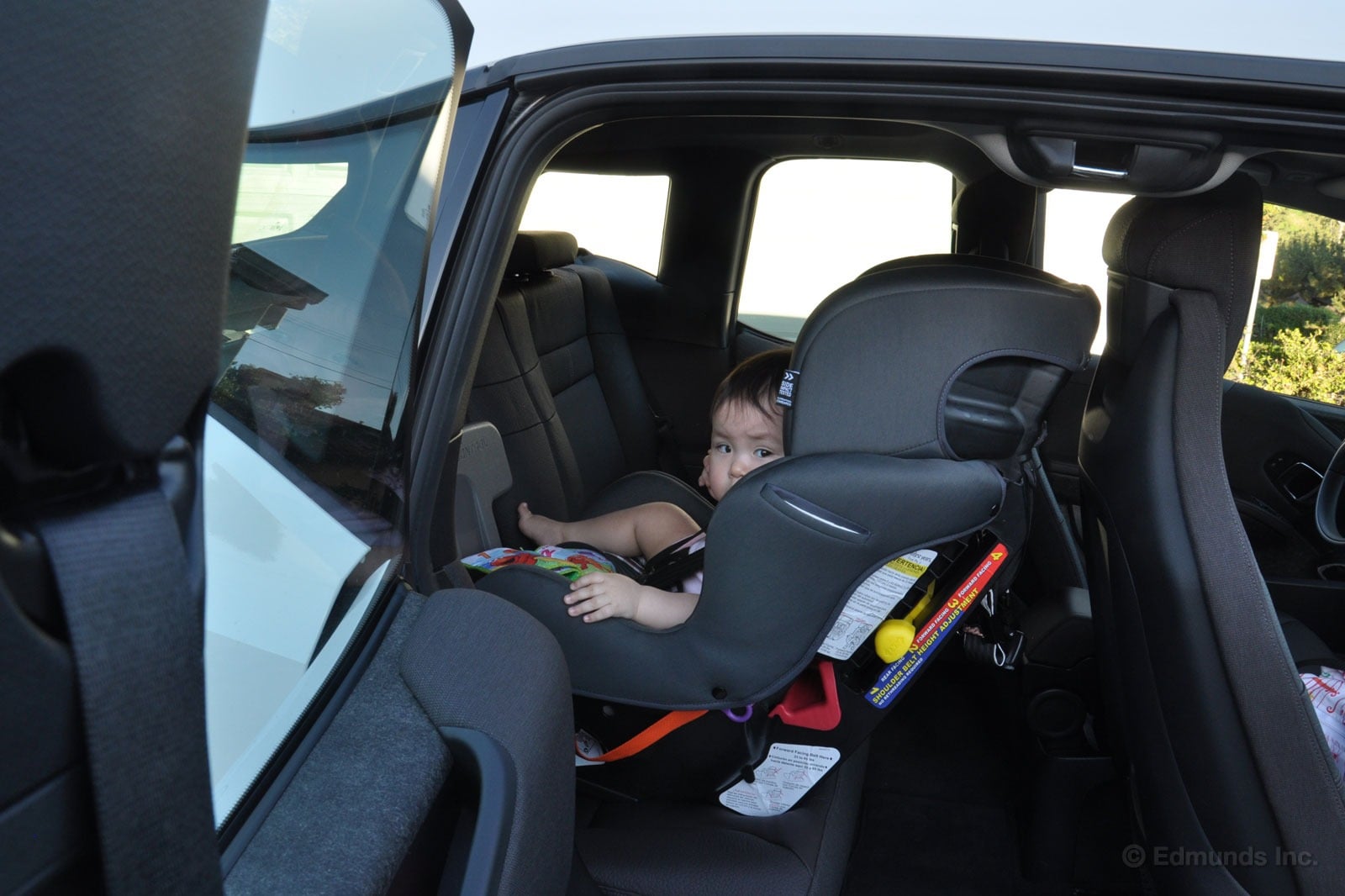
A couple of months ago, I installed my daughter's compact convertible car seat in our 2014 BMW i3. It fit wonderfully, preserved useful legroom for the front passenger in front of it and heightened my enthusiasm for commuting around southern California in the i3. That car seat is not especially cushy however, so when I had to run some errands this week, I installed my primary car seat, the oversized (and discontinued) First Years True Fit C680 SI.
It fit, but not without compromise.
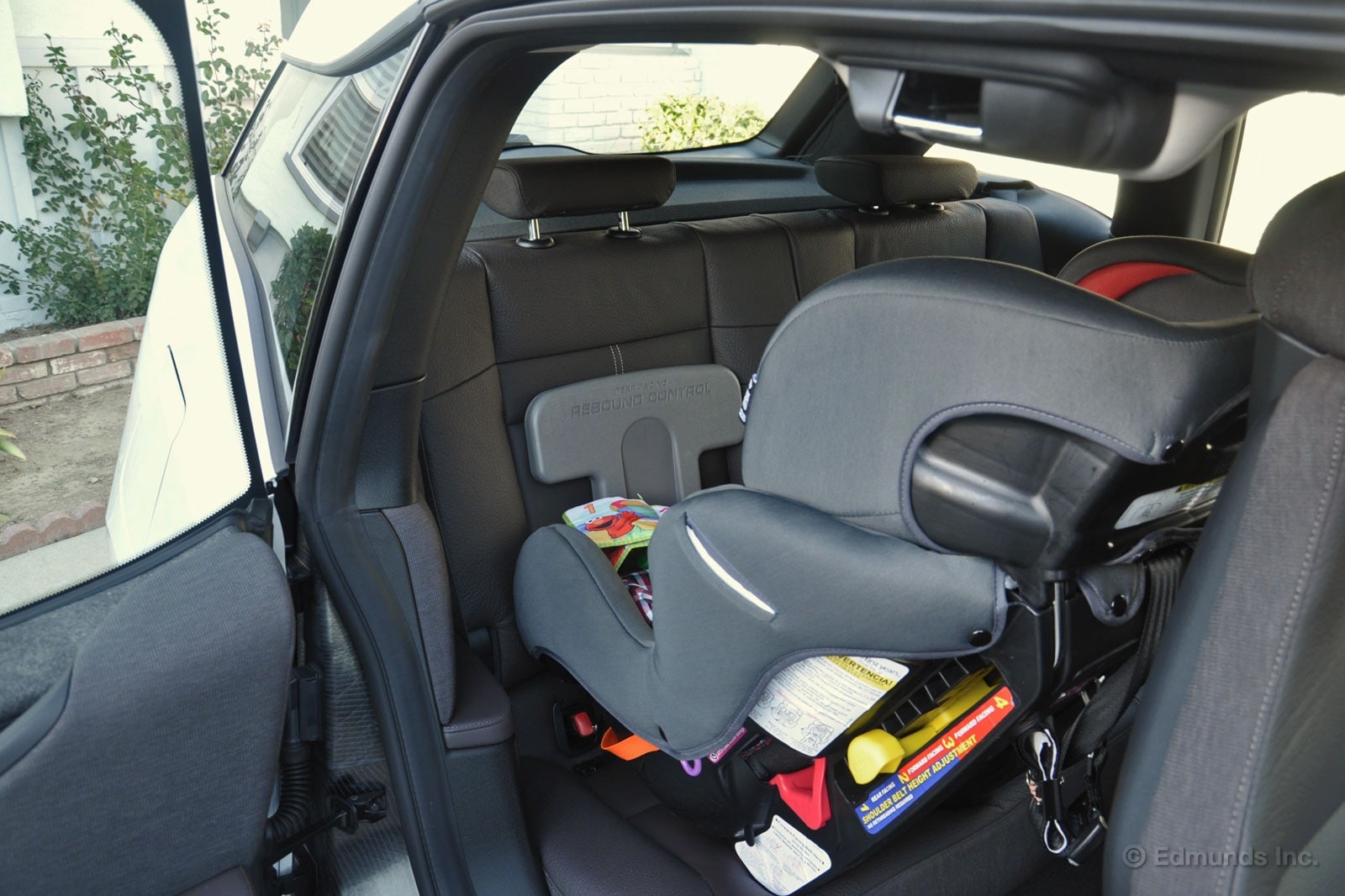
First off, I encountered a usability issue I hadn't anticipated: the i3's reverse-hinged rear doors. Coupled with the huge side bolsters on the car seats, they reduce the available space for loading the child. My kid is now 30 inches tall and almost 22 pounds, and there was no way to stuff her in from the passenger side without bonking her head or bumping her legs.
So I had to load her from the opposite side (the driver side) like I would in a two-door car, and like I did in our Mini Cooper. It works, but it's not that convenient or time-efficient.
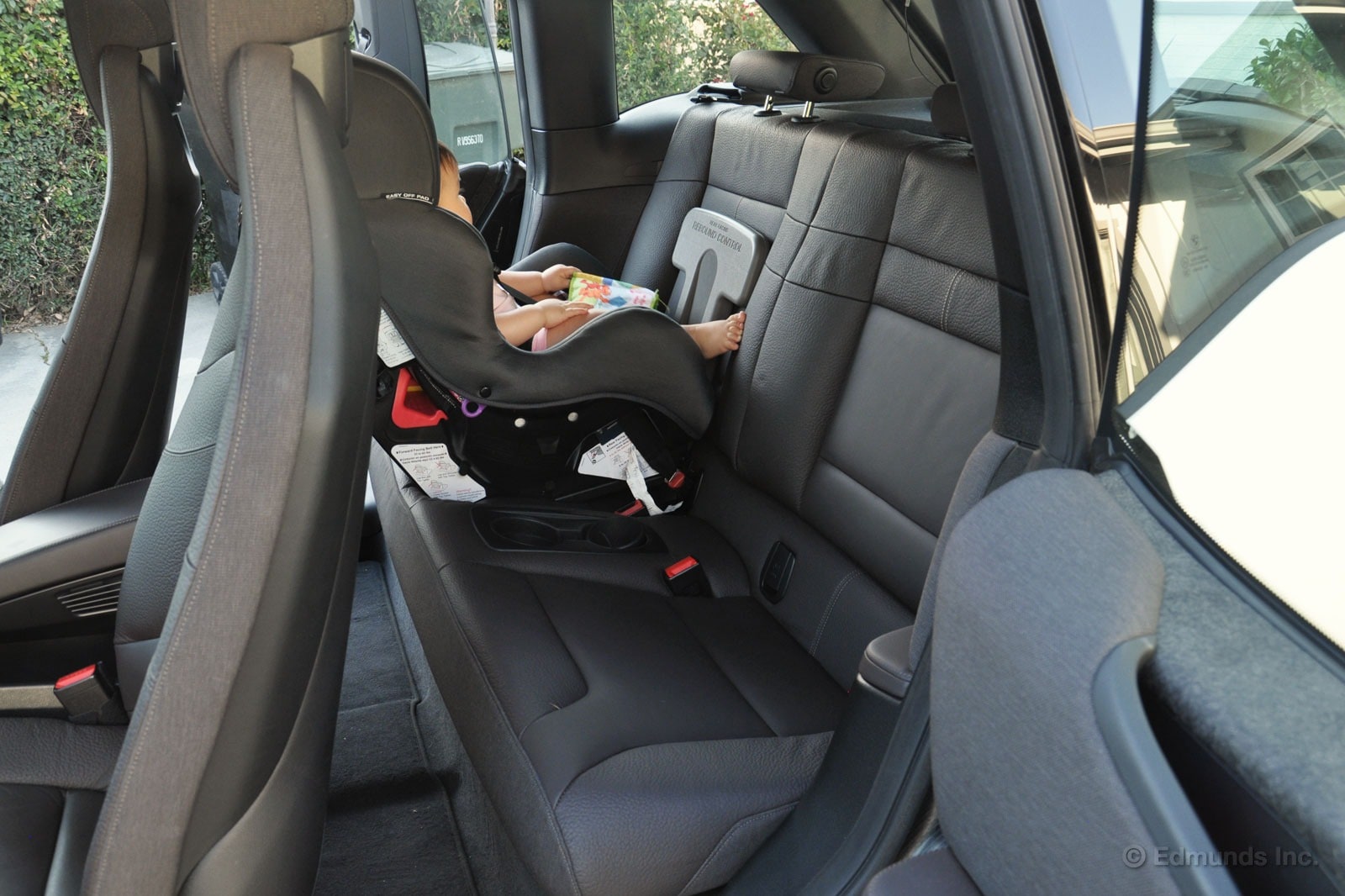
The higher seat-back on this car seat also forced me to move the i3's front-passenger seat all the way forward on its track. With my compact Safety 1st car seat, I didn't have to move the seat much at all. The upshot is that at 5'10" tall, I wouldn't be very comfortable riding in the front-passenger seat with the larger car seat behind me because (a) my knees are close to the dash and (b) I also have to sit quite upright.
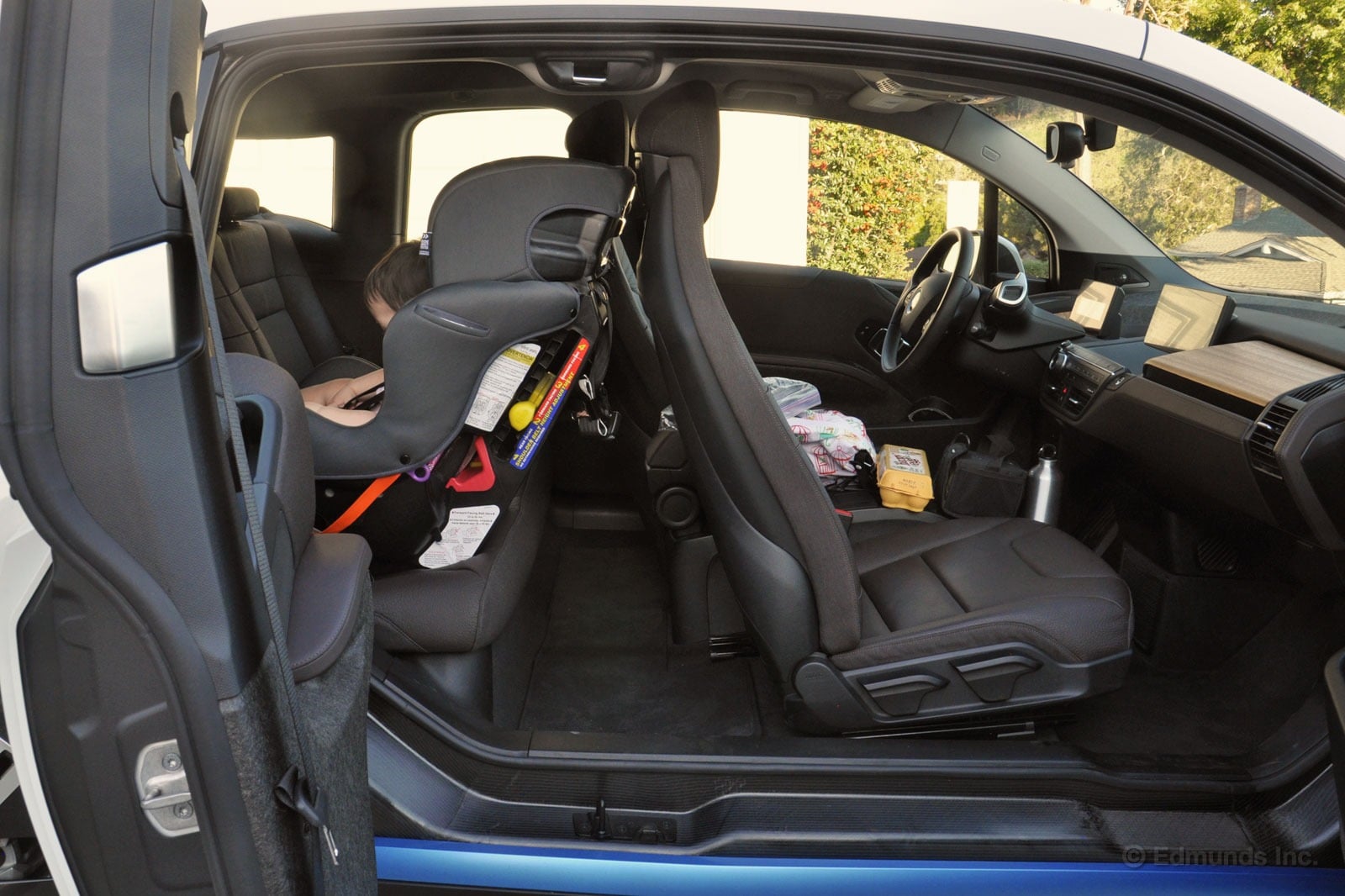
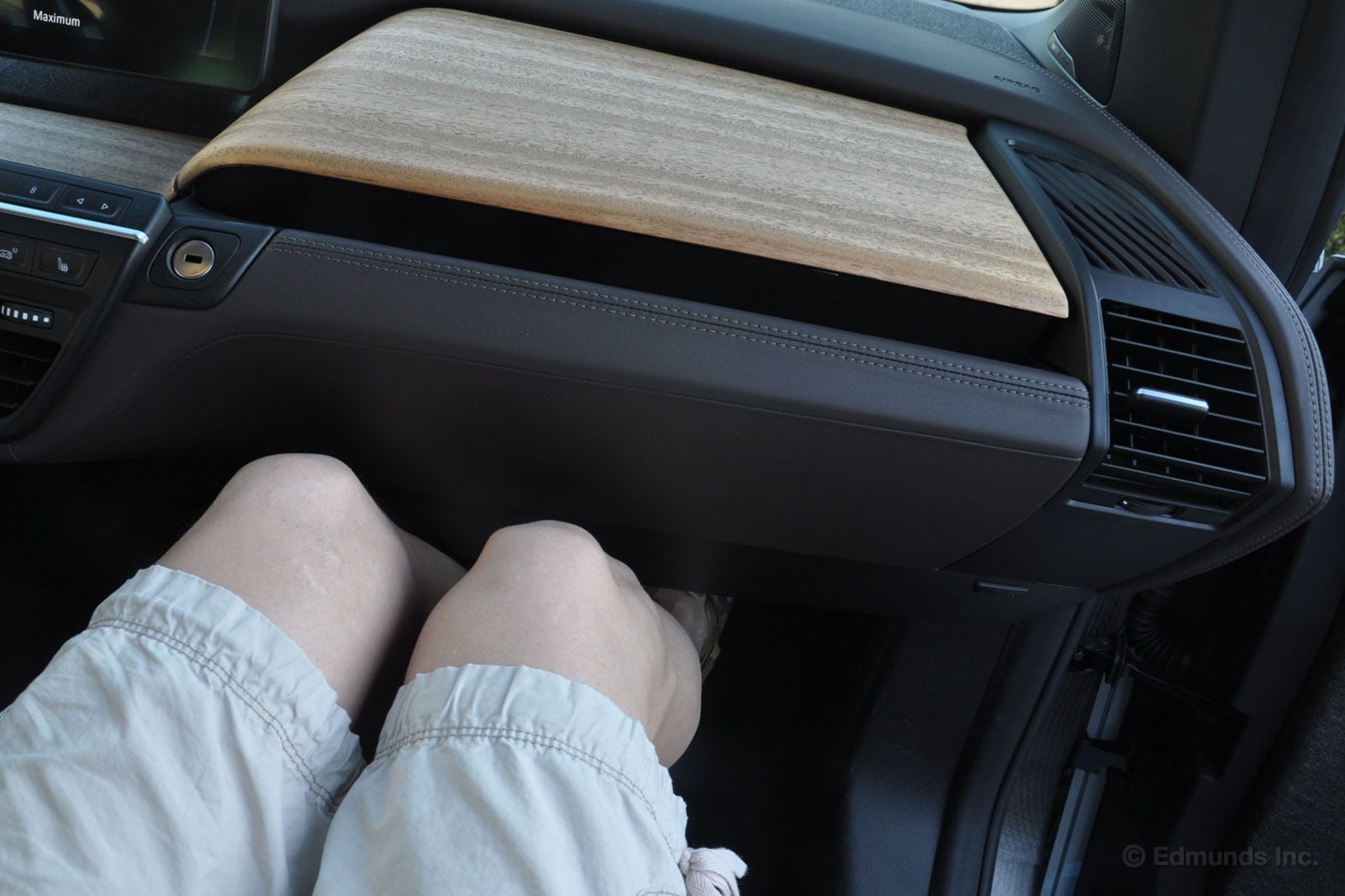
Another issue with this car seat in the i3 is all too familiar to me: The seat's side wings are so huge, they cover the rear passenger side window and create a huge blind spot. I have fish-eye mirrors stuck to my Mazda 5's outside mirrors and I'd have to do the same if I owned a BMW i3.

Another detail that I never covered in my earlier update is the lower LATCH anchors in the i3. They're very easy to locate and use without looking, which is great if you're trying to install a seat in the dark or in shadow.

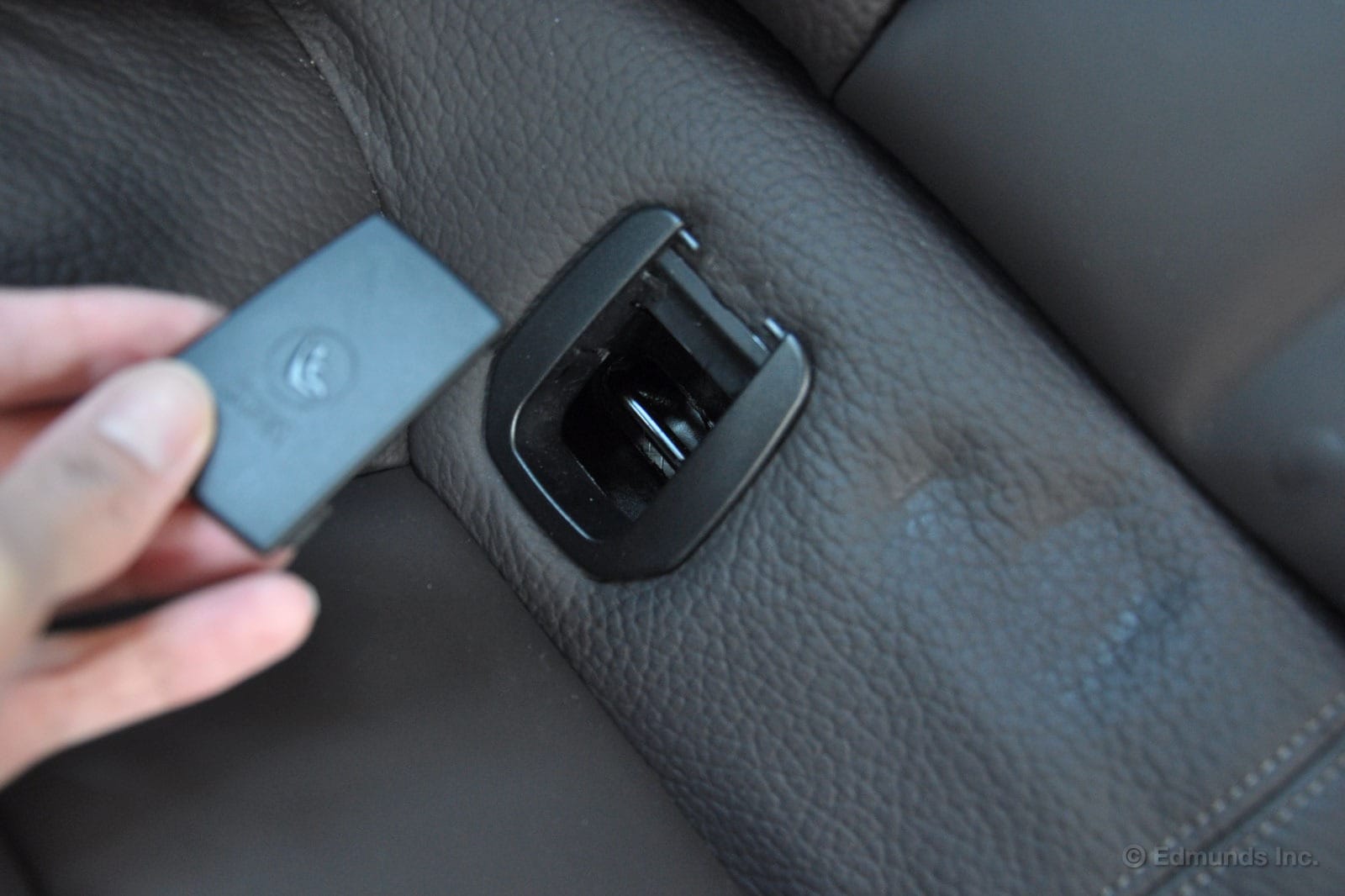
I think it's likely that the plastic covers over the anchors might get lost eventually, but that's a small price to pay for the accessibility you get here.
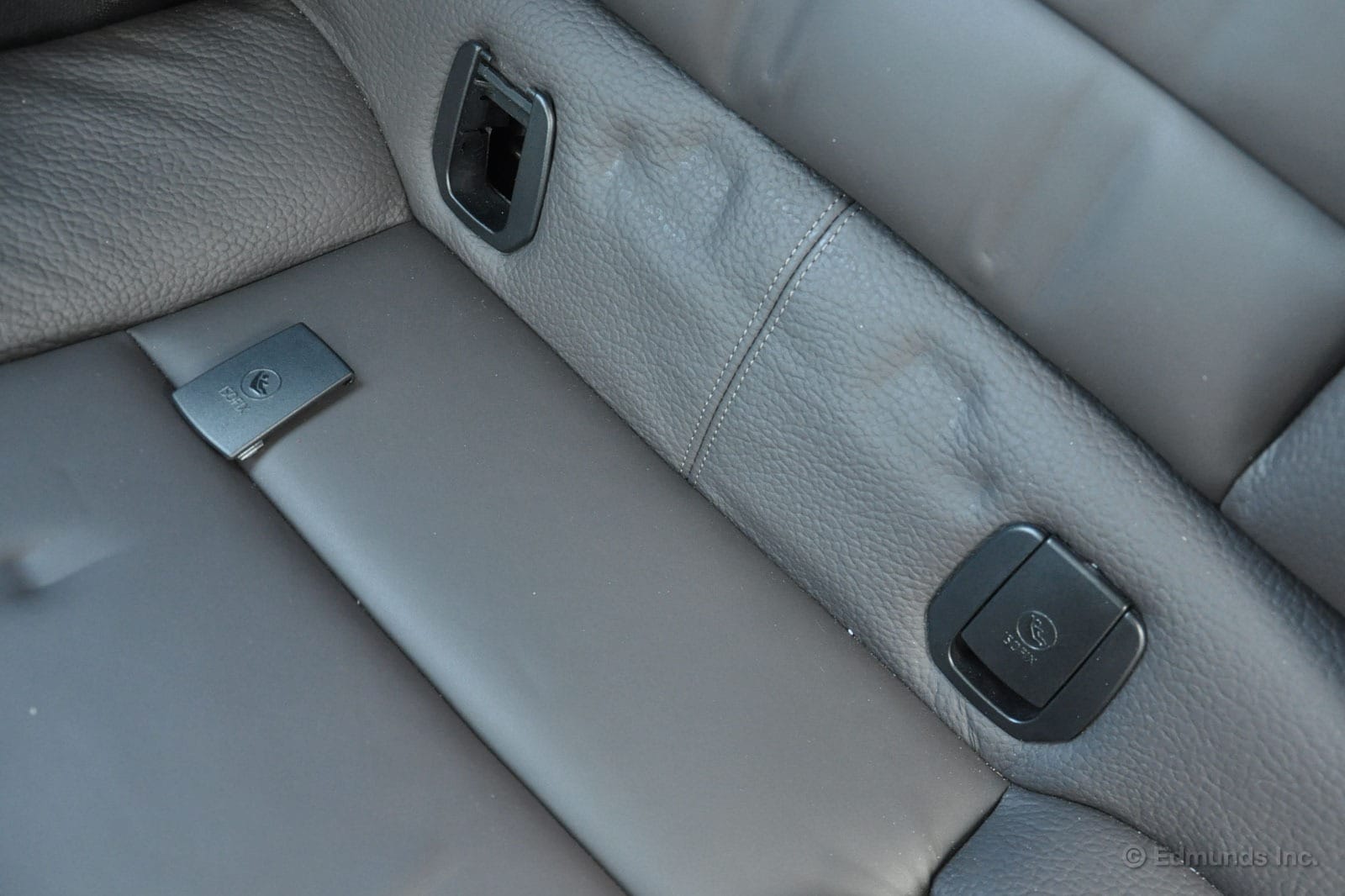
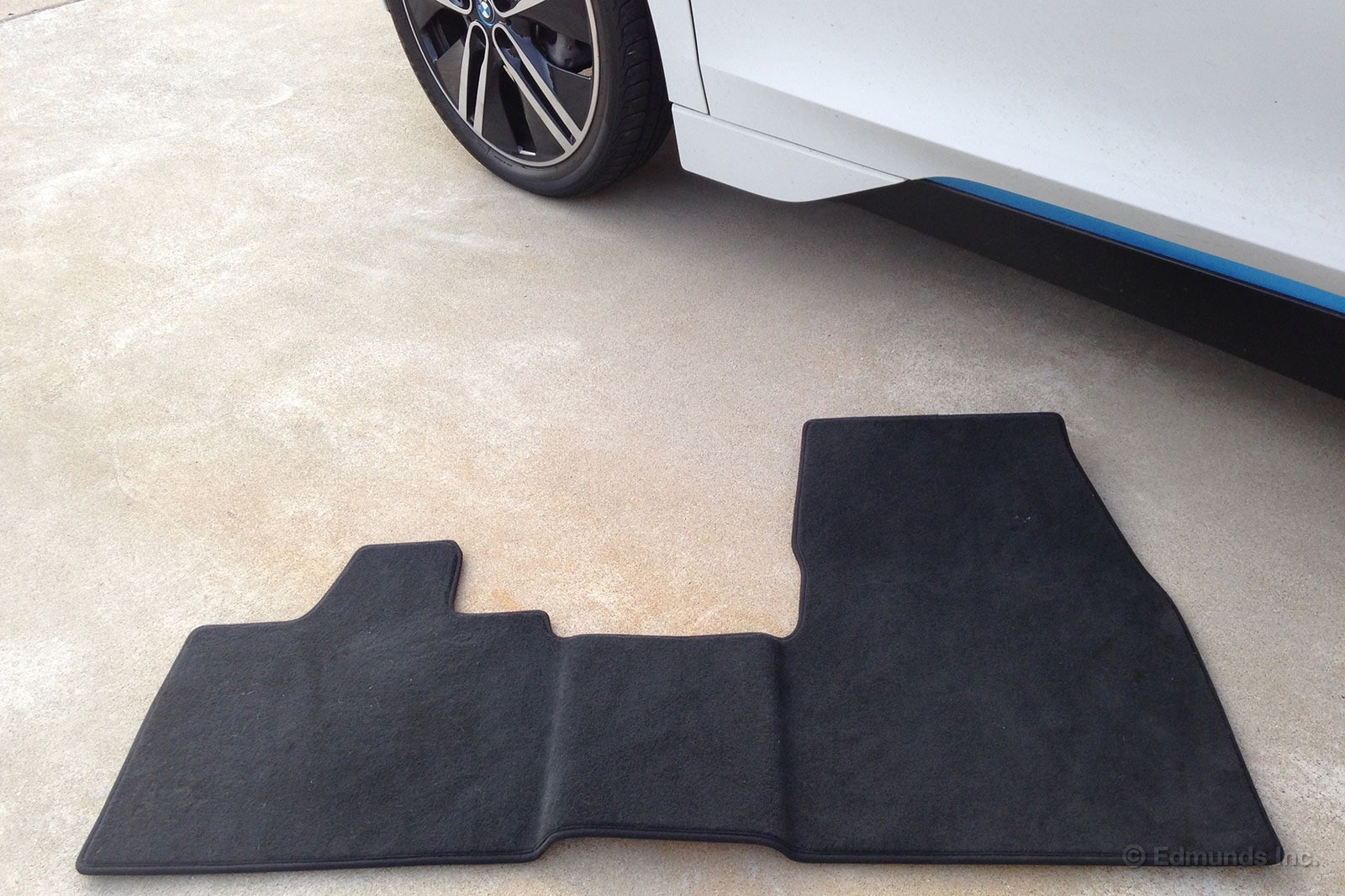
I was washing our 2014 BMW i3 last weekend. Easy stuff, right? Things were going fine until it came time to vacuum the floors up front.
In what will go down as one of the lower points in my life, the front floor mat got the better of me. For one, it is massive. There is a single mat for both front foot wells, which I did not anticipate. Had I opened my eyes, I may have been less surprised.
Two, rather than hooks or tabs, the mat adheres to carpet by Velcro only. A lot of Velcro. It is a great idea that made removal more problematic for my momentarily absent mind.
Three, the mat won't really come out with the optional front cup holder in place. To keep with the theme of making a simple task complicated, I successfully wrestled the cup holder free from its perch. But not without first banging my knuckles against the dash in the process. Fortunately, that snapped me out of it. Things went downhill from there.
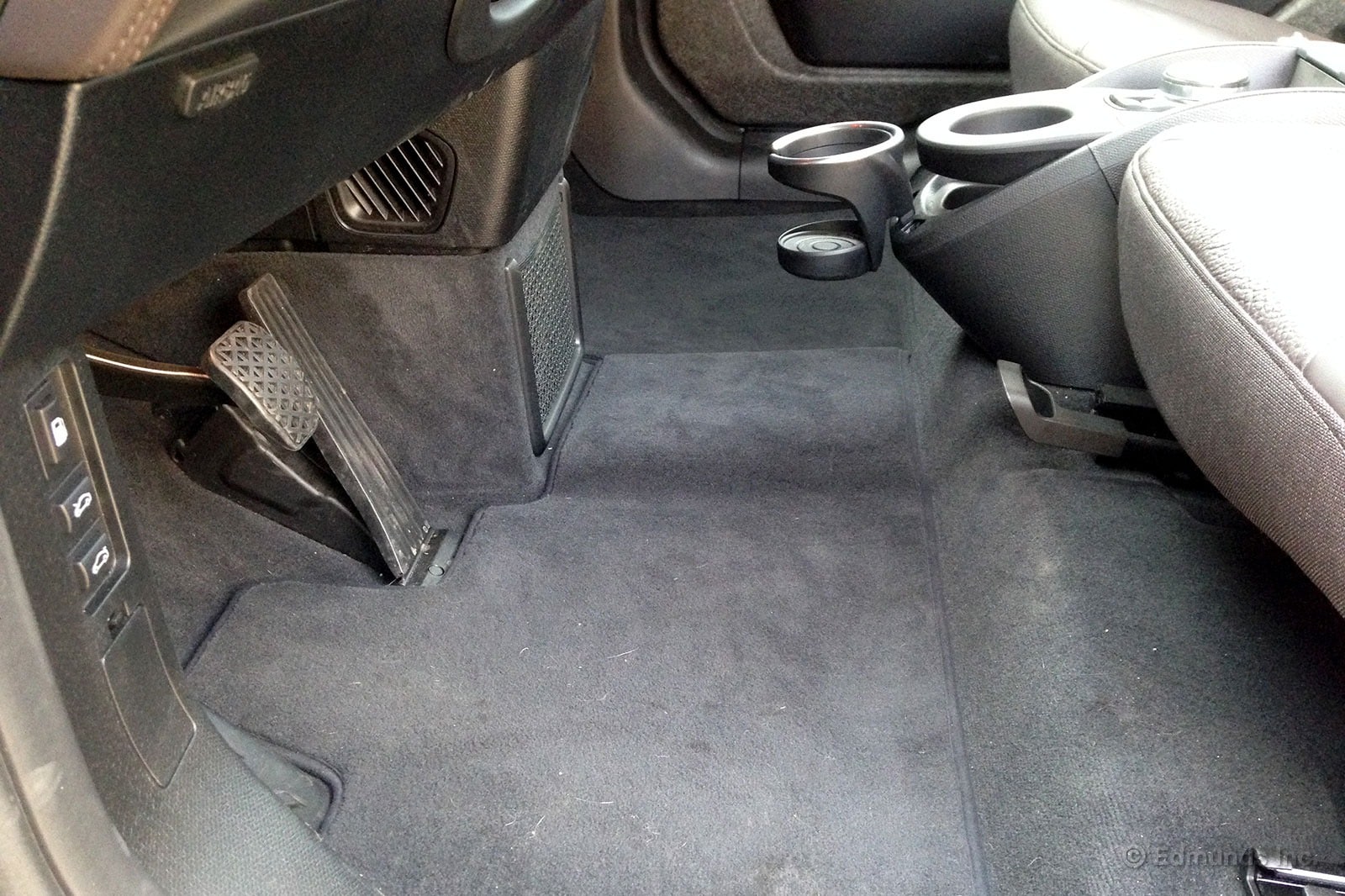
That was a rough day. I'm glad it is over.
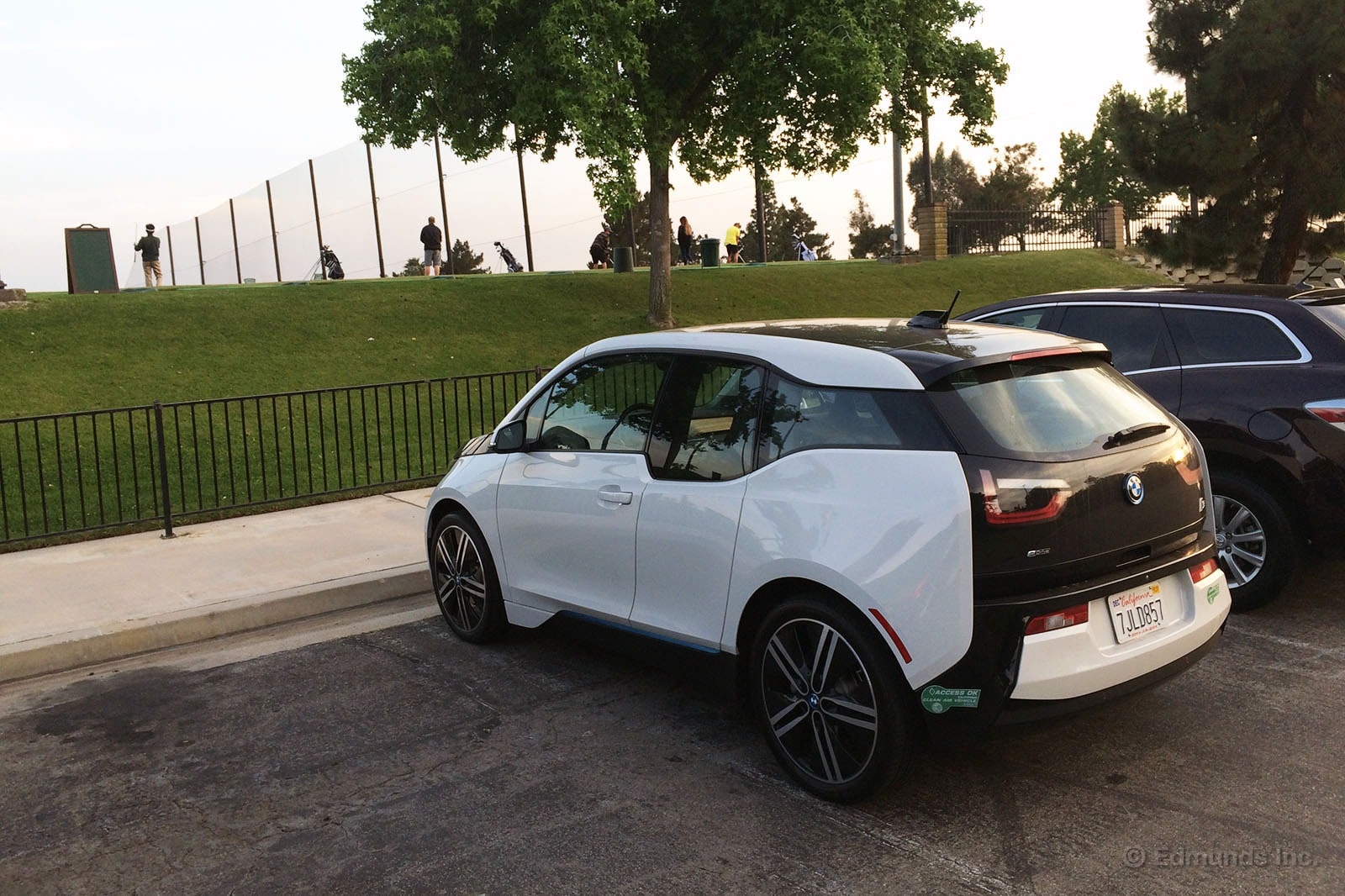
You are retired. Perhaps you live in a place where the sun frequently shines. Perhaps your home, as a result, has a roof-mounted solar power system. Perhaps, therefore, a plug-in car like the BMW i3 makes an immense amount of sense. Perhaps, let's also say you golf (did I mention you're retired and live in a sunny place?). Perhaps you're even my parents. Will your golf clubs fit in the 2014 BMW i3?
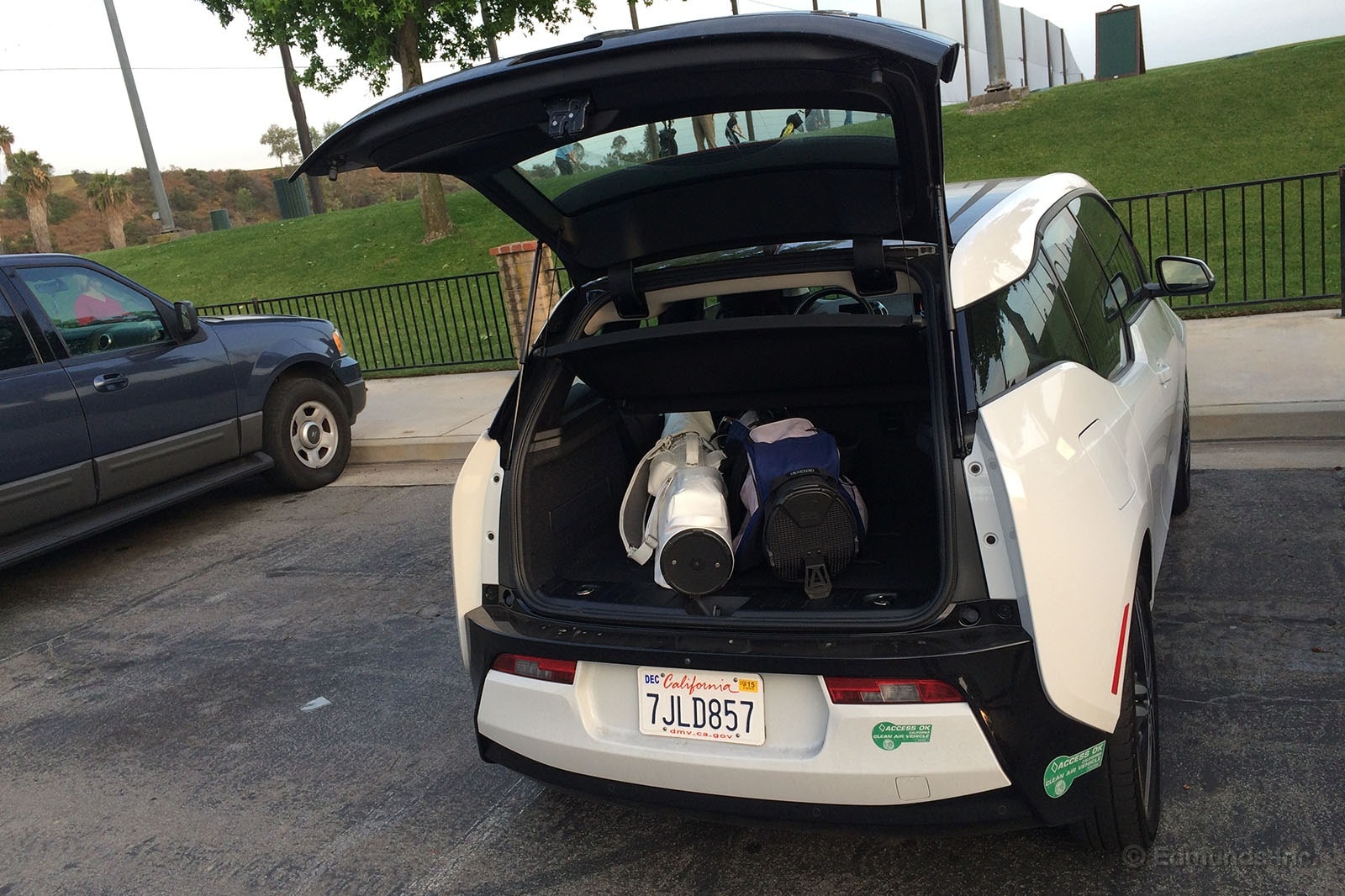
As the photo above clearly shows (spoiler alert), yes they do. It requires lowering one of the 50/50-split rear seats, but that's easy enough.
Now, would buying a regular car and a golf cart be a much cheaper proposition, especially since you can't exactly cruise down the 14th fairway in the i3? Well, sure, but I still contend that the i3 is a pretty perfect vehicle for retirees. It's just fine for golfers of any age as well, perhaps even for those who have to sit in 45 minutes of LA traffic for some Tuesday night twilight golf.
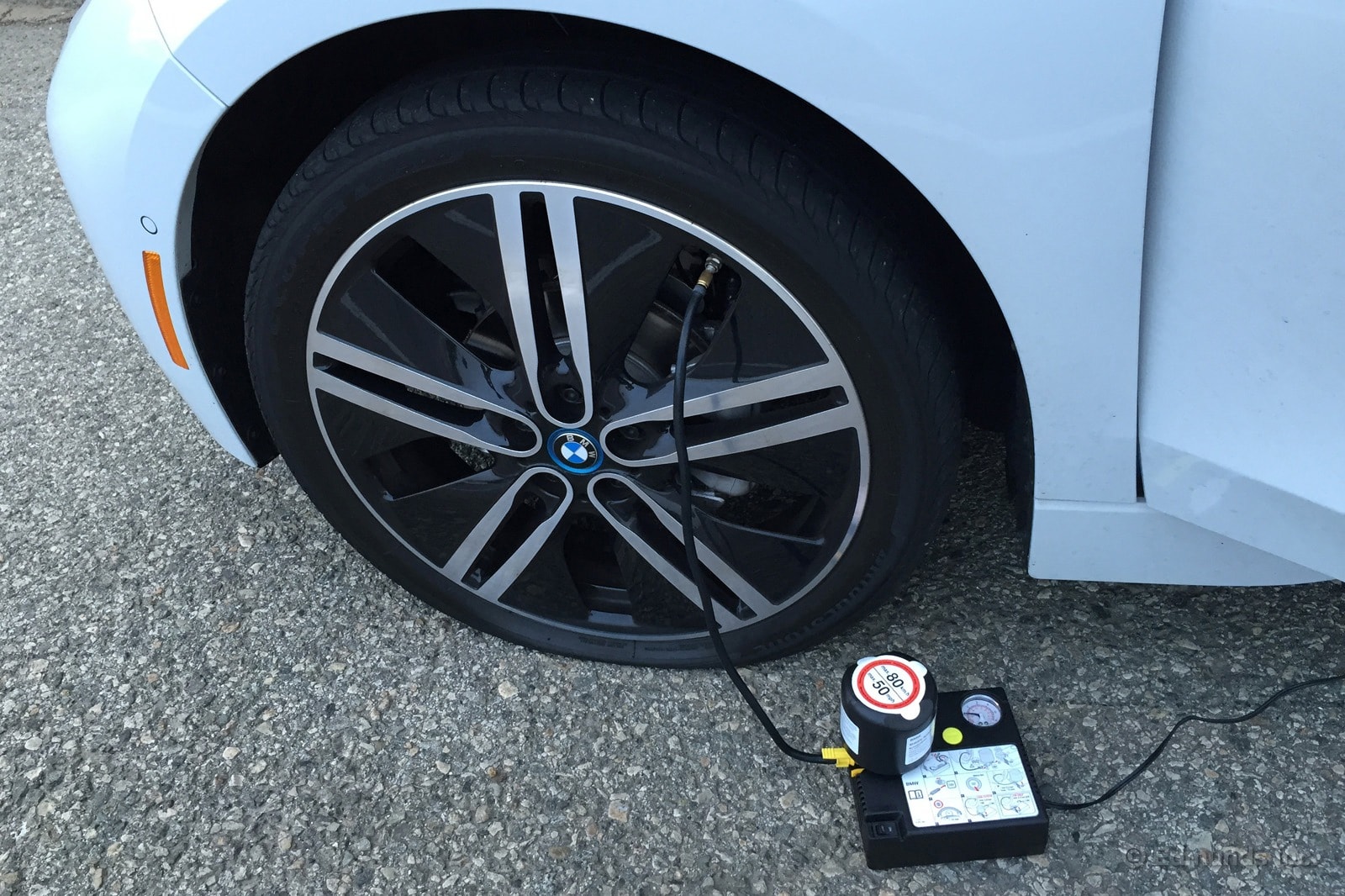
"If only I had just gone my normal route. I shouldn't have tried to outsmart traffic." These are the thoughts that entered my mind as I stared at a flat tire on our 2014 BMW i3 on a freeway off-ramp in Inglewood.
I was commuting to our offices in Santa Monica and decided to forgo my normal route to take advantage of the HOV lane on Interstates 105 and 405. Traveling happily in the sparsely-populated lane, I whizzed by vehicles caught in the slog of post-dawn LA traffic.
Then I heard the chime of the tire pressure monitoring system. The i3's TPMS system displays air pressure in each tire, and the recommended cold pressure the front tires is 33 psi. The driver's side tire was reading 20 psi. A few seconds later, it dropped to 16. Time to get off the freeway. Now.
Two minutes later, I safely crossed all lanes and found an off-ramp wide enough to get out and assess the situation on the driver's side. When I stopped the car, the monitor displayed 0 psi. I hoped the system was malfunctioning. Then I saw the wheel resting on the road with only a thin band of rubber separating the two.
Unlike most BMWs, the i3 does not have run-flat tires. Instead, it's equipped with a sealant and inflator kit located in the front trunk. To use it, the inflator is attached to the can of sealant, which is in turn connected to a hose that pumps air and sealant into the tire through the valve stem. I could find no puncture in the tread or sidewall, so there was little to do but take the necessary steps and hope it all worked.
I inflated the tire to the recommended pressure and set off. The monitor took a minute or two to recalibrate and eventually registered 26 psi in the damaged tire. I was initially alarmed that the sealant didn't work, but the pressure held. Either the monitor or inflator gauge was off. With normal traffic I was traveling slower than the 50 mph limit imposed by the sealant kit. I saw no need to fill the tire with more air with 10 miles until my destination. The owner's manual calls for the tire to be replaced as soon as possible, so after I got back to the office I ordered a tire from Stokes Tire Service.
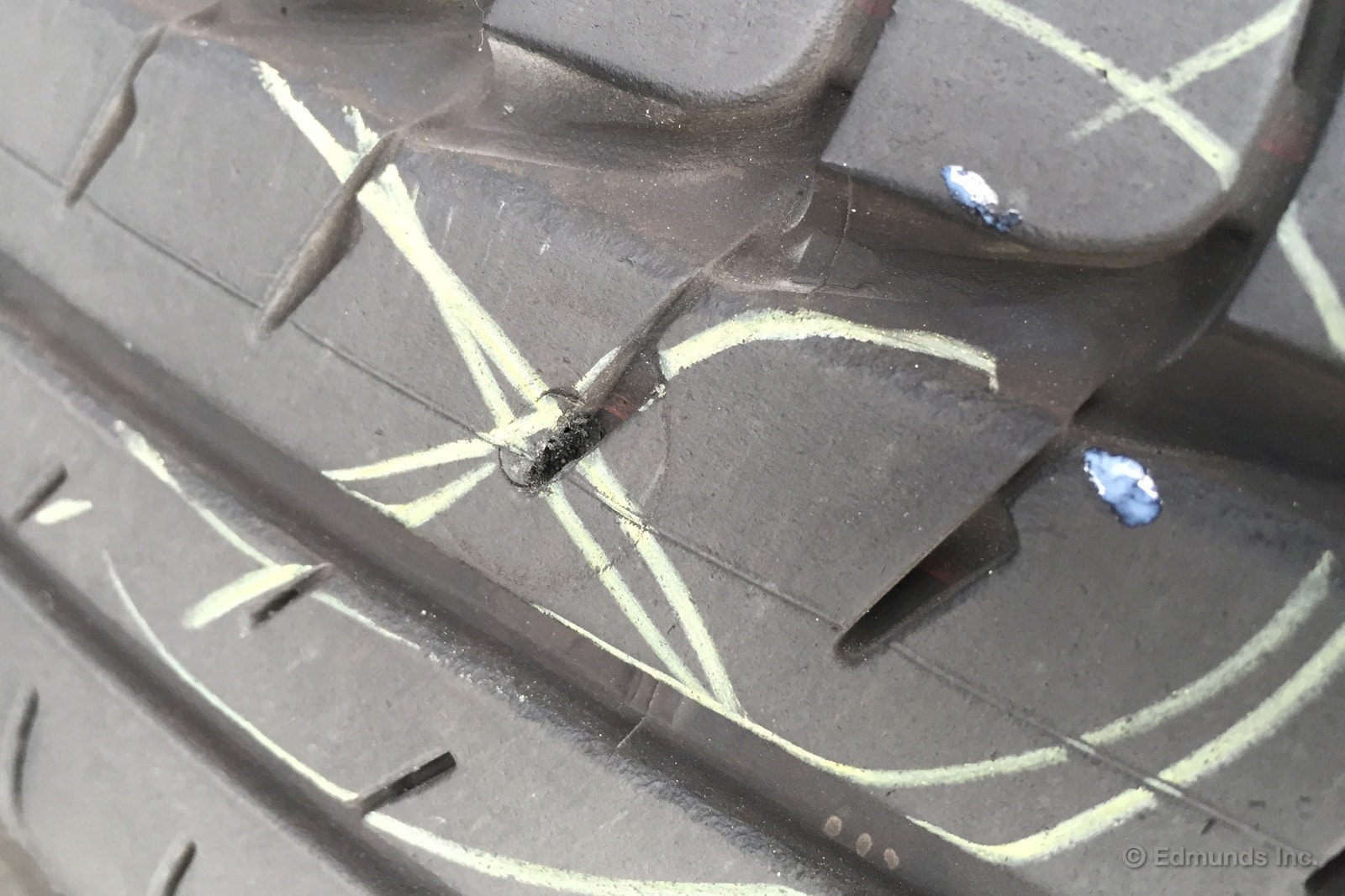
We went to Stokes the next day to get the new tire installed. The puncture on the old tire was in the tread, pictured above. Our advisor theorized that a screw had dug into the tire and dislodged, which explained the sudden loss in pressure. We also replaced the can of sealant so nobody else gets stranded on the freeway that early in the morning.
(We paid about what some commenters speculated in an earlier post about the i3's tires, plus mounting and balancing, but it didn't take a week to order what some thought would be a rare, sparsely-stocked tire.)
Cost of tire, mounting and balancing: $207.62
Cost of replacement sealant can: $50.82
Total: $258.44
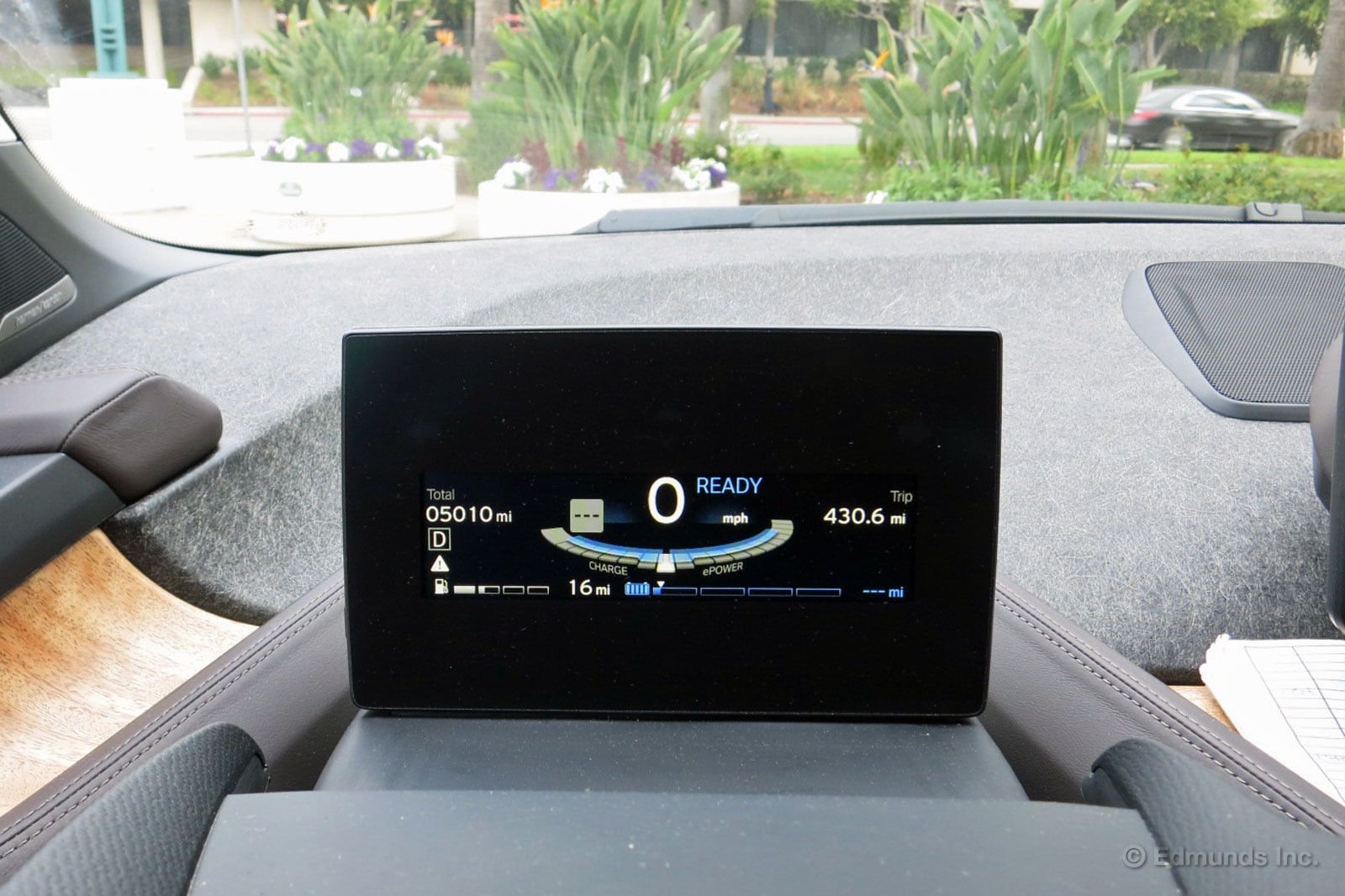
So what have we learned in the first 5,000 miles of 2014 BMW i3 ownership? For starters, it's surprisingly fun to drive for a car with shockingly skinny tires. It also fits a rear-facing baby seat or a couple sets of golf clubs if you need those capabilities.
The downsides? There's no AM radio due to interference from the electric motor and we did notice that one of the doors is misaligned. It also has a hard-to-wrangle floor mat and the climate control system is the strongest setup we've experienced.
Overall, most staffers like to drive the i3, even the ones who don't like the way it looks. Turns out, performance and practicality can trump style if you give them enough time. Guess that's why Toyota sells so many Camrys every year.
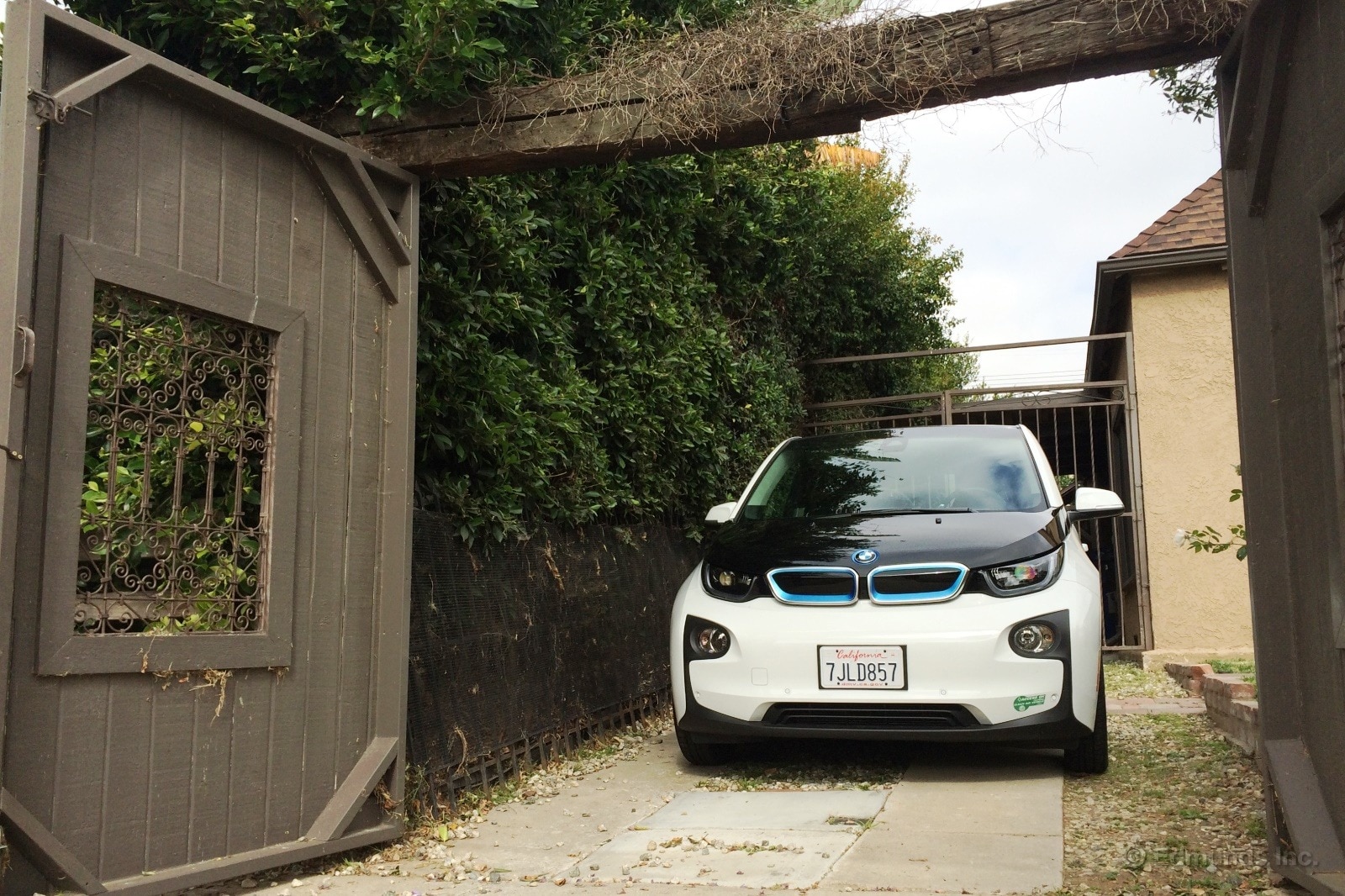
Our long-term 2014 BMW i3 is BMW's Prius. Some enthusiasts decry its existence, but the i3 represents long-term strategic planning that gives the company a technological head start, one that will make the industry play catch-up for years to come.
BMW proudly shows off the i3's carbon fiber construction with the sills, door apertures and roof texture left visible to the naked eye. Their pride is justified. The i3 and i8 are the first fruits of BMW's partnership with carbon fiber producer SGL Group and their combined efforts to manufacture carbon fiber chassis on a mass scale.
No automaker has carbon fiber as a primary chassis material on this scale, not even McLaren, which has made the same(-ish) carbon fiber tub for its entire model range since 2011 at nowhere near the i3's price point. BMW has a huge - dare I say, insurmountable - head start.
Enthusiasts really ought to be excited by the prospects. Our i3 has an as-tested curb weight of 3,124 pounds, which is very light by hybrid-car standards. Then consider that it has no B-pillar either, so it's inherently not as mass-efficient as it could be. A traditional sedan form factor could be even lighter.
The company's endgame is to introduce the material, in part or in whole, across BMW's entire range to slash weight. Sure, the impetus behind the lightweighting effort may be to satisfy CO2/CAFE standards , but this rising tide will lift all boats. After all, who doesn't want a lighter and stiffer body shell? Or slimmer pillars for improved visibility?
We're already seeing the ripple effects of the i3 in the upcoming 2016 7 Series, which leverages lessons learned from the i3/i8 to save weight. The new 7 Series car will use carbon fiber in many of the passenger cell's primary load-bearing components.
Carbon fiber chassis won't be ubiquitous overnight. Cost is still a challenge. Scalability is another. But the potential is huge. I'm reminded of Toyota's decision to bear the exorbitant costs of hybrid powertrain development years and years before everyone else. It was a huge investment for the company, a calculated gamble that paid off spectacularly.
Likewise, BMW's carbon fiber long game is allowing them to stake out technological leadership in the art. Other manufacturers are only talking about carbon fiber. BMW is doing it.
So yes, the i3 represents a bright ray of hope for enthusiasts. A dorky-looking, skinny-tired ray of hope.
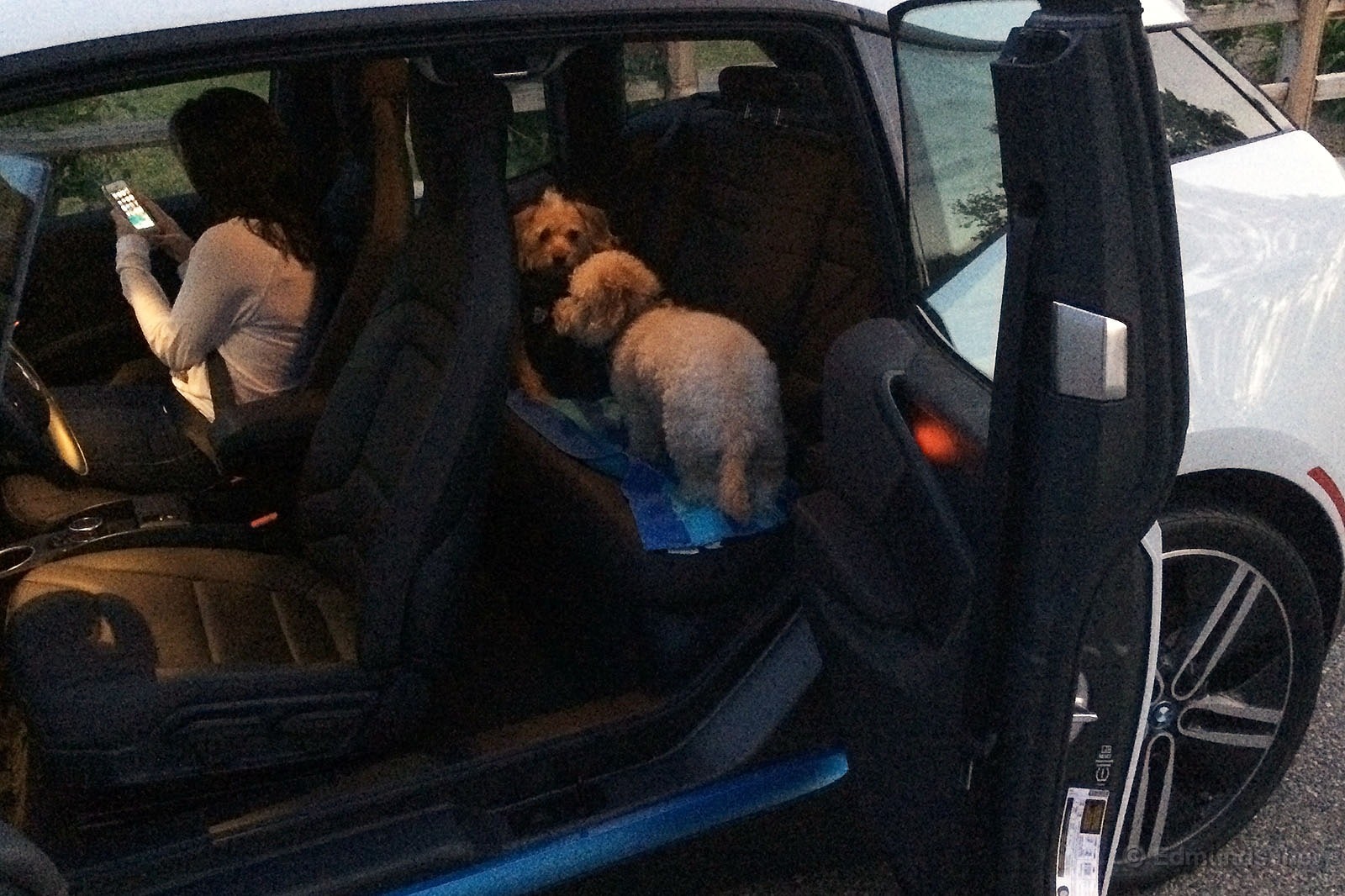
Erin Riches has noted that the rear-hinged rear doors in the 2014 BMW i3 make loading a kid into her rear-facing seat a less-than-ideal experience. But what about when you're loading dependents that don't require a seat large and substantial enough for NASA to deem it excessive for missions to space?
For loading my small dogs into the back of the i3, the clamshells weren't the same sort of hindrance. It was quite easy to lean in to buckle them into their harnesses, although since much of the back seat is behind the C-pillar, I suppose it requires a bit more reach. There's also less seat surface area for the pups to leap onto.
On the other hand, if that leap is difficult, the rear floor is that much more accessible in the i3 without a B-pillar and door in the way, especially if you slide the front seats forward. Plus, once inside, the window is low enough for my strapped-in little dog to see outside.
In total, Maggie and Nellie give the i3's back seat a dog-friendliness rating of 3 1/2 barks.*
*This is a meaningless rating. It was assigned by dogs.
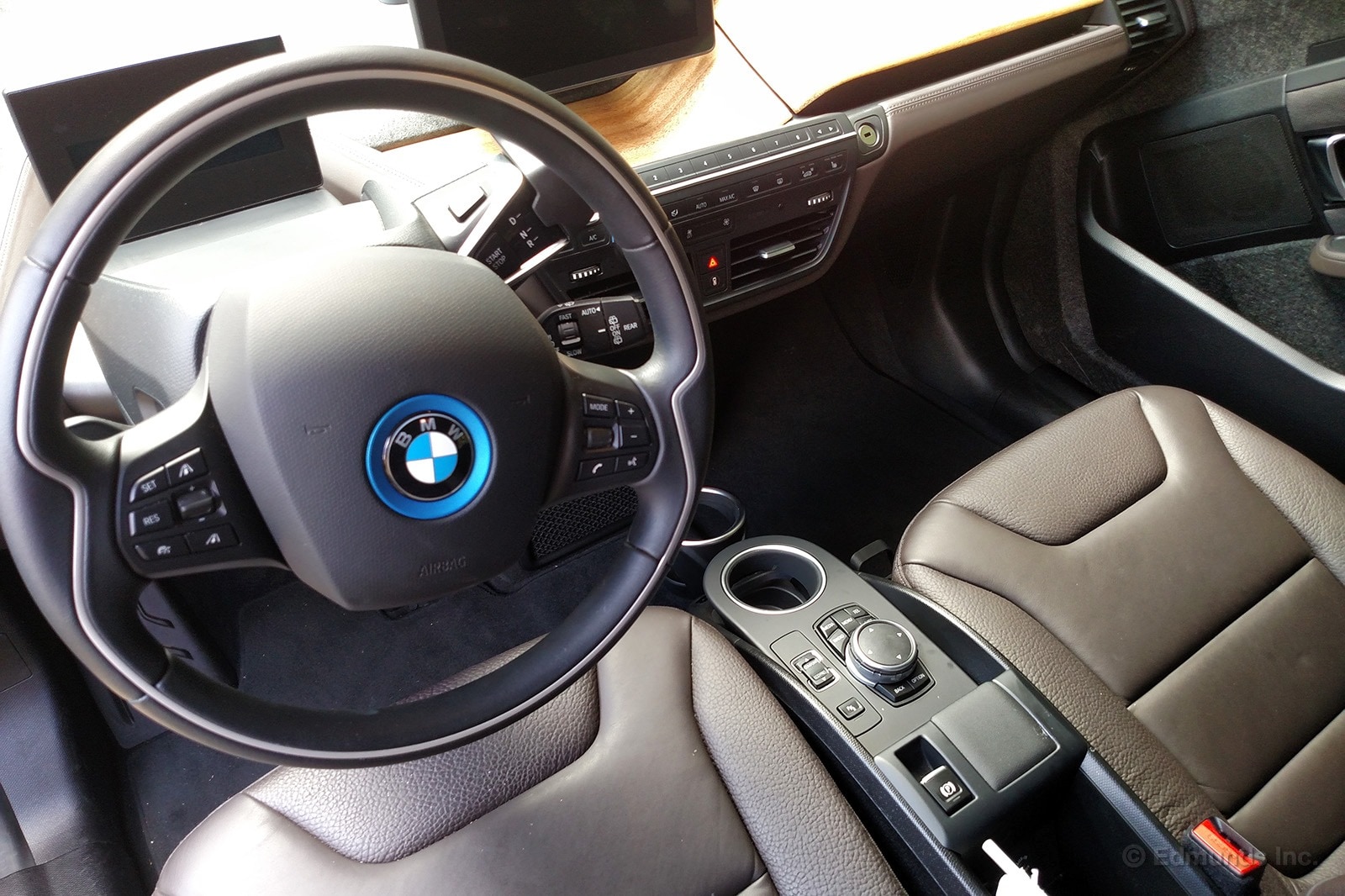
You know what makes our 2014 BMW i3 so fun?
Not its quirky looks or futuristic interior, but instead its instant torque. It hits 30 mph from a standstill in 3.1 seconds, just like our long-term GTI! But even that figure doesn't fully convey the i3's off-the line punch. It's what you want a car to do when you're trying to get across six lanes with oncoming traffic and no traffic light: Launch without lag.
I've always been a fan of that instant EV torque and I know this isn't unique to the i3, which generates 184 pound-feet of twist from 0-4,800 rpm. But it really does play a big part in making this the perfect city car. Driving it around from Santa Monica to Hollywood to West Hollywood and back, I had the chance to try it in traffic, on city streets and on the highway.
The i3 is responsive, instantaneous and linear. It does its best work in the city when you want to get out of the way in a hurry, the trade-off being that it feels relatively blunted at freeway speeds. I know this isn't how most EV car owners drive their cars, but I always floored it whenever I got the chance, like in HOV lanes on freeway on-ramps, leaving Priuses in the dust, and at traffic lights going up against antsy Honda Civic drivers. The i3 is the point-and-squirt champion.
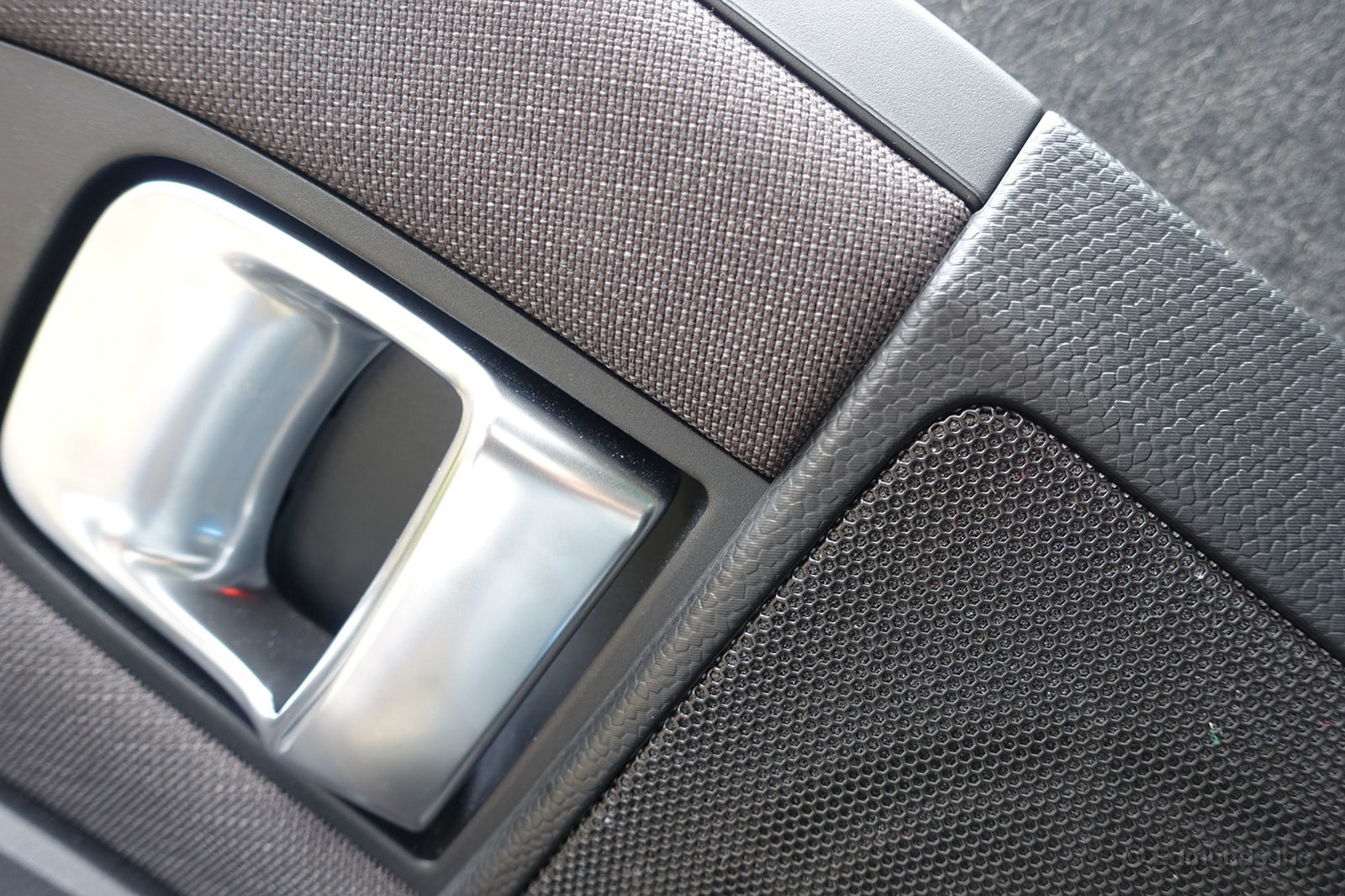
It's been a lonnng time since I've done one of these posts, taking macro pictures of the different surface materials in a car. But when I sat in our long-term 2014 BMW i3, I was struck by the variety of raw and renewable materials used in its Tera World trim, including dark brown leather seats, open-pore eucalyptus wood trim, and natural cotton weave. It's a collage of colors and textures.
Phil Reed already did a post on its sustainable interior materials but here's an even closer look.
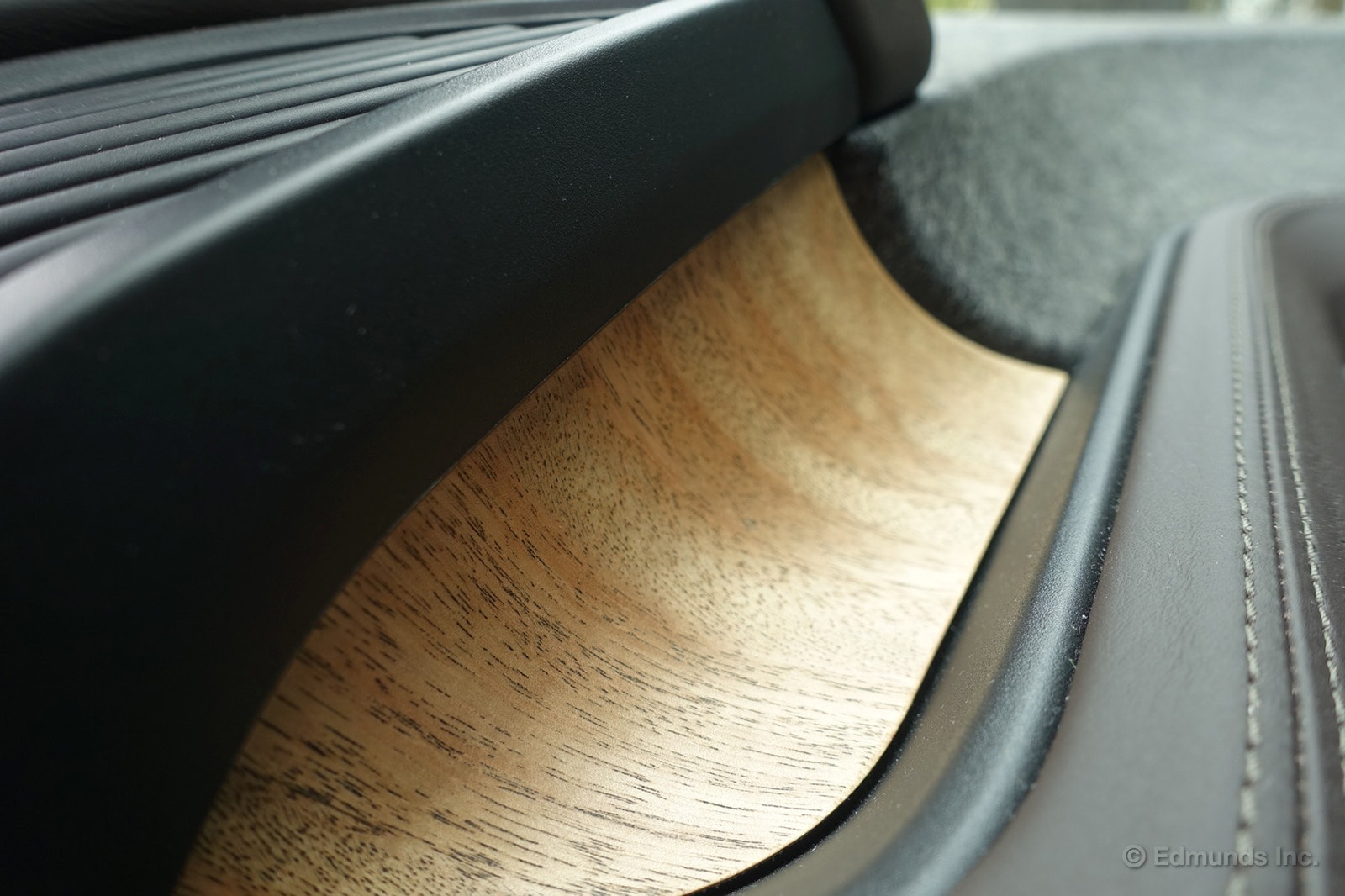
Open-pore eucalyptus on the dash.
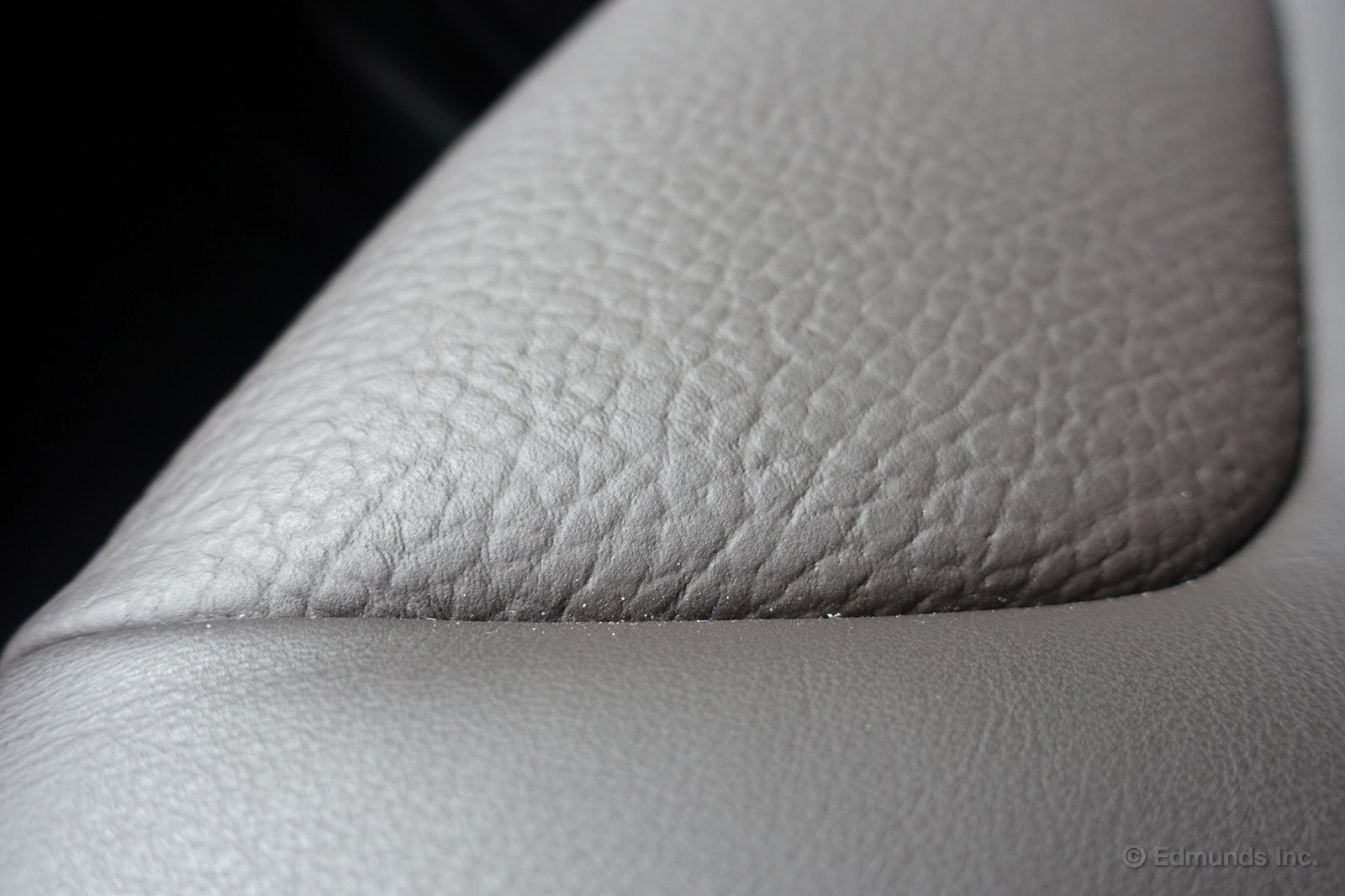
Dark brown leather seats.
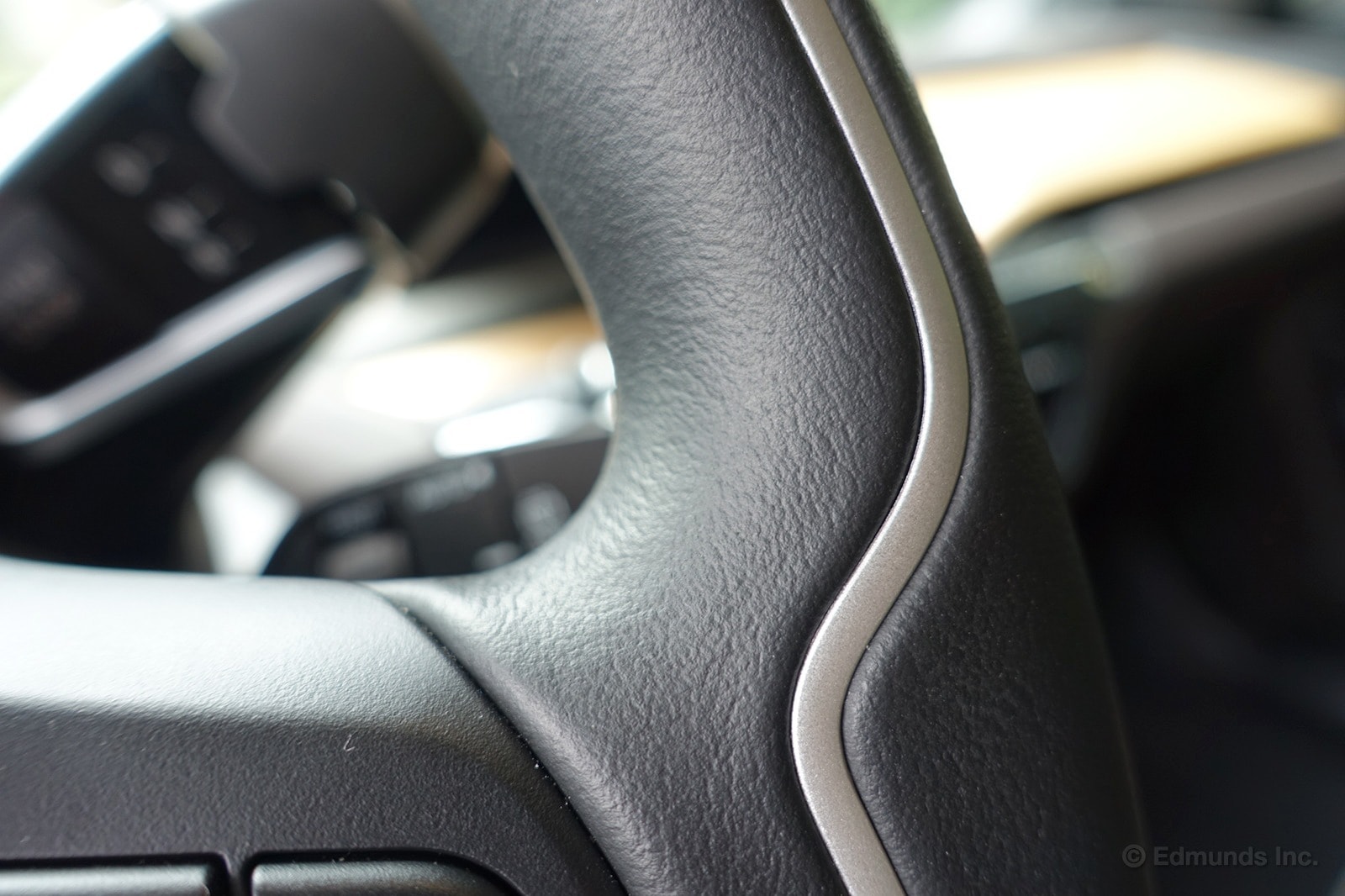
The steering wheel.

Select your mode.
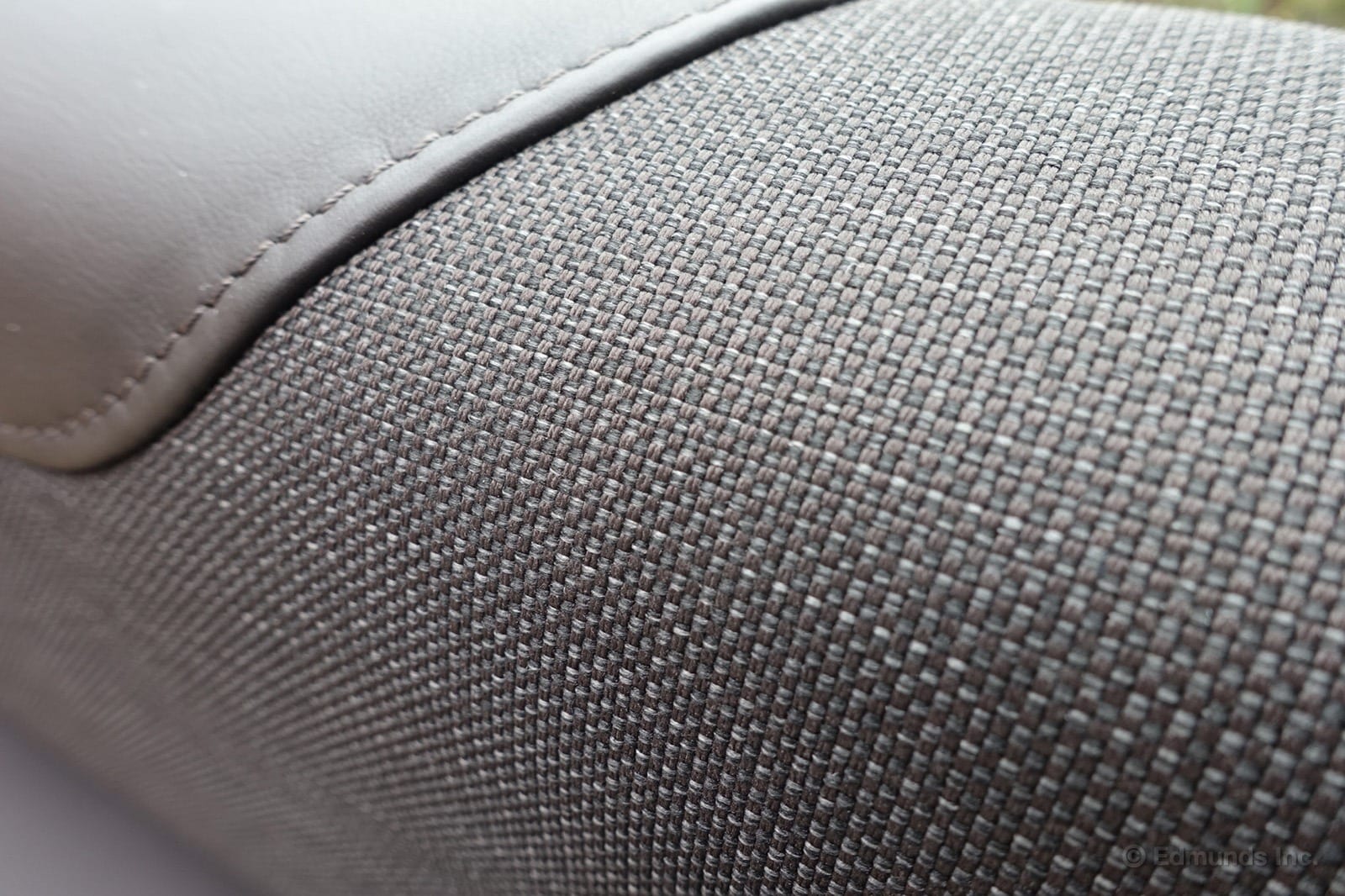
Ooh, sustainable KENAF cotton fibers on the door.

It's really difficult to track the electricity and gasoline consumption of our 2014 BMW i3 to the nth degree. The vast majority of public charge stations in the wild lack displays that reveal the number of kilowatt-hours (kWh) of electricity dispensed during a charge. And it's not easy to remember to manually record the trip odometer when our i3 runs out of juice and switches from electricity to gasoline. Both are crucial bits of information.
The first part is hard to deal with. We try to charge at Chargepoint stations as much as possible since we own one of their units and can look up our charging activity anywhere on their network in our account. But there are times when we have to charge at Brand X stations, and those times earn a blank line in our logsheet.
The second problem is one of muscle memory. It's easy to forget because: (a) you're driving when the switchover happens and; (b) 65 miles of electric range is enough that we don't run into gasoline mode very often. Exactly how rare are the visits from the range extender? It came to life just three times over a recent two-month period (February 23-April 23), and 1,709 miles of travel.
During that time we filled up exactly once and added 1.722 gallons of gasoline.
On the face of it, that works out to 992.5 mpg. But who's kidding who? The bulk of those miles were electric ones.
How many? It just so happens that all three switchover points were properly captured. We can say with confidence that during that two-month period, we ran 1,656.6 miles on electricity and 52.4 miles on gasoline.
Using 52.4 miles instead, our 1.722 gallons of gasoline burned at a rate of 30.4 mpg. The EPA's fuel economy rating for the i3 range-extender (REX) is 39 mpg. Sure, we fell short, but when only 1.722 gallons are involved, the over-consumption amounts to just 0.38 gallons. That's less than $1.50 over two months. I lose that much loose change in couch cushions.
Our 1,656.6 miles of electric driving consumed 468 kWh, which works out to an average electricity consumption rate of 28.2 kWh per 100 miles. The i3's EPA electricity consumption rating is 29 kWh/100 miles, so we're doing better than predicted here. Thing is, our driving style was the same on electricity and gasoline.
Other Tidbits
Those electric miles were spread across 44 different plug-in events. On average, each charge consumed 10.64 kWh after spending 37.7 miles on the road.
Our maximum observed electric range in this period was 67.5 miles, but there were only three such max-range events. Each required an average of 20.5 kWh to refill the battery (minimum 19.79 kWh, maximum 21.5 kWh)
Utility Factor is a number applied to plug-in hybrids and electric vehicles with a range extender like ours. It's the predicted percentage of total miles run on electricity, and as you might expect, the bigger the electric range, the higher the utility factor.
With 1,656.6 miles out of 1,709 run on electricity, our Utility Factor during the two-month period was 96.9 percent. I have a Utility Factory chart published by the Society of Automotive Engineers some years ago which suggests that a range-extender EV with 72 miles of rated range will run on electricity 80 percent of the time. We crushed it during our two-month period.
I'm still going over the data for the miles added since then, but it's very clear that our i3 REX has enough electric range to run as an EV a very high percentage of the time. It's only those staffers with long commutes, such as yours truly, that tend to run it down to where the gasoline engine fires up.
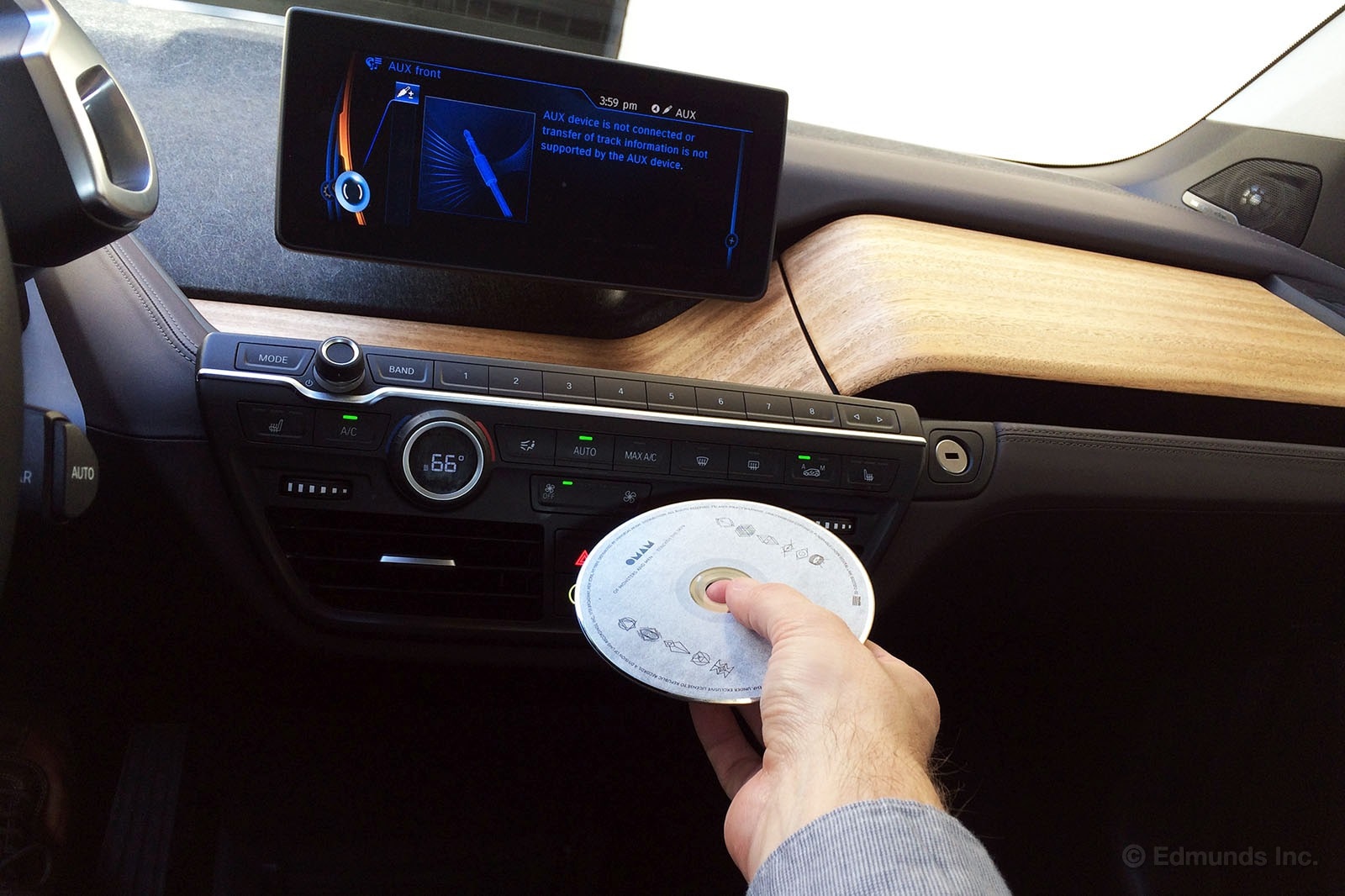
Dear James,
I would like to welcome you to the 21st Century. It's quite an interesting time, as dressing like a well-coiffed lumberjack is chic and I don't need stinky, burny old gasoline to make myself move. OK, so I have an engine, but I only sorta need it. Anyway, good luck with that quaint, shiny bit of plastic you have in your hand. If you're expecting me to do something with it, well, LOL.
Apparently you're unaware that here in the Teens (which is quite obviously NOT the Teens of the Edwardian, Great War variety), we play music through our phones. That's right, phones are no longer just that thing with 12 buttons on it that you can use to call your friend's house. You can not only play music on them, but also watch a baseball game, order a pizza, write an e-mail (you had those in the '90s, right?), translate something from Japanese and Tweet. Well, that's if you know that a Tweet, in this context, is not the sound a bird makes.
As such, you can plug it into the, and follow me here, USB port where you can control certain phone functions from that big ol' screen on my dash. It'll even charge it for you! You can also use Bluetooth Audio, which is not a recording from a dental office.
If, however, you still feel like playing that "CD" you can always use that old "discman" that is, for some ungodly reason, still in your desk drawer and plug it into the headphone-looking jack under the armrest. I can't speak to the effectiveness of its fancy electronic shock protection (ooooh!), but I'm sure it still works great. #sarcasm
Oh, you probably wouldn't know what a hashtag is, would you? Oh well, I suppose it could be worse — that 1998 BMW Z3 of yours only has a tape deck. Which reminds me, say hi to Grandpa for me.
Yours Truly (I figure you would appreciate the ye olde formality of letter-writing pleasantries),
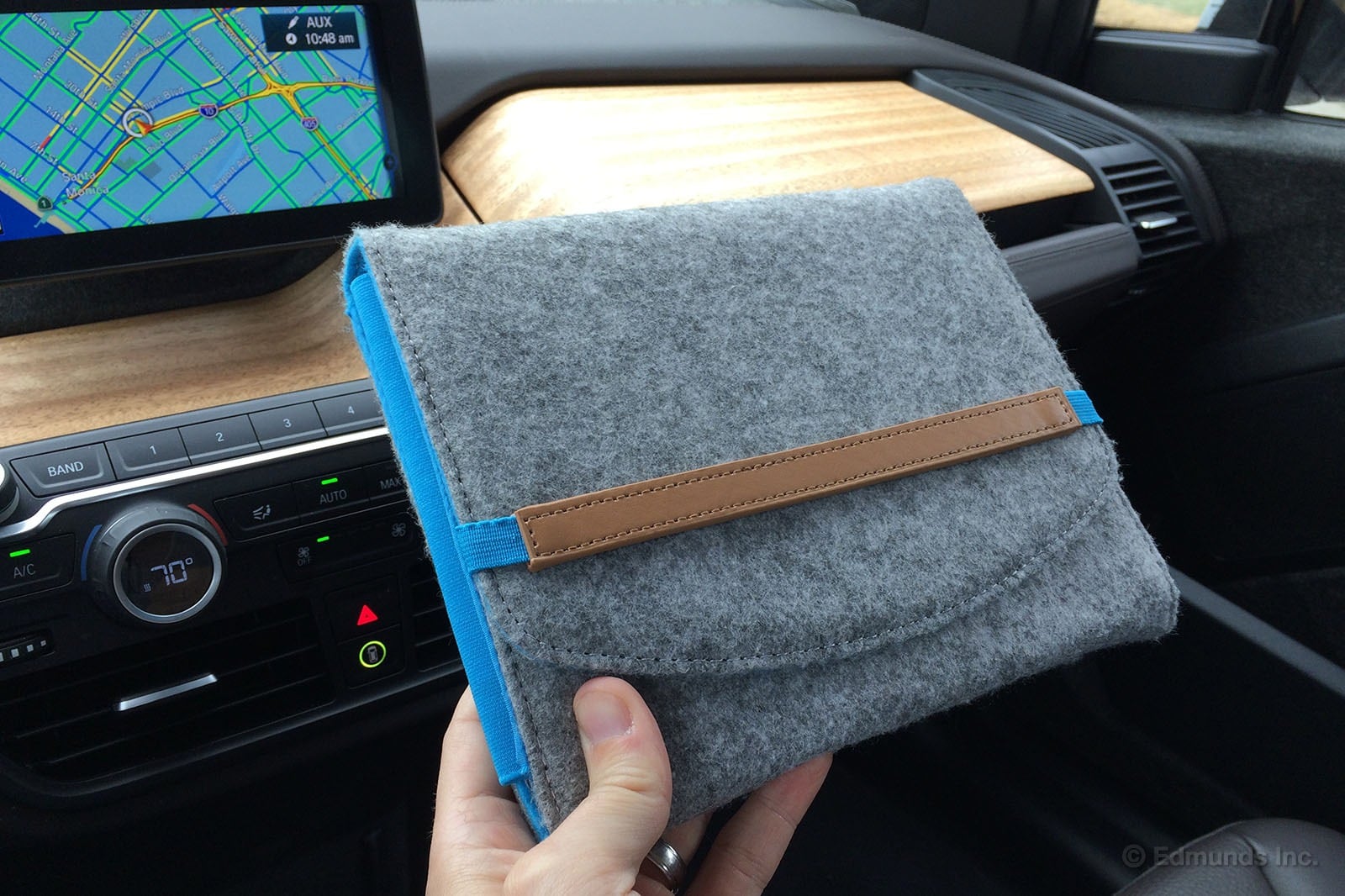
The 2014 BMW i3 has a lovely case (cover? satchel?) for its owner's manual. It's a wooly grey material accented with a cool shade of light blue and a strip of tan leather that matches the Cassia Natural Leather found in the i3's Giga World trim level. Tres chic, no?
I mean, it's an owner's manual case, so you'll be forgiven if your interest barely nudges past 1 on the Excite-o-Meter. But it's certainly more interesting than the ubiquitous black pleather pouch and another way that BMW attempts to make the i3 clearly different from all the run-of-the-mill cars it sells. Well, as run-of-the-mill as a BMW gets at least.
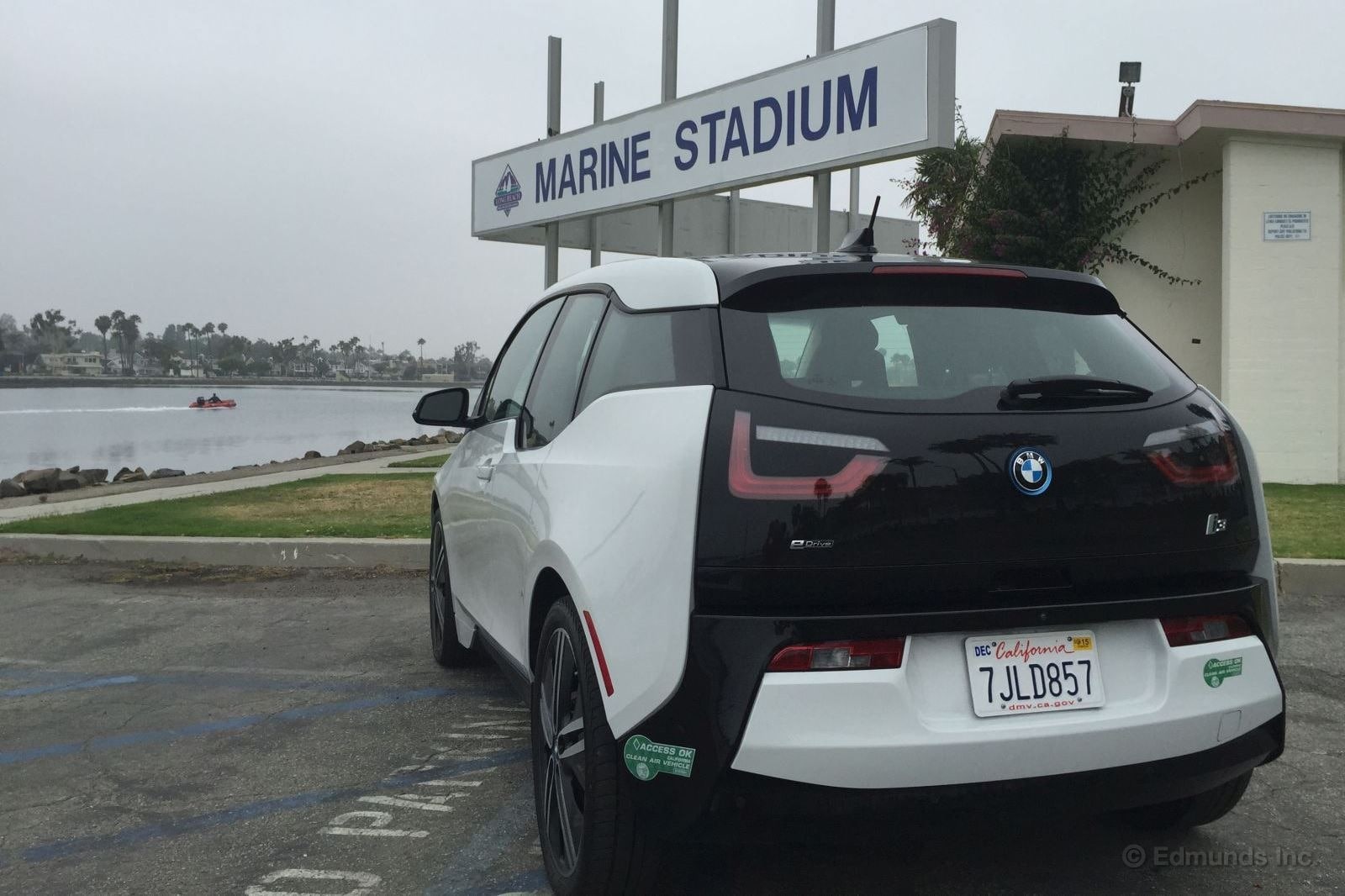
I drove to a party recently in our 2014 BMW i3 and it sparked an interesting conversation. Instead of exploring the pros and cons of EVs, it morphed into one of those "I'd never drive one because..." conversations. One guy said, "The problem with electric cars is that if everyone had one, the grid couldn't provide enough electricity."
It left me speechless. He was right, of course. But it is also true that not everyone is going to suddenly begin driving EVs. In fact, after four years on the market, a recent report said the number of EVs, hybrids and plug-in hybrids combined is around 3 percent.
Another guy at the party, who knows I lease a 2014 RAV4 EV turned to me and said, "Aren't you going to stand up for electric cars?" I felt like a kid on the playground being baited into a fight.
I don't believe that arguing with people will change their minds. I don't tell people that their opinion is wrong. I just state my own opinion. So, here are five things that I think make EVs great:
1: Great driving experience: Quick, quiet, great handling, instant response, no shift shock.
2: Great fuel savings. About $1.65 worth of electricity gives me 50 miles of driving (at my overnight rate of 0.11 cent/kilowatt hour). An estimated 7 million EVs could be added to the grid without needing to change it in any way.
3: Great carpool lane access. Hey, they subsidize oil companies, so why not commuters?
4: Great traffic car. One foot'll do it.
5: Great convenience. Never visit gas stations. Instead, connect in 30 seconds and charge overnight.
So, that's what I think and that's why I drive an EV most of the time (I have a second car for longer distances). But then again, I'm clearly in the minority - a 3 percent minority, so what do I know?
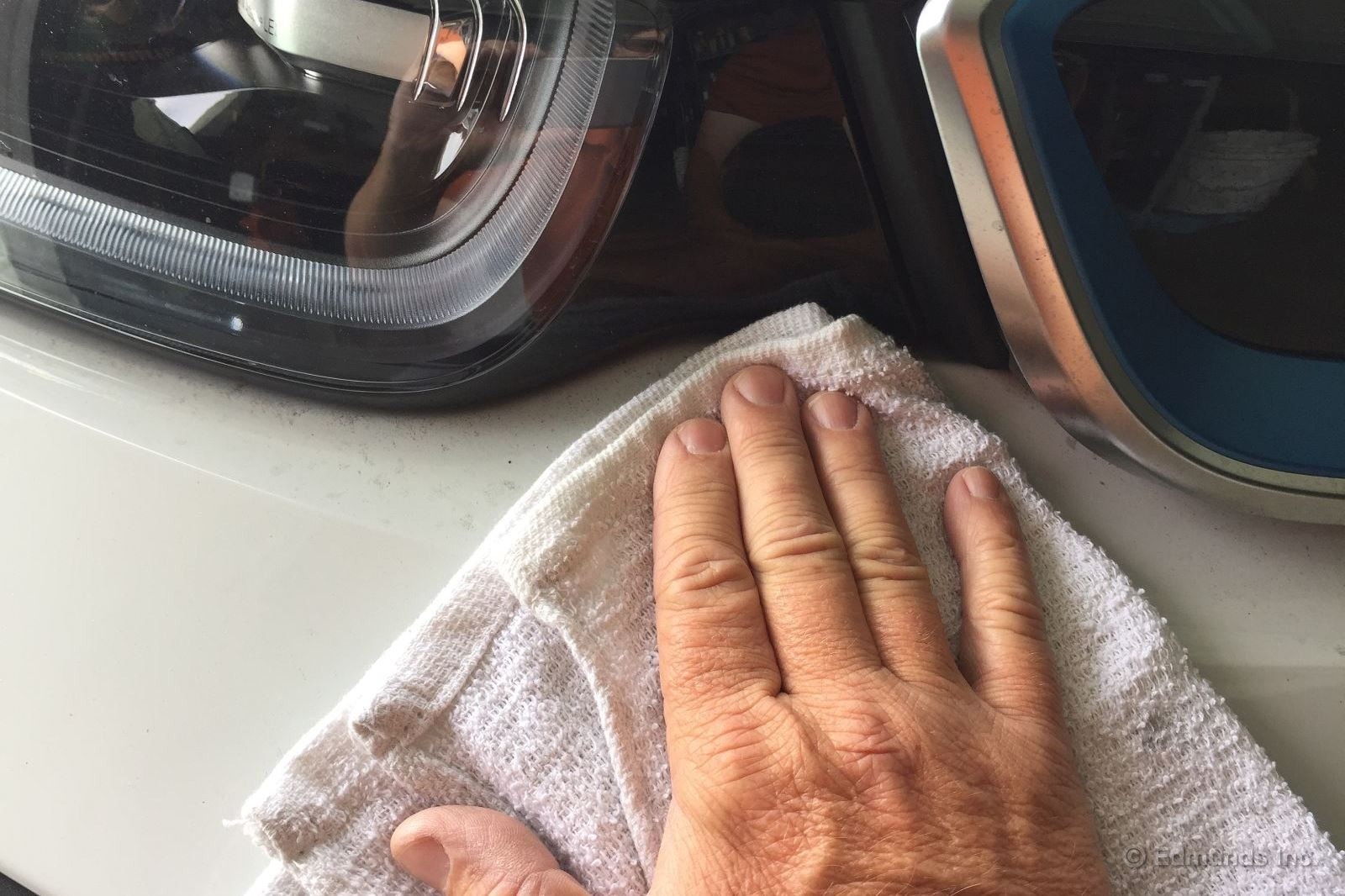
There are photos of dirty cars here in California with the cutline, "Dirty for the drought." I thought of those photos when our 2014 BMW i3 was given to me covered in grime. I don't like dirty cars. But I also don't want to use a lot of water during this drought. I was in serious conflict.
Here's how I handled it.
Let me start by making a confession. I'm one of those weirdos that likes to wash cars. I think a lot of car guys feel the same way. But washing doesn't have to mean getting out the hose and running water over the whole car (although sure, you have to do that every once in a while). I've found that getting a microfiber towel wet, wringing it out, and then carefully removing the grime does a pretty good job.
Many of you might be cringing, imagining grit and grime scratching a pristine paint job. I looked into this a few years ago when so-called "water-less" car washing became popular. Turns out, the trick is to lightly remove the grime and turn the towel to use clean sections often. That way, there isn't a buildup of grime on the cloth that will scratch the paint or clear coat.
While cleaning the i3, I was reminded that most of the body panels are plastic. It gives under your hand when you run a wet microfiber towel over it. The dirt lifts off easily. Also, being a small car, there's a lot less surface area and you can do the job in about five minutes. You still have to clean the glass surfaces twice, however - once with the towel and once with window washer fluid and a paper towel.
When I was done, the BMW looked good again. Okay, I don't like the styling, but what I'm saying is that it was clean. And since I'd only used about a half of a gallon of water, my conscience was unscathed.
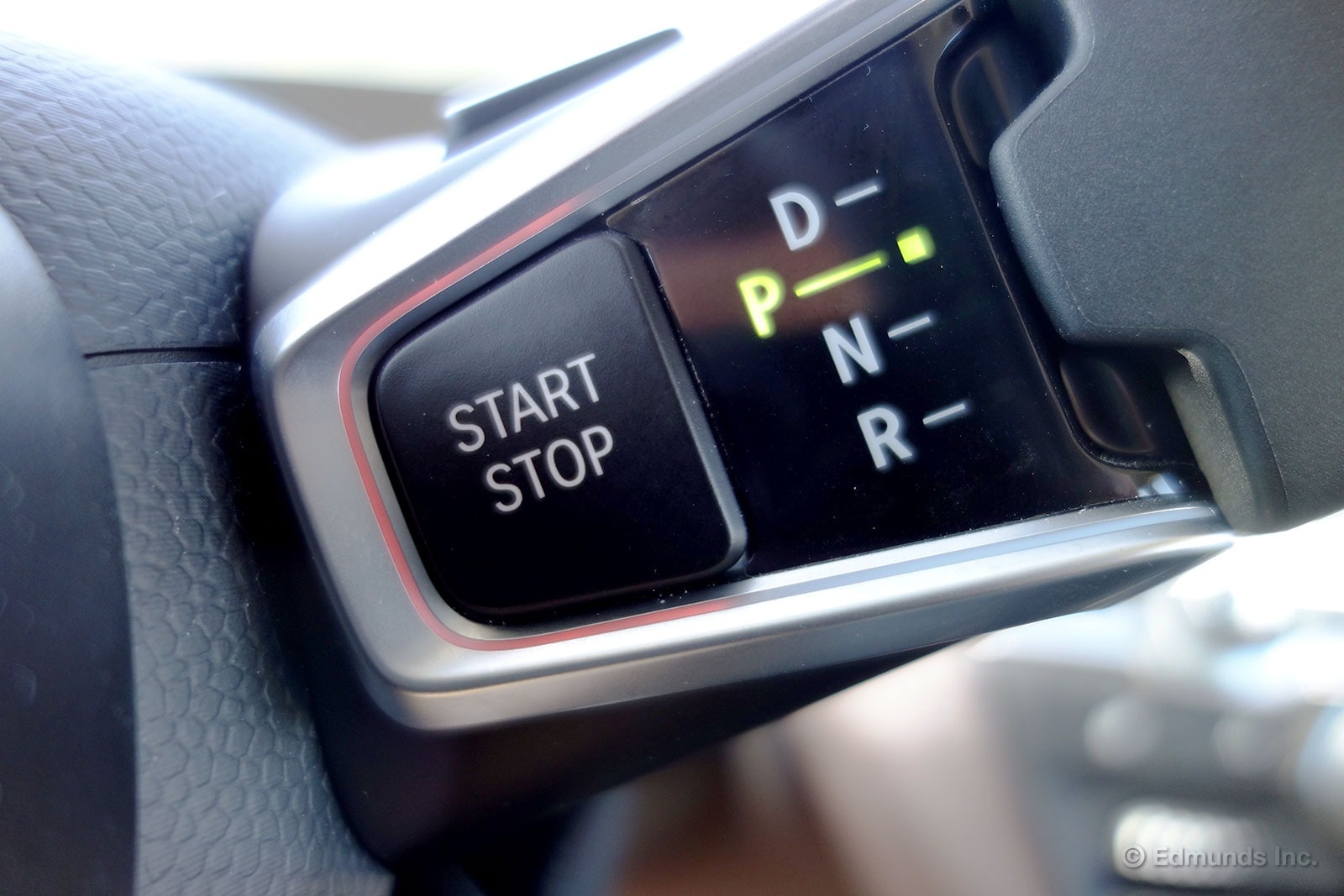
The interior of our 2014 BMW i3 is refreshing. When you hop in, you can see the work of an automaker aggressively trying new ideas and taking new approaches to design. Take the gear selector. It looks like a stubby "D" in profile and feels like some kind of throttle stick in use.
But why is there a start/stop button?
The Tesla Model S doesn't have one, and it works great. After you hop in, you simply put the car in gear and drive off. I'm reminded of this every time I hop in the i3 to go somewhere. Can we ditch it, BMW?
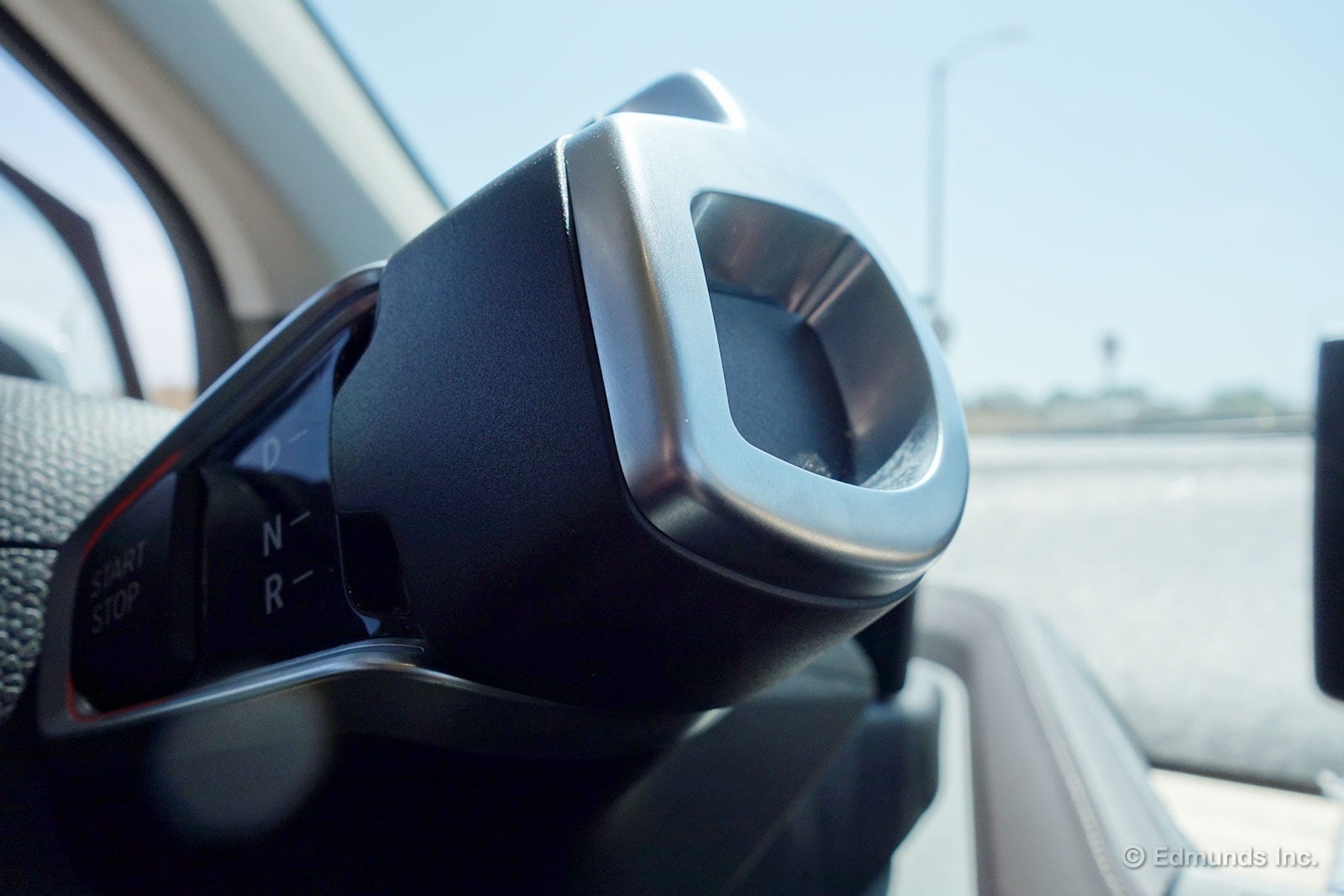
Back to that shifter. I like its look and feel, but the choosing a gear seems backwards in operation. You twist the dial away from you (pushing forward with your thumb) to select drive and twist back for reverse. I'm used to a stalk you push down for drive, and I've ended up in the backwards gear a few times by accident (for the record, Erin didn't have these difficulties).
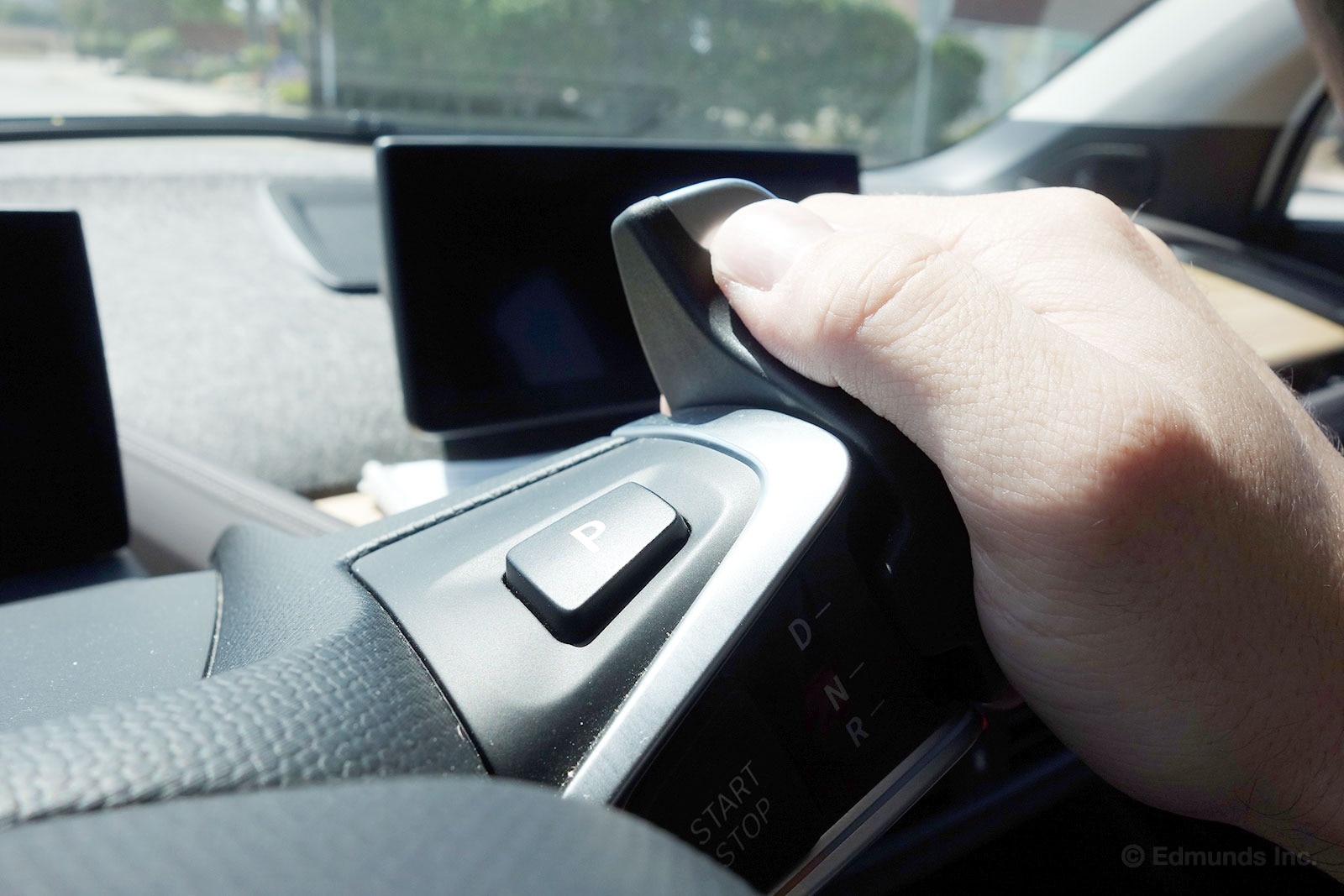
But why do we need to twist it? The location makes me think "stalk," like the Model S, so my brain thinks it works like one, even though the gear labels clearly indicate the direction to twist it. Still, I wonder why it doesn't move up and down like a more familiar rocker switch.

Beyond both being electric cars, the i3 and Model S share a neat trick: Flat floorboards. You don't need a transmission tunnel when you don't have a transmission, and that means you don't need to encroach on interior space with a bulge running down the middle of the car. You can leave the floor flat, opening up storage space and making the interior feel larger. It's a nice spot for handbags, though it would be nice to have a small bin here.
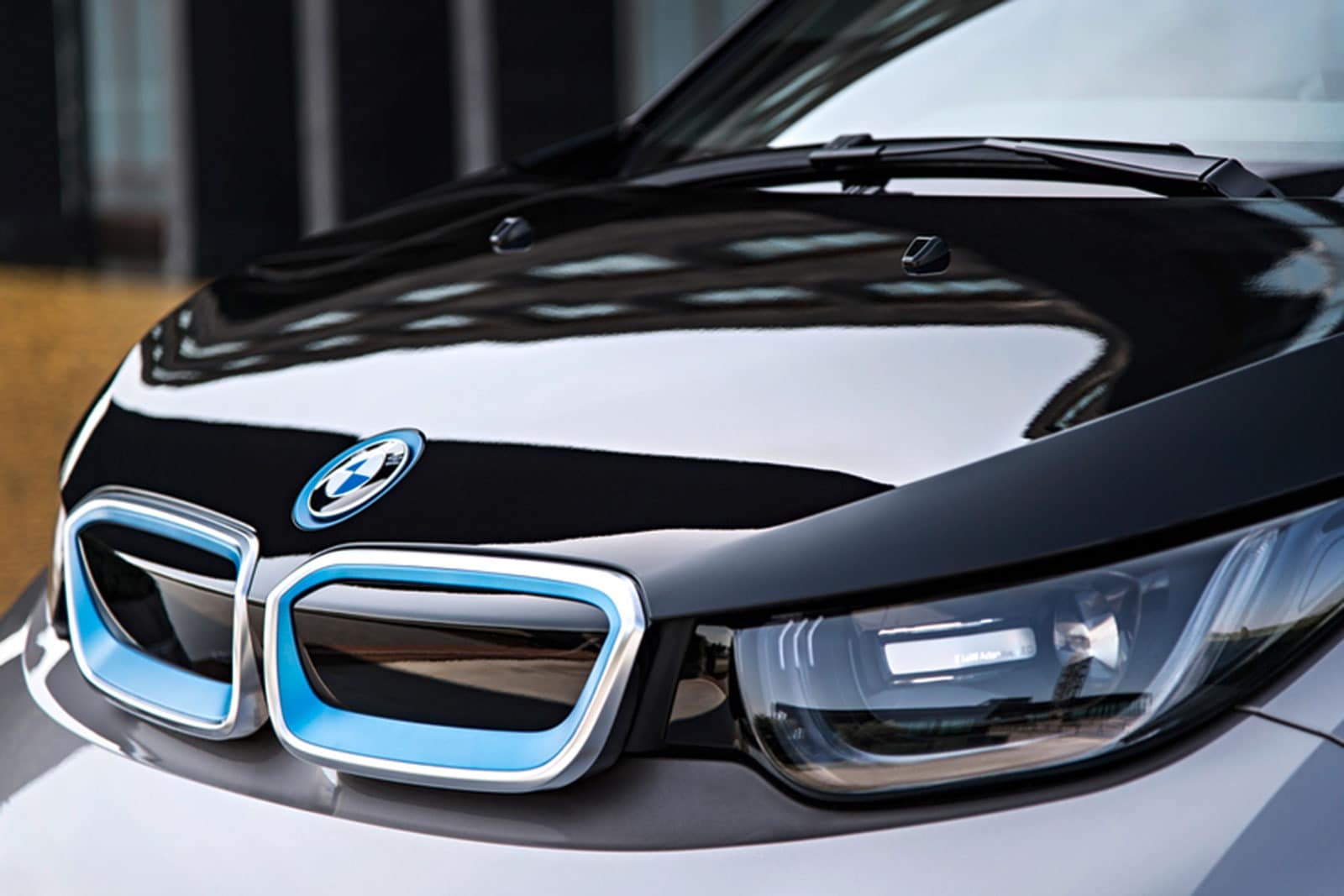
The faux-grill on our 2014 BMW i3 is a nice nod to the automaker's design history. But because electric motors don't breathe air, the grill has no function. That means we can modify it without repercussion.
First: The color. BMW's Frozen Blue highlight nicely emphasizes the grill as a design element, but wouldn't it be nice if you could get something other than blue? Cue Photoshop.
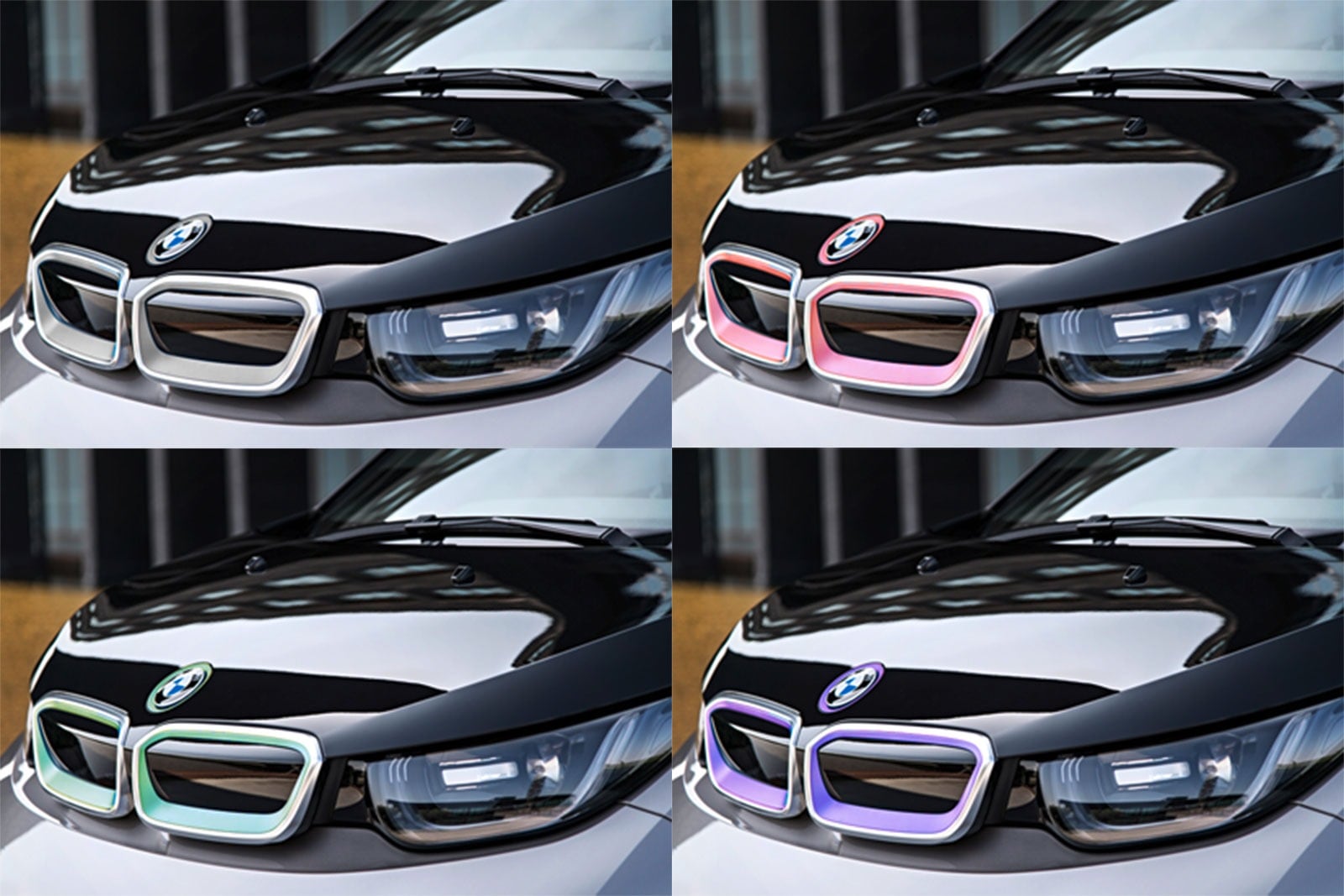
You could do something like this in the real world with vinyl or Plasti Dip, and it probably wouldn't cost too much. But we need to go further.
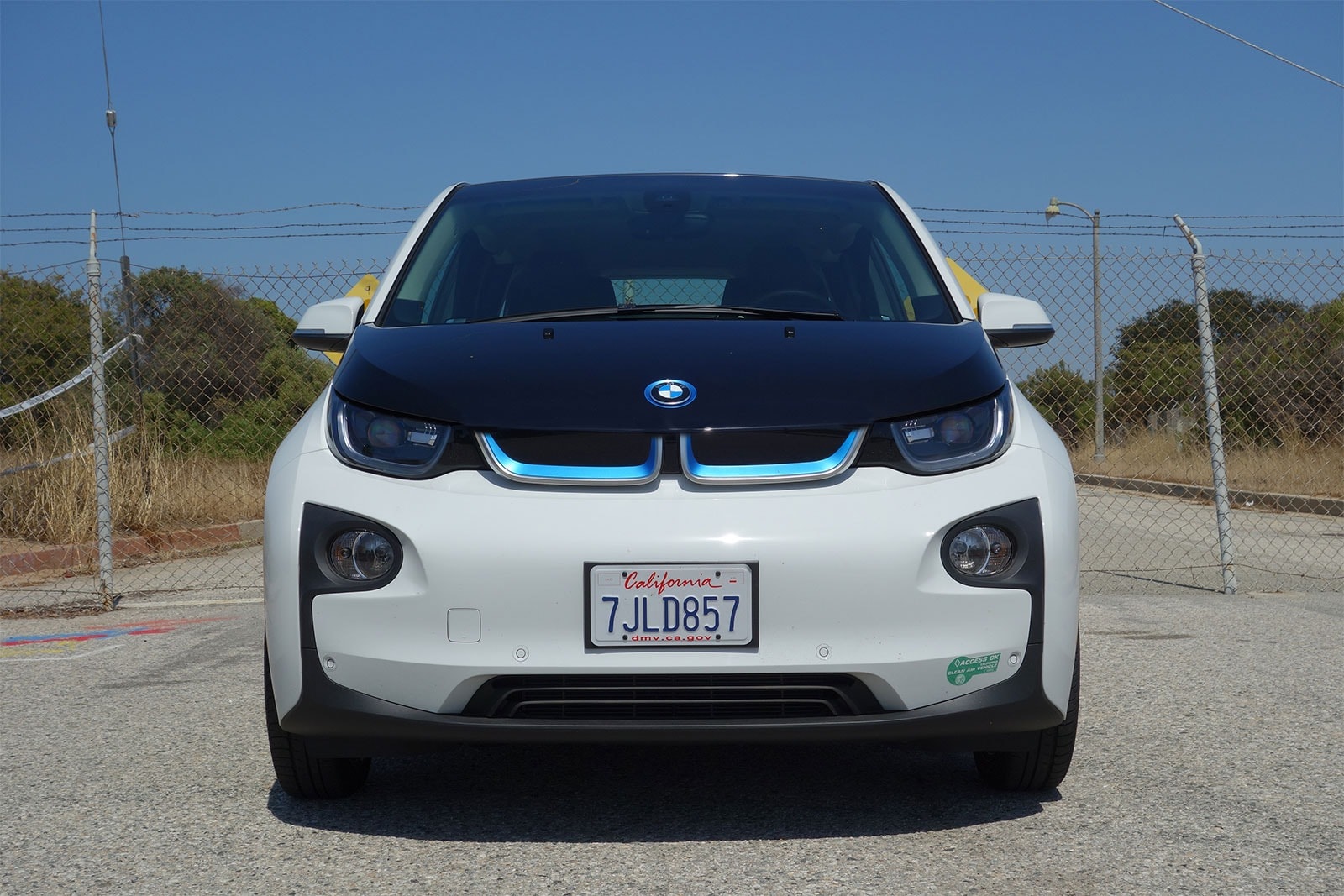
Photoshop's clone tool makes quick work of the top half of the grill. And doesn't the i3 look better for it? I'm no car designer, but I see a sleeker, more aggressive look that better matches the headlights. Sadly, shaving the grill like this in the real world would probably be expensive. Part of me wants to see how much.
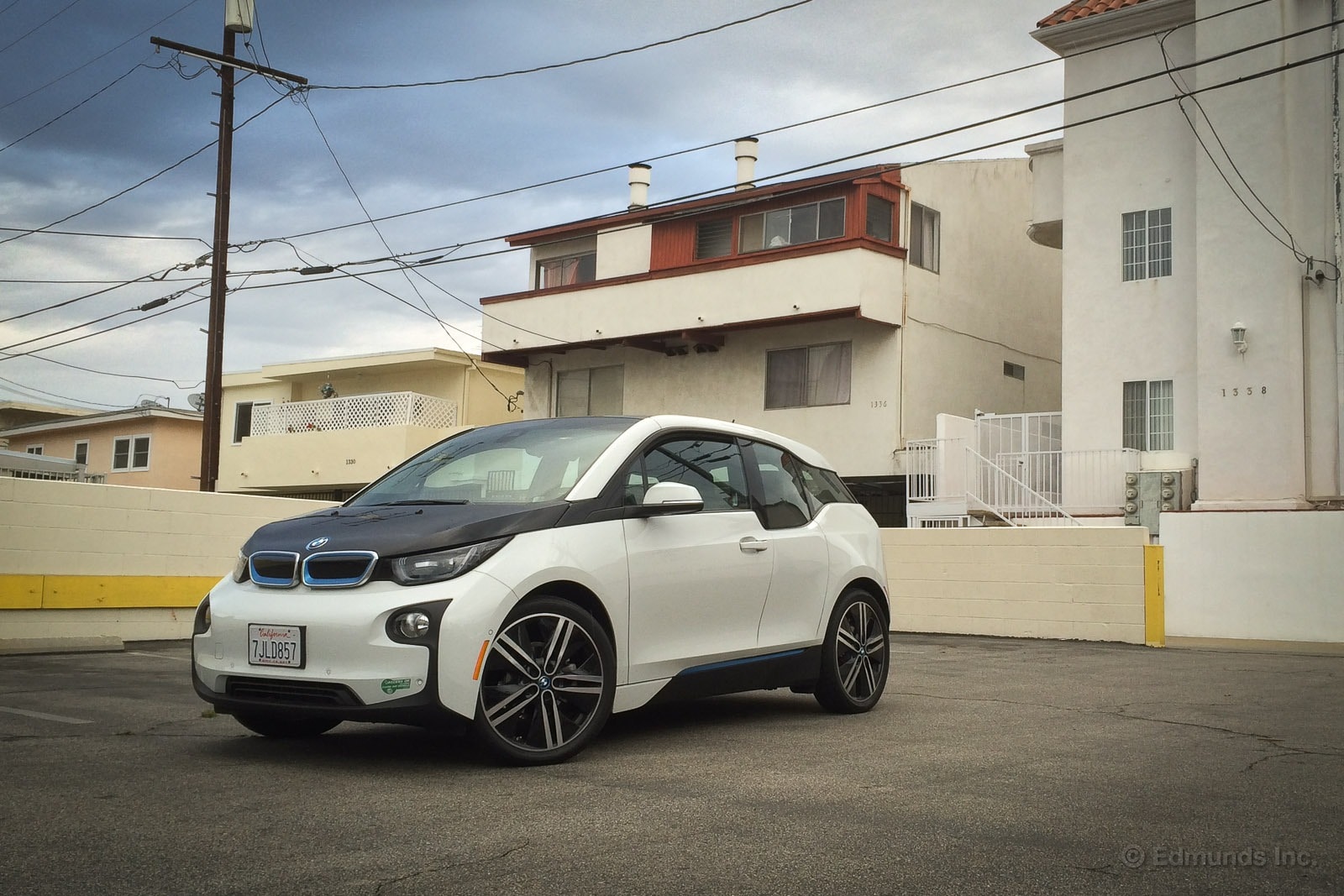
A few weeks ago, I was chatting with a co-worker I'd never met before. When she learned that I worked on the Edmunds editorial team, she asked what I thought of the BMW i3. Now, I've been doing my job long enough to know that this is a tricky question to answer. More often than not, the person is asking because he or she already owns the questioned vehicle and wants to know what I think.
So had I responded with something like, "You bought a 1989 Yugo? What a piece of garbage!" that might not be the best way to endear myself to my new colleague.
Fortunately, the BMW i3 is an easy car to like.
I admire what BMW has done to create the i3. Prior to its arrival, there was a huge gulf between affordable (if you can call them that) EVs like the Nissan Leaf and Ford Focus Electric, and the super awesome, but much more expensive Tesla Model S. The i3 firmly holds the middle ground.
For shoppers who want a more upscale and sportier EV, but still need to keep monthly payments aligned to an entry-luxury vehicle, it's potentially ideal. The range-extender option furthers the i3's appeal.
In that chat with my coworker about the i3, however, I did mention that main thing I don't like about the i3: the styling. The awkward proportions and body panel lines are just too off-putting to me. I don't think I could own or lease an i3 for that very reason.
In contrast, she said the loves the distinctive styling and said it's one of the main reasons she bought her i3. We had to agree to disagree on that point. Otherwise though, it's nice to know that there's another Edmunds BMW i3 running around besides our long-termer.
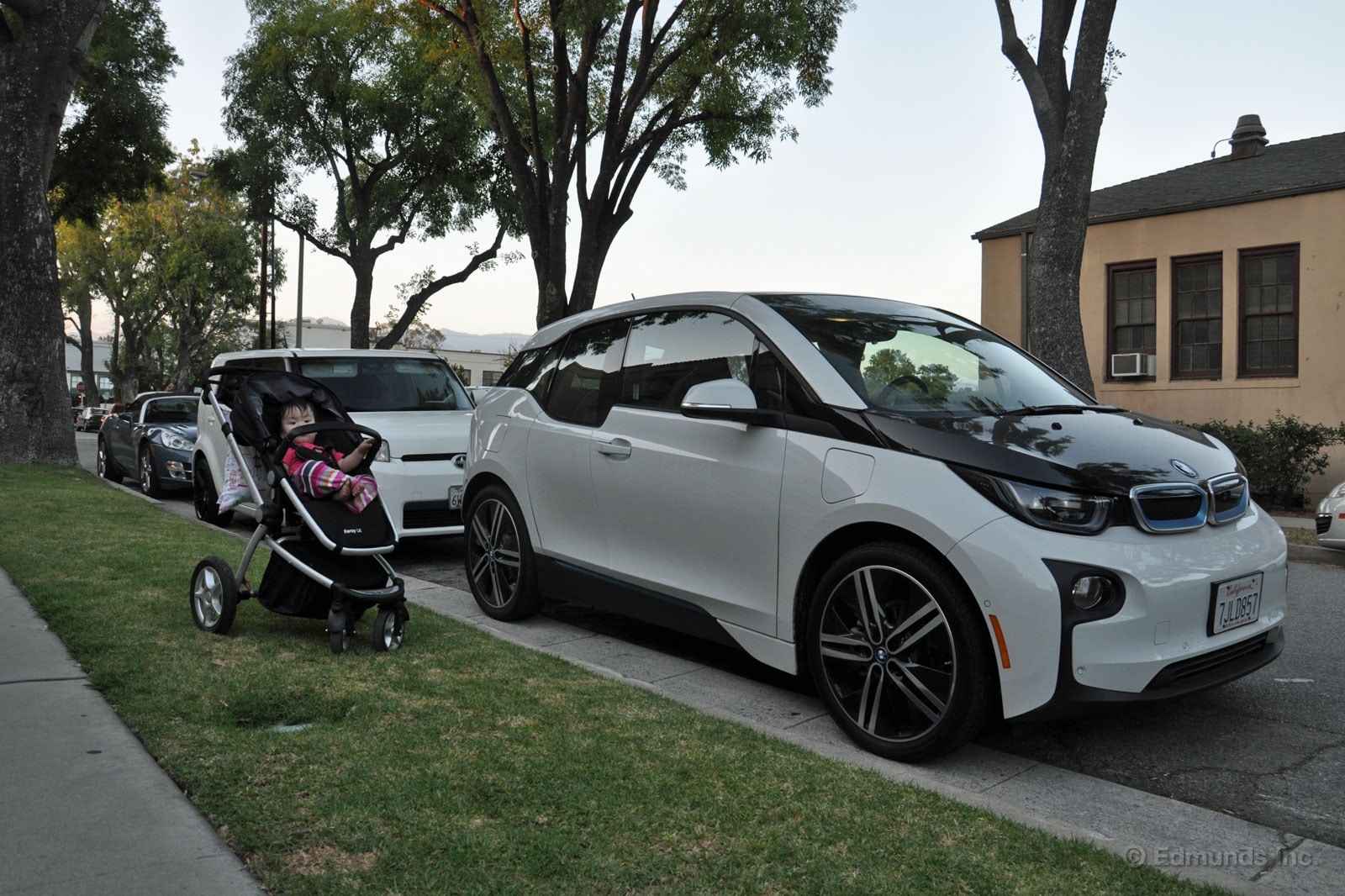
Since a rear-facing convertible car seat fits in our long-term 2014 BMW i3, it naturally follows that you'll want to take along a stroller. I knew our electric hatchback had some light hauling ability for golf clubs. But I figured I'd only be able to fit my very compact Maclaren Triumph umbrella stroller.

Sure, enough the Maclaren fit easily and left plenty of room for groceries.
But then I got greedy and decided to take my not-small full-size stroller, a Maxi-Cosi Foray LX. It's a bear to fold and load for its size, but it's a comfy stroller with an elevated ride height (it sits much taller than an umbrella stroller) and my daughter prefers it. I had grand plans to top up our i3 at a charging station and then take a long walk to a farmers market and maybe a playground.
My plans didn't totally work out, but the big stroller just fit. I did have to remove and store the cargo cover in the garage, though.
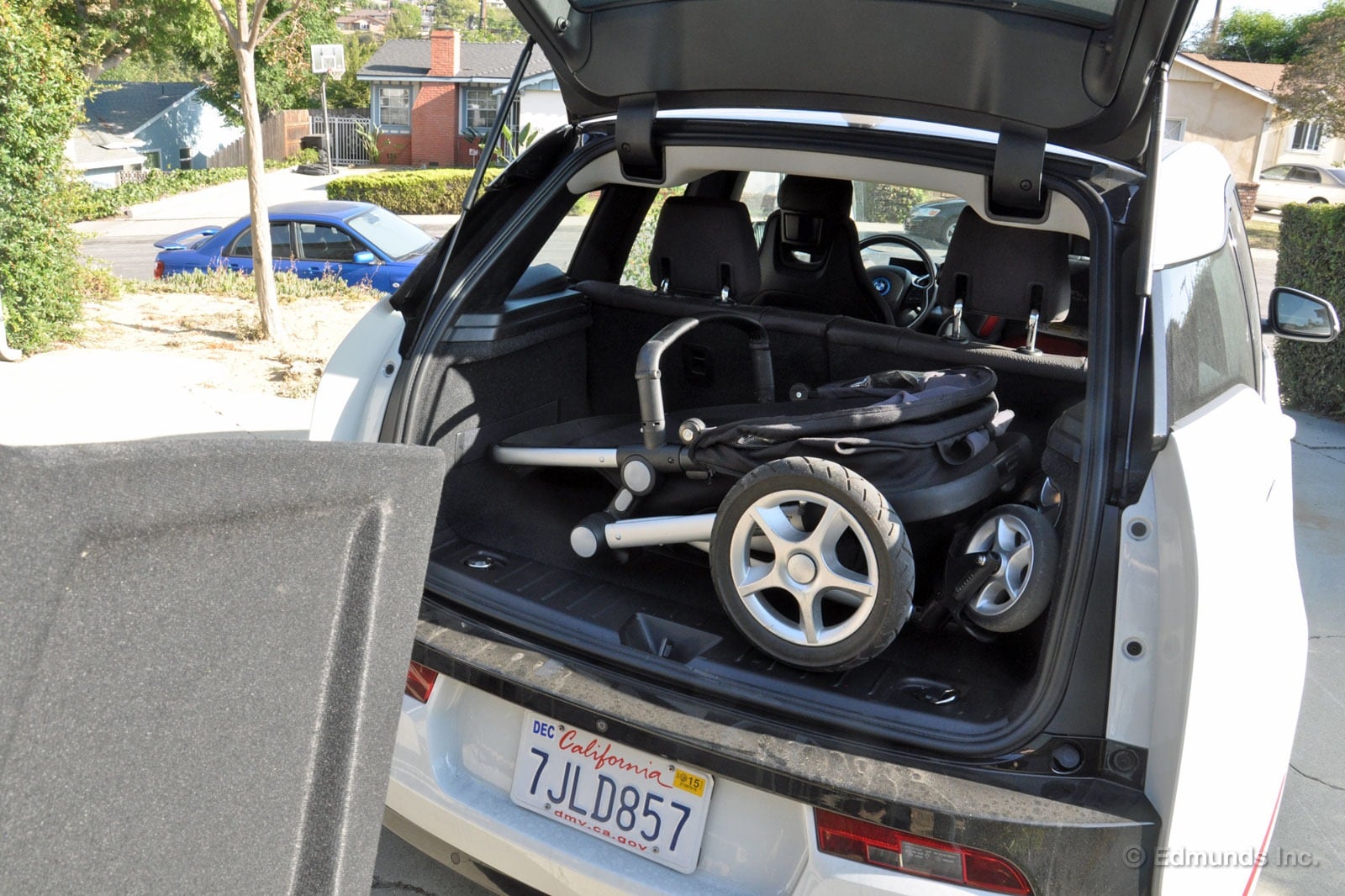
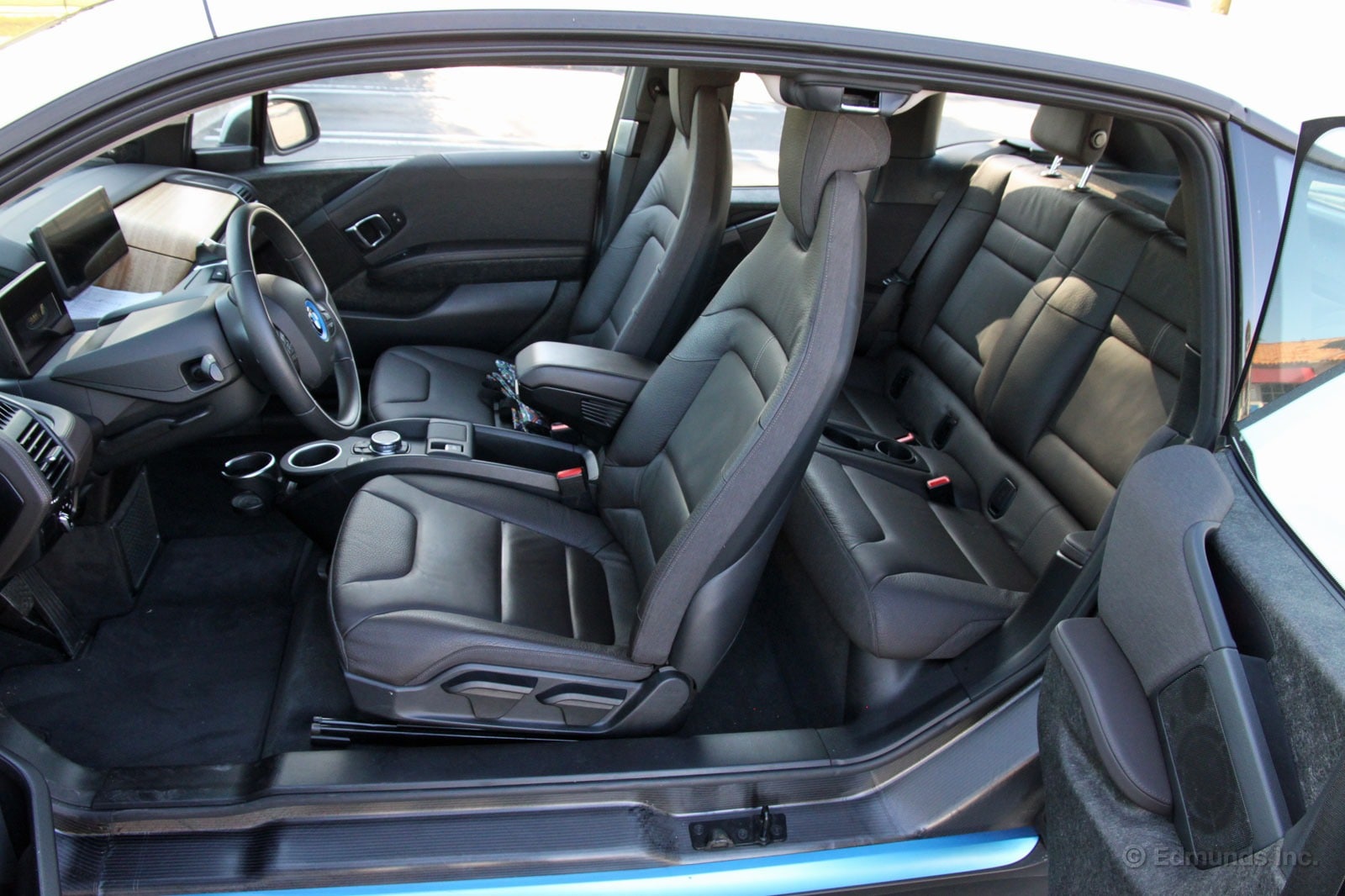
As you can see, the seats in our 2014 BMW i3 aren't exactly plush-looking. They're purposely thin to save space and weight, and they aren't power-adjustable for the same reasons.
The result is a thoroughly average driver's seat. Not bad, but not great. Comfortable enough during an average commute that you don't really notice it. Anything longer and you start wishing for a little more support and a few more contours.
I find myself fidgeting after an hour or so. The seat is flat with little bolstering, so it it's accommodates a variety of body types, just not mine. The overall position of the seat in relation to the wheel is good, however, so visibility is great. Even with the manual seat adjustments, it's easy to find a comfortable position. There's no option to upgrade the seats themselves, only the material that covers them. In this case, I don't think that would make much of a difference anyway.
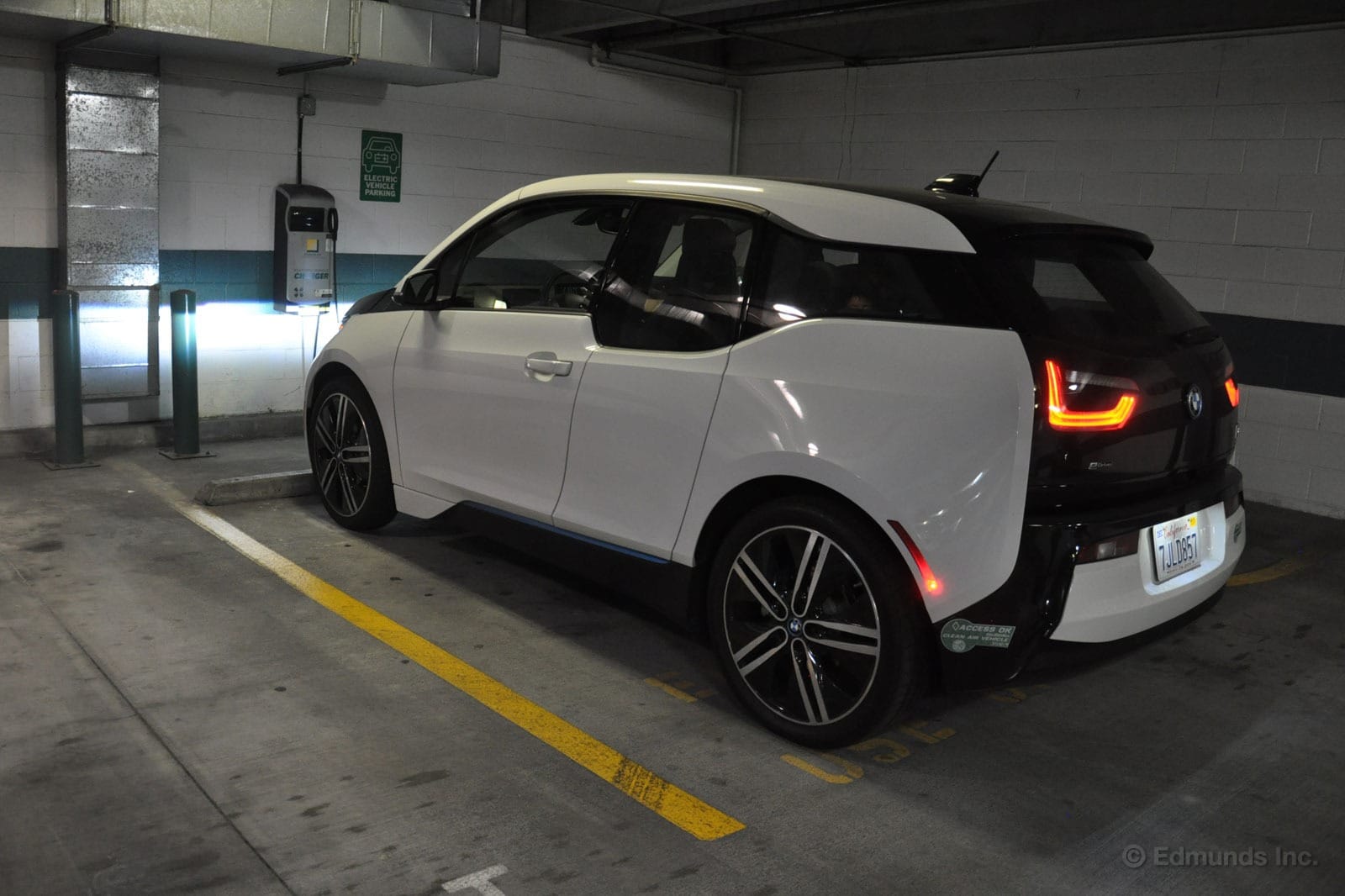
I like driving our long-term 2014 BMW i3 and I can't really explain why. I think it's a combination of the size, the driving position, the aggressive regenerative braking as you let off the accelerator pedal and the knowledge of its carbon-fiber-intensive structure. Whatever it is, I find myself looking for ways to fit it into my life.
I live 20 miles from our office, so over the course of a long weekend, I was looking for an opportunity to top up the battery pack. There's free charging near me at the Los Angeles County Department of Public Works, but I have a toddler so I don't have the luxury of going somewhere to sit and wait unless there's a playground. Instead, I wanted to charge the i3 while shopping for produce at the South Pasadena Farmers Market.
So I poked around on Google Maps and found a charging location at an upscale grocery store (Bristol Farms). I figured I'd I plug in there, and then my daughter and I would take the stroller to the farmers market.
Of course, I figured wrong.
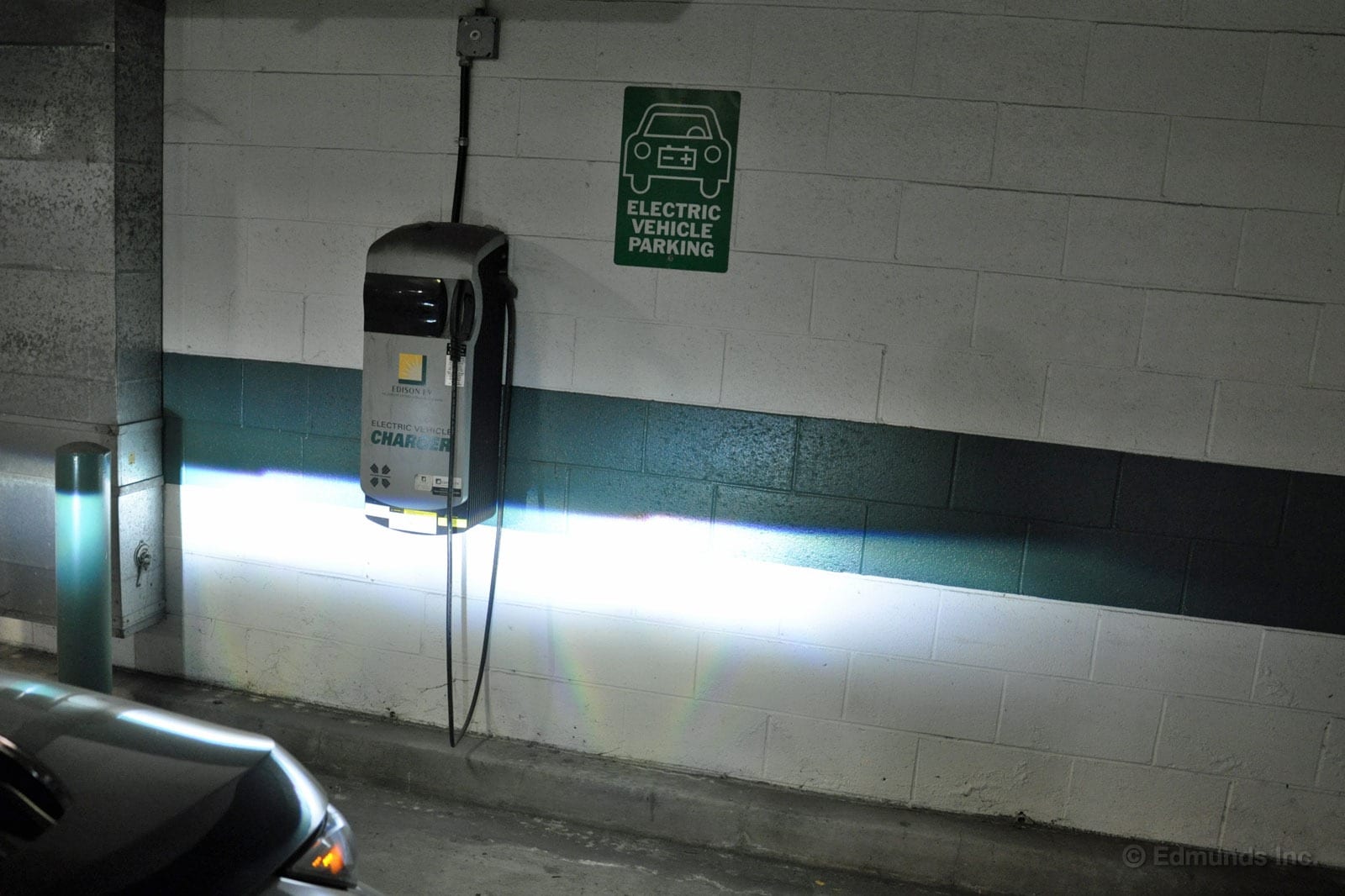
Sure enough, there was a nice spot set aside for charging an EV in the Bristol Farms parking garage. At least I'm sure it was nice on September 8, 1997, when "N.G." last inspected it.
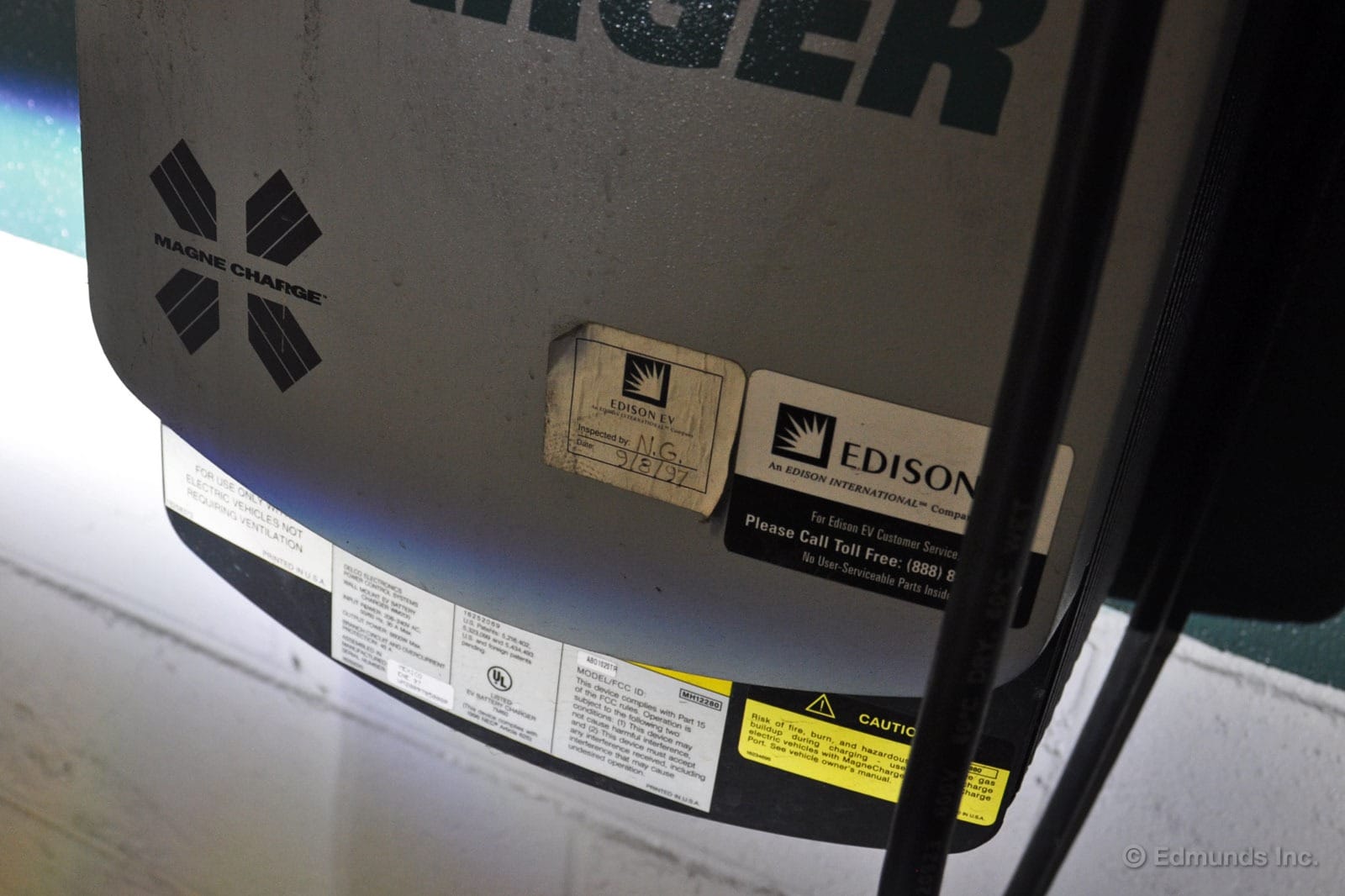
This is an old inductive charger from the first wave of electric cars in California. If I had an original Toyota RAV4 EV, I could use it. Or, I could if the charging unit was actually turned on. It appears not to be.
We still went to the farmers market. But after this disappointment, I got serious and downloaded the Plugshare app. Turns out there's pretty much no place to charge in South Pasadena. But there are many locations in Pasadena.
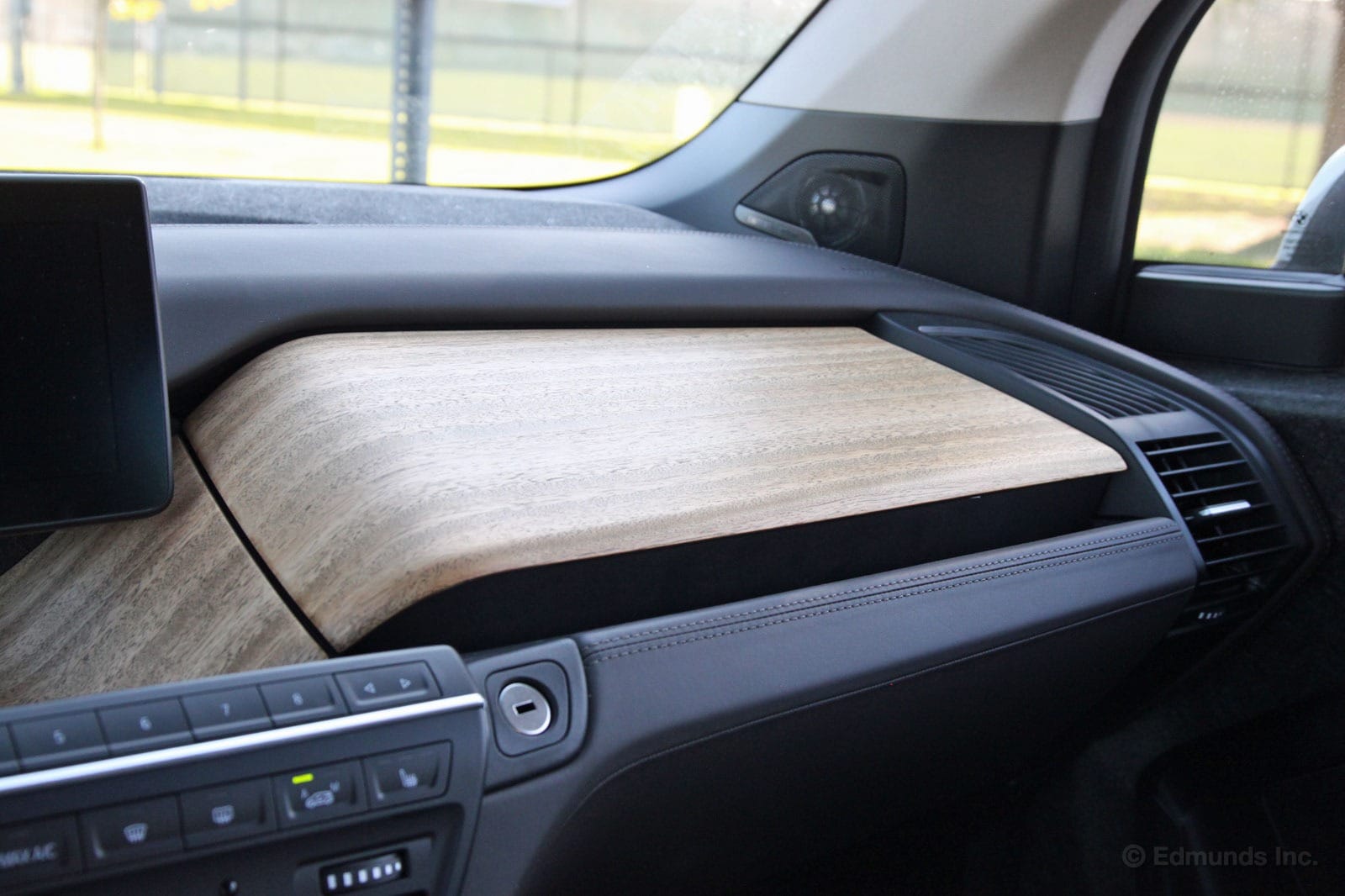
Car designers love to compare their creations to things outside the automotive world. "The instrument panel was inspired by high-end watches," is an oft-heard boast. "The cabin was influenced by high-end home furniture," is another. Usually they're stretching to make a point, but in the 2014 BMW i3 they actually have a point.
Opt for either the Giga or Terra World trim levels and you get a dashboard topped with "open pore eucalyptus wood from certified forestry." Now, I'm not really sure what that means exactly, but I do know that it's some of the nicest wood trim I've ever seen in a modern car. Even after the initial novelty factor wears off, it still looks good, as in fine furniture-good.
It's one of the many things that make the i3 unique and its one reason why I don't mind spending time in it.

Naively, I once thought electric cars would never fit my lifestyle. But that thought occurred in my pre-parent days, back when I used to drive long distances (places like Montana) on a regular basis.
Now I pretty much only go to work, the grocery store and the playground, and I'm finding our long-term 2014 BMW i3 quite practical for those activities. Its slightly elevated ride height helps me prevent back injury while getting my kid and kid accessories in and out, and its gargantuan interior storage slots make it even more endearing.
Also, it turns out there are a lot of places to charge near my home, so if I owned one, I wouldn't necessarily need to get a 240-volt charging unit installed in my garage.
Using the BMW i Remote app to find those charging locations was a fool's errand, though. I don't know if the iOS version is any good, but the Android version of this app crashed every time I tried to pinch-zoom on the map. Then I installed Plugshare. I guess I've been living under a rock, but what a great app. It works beautifully.
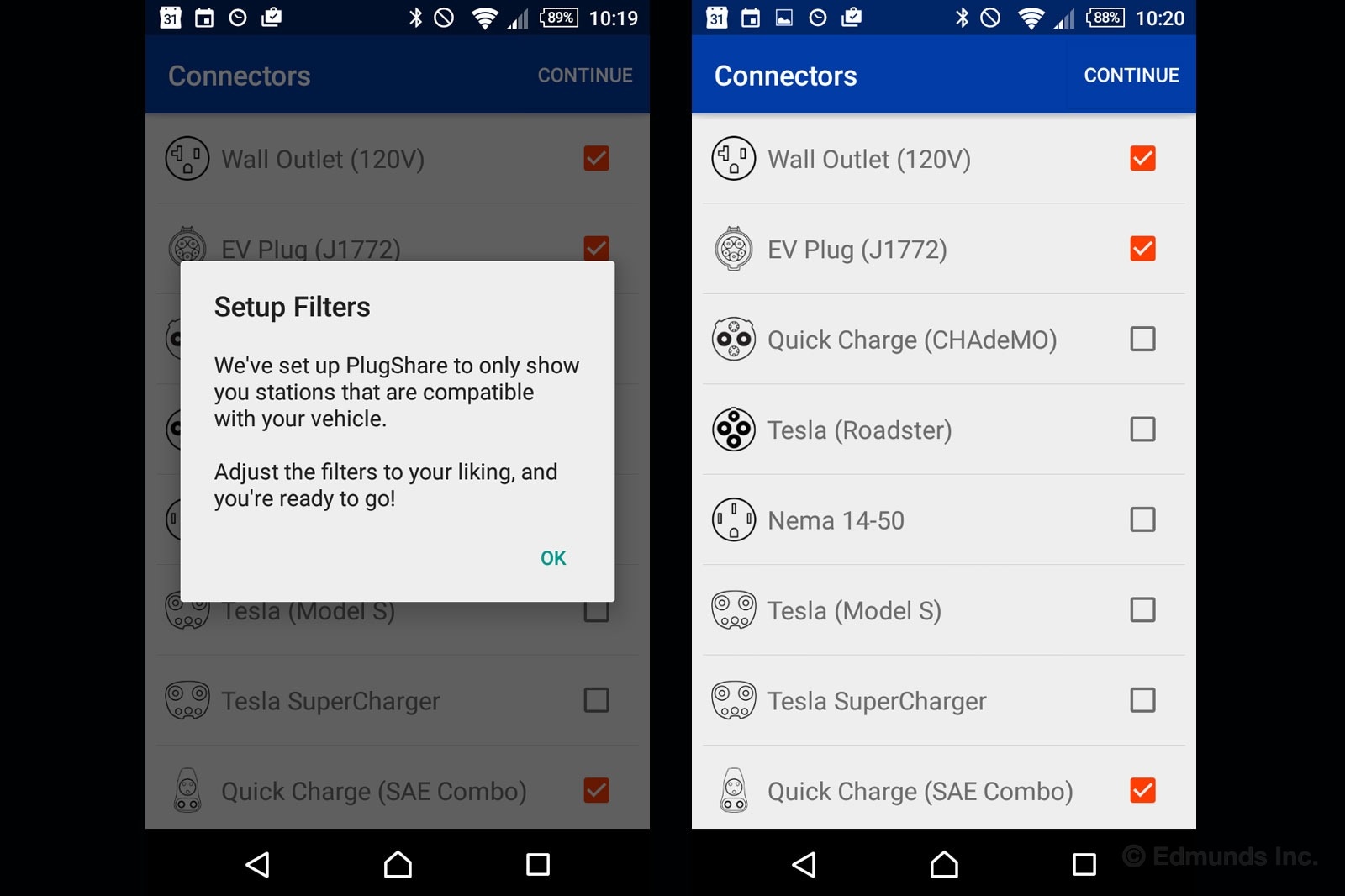
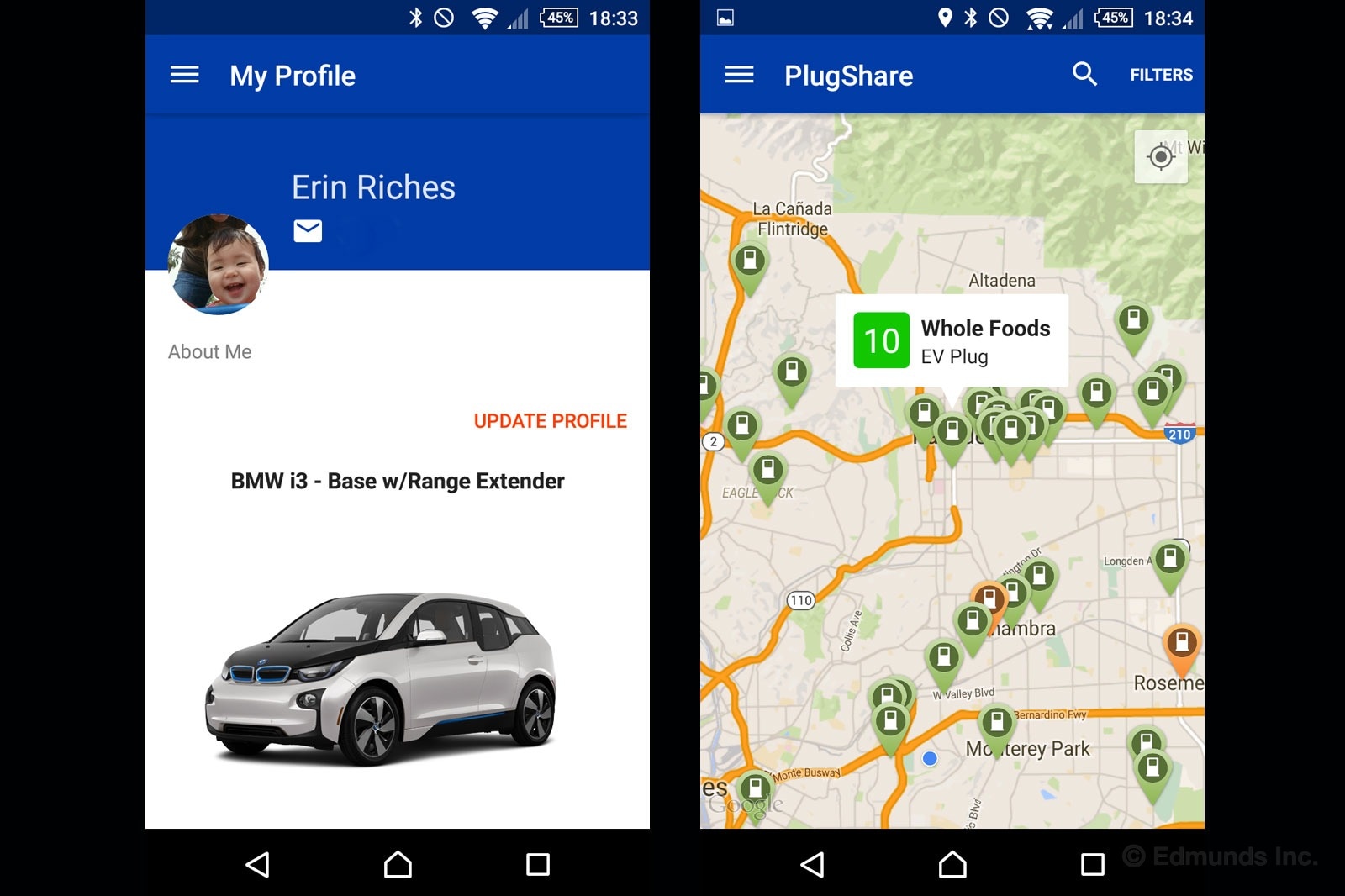
That's how I found this charging unit at Whole Foods in Pasadena. Nissan apparently pays for four 240-volt units in the store's parking garage. Unfortunately, they're part of the Volta network rather than Chargepoint, so we won't be able to track electricity usage.
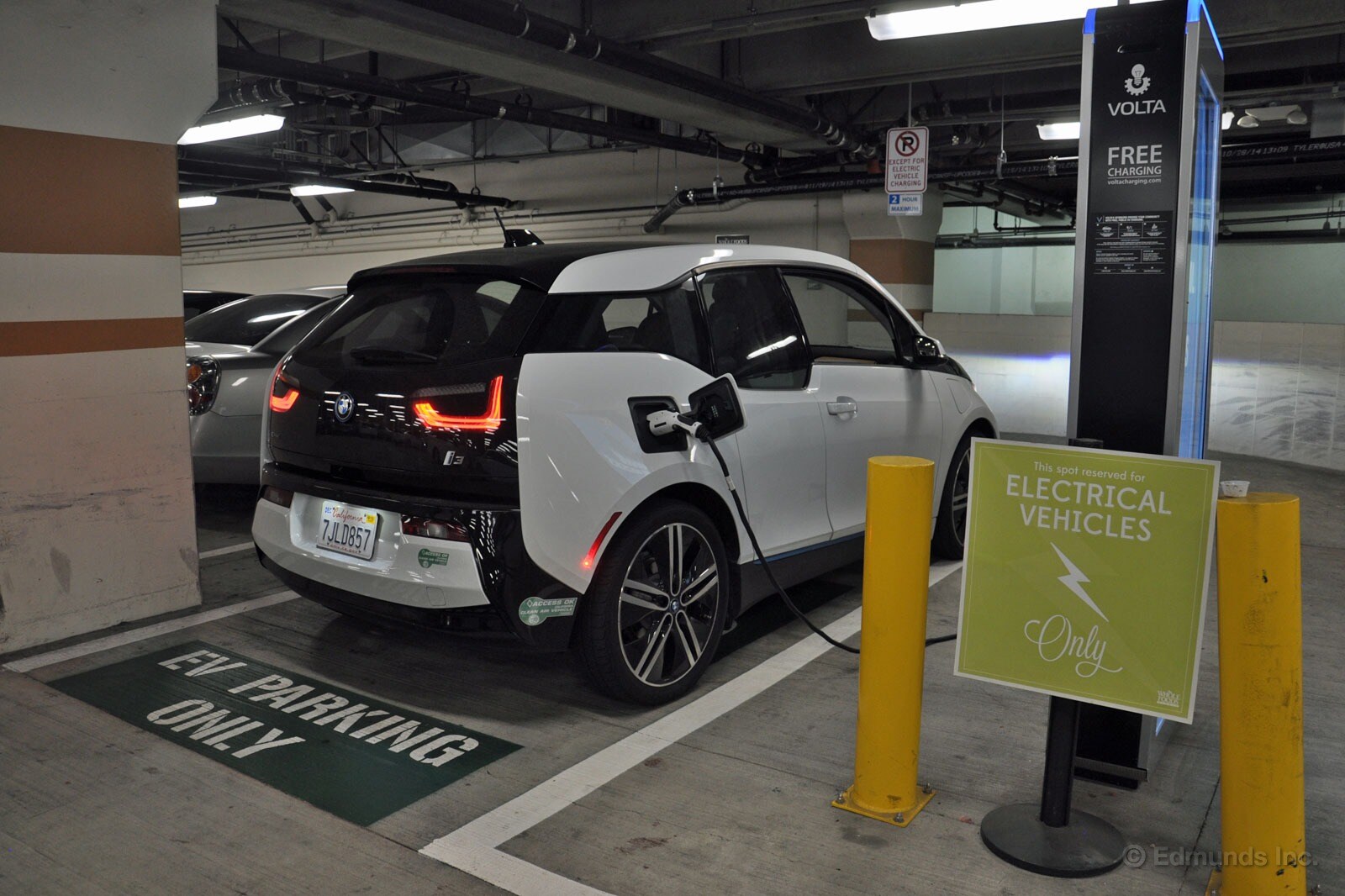
However, I did get my shopping done while the i3 charged, and the wild-caught salmon was on sale. Coincidentally, a black BMW i3 backed out of this spot right before I pulled into it. On my way into the store, I spotted a Volkswagen e-Golf charging in another spot. This is EV territory alright.
One more note on practicality: With its narrow footprint and surround-view camera system, BMW's entry-level EV is also extremely easy to street-park.
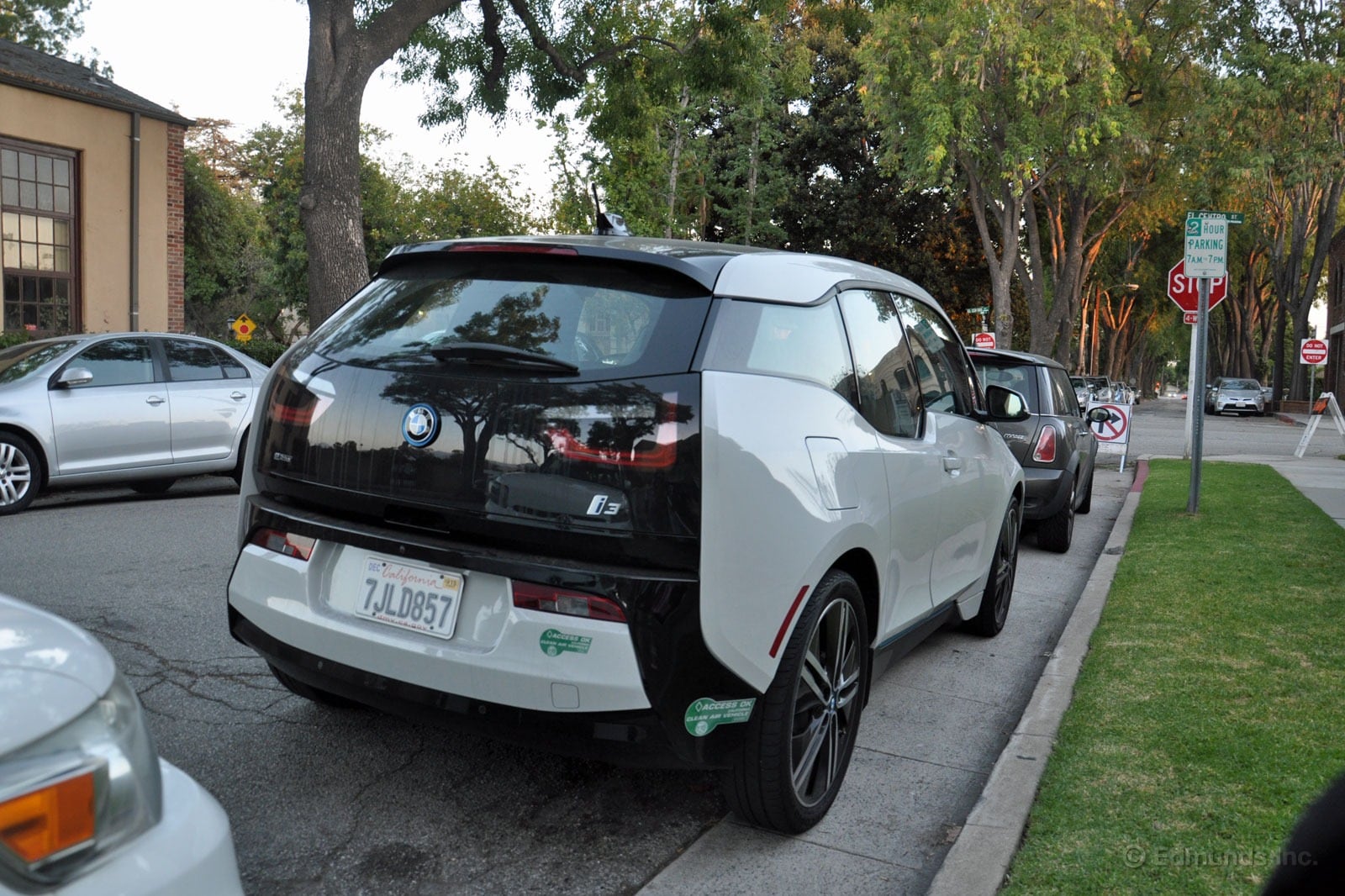
The reverse-opening rear doors are a slight disadvantage when unloading passengers from the driver side on narrow streets (with two-way traffic) like this one. You have to open the front doors before you can open the rear doors, so everything sticks out farther. As a result, I got a few chilly stares while trying to get my daughter out of her car seat. It turned out we were in the thick of a mini rush hour because, gads, the nearby farmers market was about to close.
I dashed off to buy some peaches.
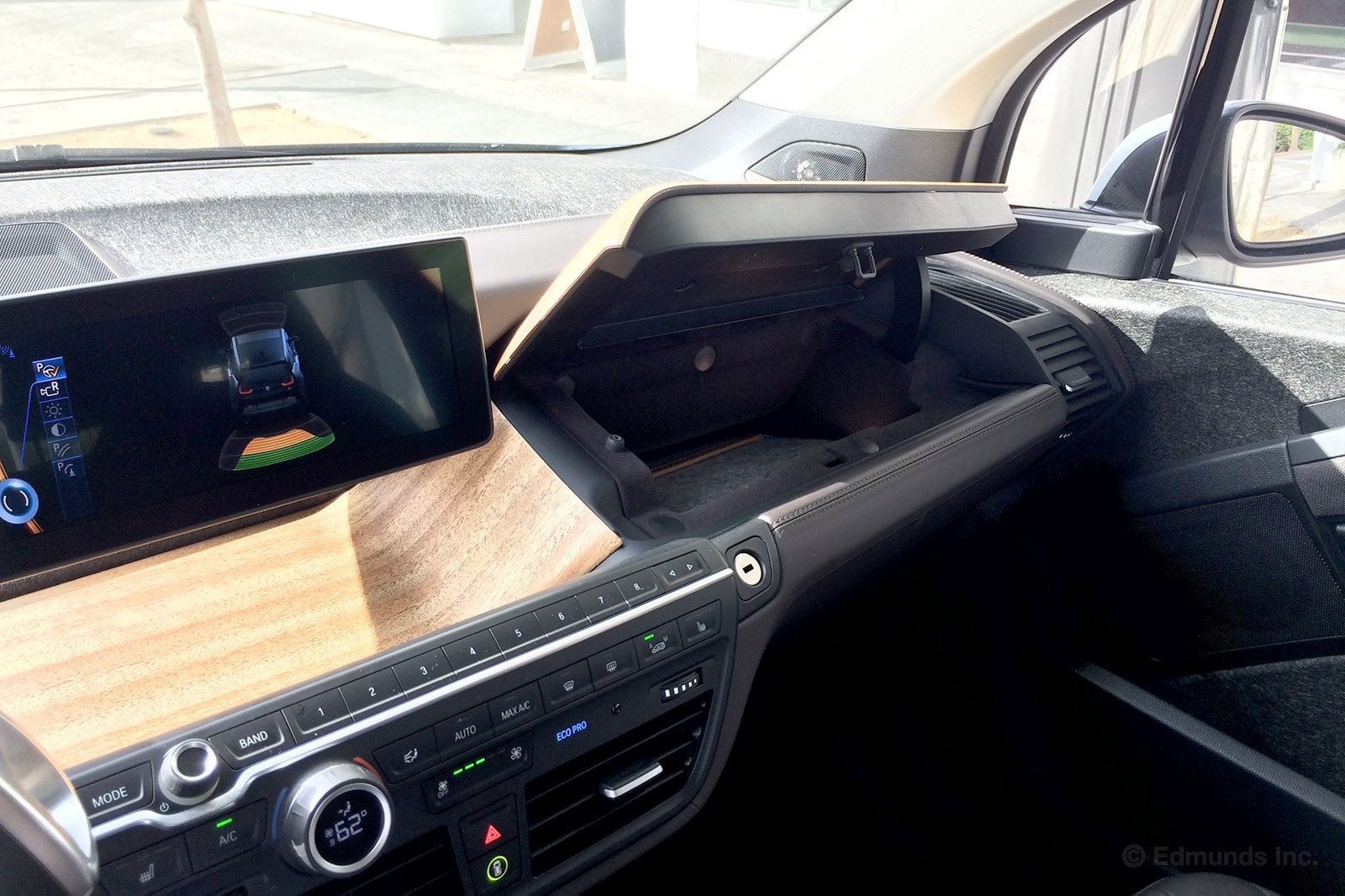
The glovebox in our long-term 2014 BMW i3 keeps opening itself. There's only one explanation: It's full of ghosts. Ghosts desperate for freedom.
Now, the reason I'm saying that it must be ghosts is pretty simple. The glovebox only pops open (three times during 60 miles) when the i3 hits a particularly nasty or off-center pothole or speedbump, and we all know how much ghosts hate be jostled.
The i3 is good at a lot of things. It's got a comfy ride, really fun steering and a punchy powertrain. It's not so good at hitting bumps, however. Not only do minor hits send a shiver up the spine, but they anger the spirit world enough that they start messing with the glovebox.
I'm going to try an exorcism next week. Or a piece of tape.
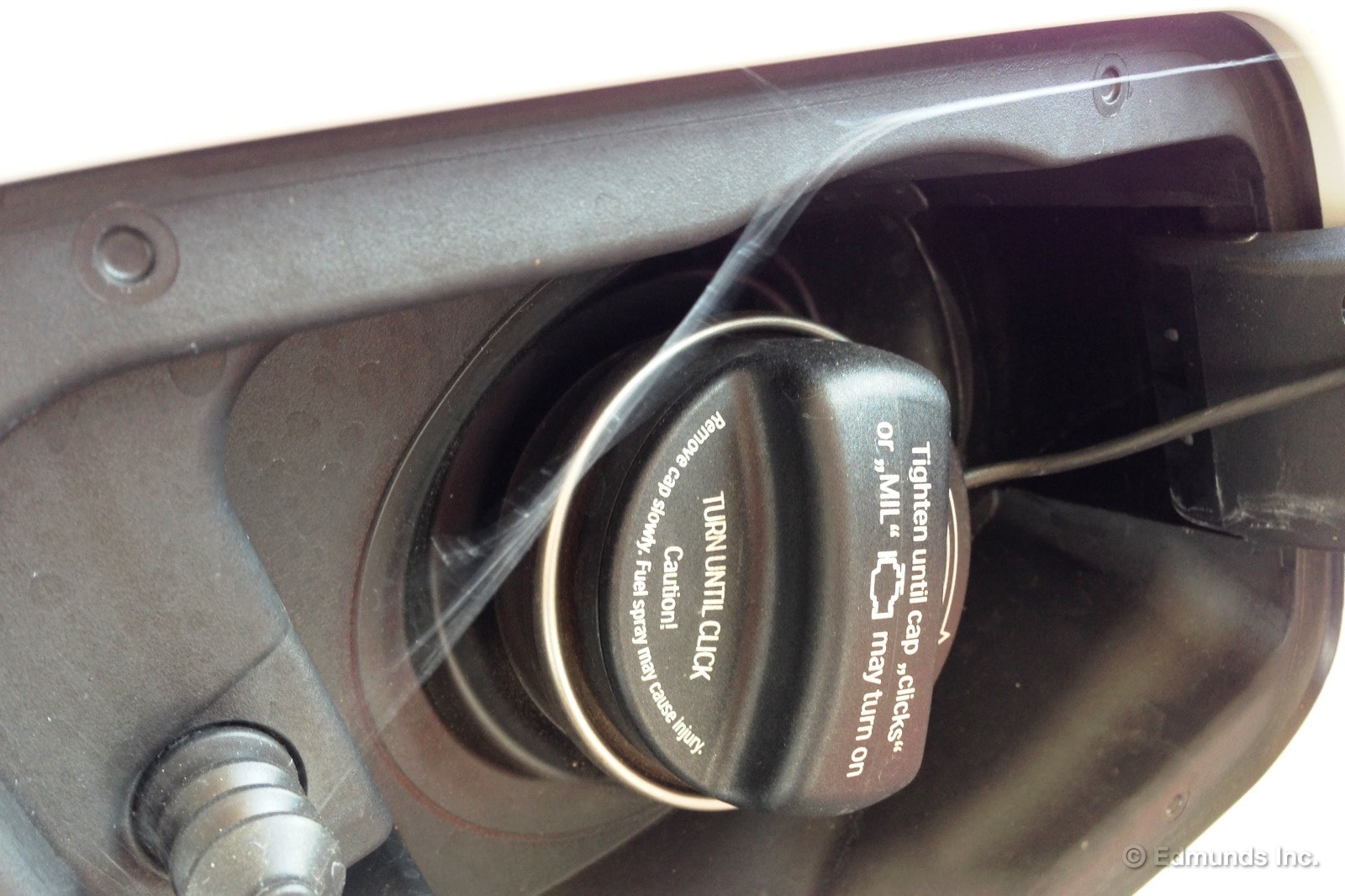
I experienced our long-term 2014 BMW i3's lighting of its gasoline engine, mid-journey, over the weekend.
For those wondering, it was 92 percent anticlimactic.
The range-extender combustion engine came to life with zero fanfare. Not a light in the cluster or a chime from the speakers. Once my speed dropped to about 50 mph, the thrum from the engine became noticeable over the freeway road noise.
It's not a pretty sound. At idle, it sounds, well, not unlike a portable generator in a closet.
It's funny; unlike the battery-only i3, the i3 with the range extender allows one to more fully utilize the electric range. So while the battery-only i3 may have more range on paper, it's far less likely that an owner will actually explore the depths of that range out of fear that they'll be stranded.
With the range extender, you can milk every last meter out of the electric range with no concern whatsoever. It's ~62 mile range (before the engine needs to be started) is more likely to be fully utilized.
Depleted of battery-only range, I drove our i3 until the gas engine range dwindled to about nine miles. I opened the fuel filler door and got a little chuckle out of the spider web strands you see in the lead photo.
I filled the tank to its brim.

Yep, this tank's total capacity really is smaller than the amount of fuel you have in a conventional car when its "low fuel" light illuminates.

Hopping into our long-term 2014 BMW i3 after someone else has been driving it is always a bit of an adventure. Did they plug it in? When? Did they remember to tap the card so the charging actually works? Am I going to be able to make it home without that silly gas engine?
So while I was expecting something to happen, this wasn't even on my radar.
I hopped in, pressed the start button and got this warning: "Battery discharging while stopped: Start engine. If fault persists, consult service center." (There's also a funny little navigation/locator thing wondering if we're still in Los Angeles, but that's not the point)
At the time, the range indicator read normal. It was full and had 62 miles of range which quickly shot to 68 miles once I started driving. I drove home, parked and crossed my fingers that all of the electrons would stay in their cages overnight. Or that they wouldn't; that'd make a nifty blog post.
Unfortunately (fortunately?) the next morning came and the car had four miles more range than when I turned it off the night before. Go figure.
We'll keep an eye on this one, but for now the only real takeaway is that EV range estimations are still in their infancy while we've got some 100-plus years of getting it right with tanks full of liquid propellant. I'm very much looking for some consistency in 2115.
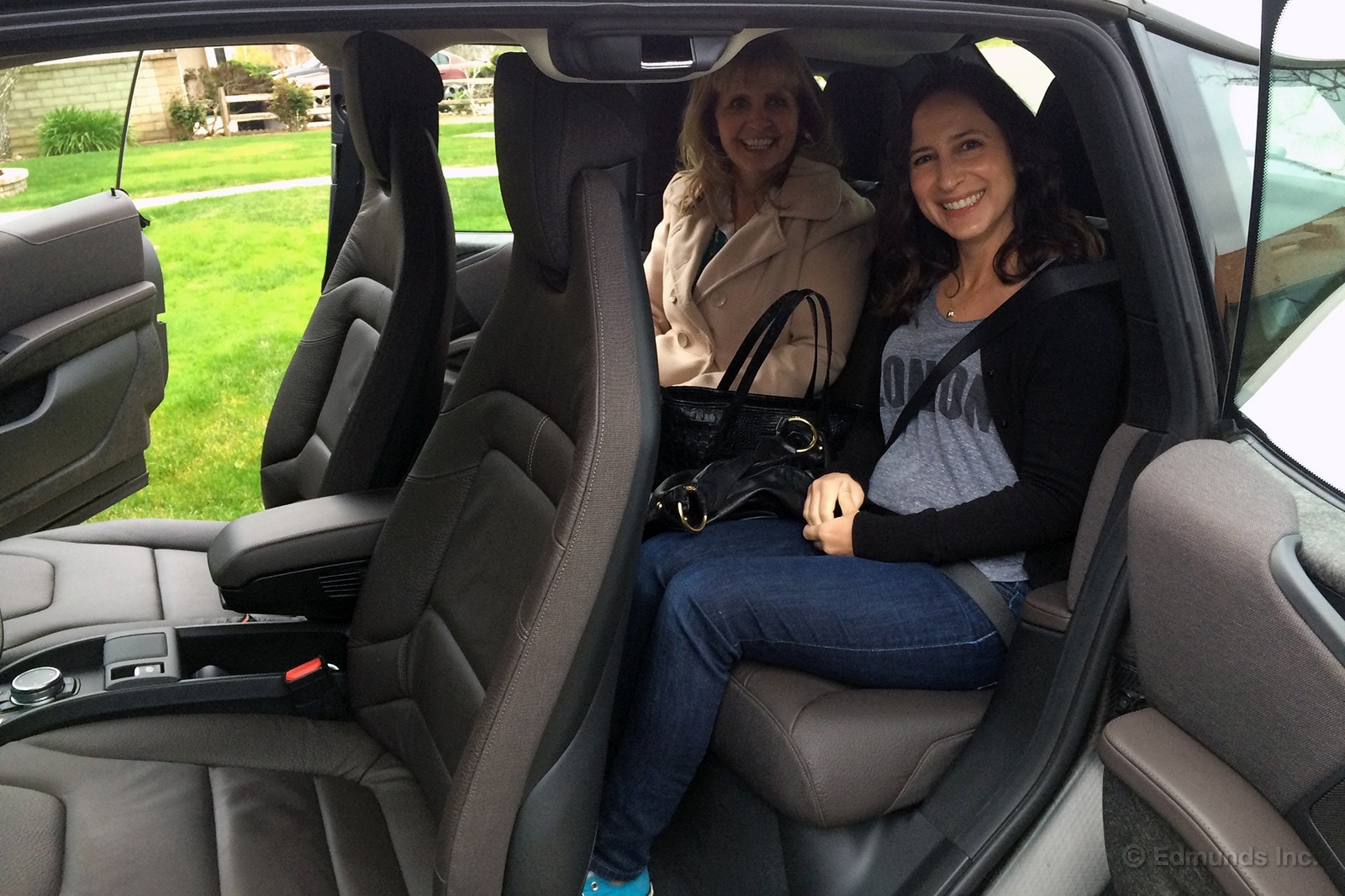
I've already noted that the 2014 BMW i3 is pretty good at transporting a pair of dogs. But what about people?
Well, as it turns out, my lovely wife and mother-in-law managed to fit quite comfortably in the i3's back seat. Said wife is admittedly rather petite, but I also didn't need to scoot the driver seat forward from its significantly rearward position. The ladies reported the seat itself was comfortable and placed at a good height.
The clamshell doors can still cause some problems in tight parking spaces (it's a bit of dance to maneuver yourself among opening and closing doors), but in general the i3's back seat goes well above and beyond the "useable in a pinch" bar that I imagine most owners will have for it.
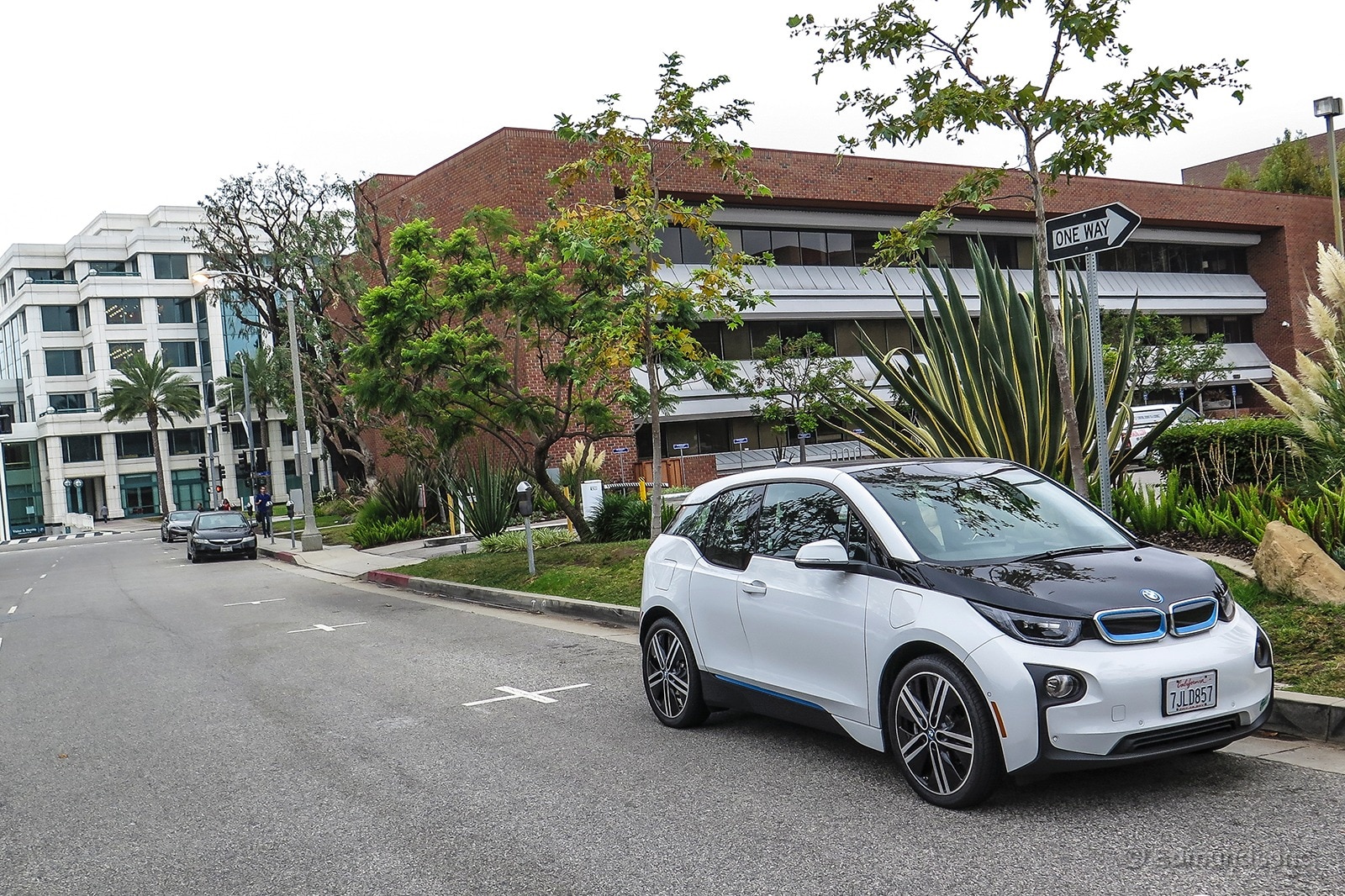
When our vehicle sign-out sheet comes around, I hardly ever have the chance to put my name on the list for our long-term 2014 BMW i3. It's a shame too, because I really like this car for daily commutes. Sure, our Viper and Mustang are great consolation prizes, but I'd much rather have this zippy electric car during rush hour.
Heavy traffic limits how much fun you can have with a V8 or V10 and the BMW just does the stop-and-go thing much better. You can park it anywhere, it has plenty of torque for exploiting the gaps in traffic and it has enough room for four adults. And even if you drive home solo, you can still use the carpool lane.
Basically, it's an expert at the city-stuff and that makes it a popular car among our editors.
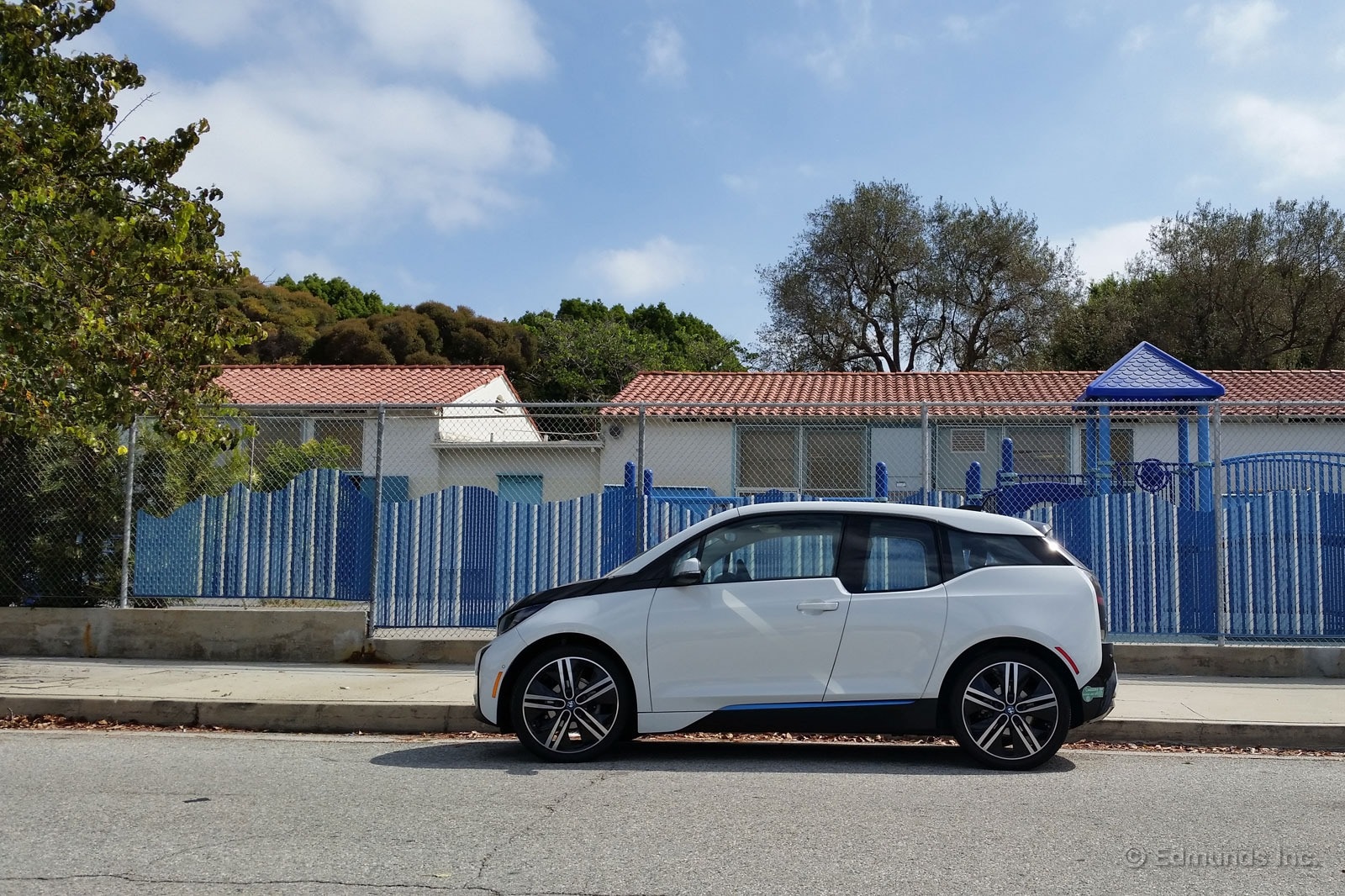
I'll admit that I haven't spent much time in our 2014 BMW i3. There's no particular reason for it other than it's often signed out before I get the chance to give it a try. I guess that says one thing about it right there.
After driving it home on my 37-mile commute, however, I might have to grab those keys more often. Not only does it have a carpool sticker so I can use the far left lane when I'm flying solo, it's also great in stop-and-go traffic thanks to its heavy regenerative braking.
You rarely have to use the brake pedal in most instances and it's even kind of fun to see how long you can go without it. I did it so much, in fact, that the i3 still had about three-quarters of its battery charge left when I got home.
Things were a little different on the drive back to the office the next morning. Traffic was much lighter so I was moving pretty fast and not letting up much. With no brake regeneration going on, the battery level went down much quicker. Still, I completed my 74-mile round trip with five miles of electric charge remaining, which is almost dead-on the i3's EPA-rated range of 81 miles.
I have no doubt I can beat my personal record the next time around. In fact, I'm actually looking forward to it.
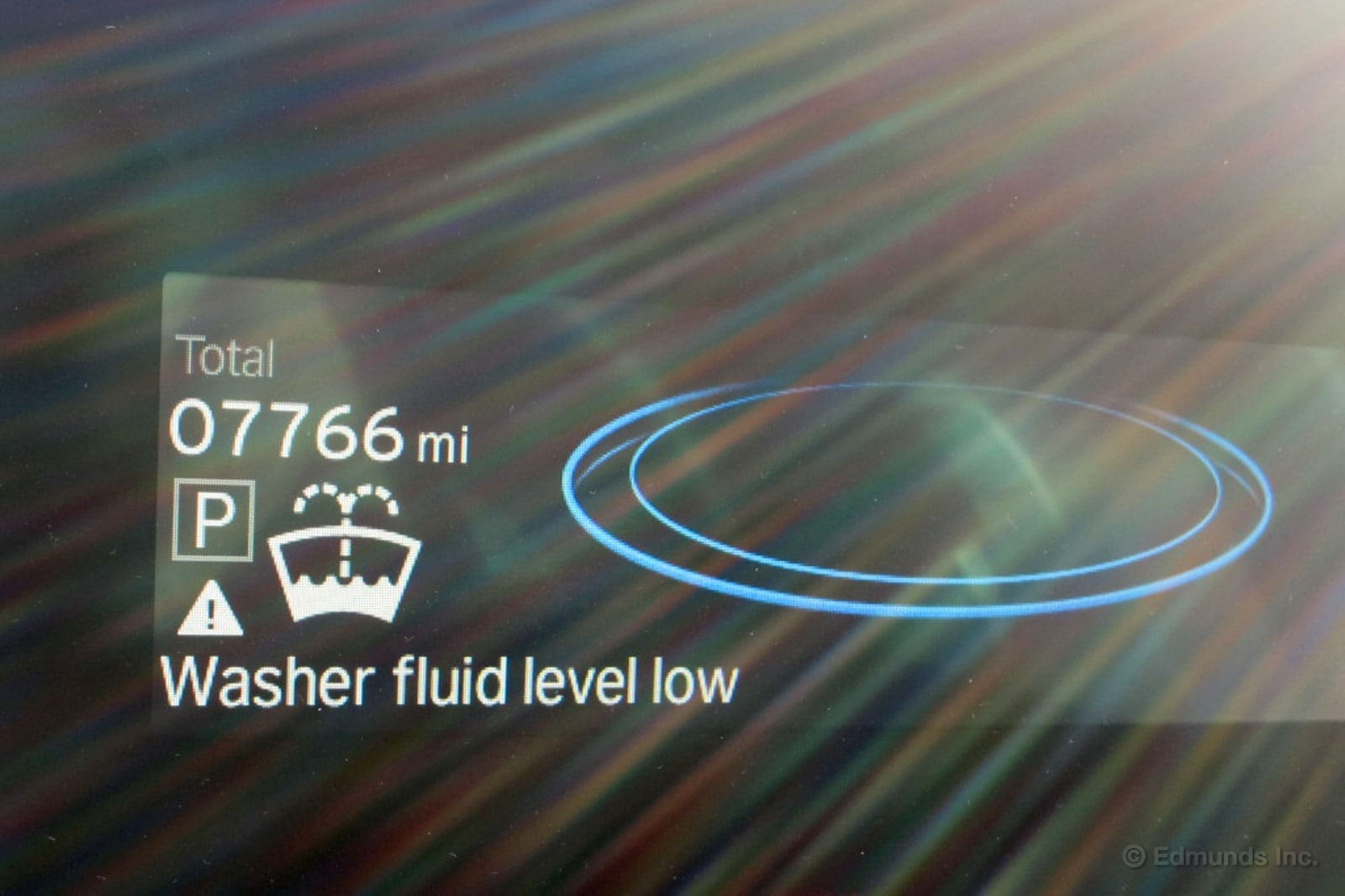
When the wiper fluid light went on in our 2014 BMW i3, I wasn't even sure where to look for the tank. The gas engine is in the back, so its dipstick is located under the cargo floor. Seems more logical that the windshield washer tank would be somewhere near the windshield under hood. Then I thought for a second, "Does this thing even have a hood to look under?"
Yes, yes it does. It's a very, very small hood, but underneath there's space to store the 110-volt charger cord and maybe a small bag. That's what happens in a tiny car that maximizes the passenger compartment over everything else.
It didn't take long to find the windshield washer fluid reservoir.
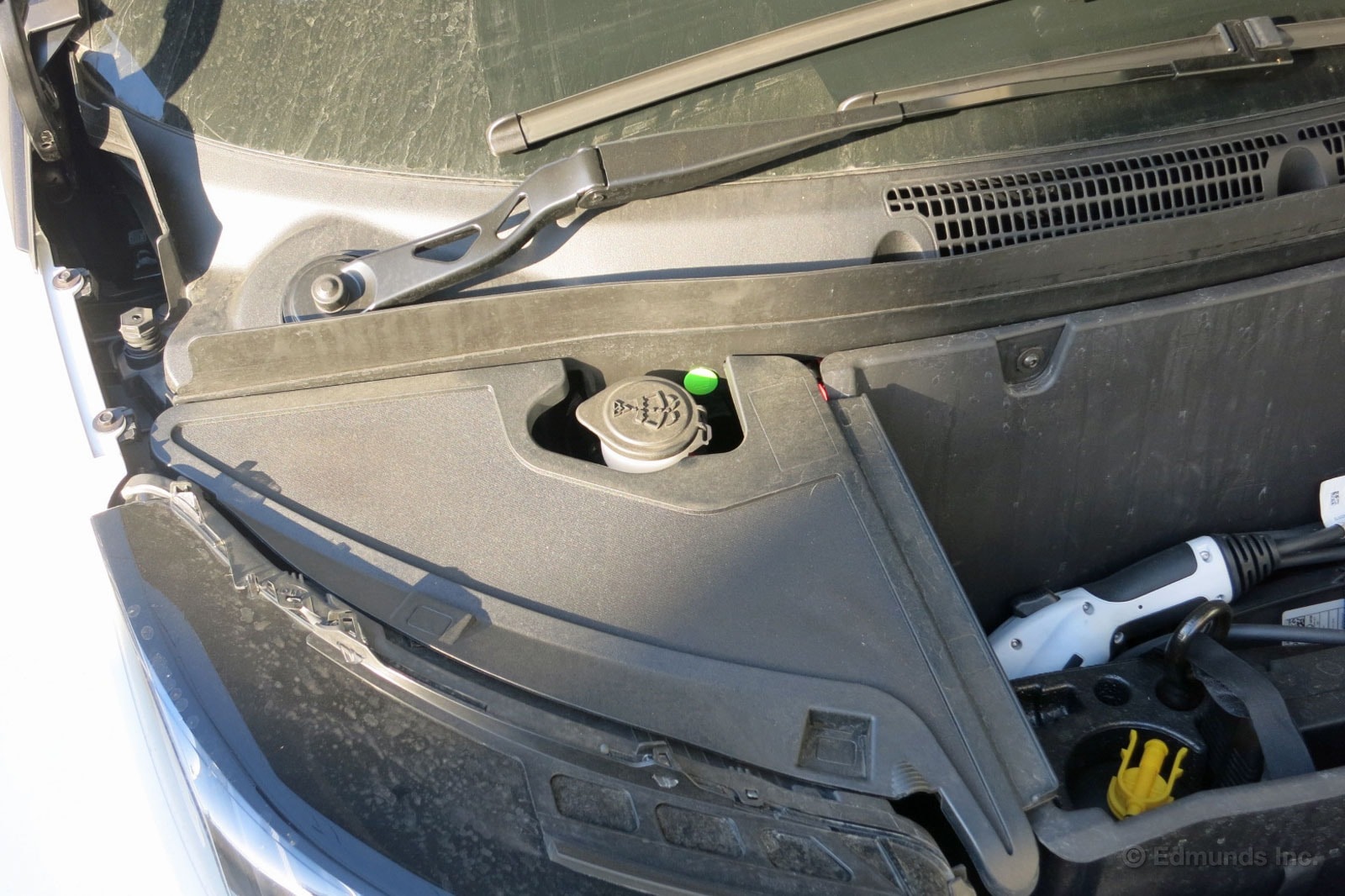
There's not much going under the hood of the i3, so the filler neck is about the only thing under there. Popped it open and added the recommended liter of fluid (everything is small on this car) and that was it. There's a rear window washer but it draws from the same tank.
Given that the gas engine rarely runs on this car, adding wiper fluid and checking the air in the tires is about the only regular maintenance you'll ever have to worry about. Not a bad selling point.
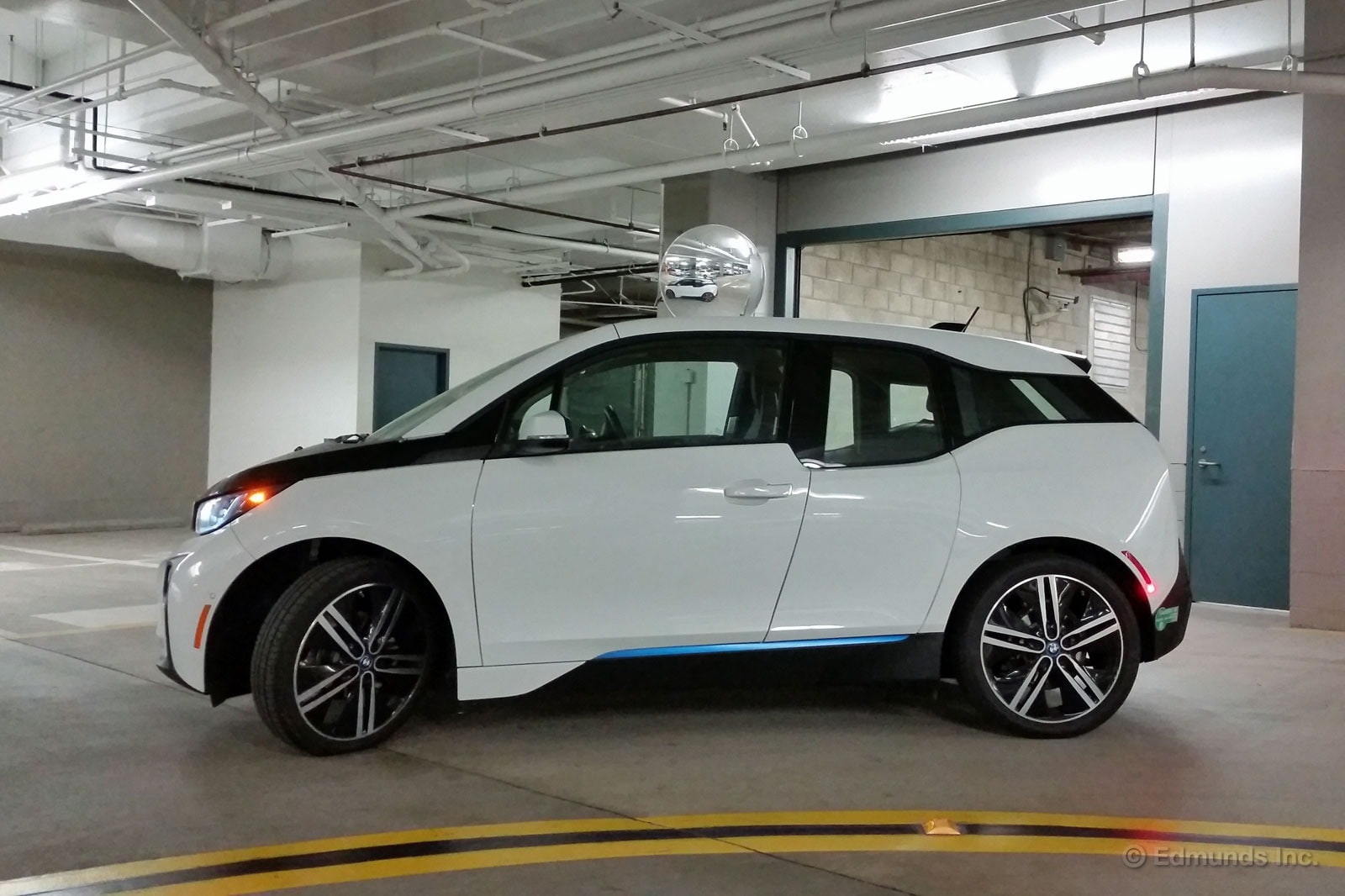
Business buzz words come and go, with last year's "synergy" becoming this year's "pivot." After spending some solid time in our long-term 2014 BMW i3, I can't help but visualize the electric i3 every time some says "pivot."
As I was pulling into our parking structure, I continued on my usual path to the bottom floor where we park all of our test cars instead of making the hard right turn to stay on the top floor where the EV chargers are located.
"Pivot!" I shouted in my head, as I spun the i3 in a tight semi-circle and headed back up the ramp. With a 32.3-foot turning circle, the BMW curls around like a sleepy cat.
For a list of other small wagons and hatchbacks that offer similar maneuverability, click here.
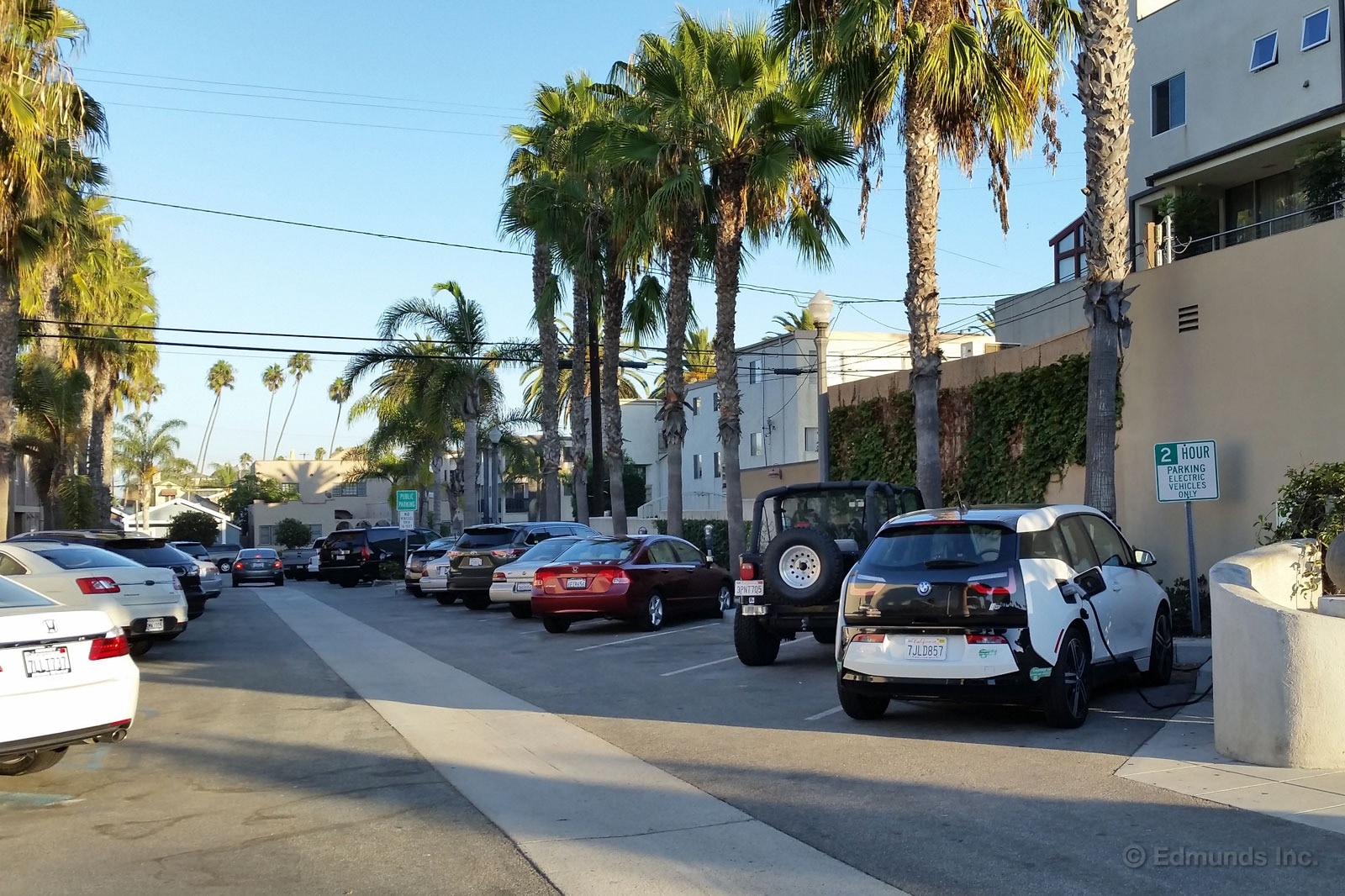
OK, I don't know that someone yanked the 2014 BMW i3's charger cord on purpose, but here's what I do know.
Late Sunday evening I parked the i3 parallel to my garage door in the alley behind my house. I plugged the 120-volt home charger into the outlet just inside my garage. I closed the garage door and went upstairs.
That's when things went awry.
A while later, my husband Ed came upstairs and said that as he was locking up for the night, he noticed the charger cord and plug lying on the garage floor. After careful inspection, he realized the third prong — the ground — was missing. Turns out, it was still stuck in the outlet.
Now, maybe someone was walking down the alley in the dark, squeezed between the i3 and the garage door, got tangled up in the cord and accidentally pulled it out of the outlet? Hmmm.
The good news: There's a ChargePoint Level 2 charger less than three-quarters of a mile from my house. On Monday, Ed and I drove the i3 over to the parking lot, plugged in the i3, and had dinner nearby. Two hours later, the BMW had acquired enough juice to make the 37-mile drive to the office the next morning.
Check back for an update after we look into repairing or replacing the 120V charger.
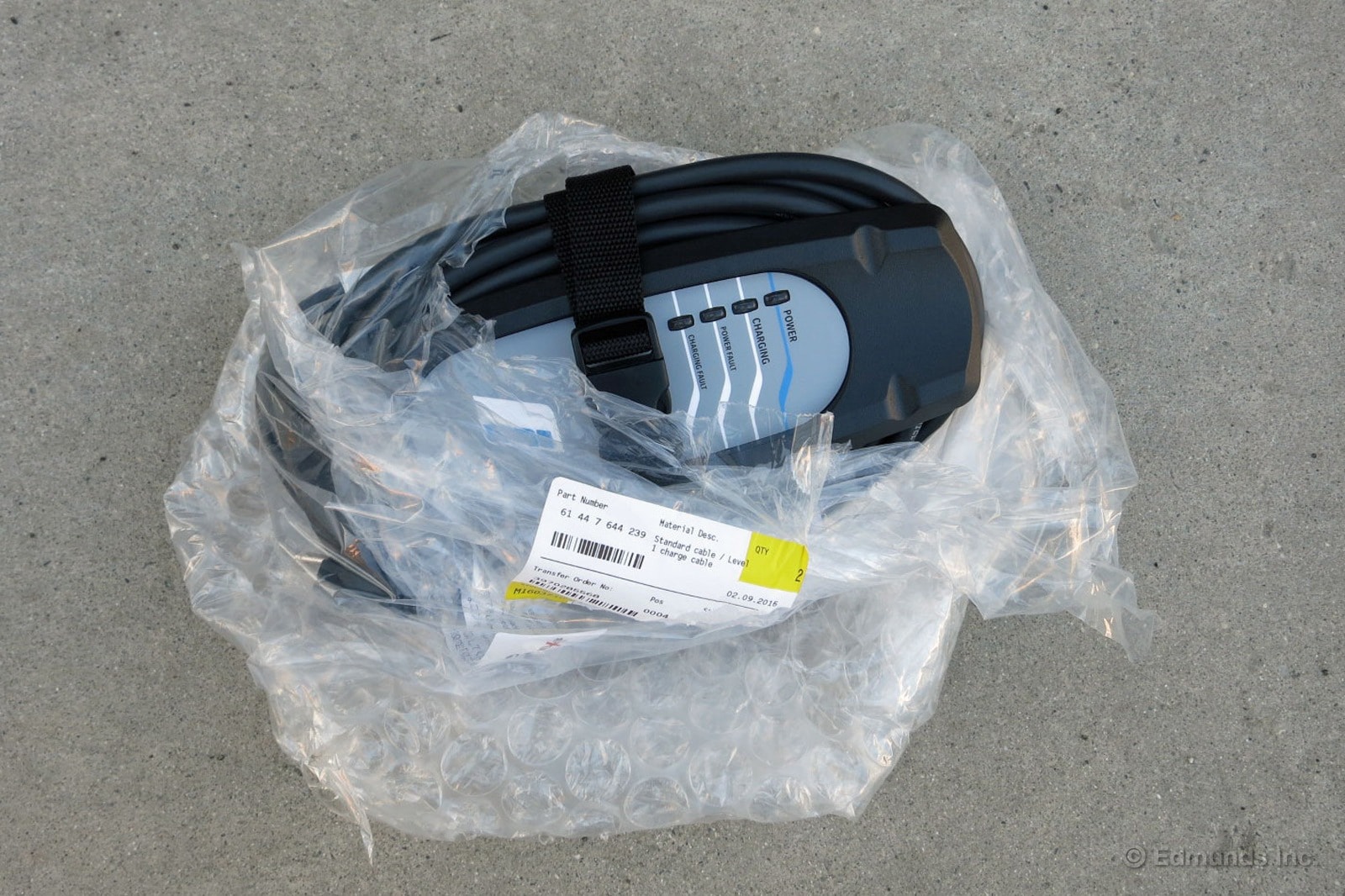
It was hot, and I needed a cool blast of A/C, so instead of calling the BMW parts department at my local Long Beach dealer, I stopped in.
"Is there any way to fix a broken plug on my BMW i3's 120-volt home charger?" I asked hopefully. "The third prong, the ground, snapped off."
"Sorry, no," replied Sergio from behind the parts counter. "You'll need a whole new cord unit. Let me see if I have one in stock."
His answer surprised me. I wasn't surprised that it wasn't repairable, but I was shocked that they might actually have one available and ready for the taking. No such luck. Sergio said he could order a new unit and it would arrive the next day.
"Yes, please," I said, fingers on my credit card.
"That'll be $595.33," he said. "Plus tax."
Yowza. I paid the cashier the full $648.91 and sadly went back out into the afternoon heat. The next day, the charger unit arrived and Mike Schmidt picked up the bubble wrapped package when he recovered our long-term Mini Cooper from the same dealership's service department.
Hey, at least there were no labor fees involved.
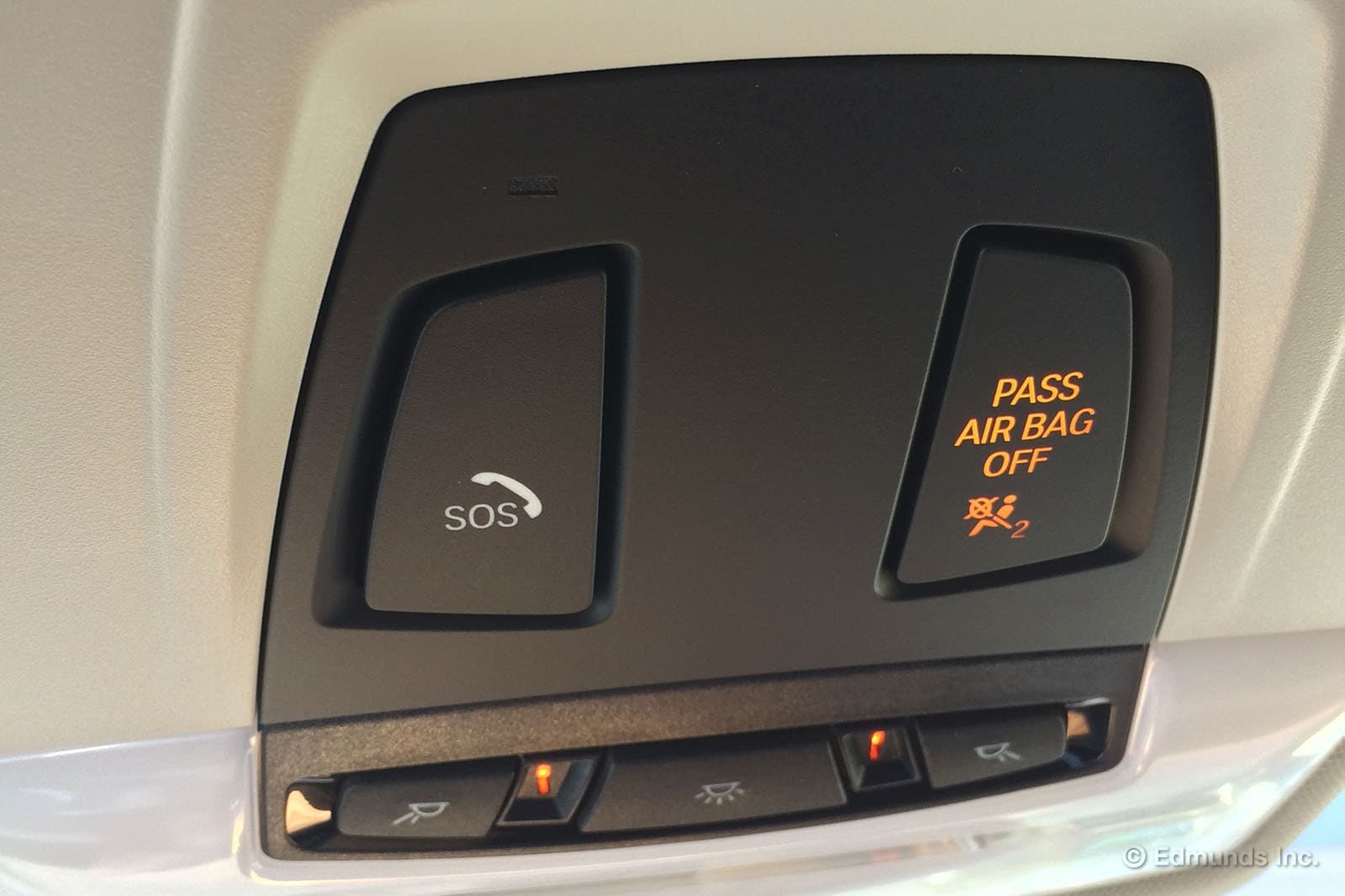
If you own a late model BMW, you may have noticed a button overhead with a phone icon and the letters "SOS" printed on it. There's also a good chance you've never pressed this button.
What does this button actually do? If you look in the BMW owner's manual, it says it should be pressed only in case of an emergency. But what constitutes an emergency? Does it have to be life-threatening or could I summon help for running out of gas — or in the case of our 2014 BMW i3, battery juice? What if the button didn't work?
I wanted answers, so I pressed it.
The first surprise was that the "SOS button" was actually a spring-loaded cover for a much more official looking button. It had a "break-glass-to-activate-ejection-seat" sort of appearance, which gave me a bit of pause.
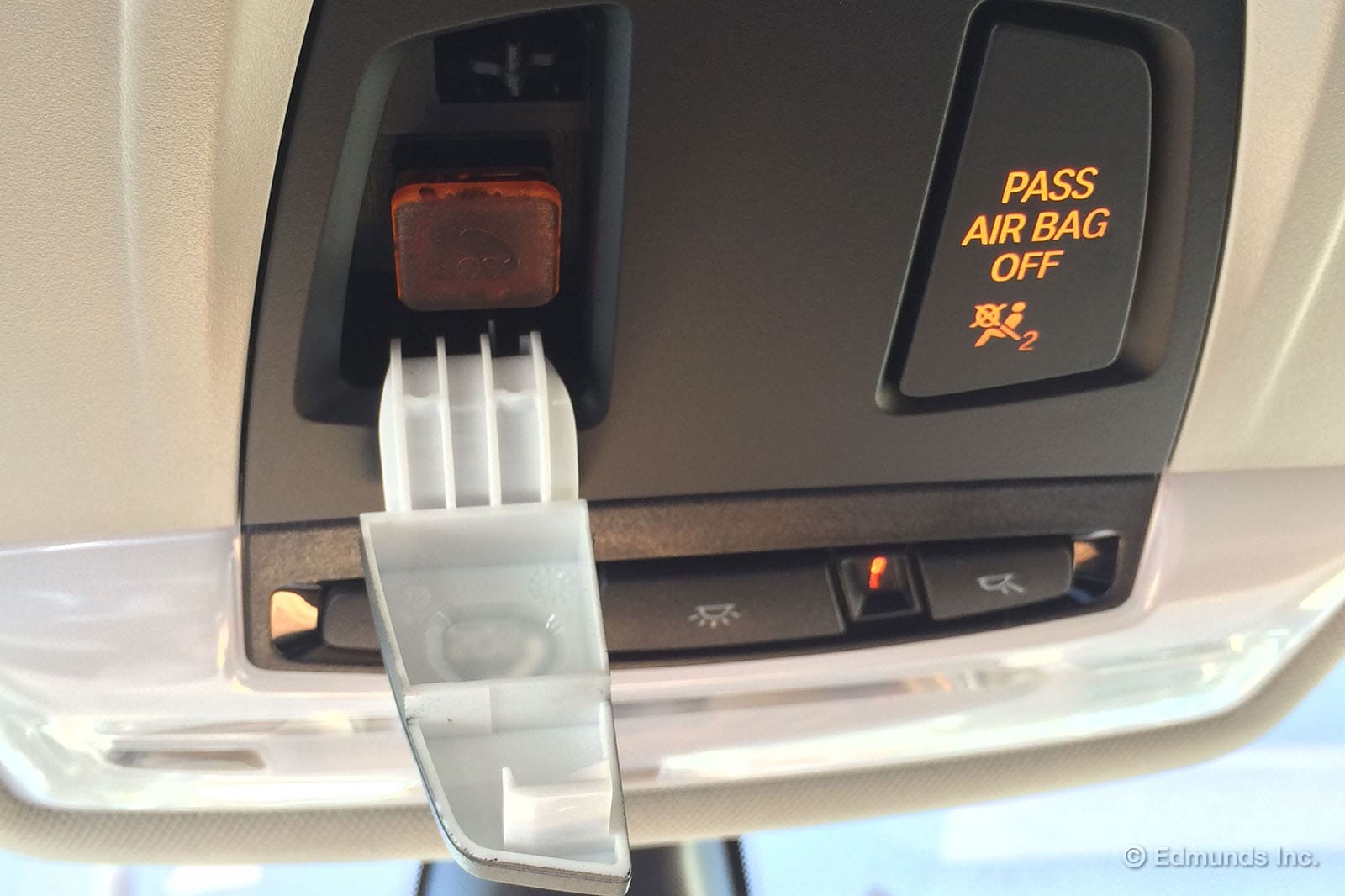
Images of SWAT teams swarming the Santa Monica DMV lot where I was parked flashed through my mind, along with the anticipation the i3 would wildly sound its horn and lights to let the cavalry know where we were. Or, even worse, there would be an irate person on the other side of the call, verbally reprimanding me for abusing BMW's SOS protocol.
I believe it was once said that courage is acting in spite of fear.
Within 40 seconds of activating the SOS function, I was connected directly to a BMW Assist operator. Like other emergency telematics systems, the call was placed using the i3's onboard cellular link, and not through the car's Bluetooth phone connection.
The operator was not only unphased by my non-emergency emergency call, but willing to explain in detail what our i3's BMW Assist services included. Depending on how your vehicle is equipped, services will vary, but below is what is included with our i3.
10 years complimentary:
- Automatic Crash Notification (your car puts out an emergency call/notification in the event of a crash)
- SOS request (call police, ambulance, road-side assistance, etc)
4 years complimentary:
- Road-side assistance
3 years complimentary:
- Remote door unlock (calling customer service, door unlocked remotely)
- Stolen vehicle locator
If you have an SOS button in your vehicle and have never pressed it out of fear or lack of curiosity, it's actually a good idea to do so to ensure that it works as intended. Ours works fine, but we can't guarantee yours isn't an ejection seat button.
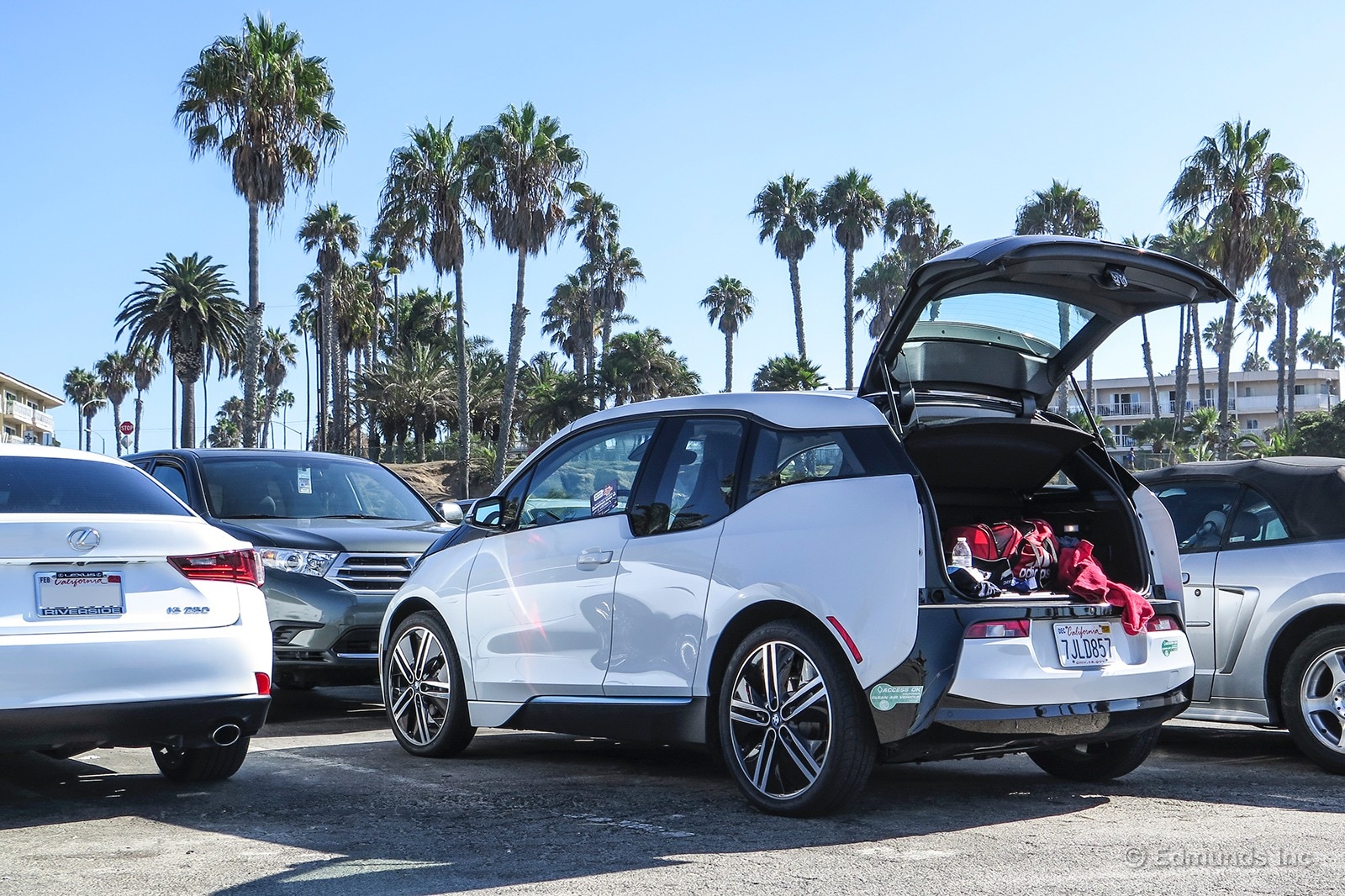
The last time I was up early to go running on a weekend, I took our long-term Jaguar F-Type to the beach and it made an excellent companion. This time around, I had a car with less than half the horsepower and much less noise. Even with those downsides though (subjective, I know), our long-term 2014 BMW i3 made an excellent running buddy too.
For waking up early, the Jaguar is probably the best alternative to coffee with four wheels, but the i3 used a different strategy and helped me ease in to the early-morning run.
I'm normally stressed out before big events, wondering if I'll make it on time, what parking will be like, and whether or not I brought enough Gu packets. Not in the i3. It was quick to get me there, but quiet and peaceful along the way. It had plenty of range to get me home (the race was only a few miles from my house) and it was definitely more comfortable.
Plus, I doubt the electric BMW woke up any of my neighbors.
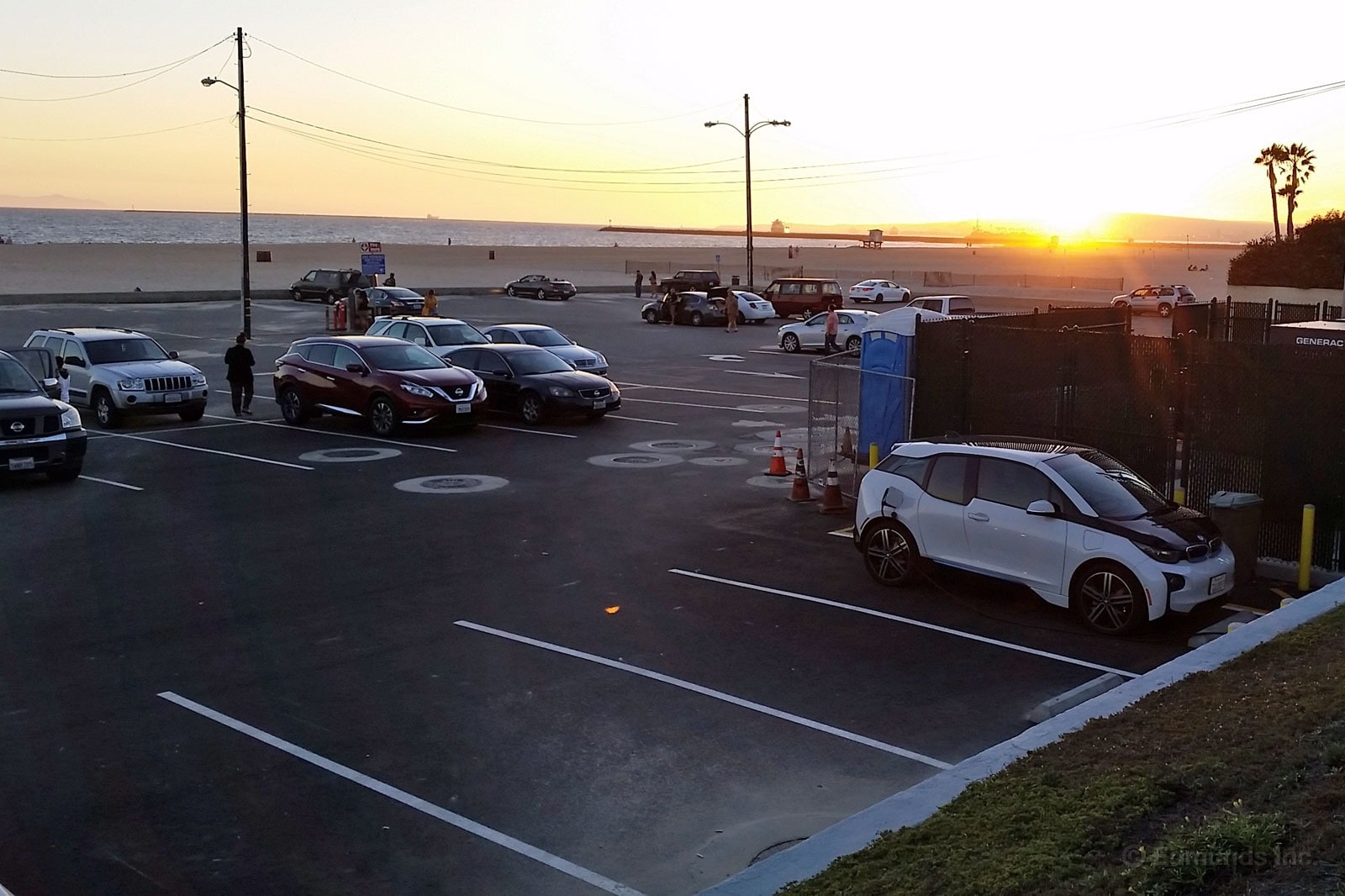
The local gas company was repairing a line behind our house last week, which blocked access to our alley, and subsequently our garage.
Needing some juice for the 2014 BMW i3, I pulled up the ChargePoint map to see if the Level 2 charger a half-mile from my house was available. It was, so I immediately hopped in the i3 and headed over.
D'oh! Not five minutes had passed and a black i3 had already sniped my plug.
Using my phone, I looked for the next closest charger.
Turns out, there is a second Level 2 in my small beach town, not two-tenths of a mile farther, in a public lot down on the beach.
It wasn't exactly fragrant as I plugged-in next to the temporary construction site and its port-a-john. But turning southwest toward the sand and sunset significantly improved the experience.

Call them delusional, but most people think they're good at parallel parking. So good, in fact, that they say they don't need help from autonomous parking systems in cars, such as the one in our 2014 BMW i3, thank you very much.
Those are the findings of a new survey by AAA. According to the auto club, nearly 80 percent of American drivers "are confident in their parallel parking abilities." And just one in four people would trust the technology to park their cars.
AAA's testing, however, found that tech outperformed unassisted drivers in four areas: curb strikes, the number of maneuvers needed, speed and accuracy. AAA tested the 2015 Lincoln MKC, 2015 Mercedes-Benz ML400 4Matic, 2015 Cadillac CTS-V Sport, 2015 Jeep Cherokee Limited and a 2015 BMW i3. In the AAA test, humans were allowed to use a back-up camera, but that was the only tech permitted.
It's clear that we are just not up to the task unaided, people.
Cars using the autonomous systems experienced 81 percent fewer curb strikes and maneuvered into place with 47 percent fewer moves, with some systems completing the task in as little as one maneuver, AAA reports. Self-parking systems were able to park a vehicle 10 percent faster and 37 percent closer to the curb.
In case you haven't seen it, here's a video of our car going through its self-parking paces.
AAA did have one criticism of the self-parking systems: They get the cars too close to the curb, with some leaving as little as a half-inch buffer. That leaves wheels and tires "vulnerable to scratches and costly repairs," as some of us know all too well.
AAA recommends that drivers leave 6 to 8 inches between the car and the curb when parking. The club urged automakers to tweak their systems to leave more distance between curb and wheel.
So in the mankind vs. machine parallel-parking face-off, whom do you trust more: yourself or your autonomous vehicular overlord?
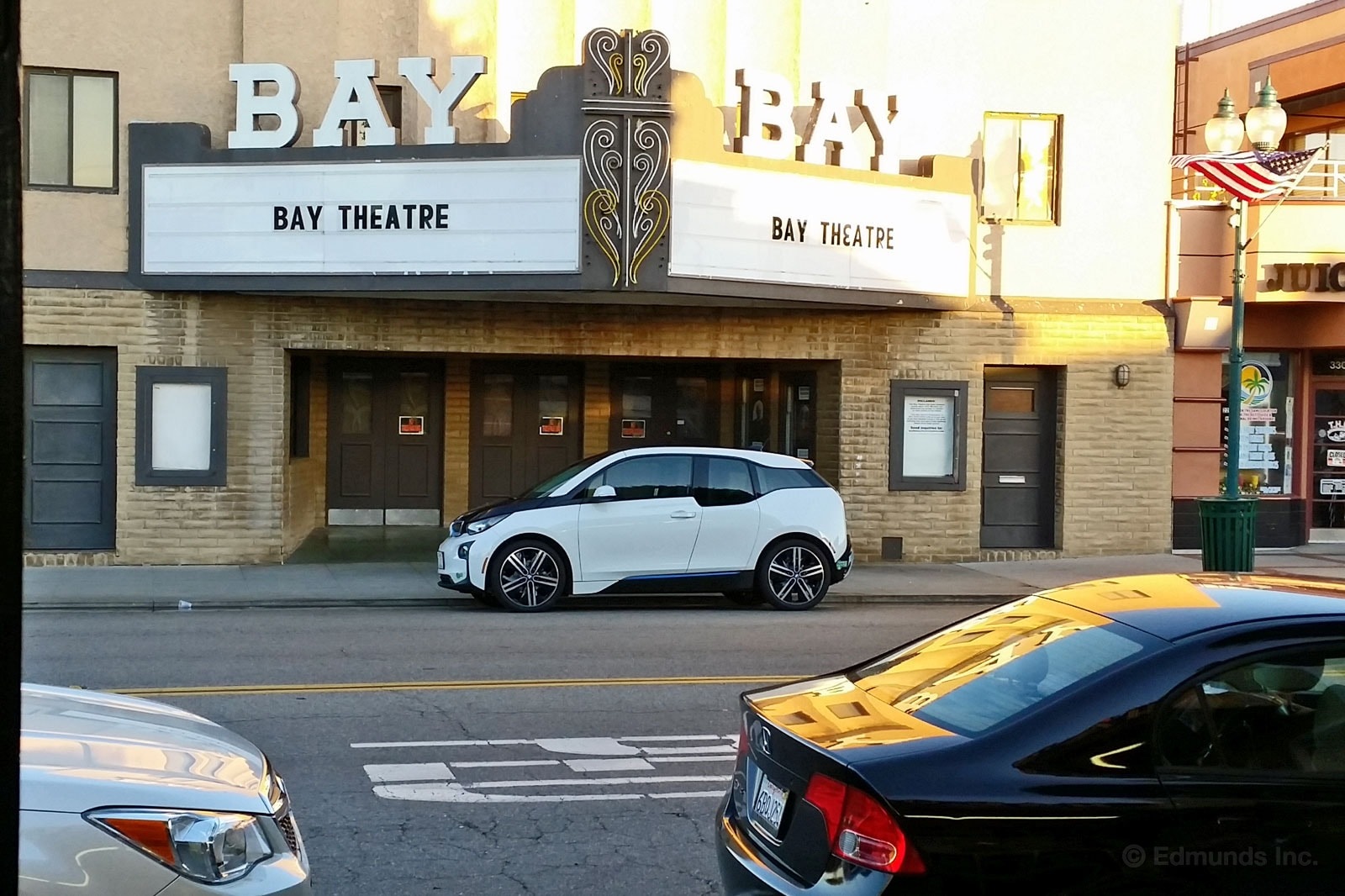
It would be easy to dismiss a car like the 2014 BMW i3 as nothing more than a goofy-looking science experiment. It looks hopelessly awkward from nearly every angle, and trying to explain its immense breadth of technology to a curious bystander is futile.
After driving it, however, the i3 grows on you quickly.
For starters, it drives well. It accelerates up to highway speeds quickly and the suspension feels sufficiently refined over L.A's buckled concrete freeways. You're aware that the tires are small and narrow, but the car doesn't feel frail.
I also like the brakes. They have a high level of regeneration so you can drive the i3 in heavy traffic without ever using the actual brake pedal. It sounds insignificant, but once you get used to the feel it's kind of fun.
Finally, the interior feels huge. Between the glass area and the dashboard design, the i3 gives you the impression that it's much bigger on the outside. It's a nice feeling when you're surrounded in traffic.
I didn't expect to like the i3, but the more seat time I get, the more I appreciate its ingenious design.
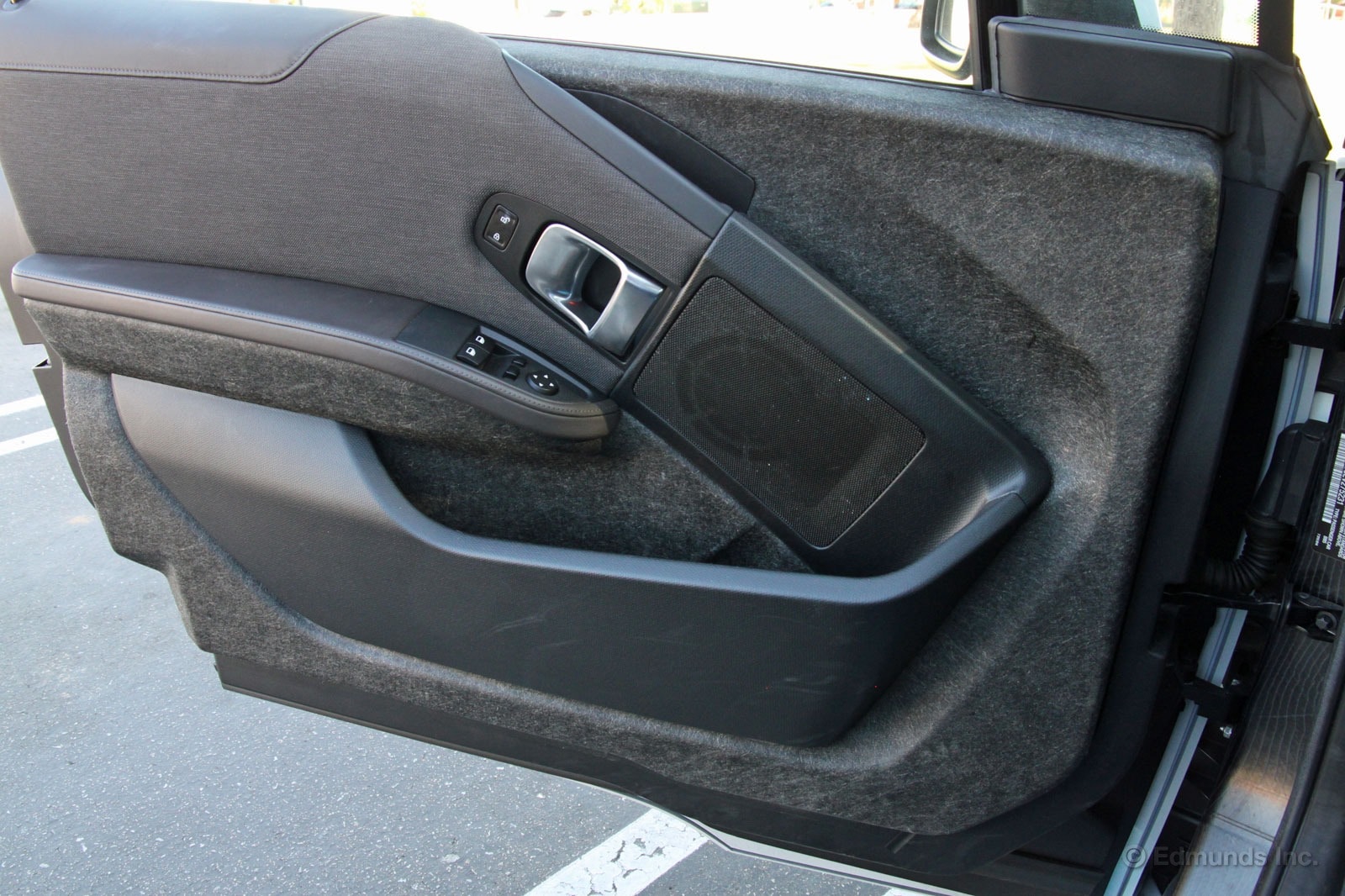
After reading Riswick's post about the poor door grab on our long-term BMW M235i, it reminded me of a similar problem on our 2014 BMW i3. It doesn't even have a handle, just an angle cove to use as a door grab.
As you can see, it's not exactly in an ideal location. When you swing open a car door, where do you naturally grab to pull it closed? Probably not somewhere on the front half of it.
On the M235i you can at least grab the handle from somewhere on the middle of the door. On the i3, the grab handle is up much higher, making it all the more awkward.
Ultimately, the door is very light so the poor design of the handle isn't a major issue. But it's still something that annoys me every time I go to pull the door closed. That's not good design.
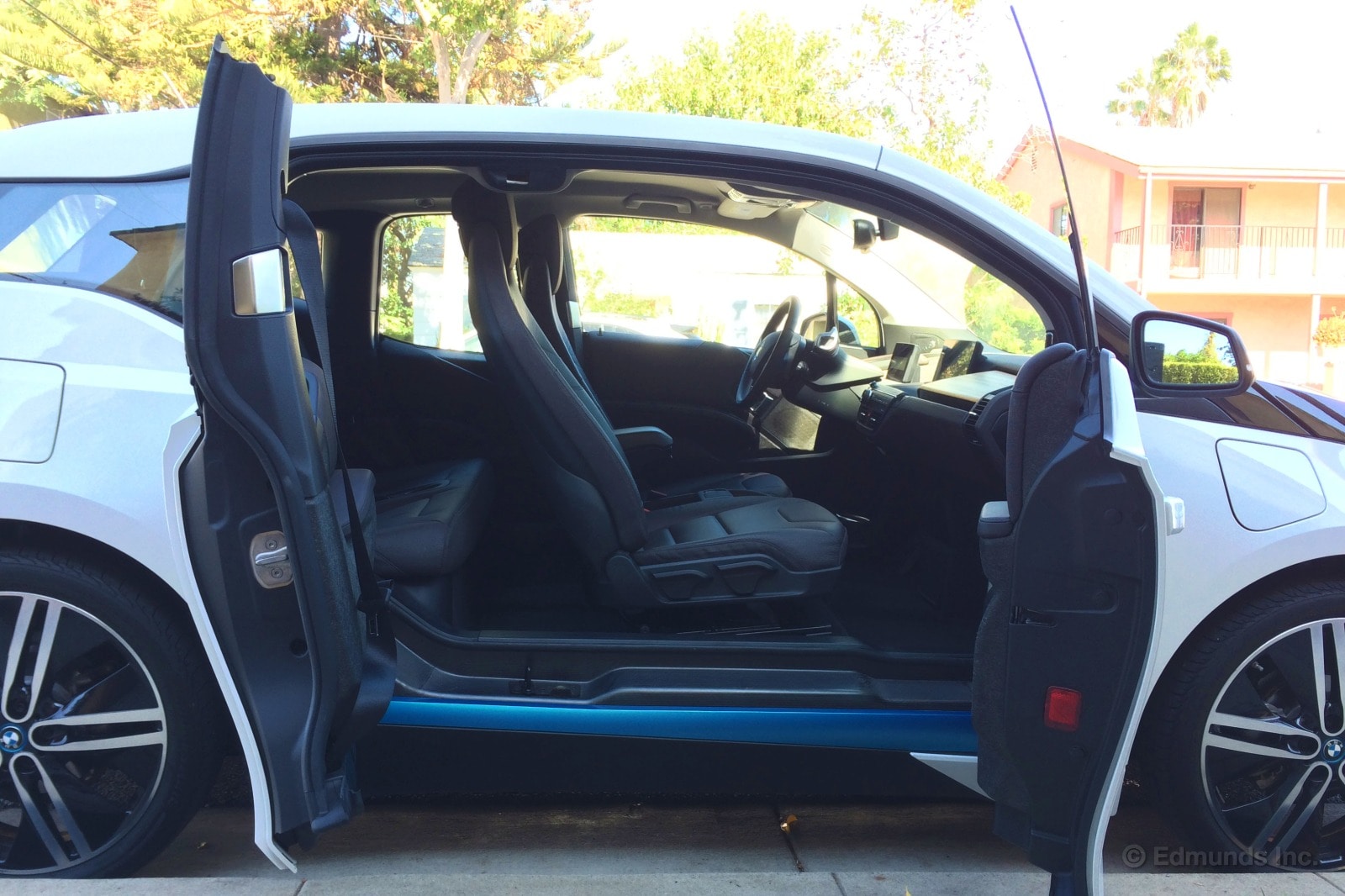
The term "suicide door", according to Wikipedia and its sources, became popular slang for a vehicle door with rear hinges because of the higher risk of opening at speed, either by accident or by a member of the mob. This becomes an issue for the person sitting closest to that door.
If you tried to open a front-hinged door at speed — don't try to — you'd find it very difficult because of the airflow pushing against it. A rear-hinged door that's opened while moving operates more like a drag chute, with a degree of violence that's proportional to vehicle speed.
Our 2014 BMW i3 doors may not be dangerous, but they still have an inherent disadvantage.
A few editors, like James Riswick, have previously reported that suicide doors are an issue if you're parked next to something (e.g. a car, a wall, a rhinoceros, etc.) and have rear passenger that would like to be let out. BMW anti-mobster technology requires that the front-hinged front door be opened before the rear-hinged rear door latch can be operated. This promotes a natural barricade situation when the doors are open, leaving the driver and rear passenger to coordinate a rather ungraceful exit strategy.
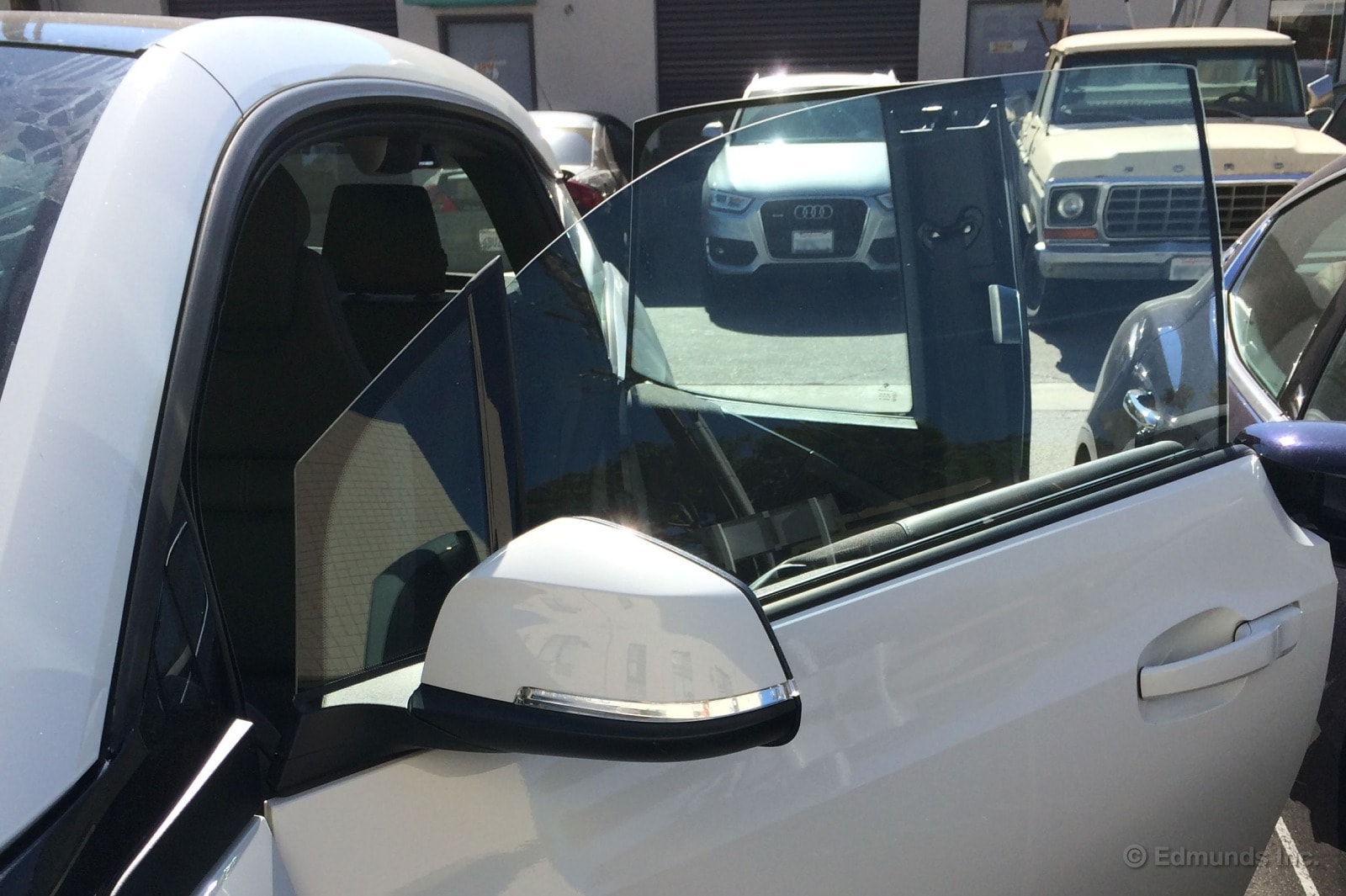
This is the only real downside to the design, now that safety isn't an issue. On the plus side, the absence of a B-pillar behind the front seats really opens up the cabin and allows maximum access space to the back row.
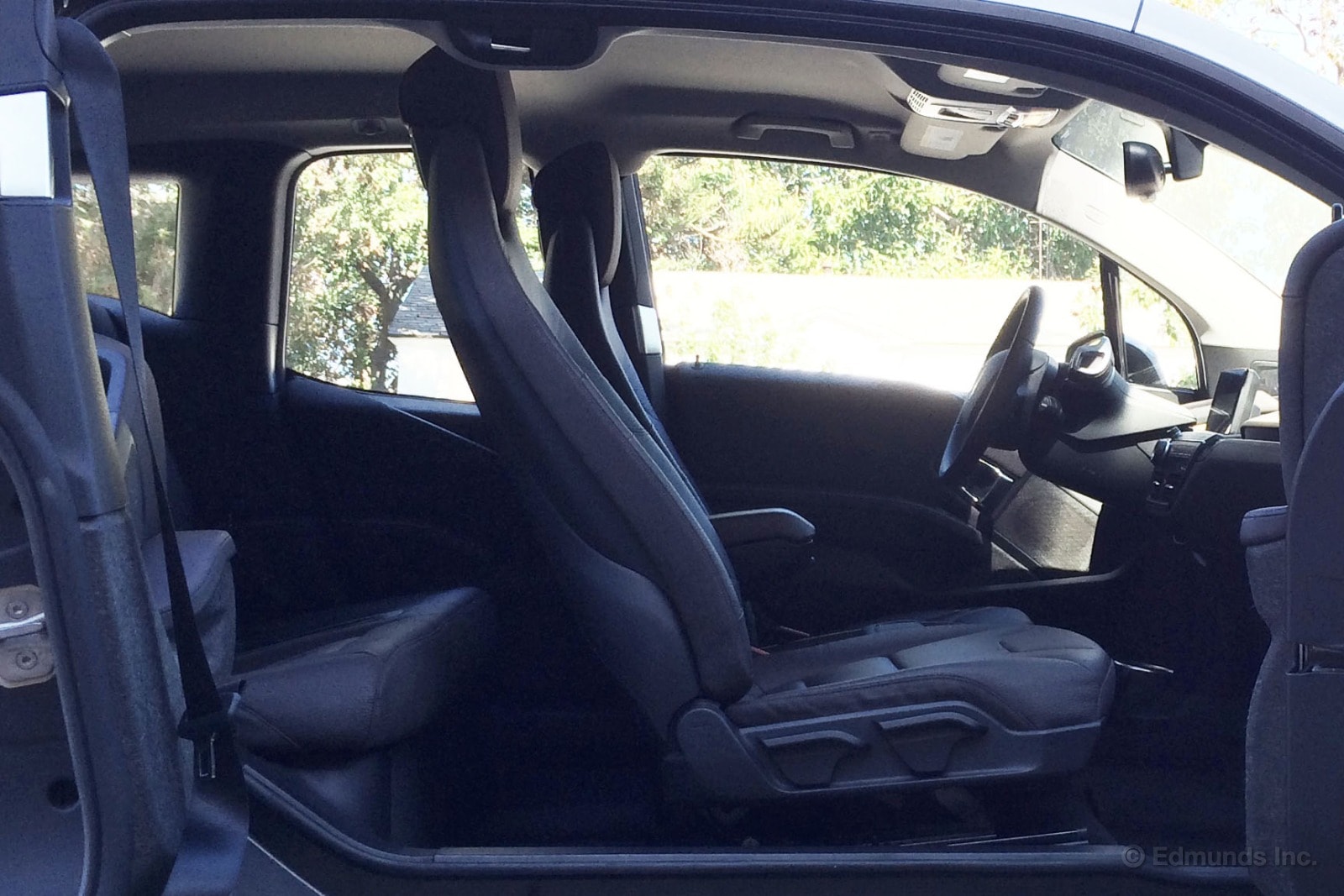
Lastly, I also found that a barricade of doors is not always a bad thing. A little window tint would likely improve coverage, but changing in the gym parking lot has never been easier.
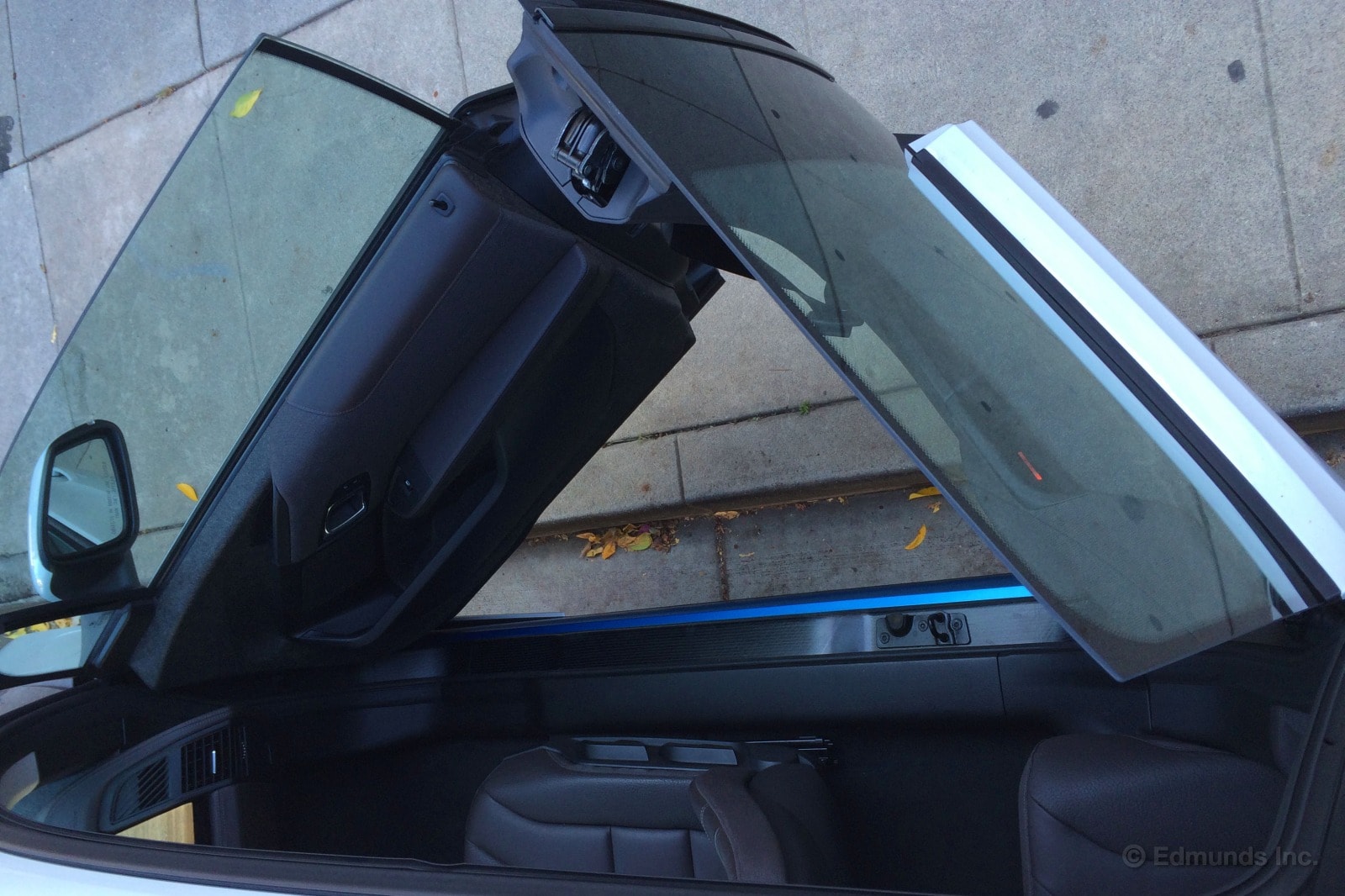

We've already established that our 2014 BMW i3 is a good commuter car. But like any versatile hatchback, it's a handy hauler, too.
Recently I decided it was finally time to let go of the last pack-and-play portable crib and toddler car seat still lingering in our garage. I wasn't sure about the easiest way to load the bulky, bagged Britax seat in the i3, but flipping down the rear seats afforded plenty of space for both items.
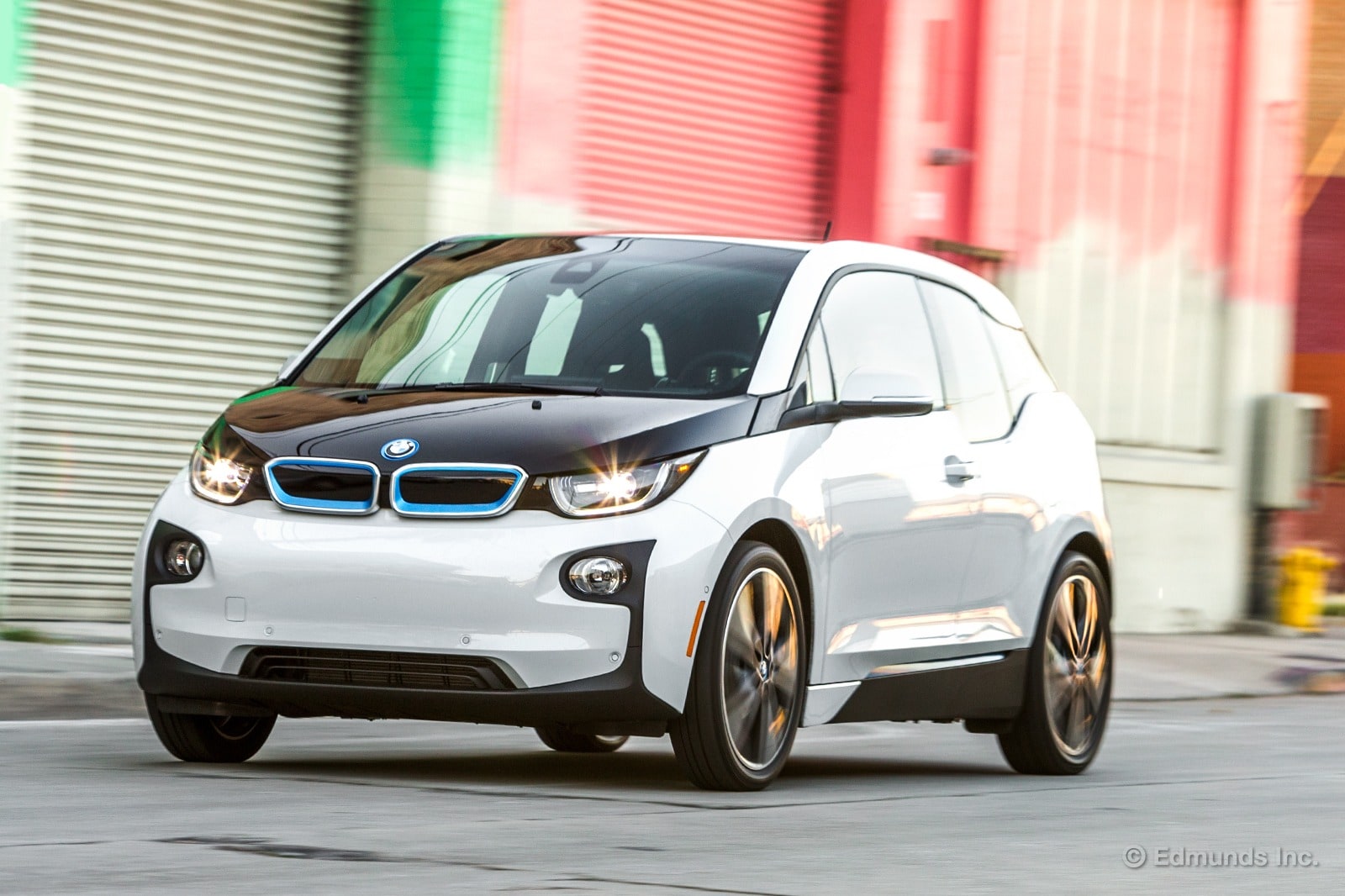
BMW has issued a recall for front-passenger side airbags on 2014-'15 BMW i3s and 2014-'16 Mini Cooper and Cooper S models. Our luck: Our long-term 2014 BMW i3 is among the affected.
I made a call to BMW Customer Service and was immediately put on the line with a representative. After providing our car's VIN, the rep initially told me that nothing about a recall for our car showed in their system. She wanted to verify that however, and put me on hold while she contacted an i3 specialist.
I spoke with the new rep, gave the VIN again, and was told that i3s built between March of 2014 and August of 2015 come under this recall. Ours was built in September.
Now we wait for more information and a timeframe when we can take the i3 to a local dealer for a fix. This part of the process was painless; I was on the phone no more than five minutes.
I also checked with Mini to see if our since-departed Cooper was included in the recall. The Mini representative noted two earlier recalls that we handled, but didn't see an airbag recall. But he allowed that since the recall is fresh, their system might not have yet updated when we called. We'll assume that either their system is slow or the long-term Cooper falls outside of the affected window.
Have an i3 or Mini? Call BMW Customer Service at (800) 525-7417 or Mini Customer Service at (866) 825-1525 to see if your car is affected.
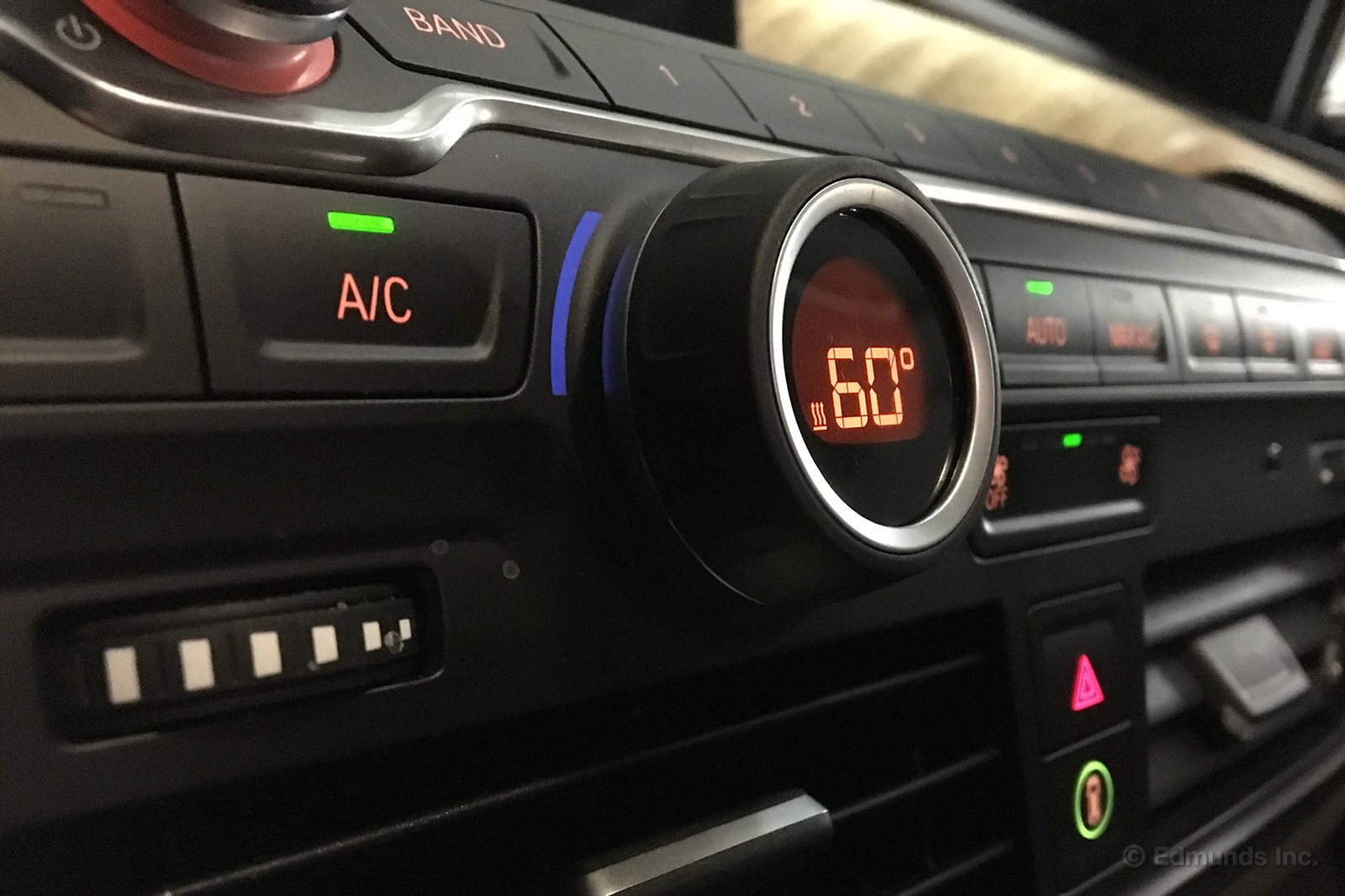
I haven't done the math, but I think I have more miles in our 2014 BMW i3 than anyone else on staff. It fits my life. I don't drive terribly far and for the type of commute I have, an EV is perfect.
So when there was a new noise from the i3, I was surprised.
Within a few feet of hopping into the i3 for my second night in a row, I heard it. Some sort of strained-motor whir not uncommon on EVs when regenerating, but I wasn't decelerating. I was accelerating.
It wasn't loud, but it was there. If I'd had the radio on, I wouldn't have noticed. I figured turning off the climate control would let me hear it better and help isolate the noise. That's when it went away. A few more seconds of tinkering with various HVAC buttons, I'd narrowed it down to the air-con. On: Noise. Off: No noise.
It was hot and a little humid for L.A., so I left it on and just turned on the radio. That fixed it for now.
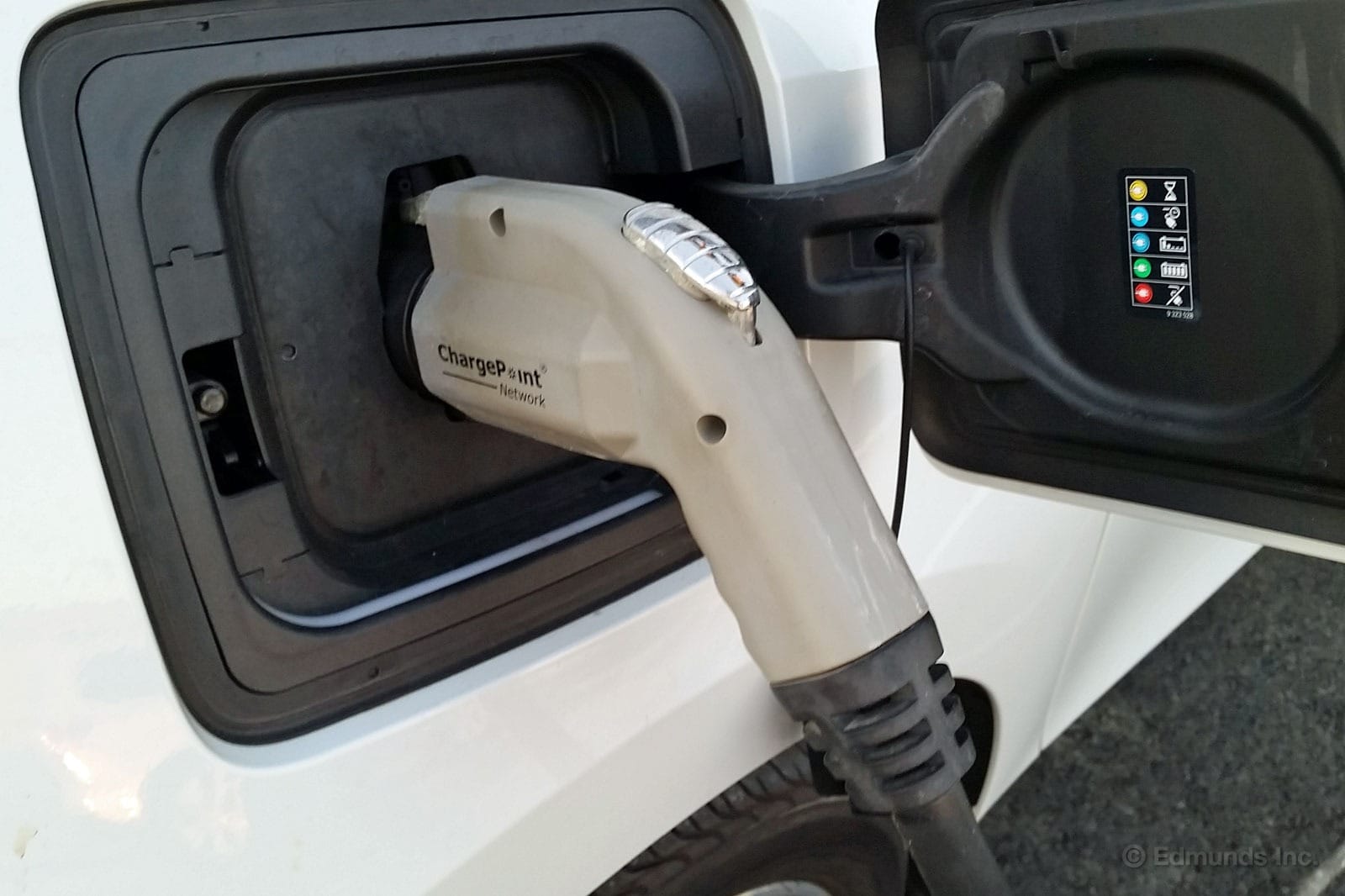
Pop open the 2014 BMW i3's charge port and you'll find a handy list of color-coded icons on the flap that helps drivers discern their EV's current charging status.
If at first glance you don't understand the subtlety of the icons, the i3's owner's manual spells it out as noted below. The "indicator light" referenced is the thin white line located just inside the port along the bottom edge as shown in the photo above.
Display of the Charging Status
The charging status is indicated by the indicator light at the charging port.
Lamp white: charging cable can be connected or removed.
Lamp flashes yellow: charging process is being initialized.
Lamp blue: charging process is started at a set time.
Lamp flashes blue: charging process active.
Lamp flashes red: fault in the charging process.
Lamp green: charging process completed.
When the vehicle is locked, the indicator lamp goes out after some time.
When the vehicle is unlocked, the blue indicator lamp flashes continuously.
This concludes our charge-status tutorial.
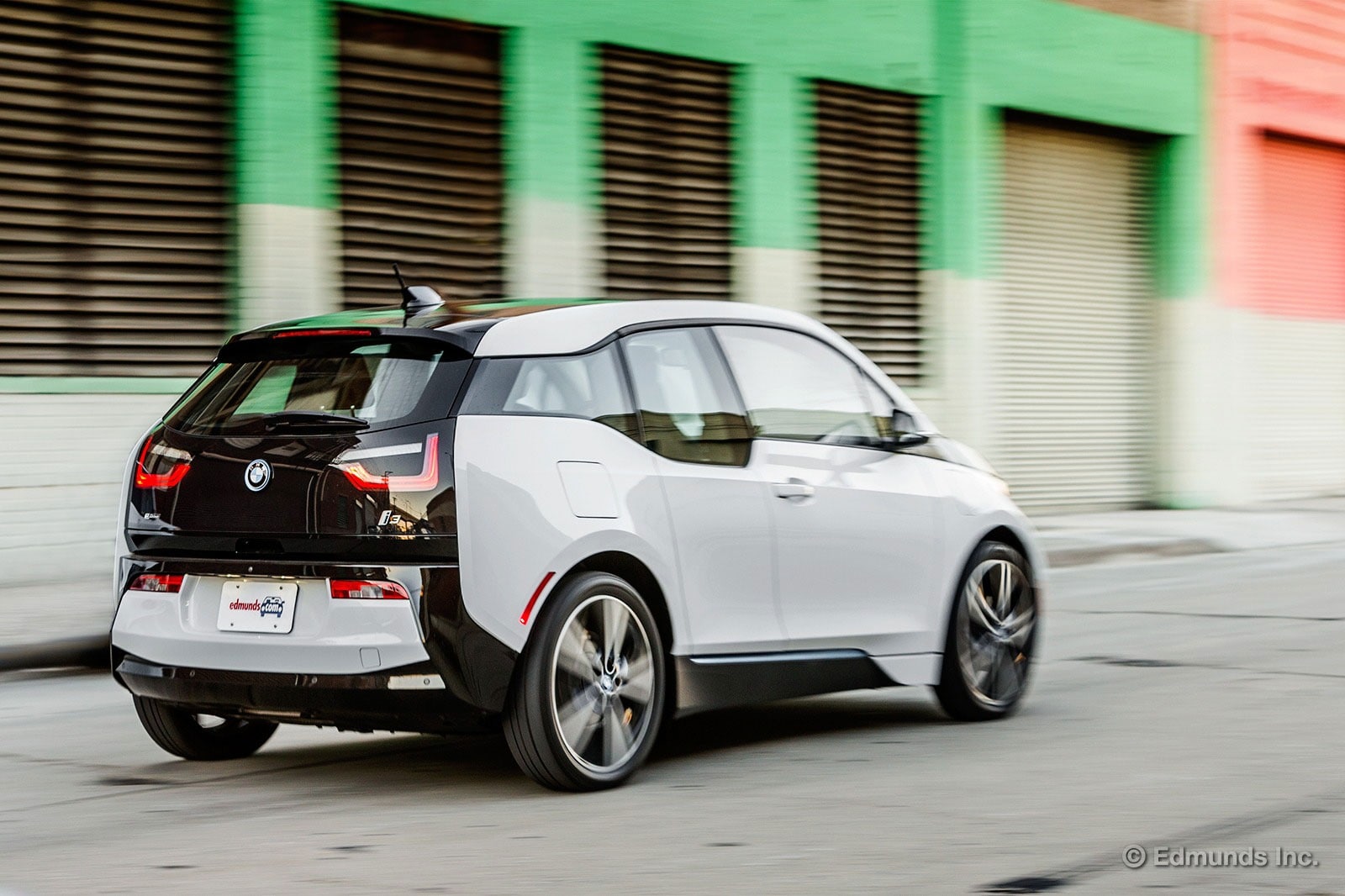
This morning I drove our 2014 BMW i3 into the office. It was just after 4 a.m. so I practically had the freeway to myself. Being an electric vehicle, our i3 has carpool lane access stickers, so I was driving in that far-left lane on principle. In peace.
Actually, the car was doing most of the work. I had the adaptive cruise control system engaged so even if a slower vehicle pulled ahead of me, the BMW would slow to match its pace. But as I soon learned, the adaptive cruise on this i3 stinks.
There I was, no motorists within 10 car lengths of me in any direction and in this quiet moment, the i3 decided to apply the brakes. Maybe it just cut the throttle. Either way, the event was abrupt enough to cause me to sway forward in the seat and put a little scare in me. A quick scan of my surroundings put me at ease. There was no imminent danger. Why the heck did that happen?
Lucky me, I had several opportunities to figure it out. The problem repeated itself five times during my 40-mile drive. Each time, I was in the carpool lane. It happened three times when the road was curving right (away from the wall) and twice while traveling straight. Did it pick up the headlights from a passing car? Was it a shadow from an overpass?
I tried recreating several scenarios but could not get the cruise to fail on command. It was set on the shortest following distance, about 4-5 car lengths. Under normal circumstances, the system detects a car roughly 10 car lengths away and gives a visual cue on the instrument panel. On the surface, adaptive cruise appeared to be working as designed. But clearly it was not. I could not figure it out. All I really learned from the experience is that I won't be using adaptive cruise in that car again.

It's the time of year when Girl Scouts participate in that other fundraiser; the lesser known, mildly anticipated, nuts and candy sale.
How many cans of nuts fit in the rear cargo area of our long-term 2014 BMW i3?
Just 102. My daughter sold 114 cans total, but after taking the above photo, I realized the cargo cover wouldn't close smoothly with the tray of Mixed Nuts and Chocolate Covered Raisins on top.
Moved those 12 cans to the backseat and we were underway.
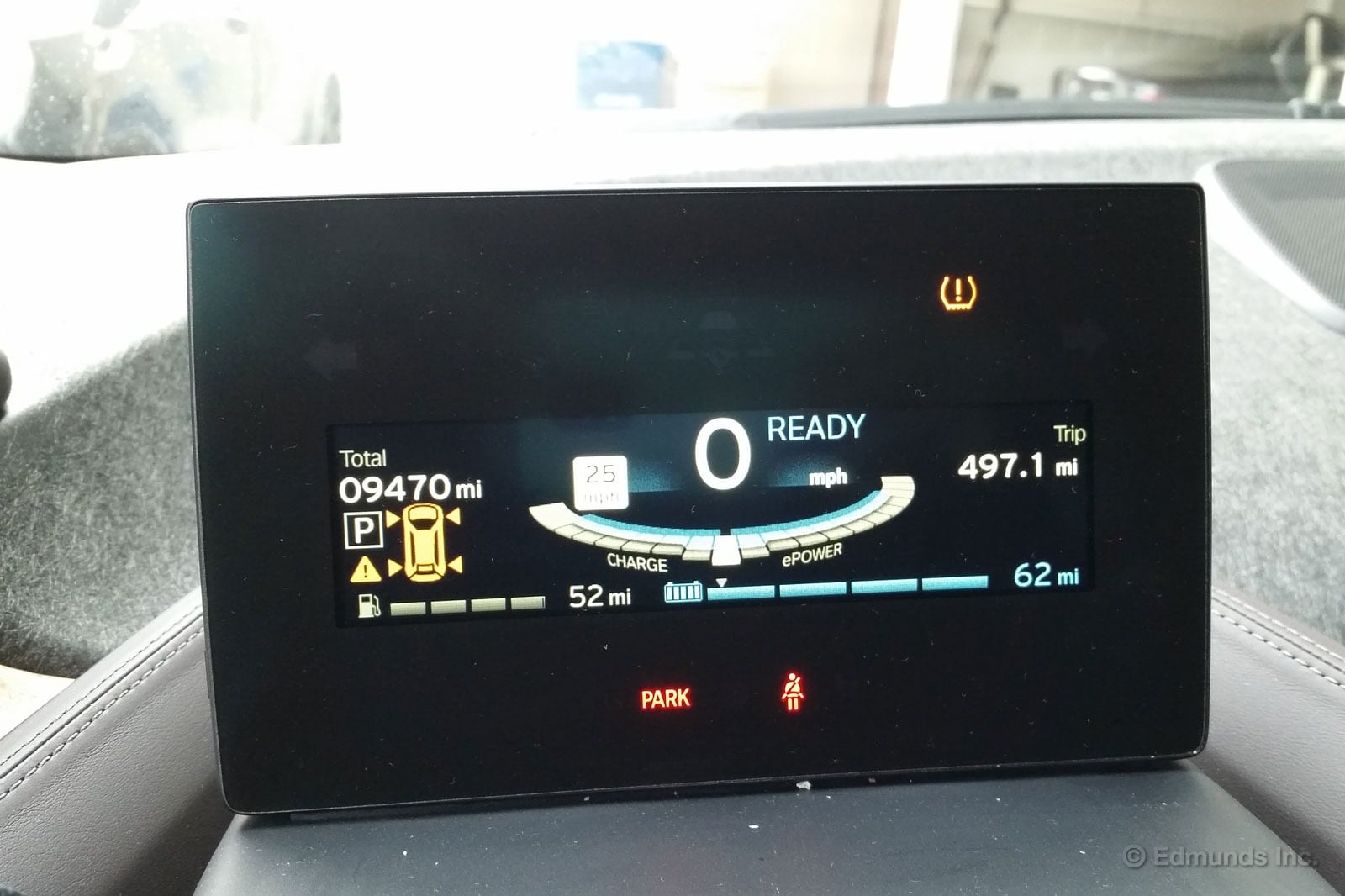
The trend continues across our fleet of test-vehicles. The temperature dropped from an exceptionally hot early fall to a more seasonably cool November and low tire pressure warnings have begun to ding.
Social Media Editor Travis Langness reported on the Viper's alert, then the Ram's, and now the 2014 BMW i3 has chimed in with a low pressure warning of its own.
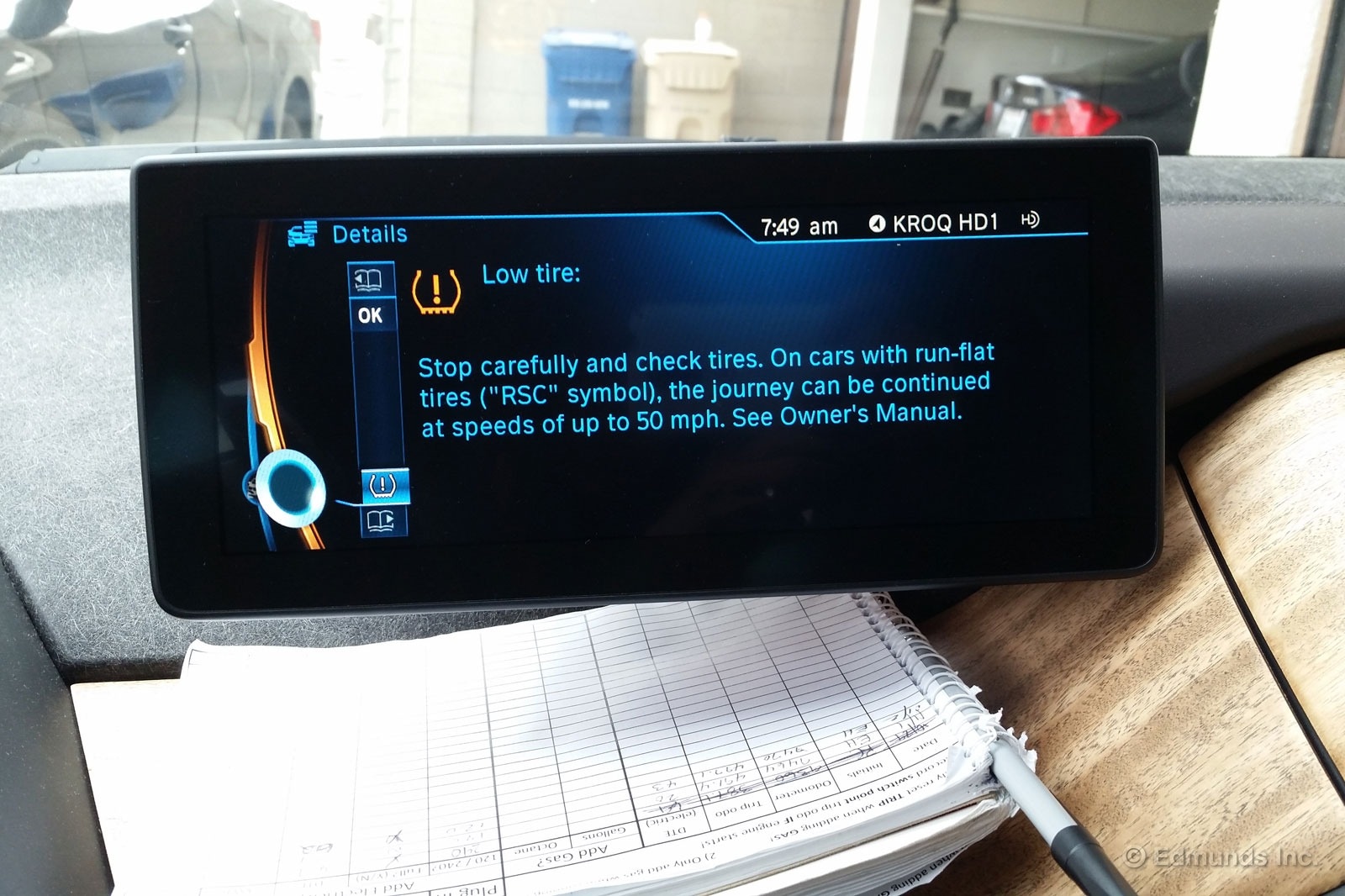

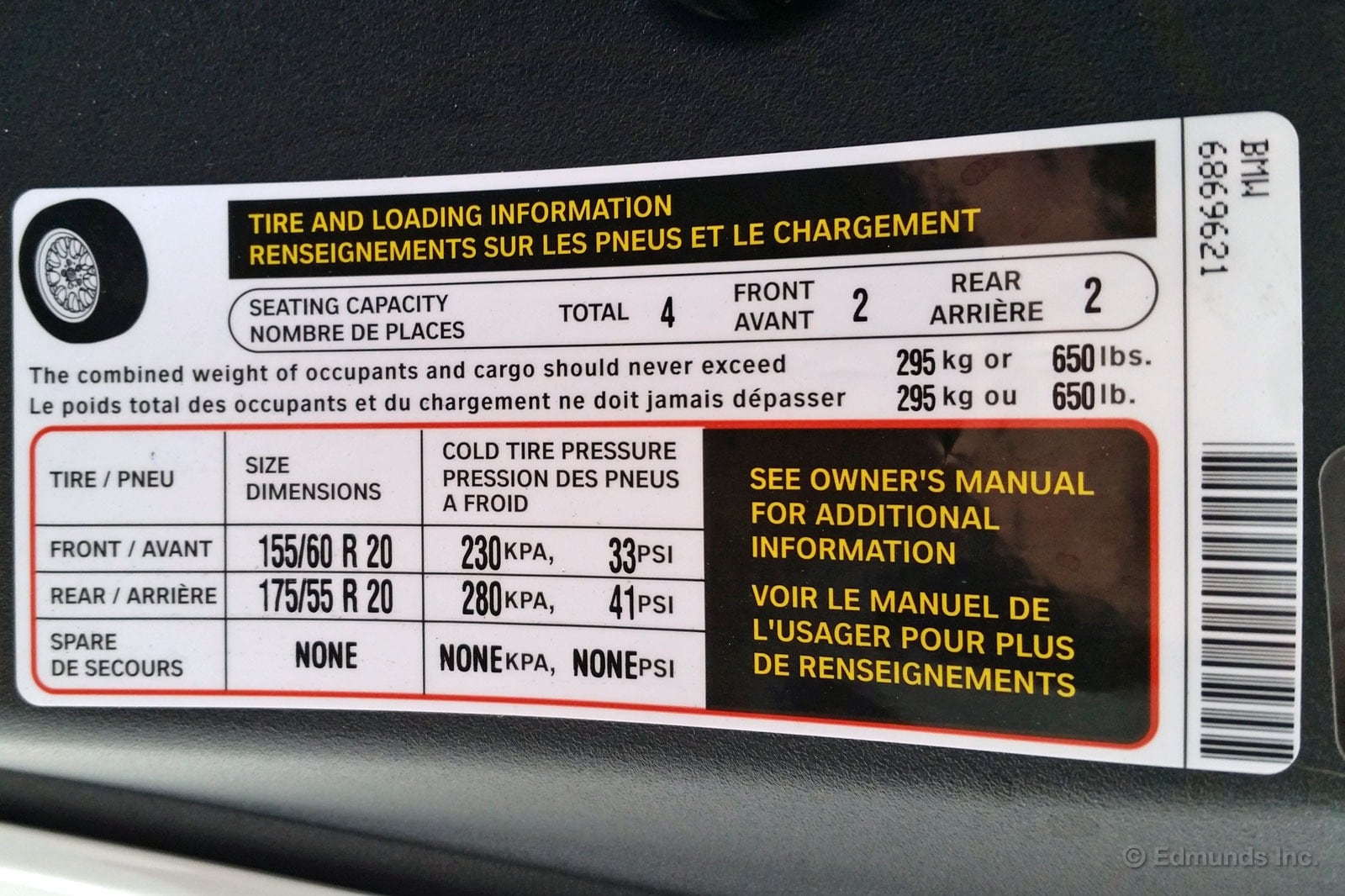
Multiple screens issued the tire warning, indicating that the i3 was down approximately 5 PSI at all four corners.
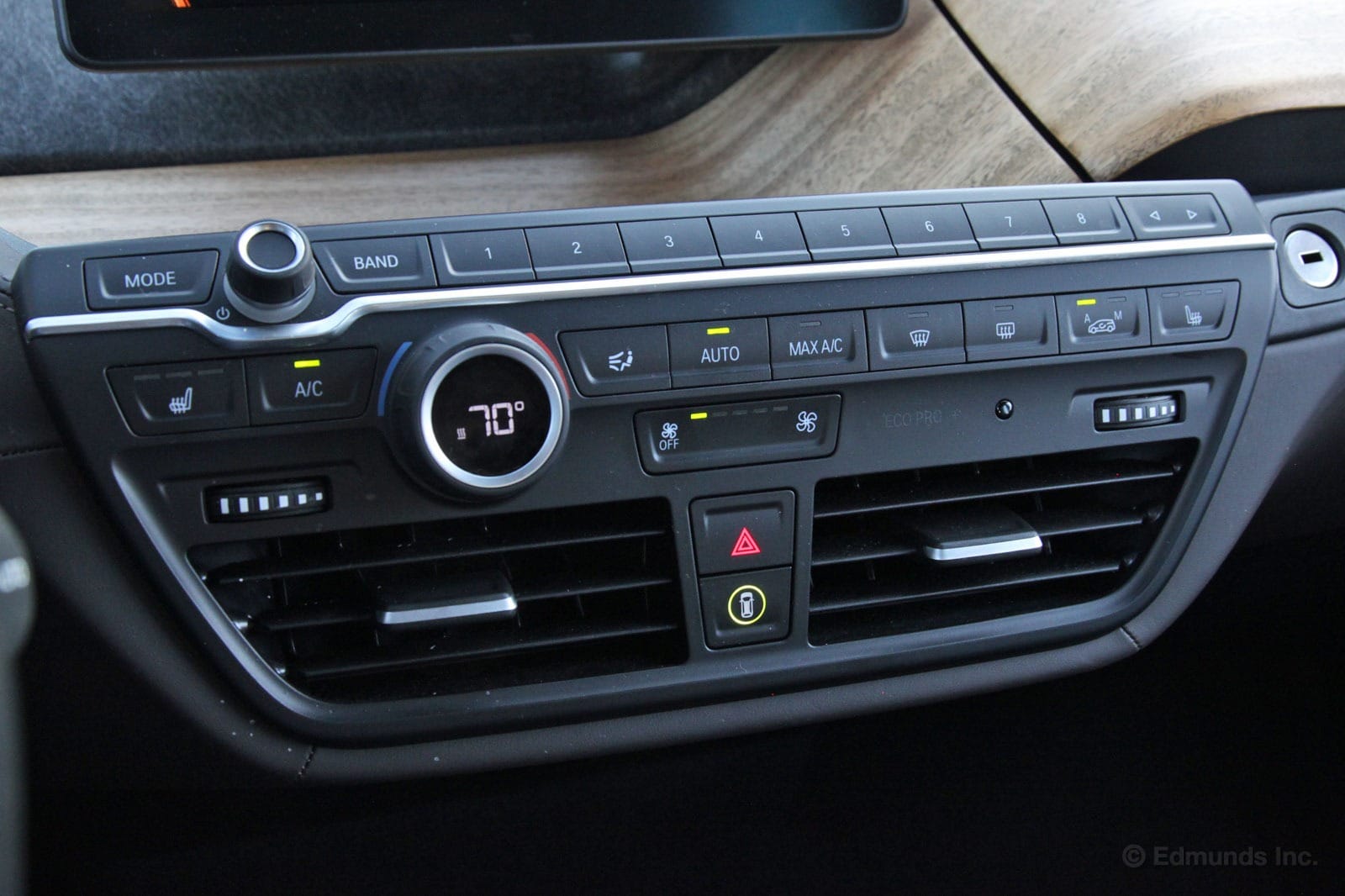
Is it odd that the most sophisticated car in our long-term fleet has the most straightforward climate controls? That's not entirely the case with our 2014 BMW i3, but it's close.
There are less expensive vehicles in our fleet that use the basic three-dial climate control system, which is generally about as simple as it gets. Look at the setup in the i3, however, and you'll see that it has a grand total of 5 buttons and one knob. And after driving the i3 for months now I've never wished for anything more.
During our heat wave, I just hit the "Max A/C" button when I got in to cool things down. Now that it's cooler, I simply set the temperature dial and hit the seat heaters while I wait. Sure, it's not a dual-zone setup, but this car is so small that there's really only one zone anyway.
Oddly enough, the setup reminds me of one of our earliest long term cars, a 2000 Honda Insight. Like the i3, it was a car that was ahead of its time in many ways, but very simple in others.

The above image shows the driver door (left) and the passenger door (right) looking towards the front tires of our 2014 BMW i3. What's up with that gap on the passenger door? I wondered the same thing when I unplugged the charger last night.
Dan Edmunds and I took a look this morning. As it turns out, something broke.
The door itself is covered by a skin. That's the part painted white. Pressing and pulling on it moves this skin a good inch or two. You can hear a click when you push it flush with the rest of the car. With Dan pulling the skin out, we were able to find the culprit.
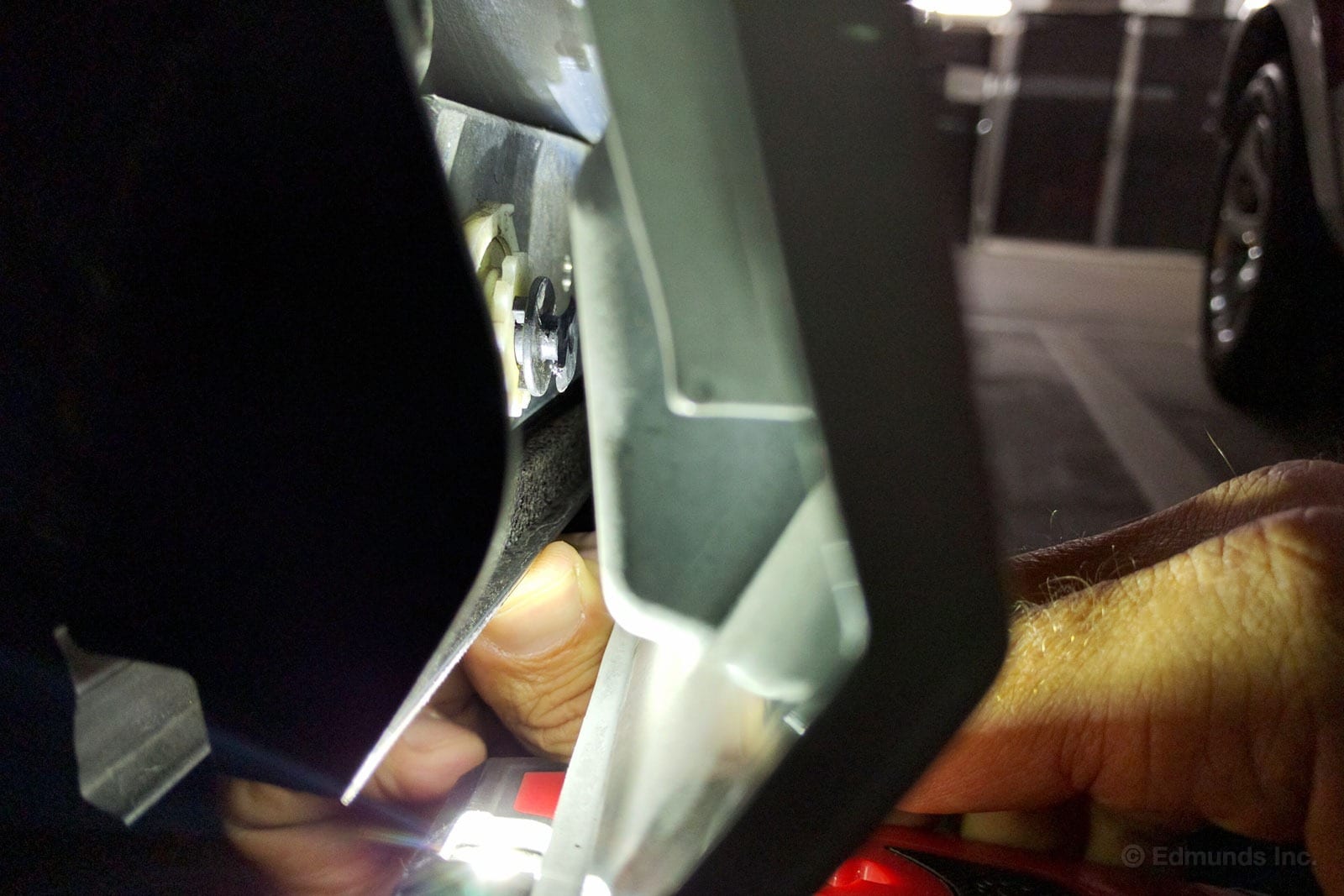
See that half-circle black plastic looking thing? It should be a full circle black plastic looking thing.
Somehow the top of the plastic clip snapped. Maybe someone got their shoe stuck under the door skin when getting out. Either way, our i3 will be making a trip to the dealer to get this fixed.
First Service Needs a Full Day
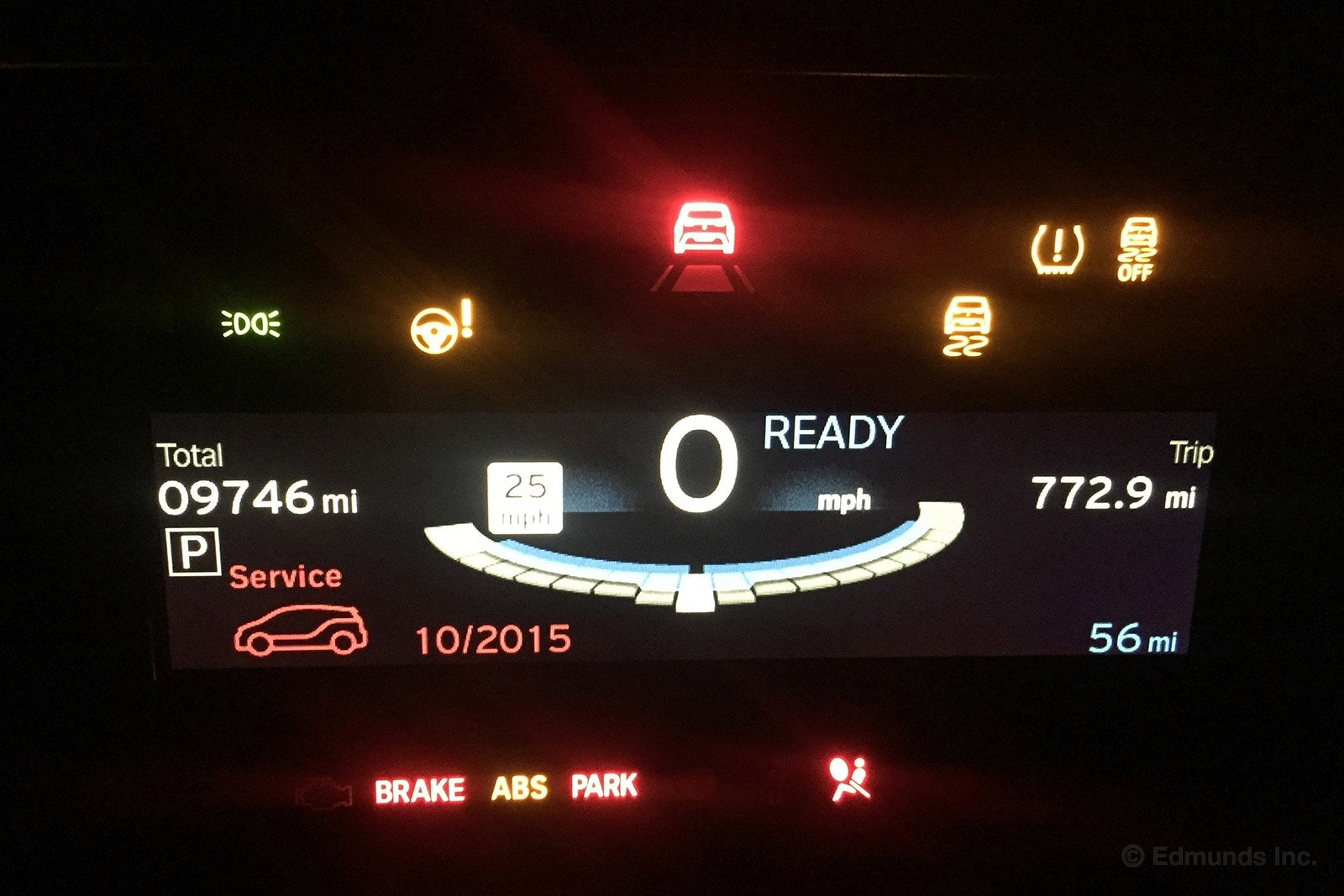
The 2014 BMW i3 has been in our fleet for nearly a year and it's finally due for its first service. With just less than 10,000 miles on the odometer, this maintenance schedule is pretty much in line with our most recent long-term BMWs.
Unlike our current M235i and previous 328i GT, the i3 has its own app that, among other things, informs the user of impending required service. Nifty.
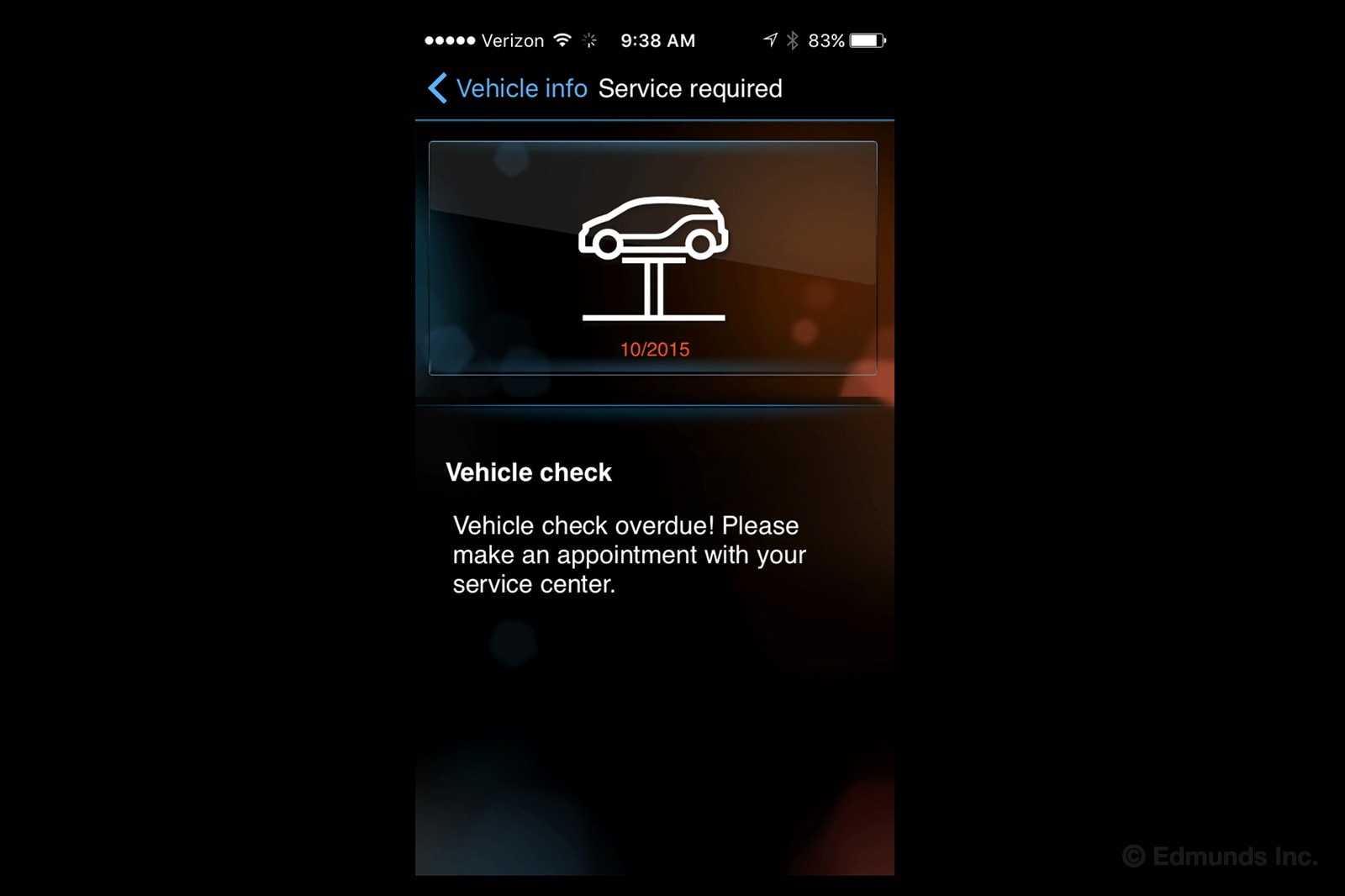
I called a local BMW dealership on a Thursday afternoon to see if they could service the i3 that day. They could take in the car and start working, they said, but were out of loaner vehicles to lend until the service was completed. No problem, I said, thinking about the many dealership lobbies I waited in when I was the Vehicle Testing Assistant. I'll just break out my laptop and chill in the customer lounge until the service is finished.
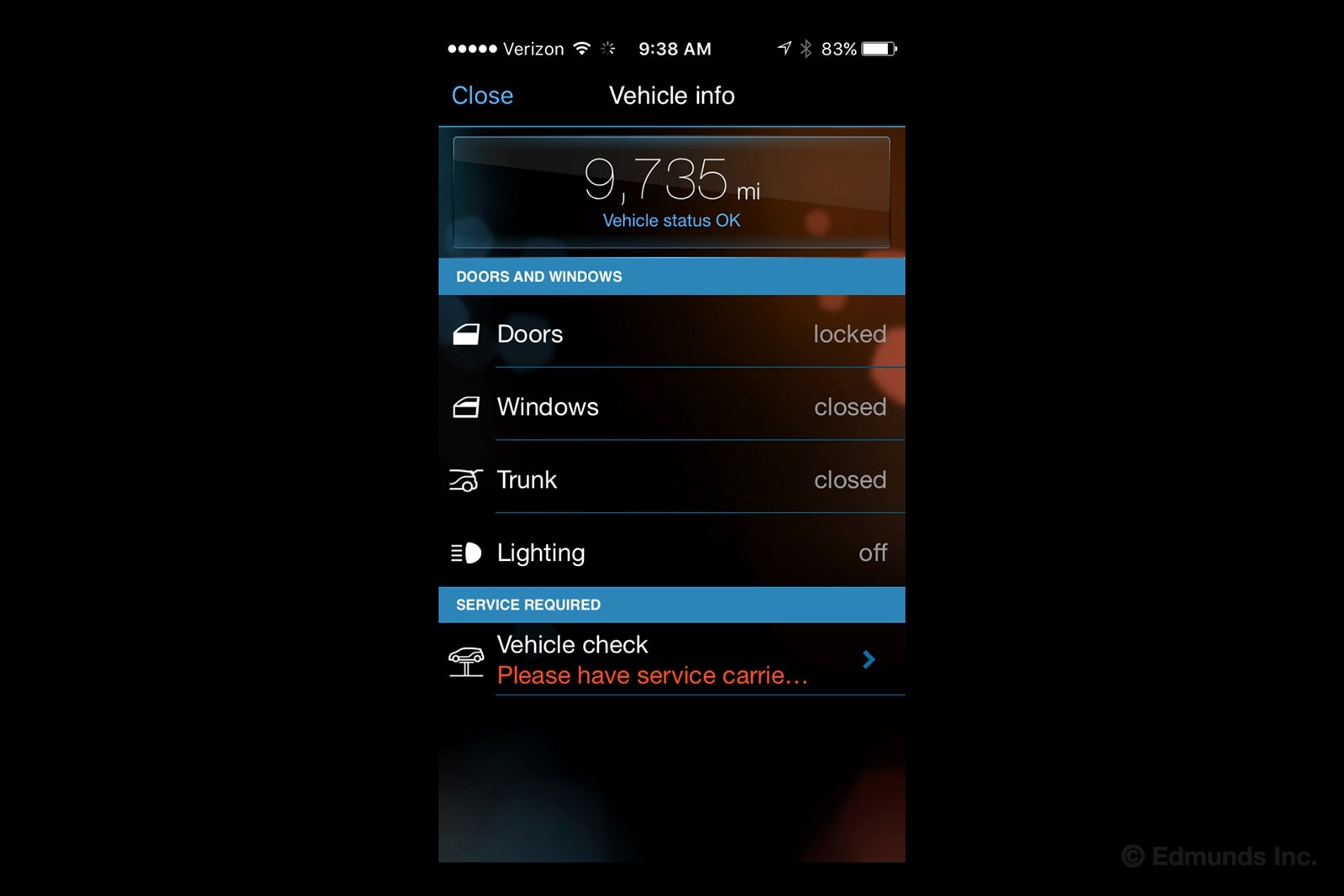
Then the advisor told me the estimated time for the i3 service is a full day, as there is a drain-and-recharge cycle involved to make sure the battery is working correctly. It also has to be carried out by a BMW tech that specializes in i3 and i8 service.
The advisor said loaner vehicles would start trickling back in on Saturday, but they wouldn't start maintenance until Monday. I hung up and made an appointment on Monday morning at BMW Santa Monica, which is within walking distance of the office — handy if there's nobody to pick me up at my 7:30 AM drop-off time.
Kudos to Glare-Resistant Display Screens
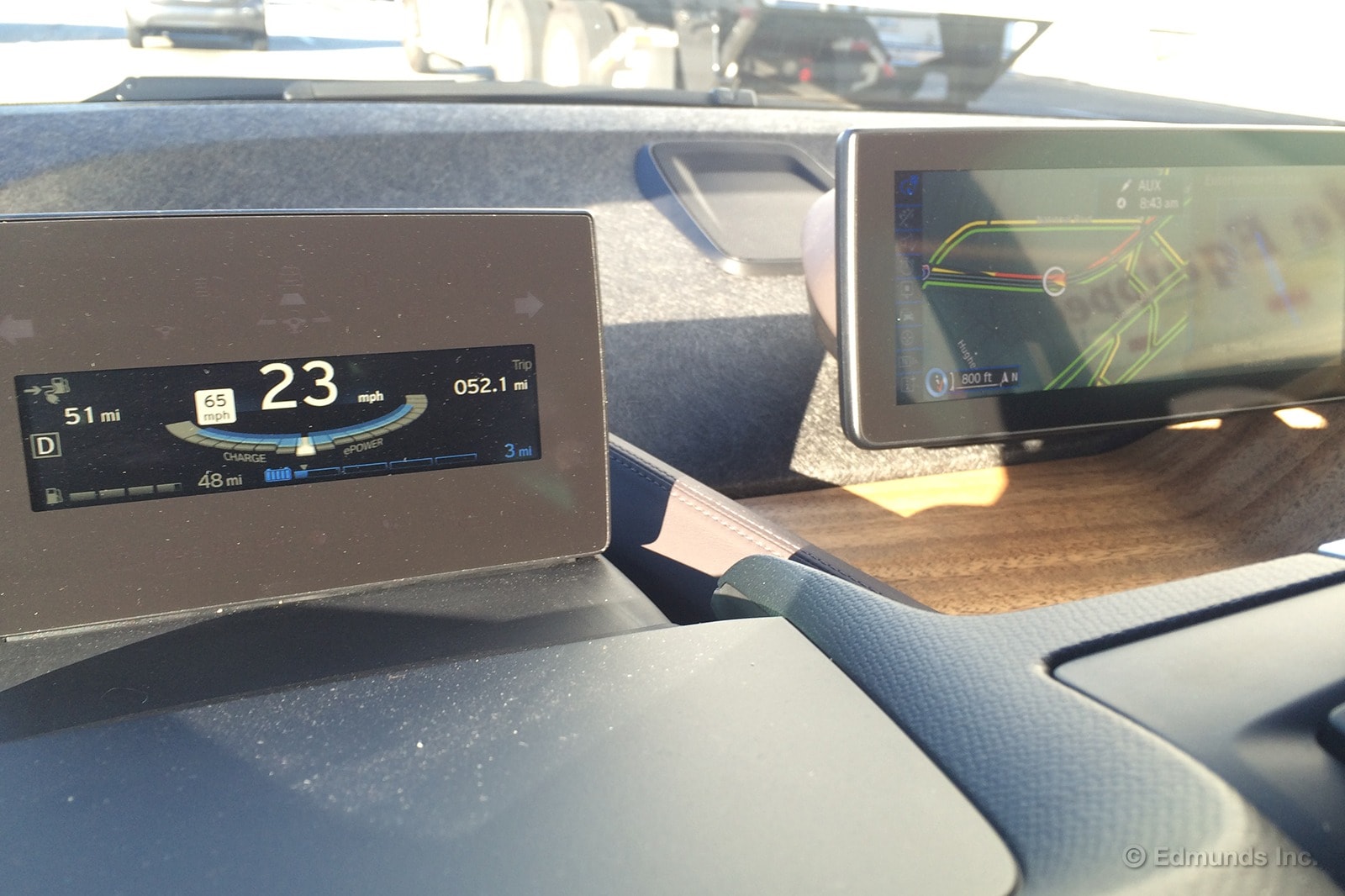
It seems like an inevitability: gauges being replaced by display screens. With virtual instrument clusters becoming increasingly ubiquitous in EVs like our 2014 BMW i3 and various luxury cars, it's hard to imagine any car having traditional dials in 20 years.
The trouble is that these screens are often susceptible when the sun shines from behind you. If you already have a touchscreen in your car, you probably know what I'm talking about. Want to change the radio station or see where you are on the navigation system? Good luck.
Luckily, the gauge display in our i3 and indeed those in other BMWs are quite impervious to the photonic discharges of our local star. As you can see in the above photo, the instrument read-out is perfectly legible, and although the main display seems washed out, that's just my camera's position. It was actually perfectly readable from my view point (as long as you're driving with your chin on the steering wheel, you'll be able to read it).
So kudos to BMW for yet another futuristic element that the i3 nails.
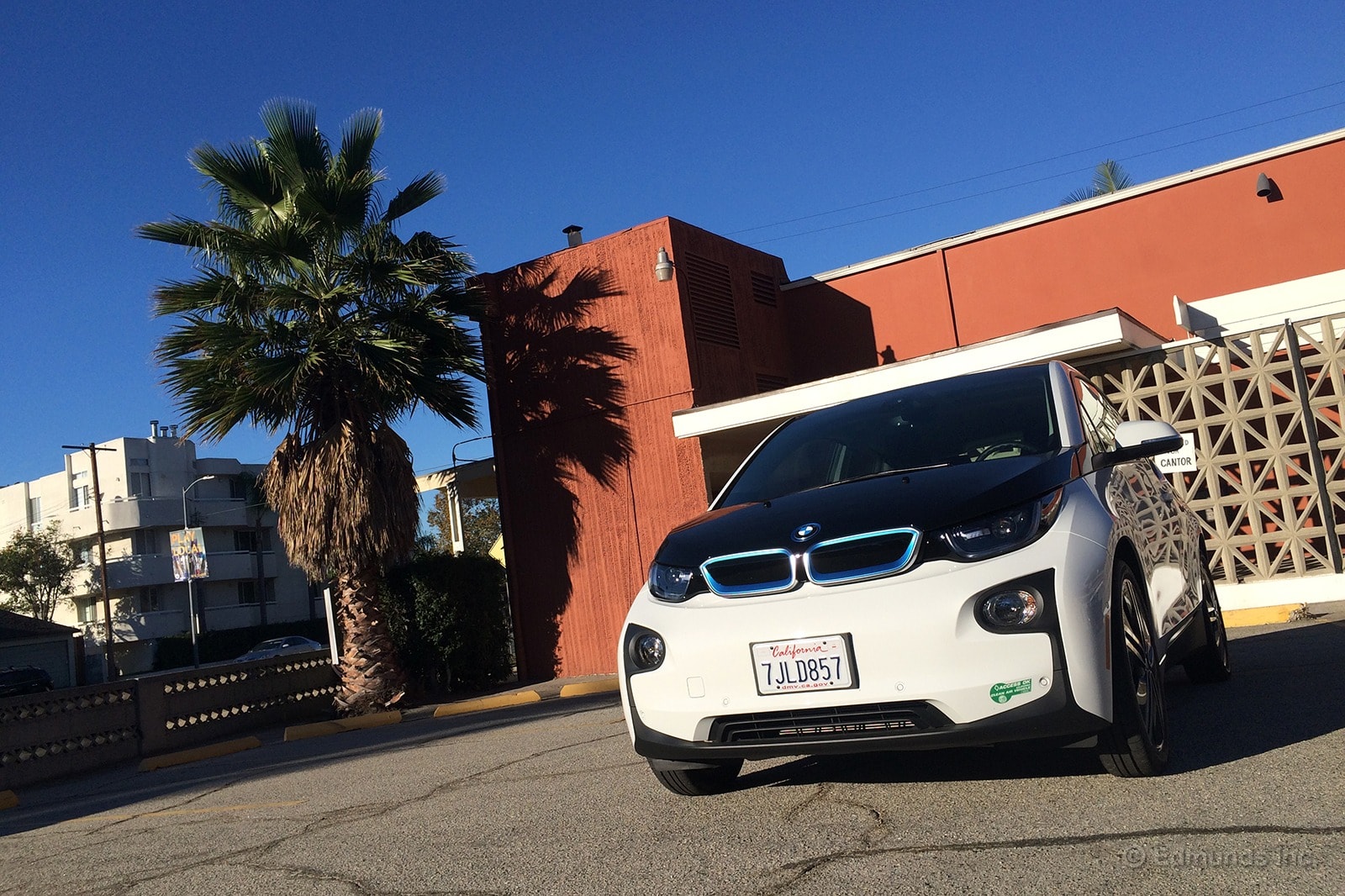
I signed out our 2014 BMW i3 for a full week, and specifically during the week of the Los Angeles Auto Show when I knew I wouldn't be visiting HQ or the i3's charger. There also isn't anywhere to plug it into my condo's garage. Essentially, I was dealing with one week and one charge.
I drove nine-plus miles from the office to my house. I criss-crossed West Hollywood, Hollywood and Beverly Hills for multiple auto show-related events. I made the 6.5-mile drive to the LA Convention Center and back. Post-show, I drove to dinner, I went to the grocery store and on Monday morning, I returned those 9-plus miles to Edmunds HQ.
Lo and behold, the i3's gasoline engine only came on as I was exiting the highway for Edmunds HQ. I came ever so-close to spending an entire week using electricity only — and I would've made it if I'd been driving the EV-only version, with its extra miles of range. Of course, I also would've been biting my nails during that final commute, so I still think opting for the range-extending engine (REX) is a must. I bite my nails enough as it is.
Of course, if you own an i3, it's a virtual certainty that you also have a garage with a plug that can recharge it. Yet, my one-week, one-charge experience shows just how much you can drive an electric car (or quasi-electric car) before recharging it. It just proved once again how fantastic the i3 is as a city car. If your life consists of sitting in traffic and criss-crossing an urban landscape, do yourself a favor and consider the i3.
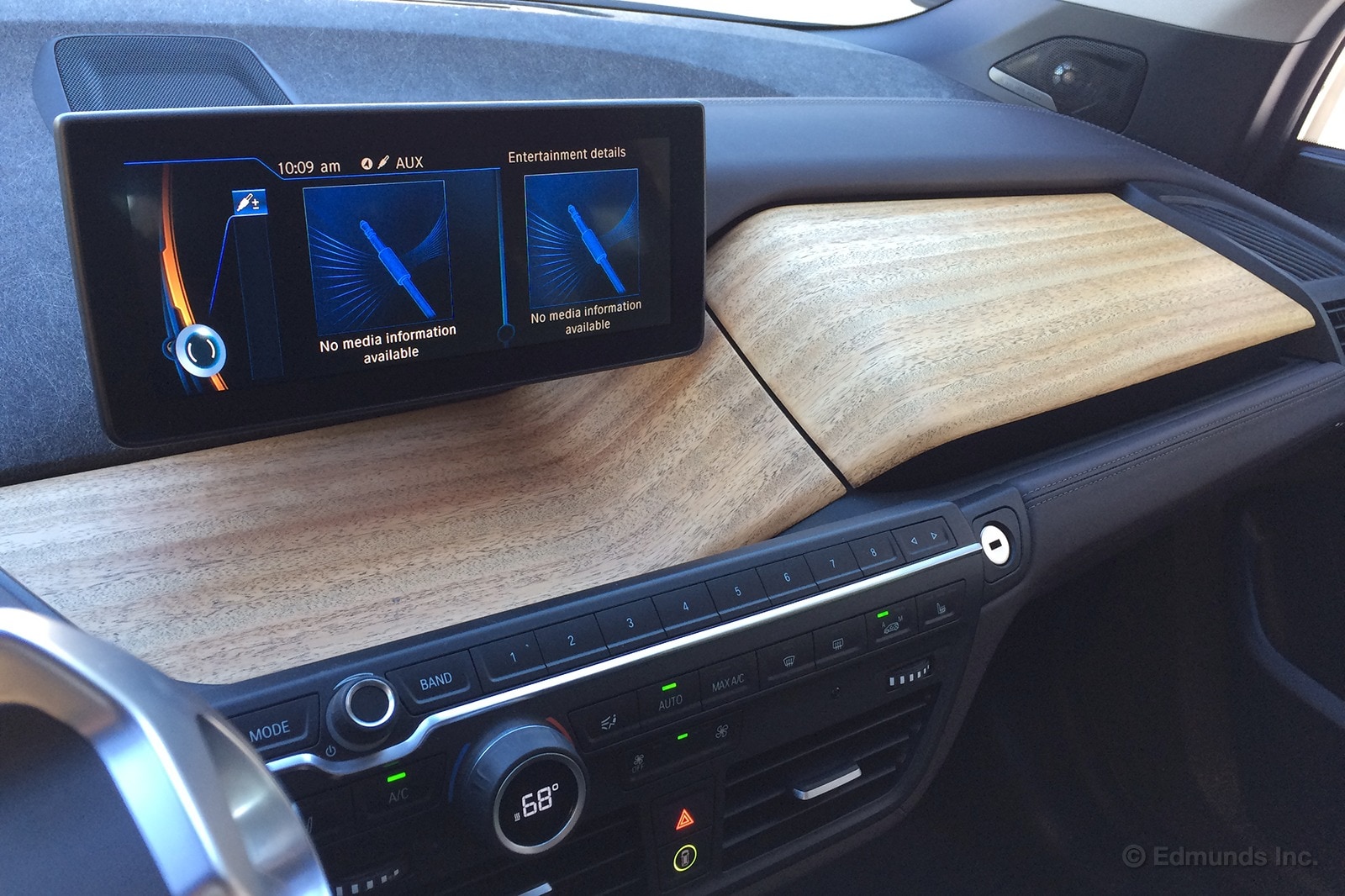
The 2014 BMW i3 is not a good looking car. It just isn't. And yet for the better part of a year now, I've raved about how excellent the i3 meets the demands of an urban-bound, traffic-snarled driver. I could absolutely make the case for buying one, but could I live with those looks?
Absolutely. You see, its beauty is on the inside.
I mean that both literally and figuratively. Literally in that the cabin is gorgeous, an interesting mix of textures, surfaces and details. My favorite part is that beautiful cascade of wood on the dash. I can't take my eyes off it and I constantly find myself running my fingers across the grain of its non-veneered surface.
If we'd opted for the "Giga Cassia Natural Leather & Carum Spice Grey Wool Cloth," I would love it even more, but I must admit our all-leather "Tera Dalbergia Brown" cabin is still quite fetching. This is a car for those who care less about what others think and more about enjoying the world around them.
Its figurative beauty on the inside is in the way it drives. I love its abundant, effortless, right-there power that never fails to put a smile on my face and the looks of befuddlement from sport sedan drivers inevitably shocked by the funky little electric pod that roasted them off the line. I love its congestion-conquering nimbleness, its elevated view of the road and its tiny proportions that make parking easy.
In other words, I don't care what it looks like. I just love it.

A maintenance light on the instrument panel and alerts on the BMW i Remote app led us to schedule the first service for our 2014 BMW i3. I drove to Santa Monica BMW at 7:45 on a Monday morning to meet with the service advisor. In addition to cycling the battery to make sure charging was kosher, our EV would undergo a series of inspections and an oil change for the scooter engine that serves as a range extender.
The advisor told me the i3 would be ready at least by Tuesday morning, but in all likelihood could be finished some time Monday afternoon. I told him that was fine, surrendered the keys and hitched a ride on the Mike Schmidt Courtesy Shuttle Express.
True to his word, our advisor rang at 1:30 p.m. to tell us the i3 would be ready in 30 minutes. The service cost us nothing thanks to BMW's 4-year/50,000-mile complimentary maintenance program.
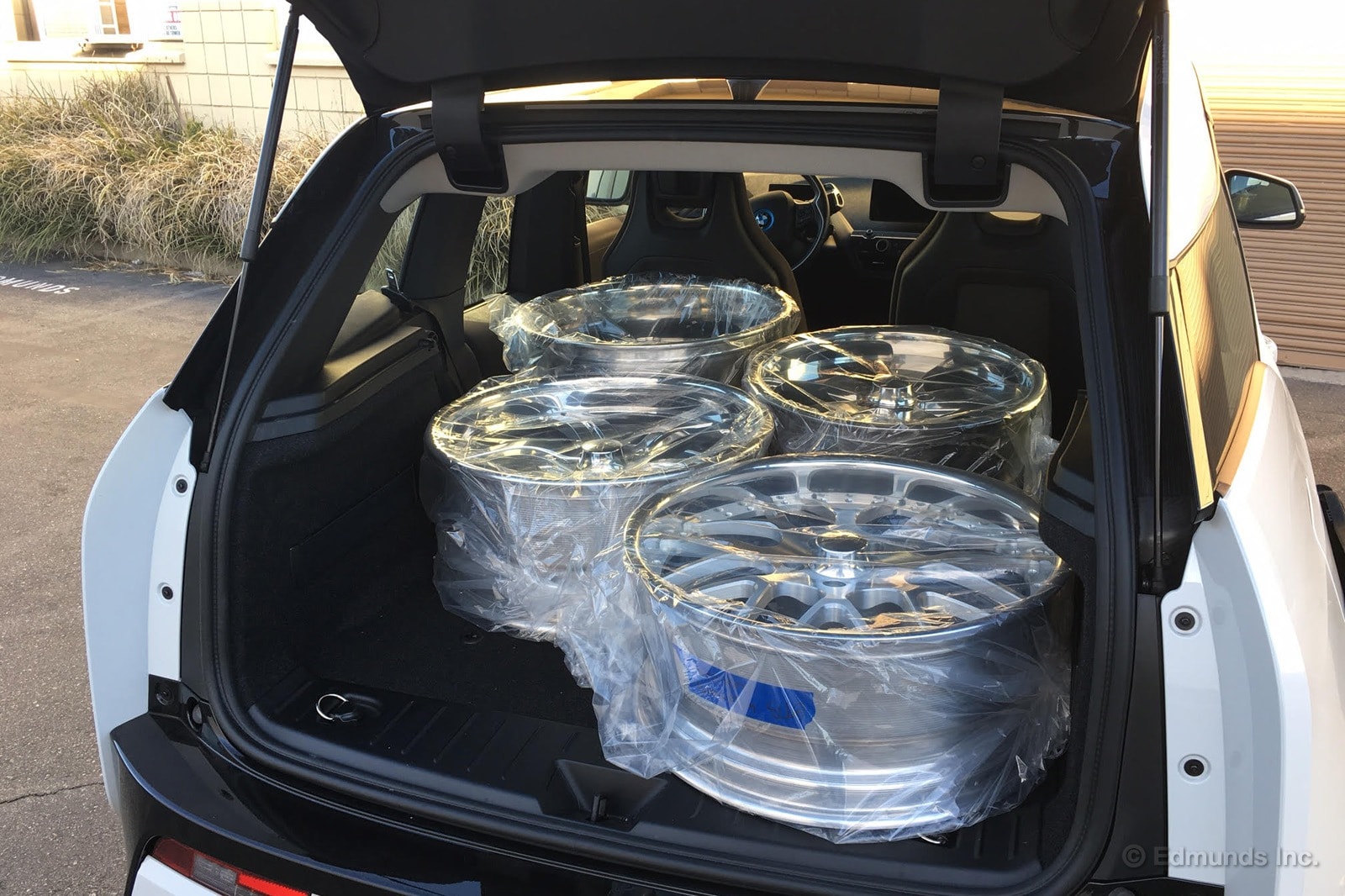
According to BMW, our long-term 2014 BMW i3 has 36.9 cubic feet of cargo space once you drop both sides of its split-folding rear seat.
Great, but what exactly does that mean?
Last week I learned that it means the i3's "trunk" can handle four 19-inch diameter billet wheels of various widths pretty easily. Make that very easily, with plenty of height space and some floor space left over.
The BMW's low lift-over height and flat floor should also be called out. This is a well-thought out design with real consumer benefits.
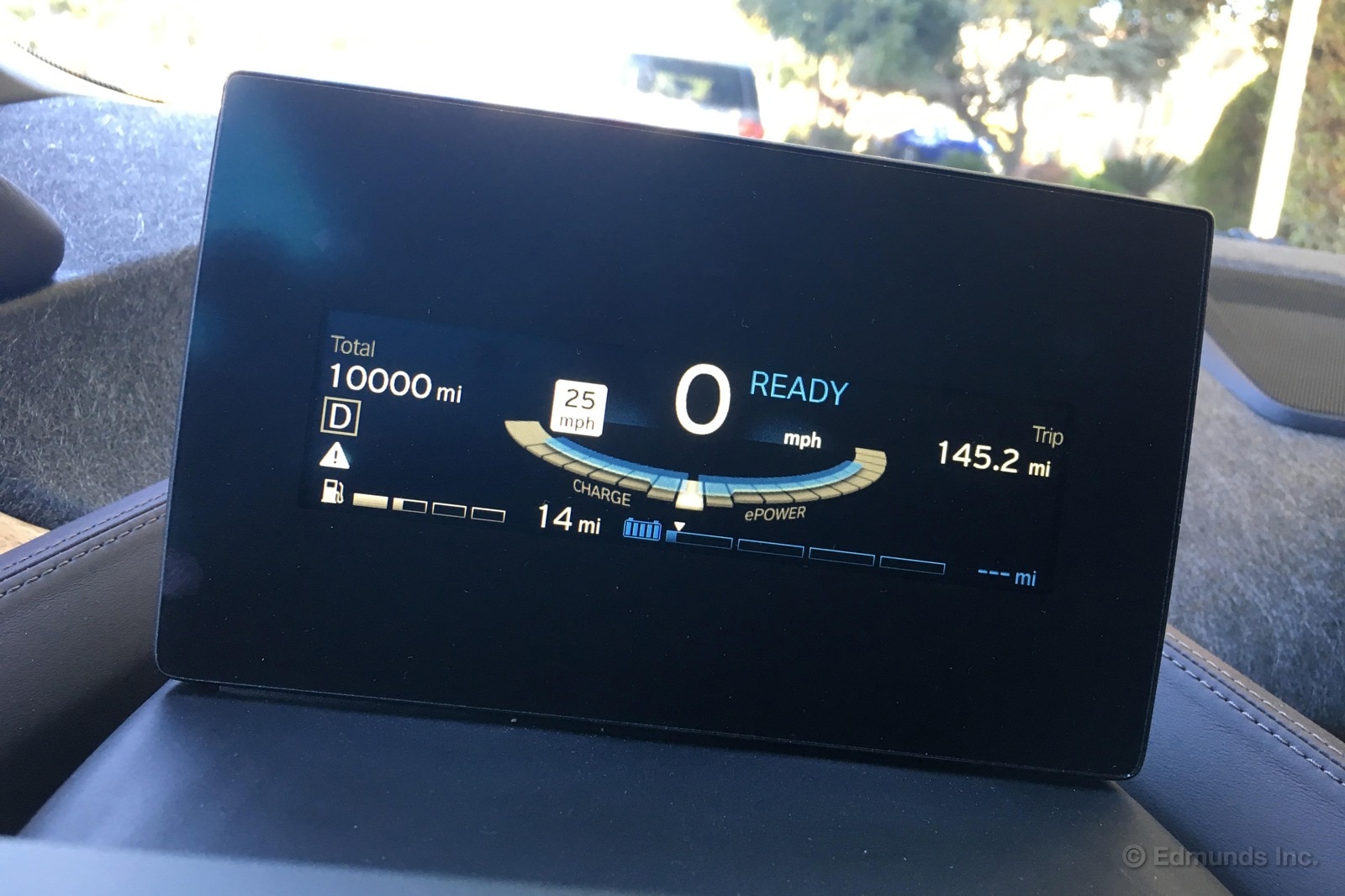
Eleven months into our long-term road test of the 2014 BMW i3, we've finally crossed the 10,000-mile mark. Since our 5,000-mile update, we took the i3 in for its first service, stretched a charge out over a single week, and found that improving the range with regenerative braking can be fun.
We also learned how dearly it costs to replace a charging cable after the original ended up broken under mysterious circumstances. The passenger door skin also came loose from the car. This too remains unsolved.
Despite the lack miles, the i3 remains a popular choice in our fleet. It features plenty of usable space with the rear seats folded and enough room to comfortably carry adults. Even this late in the test, there are very few evenings where the i3 goes unclaimed.
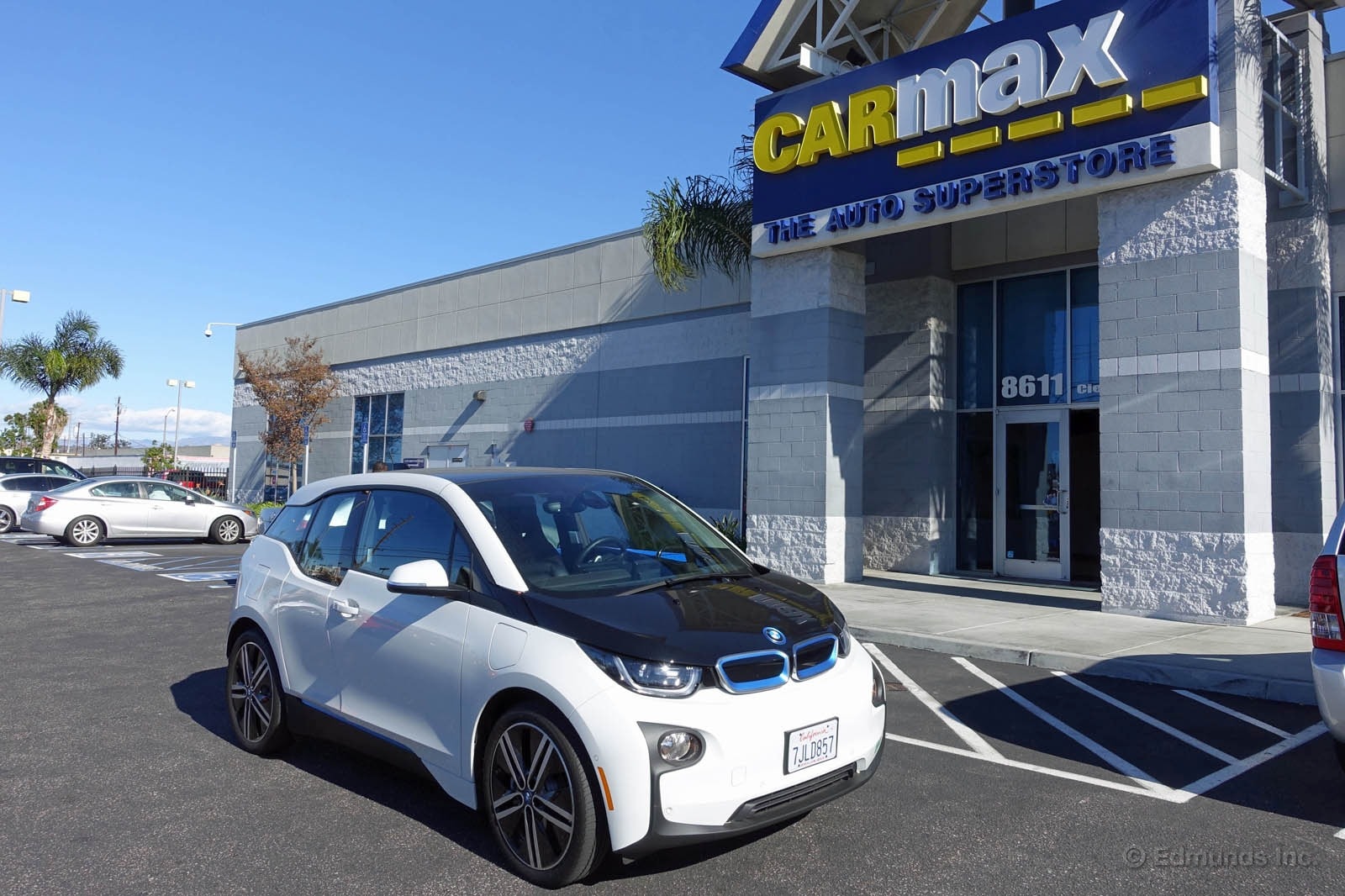
Electric vehicles tend to make for poor used-car values. All the tax credits and rebates are aimed at the first buyer, which in turn affects the vehicle's resale value. Why buy a 2- to 3-year old EV when you can lease a new one for less per month?
And yet despite knowing this, I wasn't prepared for the ridiculously low offer that CarMax gave us when we brought them the 2014 BMW i3. It's not that I was expecting our i3 to magically buck the low-value EV trend, but my research showed that I should have gotten a better deal.
Edmunds trade-in True Market Value® estimates that our 2014 BMW i3 is worth about $30,875. There was only one i3 with a range extender for sale on CarMax's website (located in Austin, Texas). It had 2,000 more miles than ours, cloth seats (we have leather) and base wheels (we have the optional 20's). CarMax was asking $36,000.
I estimate that CarMax paid about $32,500 for it, given that it usually prices its cars at about $3,500 over the trade-in offer. Our i3 had fewer miles and more options. We stood to get at least $33,000, right? Wrong.
My first clue should've been the glut of EVs sitting on CarMax's lot, occupying the same prime real estate out front, where luxury cars would usually be parked. I counted eight Nissan Leafs, three Chevrolet Volts and two Ford Focus Electrics.
The offer came in at $26,000. For reference, we paid $50,000 (before tax and title) for the i3 when we bought it new last year. This was a depreciation of nearly 50 percent! After picking up my jaw from the floor, I politely asked the sales rep to go back and see if perhaps the pricing department hadn't noted that we had the range extender. I even asked him to pull up the other i3 in CarMax's inventory as a sign that my expectations weren't out of whack.
The offer is correct, said the salesman. "The other car is scheduled to get a price drop sometime soon."
It wasn't the answer I wanted, but I understood the logic. It was likely the first i3 that CarMax encountered and estimators didn't have a baseline for the price. My guess is that this car has sat on the lot and forced CarMax to reconsider the prices on any others i3's they took in. Either way, it didn't help our situation.
We have seven days to consider the offer. In the meantime, I'm going to contact a couple of BMW dealerships. Perhaps they're willing to offer us more.
So much for the preferential treatment that some folks think Edmunds gets at CarMax.
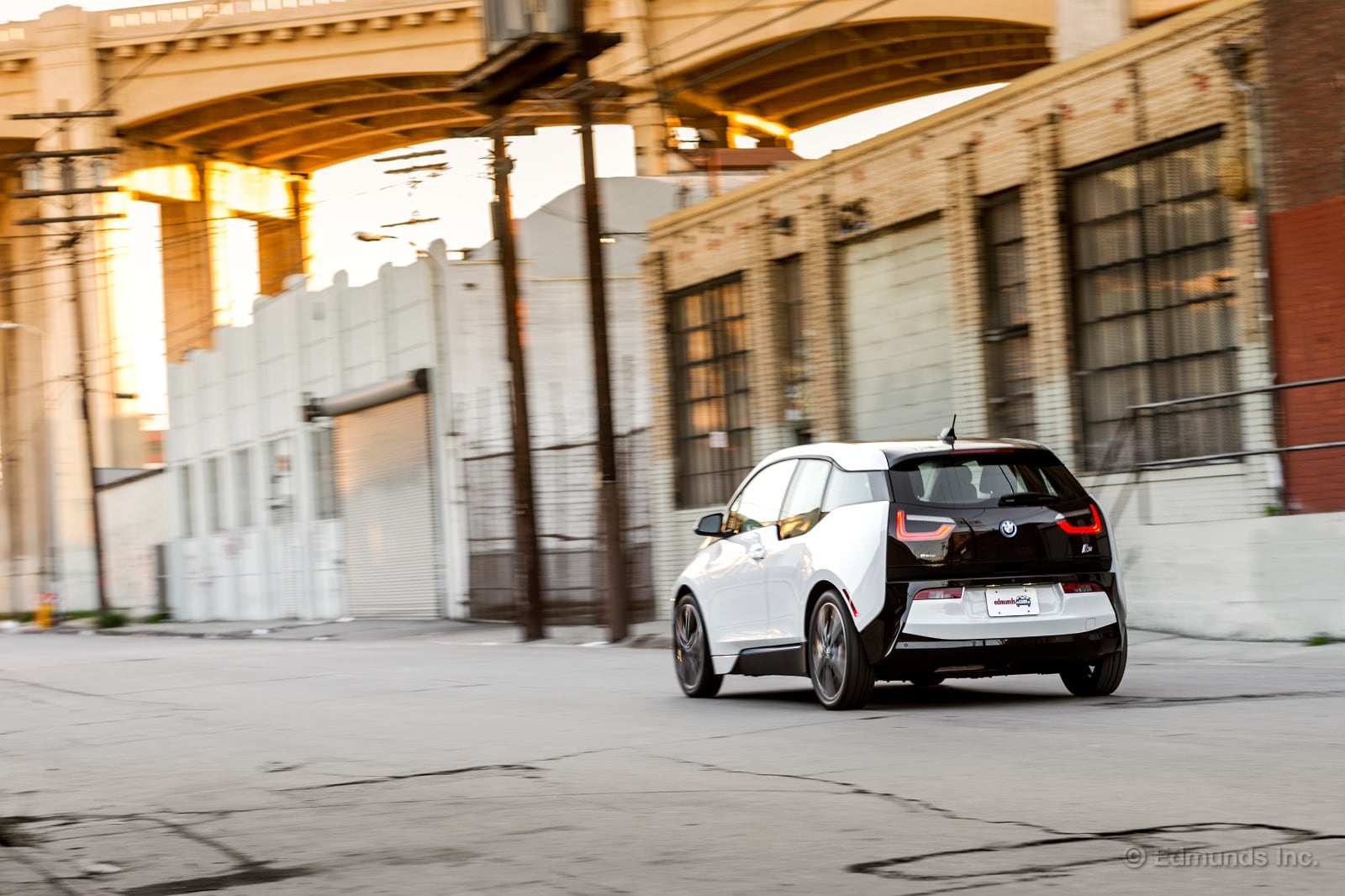
Over a year ago we were eager to add the unusual 2014 BMW i3 to our fleet and test the range capability of the onboard generator. But as time passed, we began to dread the prospect of selling it. Resale values of electric cars are still unpredictable and all too often disappointing.
We offered the i3 for sale at the Edmunds True Market Value (TMV) price of $33,300 and got no takers. So we knew we had to try other sources.
Naturally, we got a quote from CarMax, but it came in at only $26,000. That was very discouraging because the Edmunds trade-in value is $30,875. We even took it to a local BMW dealer, but their quote was even less — just $25,000. Finally, we decided that CarMax was the best of our bad options. By this time, several weeks had passed and our 7-day quote long expired. That meant we had to have it re-appraised. Luckily, the quote was the same so we cashed out.
That means the i3 depreciated 45 percent during the 13 months we owned it, and that's after subtracting the $2,500 California rebate from the purchase price of $49,999 (we also received the $7,500 federal tax credit, but didn't figure this into our calculation).
Sadly, the i3 set a record for the steepest depreciation for any vehicle in our long-term fleet. Still, our editors thought the i3 was an enjoyable city car with a cool interior and many unusual features.
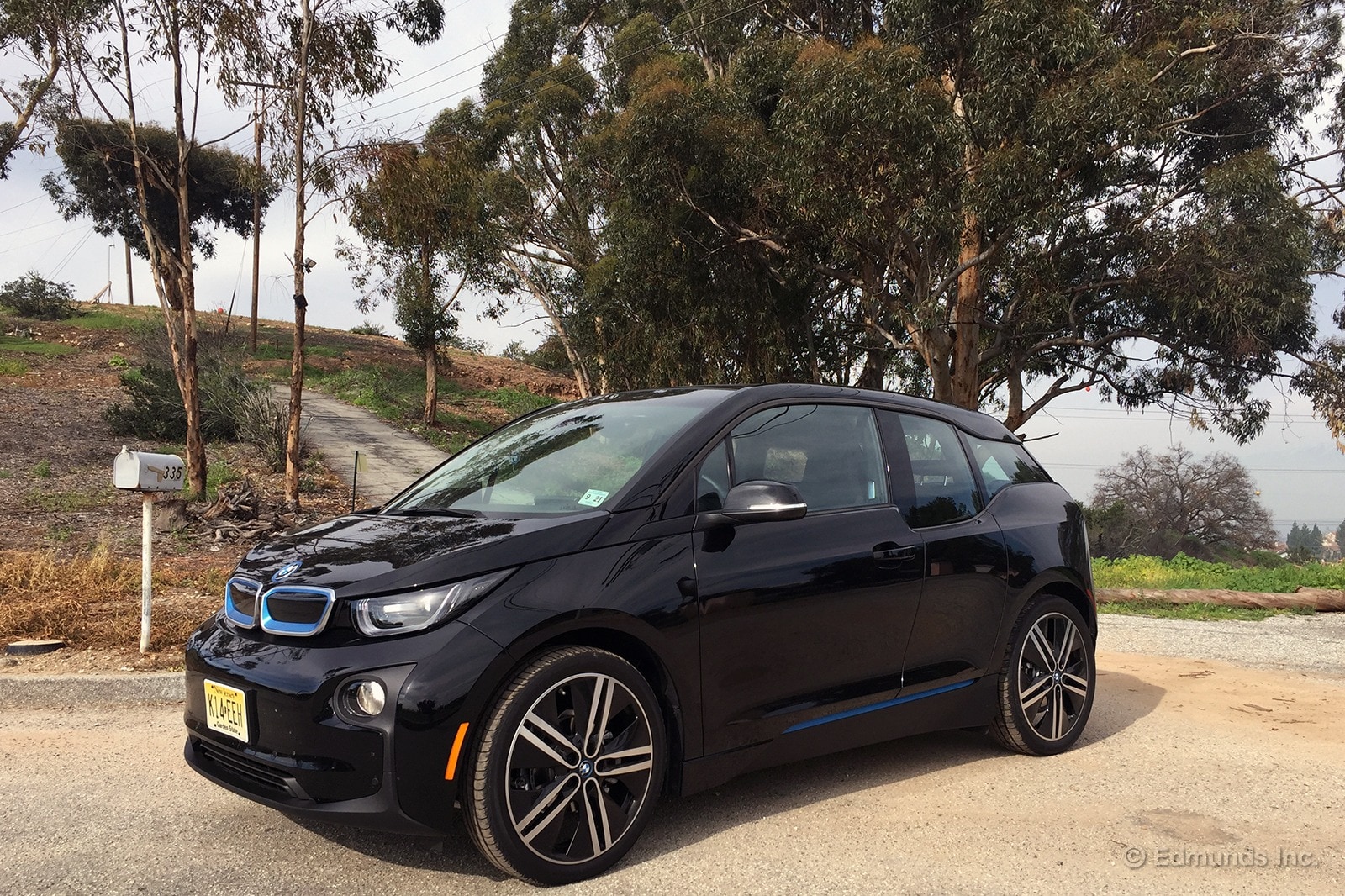
Our 2014 BMW i3 is long gone, but we recently brought in a 2017 range-extender (REX) model for short-term evaluation. The big news for this year is a redesigned battery pack with cells that yield more capacity (33 kWh) than the pack in our long-term car (22 kWh). This gives the 2017 i3 REX an EPA-estimated 97 miles of all-electric range and 180 miles with combined electric and gas power, compared to 72 and 150 miles, respectively, in our old long-termer.
That's already a nice improvement, but I found that by being a little lucky and not flat-footing the accelerator, the EPA's estimates can be surpassed.
When I left the office for home in the 2017 i3 REX, I had an indicated 90-ish miles of electric range from the nearly full battery. Since the estimated range adapts to your current driving style, I actually saw it increase as I drove.
My 38-mile journey was on the highway at moderate speeds. On the same route in our old i3, I'd usually have to plug in at a ChargePoint station near my house if I wanted to get back to the office without tapping into the gasoline reserve. I decided not to do that this time. I wanted to see how far I could get with the improved pack.
When I arrived at work the next morning — with little traffic on the way — I had traveled a solid 80 miles since the last charge, and the i3 showed an estimated 52 miles of EV range. Throw in the EPA-estimated 83-mile boost from the now fully fillable 2.4-gallon gas tank and I think an overall range of 200 miles is possible with everything topped off.
These upgrades came at just the right time, because the i3 needed a boost to compete with new and revised long-distance competitors. The Volkswagen e-Golf also gets a battery-pack capacity increase this year (from 24.2 kWh to 35.8 kWh), upping EPA-estimated range from 83 miles to 125 miles. The Chevrolet Bolt costs significantly less than the i3 and boasts 238 miles of range, and the upcoming Tesla Model 3 should rival the Bolt in terms of both price and range.
To sweeten the deal, the 2017 i3 also offers a sunroof for the first time, while a new base cloth interior helps offset the price increase driven by the improved battery pack. Bottom line? If you're considering this i3 generation, the 2017-plus version is the one to get.
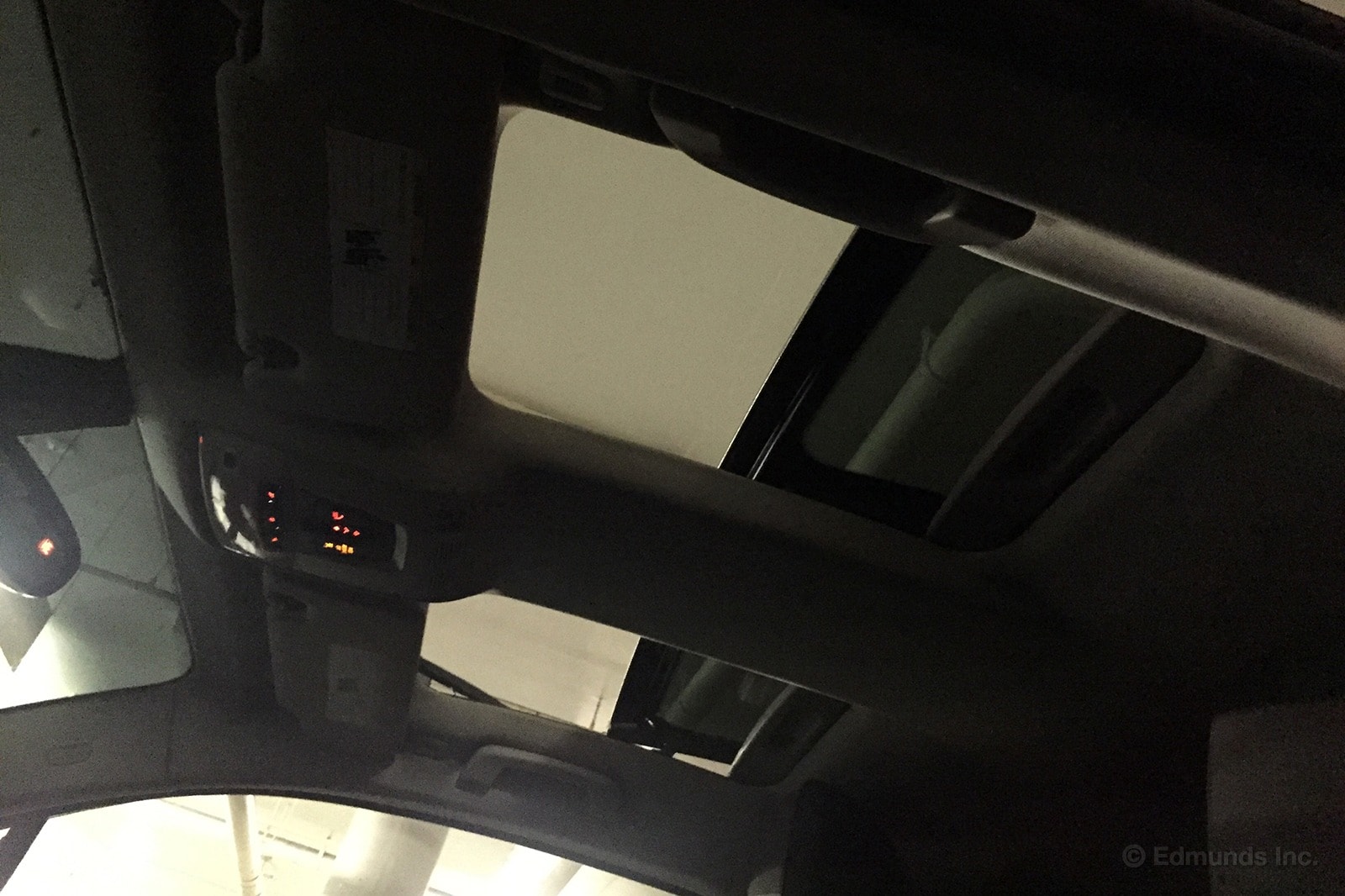
Wrap-Up
What We Got
The 2014 BMW i3 was an all-new vehicle that was a complete departure for the brand. Built out of carbon fiber, aluminum and plastic, the i3 was designed to be a pure electric car from the beginning. It was a big deal, so we decided to give it a try and see if it really was as groundbreaking as BMW claimed.
The MSRP on an i3 was $42,300. It included an electric motor with 170 horsepower and 184 pound-feet of torque. We wanted one with the optional two-cylinder, range-extending gasoline engine. That gave us up to 150 miles of total range, according to the EPA. This increased the MSRP to $46,150.
Optional equipment on our test car came at considerable cost. First we opted for the Tera World trim ($2,700), which added full leather, keyless entry and satellite radio. The Parking Assist package ($1,000) included parking assist and a rearview camera. The Tech + Driving Assist package ($2,500) combined adaptive cruise control, BMW apps and navigation with real-time traffic. Stand-alone options were the 20-inch wheels ($1,300), a Harman Kardon sound system ($800) and heated front seats ($350).
As-tested MSRP for our vehicle was $54,800, which we negotiated down to $49,999. It was not an inexpensive car. Then again, considering the level of technology and materials that went into building the i3, it wasn't very expensive at all. Here's how it fared.
Performance
"For starters, it drives well. It accelerates up to highway speeds quickly, and the suspension feels sufficiently refined over L.A's buckled concrete freeways. You're aware that the tires are small and narrow, but the car doesn't feel frail." — Ed Hellwig
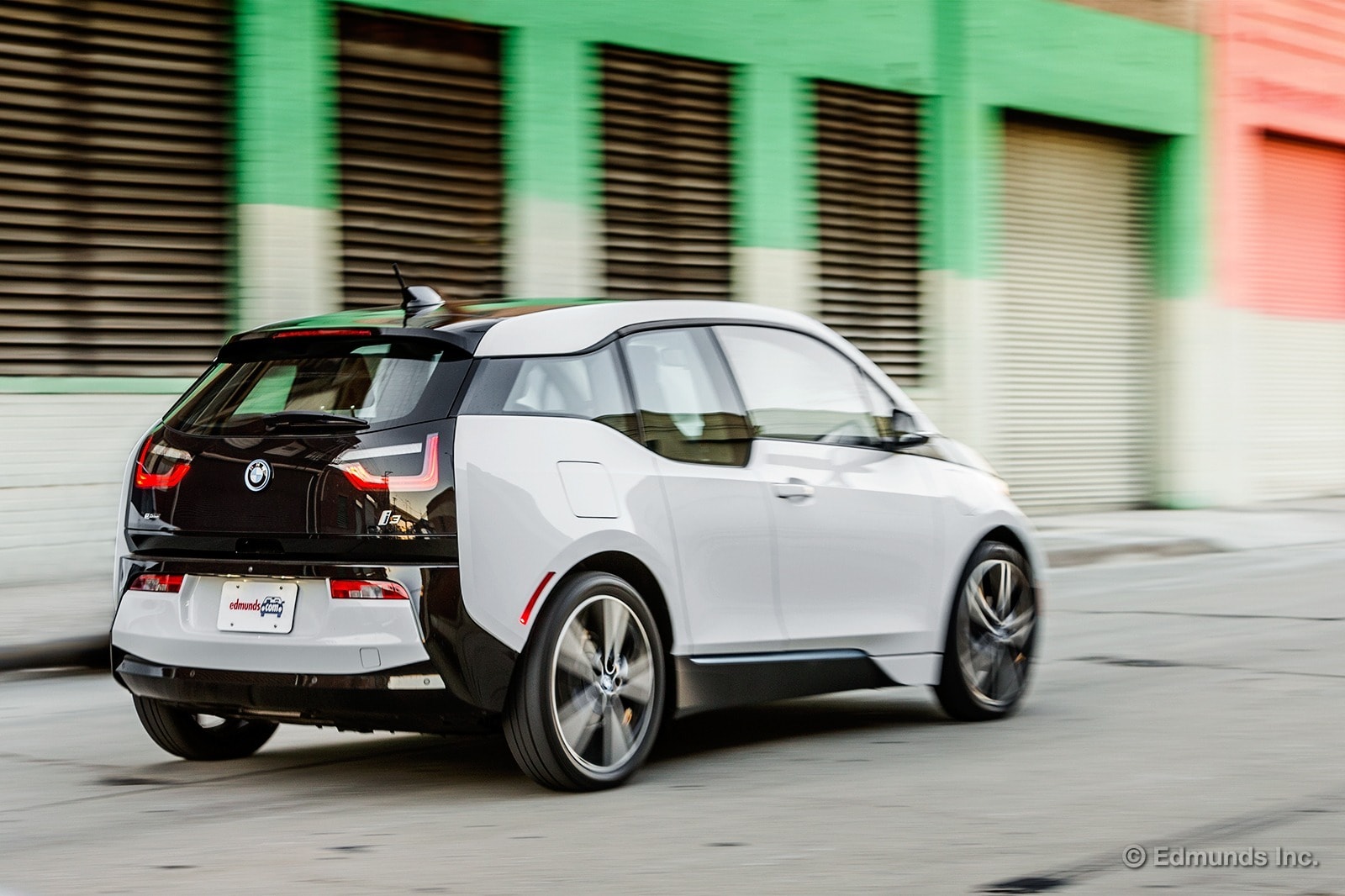
"The i3 is responsive, instantaneous and linear. It does its best work in the city when you want to get out of the way in a hurry, the trade-off being that it feels relatively blunted at freeway speeds.... I always floored it whenever I got the chance, like in HOV lanes, on freeway on-ramps, leaving Priuses in the dust, and at traffic lights going up against antsy Honda Civic drivers. The i3 is the point-and-squirt champion." — Caroline Pardilla
"I did experience the range extender's limitations.... No matter what I did with the accelerator, my speed gradually dropped from 74 mph down to 56 mph by the time I reached the summit. It would've kept going down had the grade been any higher or steeper." — James Riswick
MPG
"We can say with confidence that during this two-month period, we ran 1,656.6 miles on electricity and 52.4 miles on gasoline... our 1.722 gallons of gasoline burned at a rate of 30.4 mpg. The EPA's fuel economy rating for the i3 range-extender (REX) is 39 mpg.... Our 1,656.6 miles of electric driving consumed 468 kWh, which works out to an average electricity consumption rate of 28.2 kWh per 100 miles. The i3's EPA electricity consumption rating is 29 kWh/100 miles, so we're doing better than predicted here." — Dan Edmunds
"Stuffed under the i3's trunk floor is a 647cc two-cylinder gasoline engine that serves as an emergency backup should you need to go beyond the i3's electric range. It's a safety net, not the makings of a true plug-in hybrid, as its rinky-dink 2.4-gallon tank means you'd be hard-pressed to drive very far." — James Riswick
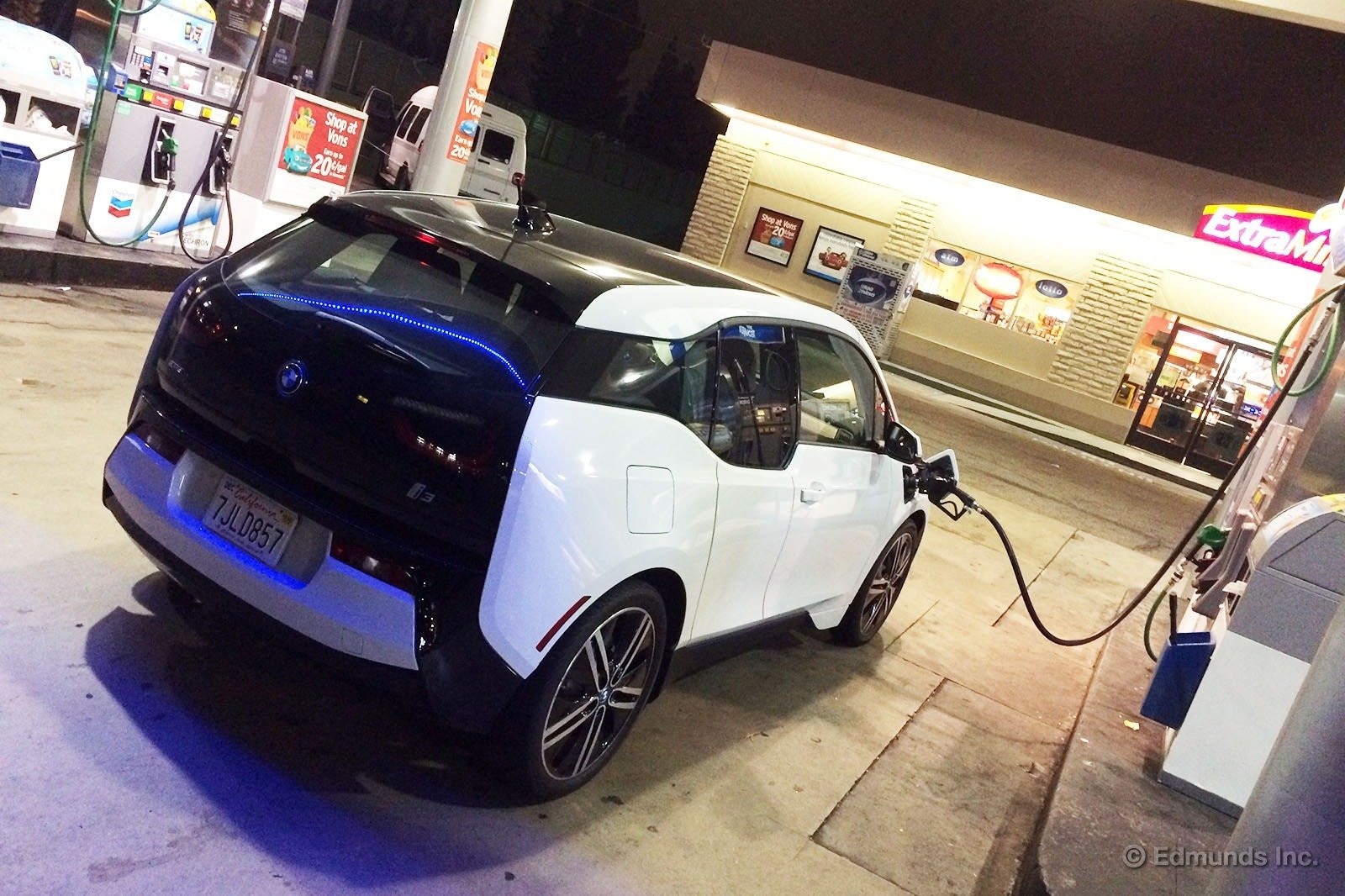
Comfort
"...in the city, over speed bumps, potholes, construction grates and intersection gutters, the i3 bounced quite a bit. The entire cabin seemed to move as one piece, communicating road surface changes with dramatic hops. Some of this comes down to the road quality and the i3's suspension calibration (it's stiff but not unyielding), but there are other factors, too. We've got the optional 20-inch wheels.... I'd opt for the standard 19s as a baseline solution but I'm not sure that would solve the problem entirely." — Travis Langness
"The driving position is akin to being at the helm of a small minivan, and I love that. You can't see to the tip of its nose, but there's superb visibility in all directions and an amazing sense of space in the cockpit. It's a different feeling than in any other BMW, but it's not different to the point of being weird." — Erin Riches
Cargo Space
"Last week I learned that it means the i3's 'trunk' can handle four 19-inch-diameter billet wheels of various widths pretty easily. Make that very easily, with plenty of height space and some floor space left over." — Scott Oldham
"I still contend that the i3 is a pretty perfect vehicle for retirees. It's just fine for golfers of any age as well, perhaps even for those who have to sit in 45 minutes of L.A. traffic for some Tuesday night twilight golf." — James Riswick
Interior
"The interior feels huge. Between the glass area and the dashboard design, the i3 gives you the impression that it's much bigger on the outside. It's a nice feeling when you're surrounded in traffic." — Ed Hellwig
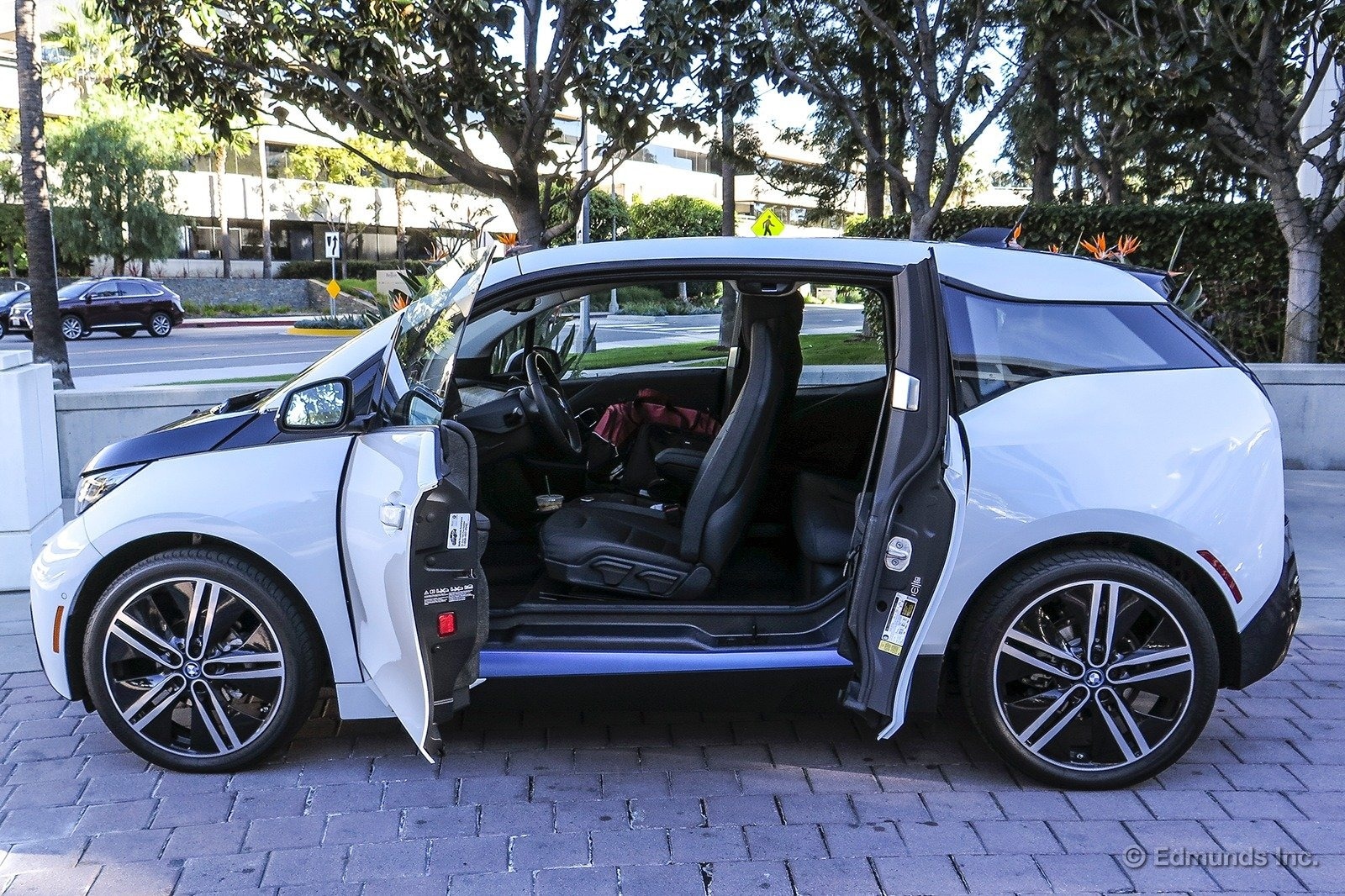
"Suicide doors are an issue if you're parked next to something (e.g. a car, a wall, a rhinoceros, etc.) and have a rear passenger that would like to be let out. BMW anti-mobster technology requires that the front-hinged front door be opened before the rear-hinged rear door latch can be operated. This promotes a natural barricade situation when the doors are open, leaving the driver and rear passenger to coordinate a rather ungraceful exit strategy." — Jonathan Elfalan
Audio and Technology
"First of all, its [self-parking feature is] not very intuitive. I had to use another feature, an onboard user's manual with tutorial videos, to find out how to activate it. Then, it took several tries before I hit the buttons in the right sequence to use it. But once in action, it was spectacular. It turned into the empty spot perfectly and used the park distance feature to center the car perfectly." — Phil Reed
"The center display screen in our long-term i3 is one of the best I've ever seen. The resolution is crisp, the screen is barely affected by sunlight and the rearview camera provides an impressive amount of detail." — Travis Langness
Maintenance
"Two minutes later, I safely crossed all lanes and found an off-ramp wide enough to get out and assess the situation on the driver's side. When I stopped the car, the monitor displayed 0 psi. I hoped the system was malfunctioning. Then I saw the wheel resting on the road with only a thin band of rubber separating the two." — Cameron Rogers
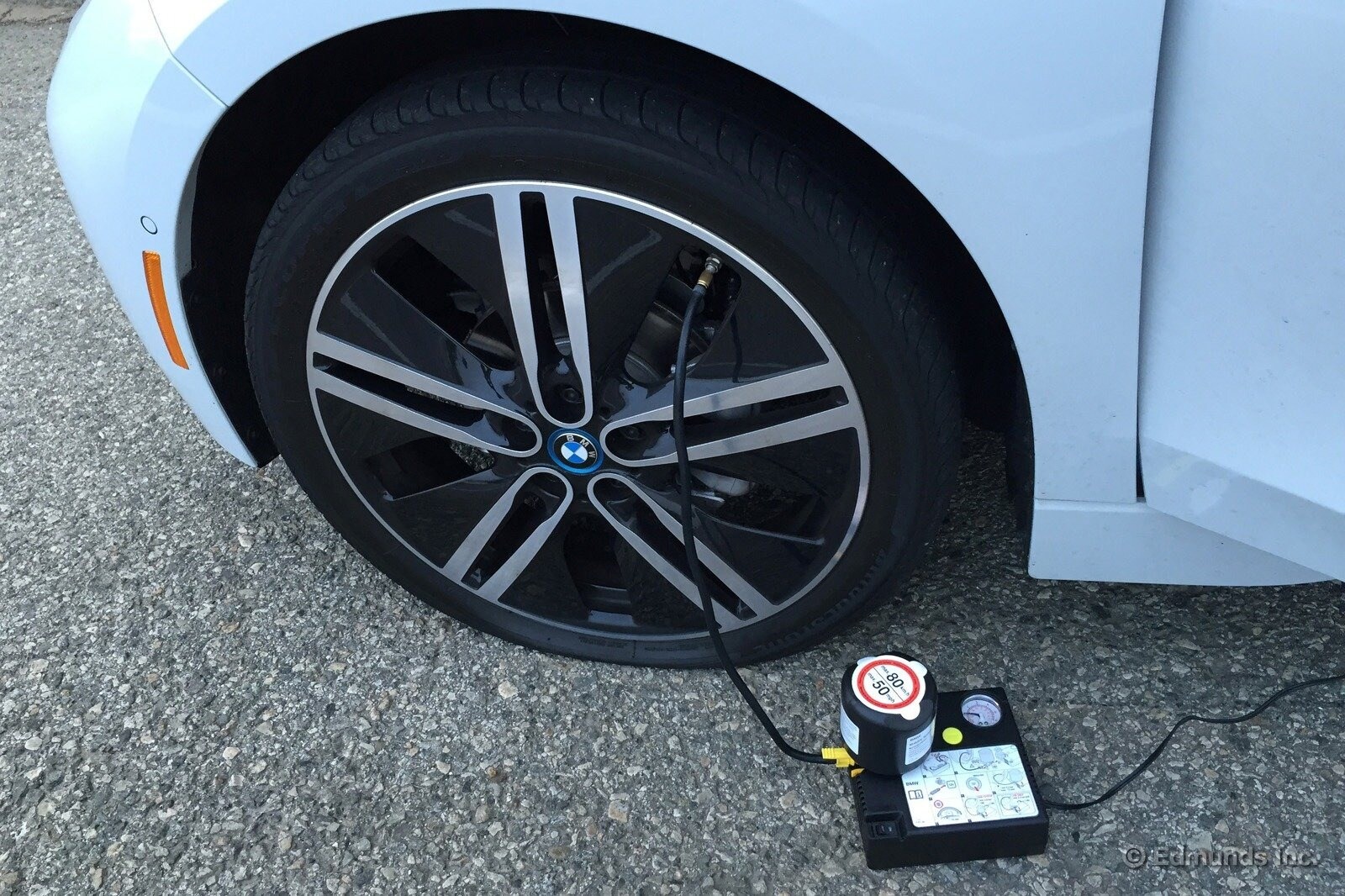
"'Is there any way to fix a broken plug on my BMW i3's 120-volt home charger?' I asked hopefully. The third prong, the ground, snapped off. 'Sorry, no,' replied Sergio from behind the parts counter. 'You'll need a whole new cord unit. Let me see if I have one in stock....' I paid the cashier the full $648.91 and sadly went back out into the afternoon heat." — Kelly Hellwig
Miscellaneous
"This was the first time I had experienced the range extender, which sounds a bit like someone is running a sewing machine in the trunk." — James Riswick
"The i3 slalomed through the curves with nary a hint of body roll. The comfortable front buckets kept both driver and passenger firmly in place. And those tall, skinny, low-rolling-resistance Bridgestones (155/60/R20s up front and 175/55/R20s at the rear) never lost their grip, although I didn't push them to their limits." — John O'Dell
Maintenance & Repairs
Regular Maintenance:
Routine service is dictated by the onboard computer. The first and only service for our i3 came at about 9,700 miles. It included an oil and filter change and safety inspections, and cost us nothing under BMW's 4-year/50,000-mile complimentary maintenance program.
Two unexpected incidents fell beyond the scope of normal maintenance but tapped into our pocketbook nonetheless. A blown tire on the freeway sent us shopping not only for a new tire ($208) but also a replacement tire inflator and sealant kit ($51). We also had to purchase a new 120-volt charge cable ($649) when suspected vandals forcibly extricated ours from a wall socket.
Service Campaigns:
Just one recall was issued on our i3 in the past year, for the passenger airbag.
Fuel Economy and Resale Value
Observed Fuel Economy:
Tracking fuel economy for our i3 with range extender required a lot of discipline. Some unusable information was inevitable, explained here. Still, we captured electricity and gasoline usage from 9,114 miles of our 10,400 total miles over the past year. Here's what we found.
EPA fuel estimates for the i3 were 39 mpg combined on gasoline. We averaged 28.5 mpg over the course of burning 29.8 gallons of fuel, which was quite a bit behind the EPA figure. But this comprised less than 10 percent of our total miles.
Our i3 ran on electricity for 90.7 percent of our test. During our most electric-heavy stretch, the BMW traveled 1,657 miles on charged particles and 52 miles on gasoline. That was 1,709 miles and two months without a drip of gasoline. And the one time we did fill up, it took just 1.7 gallons.
Resale and Depreciation:
We purchased our i3 with range extender for $49,999. After one year and 10,400 miles, Edmunds' TMV® Calculator valued the BMW at $33,300 based on a minimal number of i3 sales available for comparison at the time. Given the tiny market for EVs in general, we weren't that surprised to find little interest in our used i3.
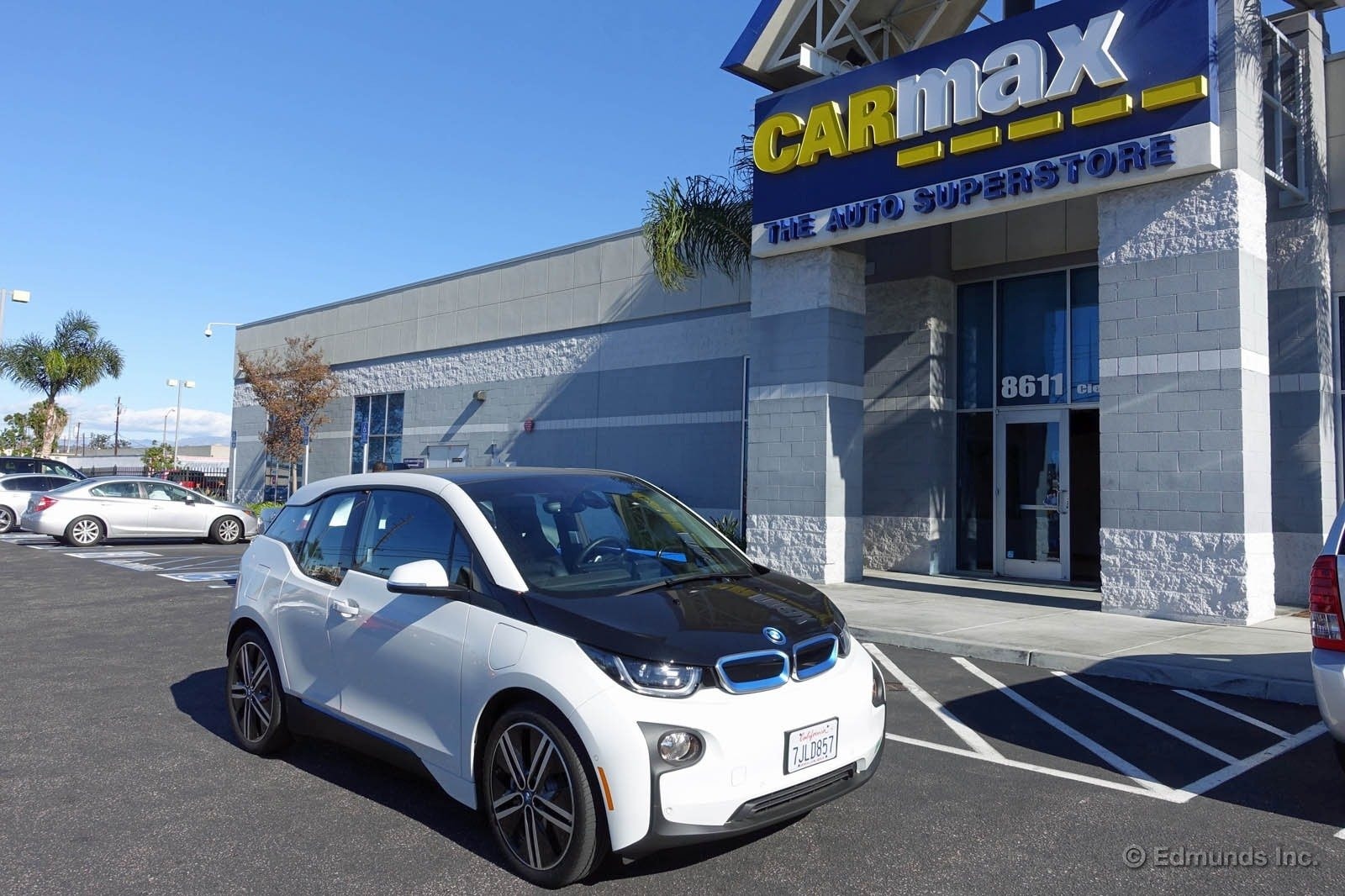
Following a prolonged period on the market, we sold the car for the best price offered, a disappointing $26,000 from CarMax. Even after subtracting the $2,500 California rebate from the purchase price, our i3 still depreciated 45 percent. That's the worst ever for our long-term fleet, but it's slightly skewed by the fact that the i3 also qualifies the original purchaser for a $7,500 tax credit, a factor that doesn't enter into the equation.
Summing Up
Pros: Excellent visibility, spacious feel to the cabin, high-quality interior materials, quick acceleration, solid handling, expandable cargo area, range-extending engine alleviates range anxiety, free four-year/50,000-mile scheduled maintenance.
Cons: Rear suicide doors are inconvenient in tight spaces, small gas tank limits maximum range, higher-than-average depreciation, no AM radio.
Bottom Line: This is a practical, well-built electric car that's more than just a BMW with a battery in it. The addition of the range-extending engine effectively eliminates the range anxiety issue that plagues most pure EVs and turns the i3 into a reliable daily driver with few compromises.
| Total Body Repair Costs: | None |
| Total Routine Maintenance Costs: | None (over 12 months) |
| Additional Maintenance Costs: | $907.35 |
| Warranty Repairs: | None |
| Non-Warranty Repairs: | Replace damaged tire, replace tire inflator and sealant kit, replace damaged 120-volt charge cable |
| Scheduled Dealer Visits: | 1 |
| Unscheduled Dealer Visits: | 2 |
| Days Out of Service: | None |
| Breakdowns Stranding Driver: | None |
| Percentage of time on Electricity: | 90.7% |
| Total Gasoline Used: | 29.8 gallons |
| Average Gasoline Fuel MPG: | 28.5 mpg |
| Best Combined Electric/Gas Range: | 1,709 miles |
| True Market Value at service end: | $33,300 (private-party sale) |
| What it Sold for: | $26,000 |
| Depreciation: | $21,499 (45% of paid price) |
| Final Odometer Reading: | 10,400 miles |
Edmunds purchased this vehicle for the purposes of evaluation.